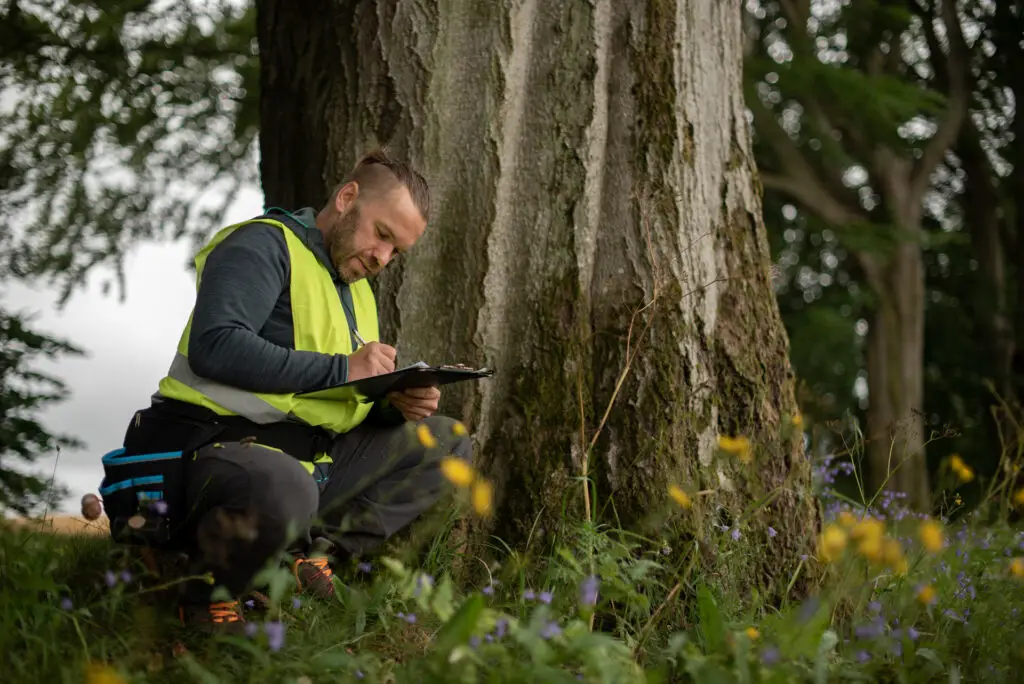Definicja i sposób obliczania
Jest to jeden z podstawowych parametrów w ocenie drzewa, używany we wszelakich metodach obliczeniowych (SIA, próba obciążeniowa, tomografia, a także rezystografia).
Zasadniczo jest to wartość niemianowana, ale przyjęło się wyrażać go w procentach (po pomnożeniu przez 100%) co ponoć ułatwia jego odbiór.
Współczynnik bezpieczeństwa określa odporność drzewa na złamanie lub wykrot, względem przewidywanego obciążenia.
Wyrażamy go więc wzorem WB = (nośność) / (obciążenia) * 100%
Ze względów bezpieczeństwa przyjmuje się, że powinien od wynosić co najmniej 150%, aby uniknąć konsekwencji błędów w szacowaniu nośności bądź obciążania.
O danych wejściowych do liczenia współczynników bezpieczeństwa przeczytasz w artykułach: Analiza naporu wiatru oraz Zarys biomechaniki drzew, trójkąt statyki, przyczyny i przeciwdziałanie awarii a także w opisach badań instrumentalnych takich jak Tomografia soniczna drzewa czy Statyczna próba obciążeniowa (elasto-inklino).
P.S.
Niektórzy autorzy inaczej definiują współczynniki bezpieczeństwa.
Mianowice wartością podstawową jest „bezpieczeństwo podstawowe drzewa„, które określa współczynnik bezpieczeństwa dla drzewa bez uszkodzeń (przy aktualnym obciążeniu). Natomiast pojęcia „bezpieczeństwo aktualne pnia na złamanie” oraz „bezpieczeństwo aktualne stabilności w gruncie” odnoszą się do bieżących współczynników bezpieczeństwa dla tych cech.
Biblioteczka
9899846
ALV756ZD
1
vancouver
50
creator
asc
3489
https://arborysta.net/wp-content/plugins/zotpress/
%7B%22status%22%3A%22success%22%2C%22updateneeded%22%3Afalse%2C%22instance%22%3Afalse%2C%22meta%22%3A%7B%22request_last%22%3A100%2C%22request_next%22%3A50%2C%22used_cache%22%3Atrue%7D%2C%22data%22%3A%5B%7B%22key%22%3A%22WKZWJRNI%22%2C%22library%22%3A%7B%22id%22%3A9899846%7D%2C%22meta%22%3A%7B%22creatorSummary%22%3A%22Anderson%22%2C%22parsedDate%22%3A%222017%22%2C%22numChildren%22%3A1%7D%2C%22bib%22%3A%22%26lt%3Bdiv%20class%3D%26quot%3Bcsl-bib-body%26quot%3B%20style%3D%26quot%3Bline-height%3A%201.35%3B%20%26quot%3B%26gt%3B%5Cn%20%20%26lt%3Bdiv%20class%3D%26quot%3Bcsl-entry%26quot%3B%20style%3D%26quot%3Bclear%3A%20left%3B%20%26quot%3B%26gt%3B%5Cn%20%20%20%20%26lt%3Bdiv%20class%3D%26quot%3Bcsl-left-margin%26quot%3B%20style%3D%26quot%3Bfloat%3A%20left%3B%20padding-right%3A%200.5em%3B%20text-align%3A%20right%3B%20width%3A%201em%3B%26quot%3B%26gt%3B1.%26lt%3B%5C%2Fdiv%26gt%3B%26lt%3Bdiv%20class%3D%26quot%3Bcsl-right-inline%26quot%3B%20style%3D%26quot%3Bmargin%3A%200%20.4em%200%201.5em%3B%26quot%3B%26gt%3BAnderson%20JD.%20Fundamentals%20of%20aerodynamics.%20Sixth%20edition.%20New%20York%2C%20NY%3A%20McGraw-Hill%20Education%3B%202017.%201130%20p.%20%28McGraw-Hill%20series%20in%20aeronautical%20and%20aerospace%20engineering%29.%26lt%3B%5C%2Fdiv%26gt%3B%5Cn%20%20%20%26lt%3B%5C%2Fdiv%26gt%3B%5Cn%26lt%3B%5C%2Fdiv%26gt%3B%22%2C%22data%22%3A%7B%22itemType%22%3A%22book%22%2C%22title%22%3A%22Fundamentals%20of%20aerodynamics%22%2C%22creators%22%3A%5B%7B%22creatorType%22%3A%22author%22%2C%22firstName%22%3A%22John%20David%22%2C%22lastName%22%3A%22Anderson%22%7D%5D%2C%22abstractNote%22%3A%22%22%2C%22date%22%3A%222017%22%2C%22language%22%3A%22en%22%2C%22ISBN%22%3A%22978-1-259-12991-9%22%2C%22url%22%3A%22%22%2C%22collections%22%3A%5B%22ALV756ZD%22%5D%2C%22dateModified%22%3A%222025-03-15T19%3A38%3A20Z%22%7D%7D%2C%7B%22key%22%3A%22V44SUENL%22%2C%22library%22%3A%7B%22id%22%3A9899846%7D%2C%22meta%22%3A%7B%22creatorSummary%22%3A%22Aniela%22%2C%22numChildren%22%3A1%7D%2C%22bib%22%3A%22%26lt%3Bdiv%20class%3D%26quot%3Bcsl-bib-body%26quot%3B%20style%3D%26quot%3Bline-height%3A%201.35%3B%20%26quot%3B%26gt%3B%5Cn%20%20%26lt%3Bdiv%20class%3D%26quot%3Bcsl-entry%26quot%3B%20style%3D%26quot%3Bclear%3A%20left%3B%20%26quot%3B%26gt%3B%5Cn%20%20%20%20%26lt%3Bdiv%20class%3D%26quot%3Bcsl-left-margin%26quot%3B%20style%3D%26quot%3Bfloat%3A%20left%3B%20padding-right%3A%200.5em%3B%20text-align%3A%20right%3B%20width%3A%201em%3B%26quot%3B%26gt%3B1.%26lt%3B%5C%2Fdiv%26gt%3B%26lt%3Bdiv%20class%3D%26quot%3Bcsl-right-inline%26quot%3B%20style%3D%26quot%3Bmargin%3A%200%20.4em%200%201.5em%3B%26quot%3B%26gt%3BAniela%20G.%20METODY%20WZBOGACAJ%26%23x104%3BCE%20TRE%26%23x15A%3BCI%20MECHANIKI%20TECHNICZNEJ%20STOSOWANE%20W%20DYDAKTYCE.%26lt%3B%5C%2Fdiv%26gt%3B%5Cn%20%20%20%26lt%3B%5C%2Fdiv%26gt%3B%5Cn%26lt%3B%5C%2Fdiv%26gt%3B%22%2C%22data%22%3A%7B%22itemType%22%3A%22journalArticle%22%2C%22title%22%3A%22METODY%20WZBOGACAJ%5Cu0104CE%20TRE%5Cu015aCI%20MECHANIKI%20TECHNICZNEJ%20STOSOWANE%20W%20DYDAKTYCE%22%2C%22creators%22%3A%5B%7B%22creatorType%22%3A%22author%22%2C%22firstName%22%3A%22GLINICKA%22%2C%22lastName%22%3A%22Aniela%22%7D%5D%2C%22abstractNote%22%3A%22%22%2C%22date%22%3A%22%22%2C%22language%22%3A%22pl%22%2C%22DOI%22%3A%22%22%2C%22ISSN%22%3A%22%22%2C%22url%22%3A%22%22%2C%22collections%22%3A%5B%22ALV756ZD%22%5D%2C%22dateModified%22%3A%222025-03-15T23%3A21%3A53Z%22%7D%7D%2C%7B%22key%22%3A%22RVTHRFXP%22%2C%22library%22%3A%7B%22id%22%3A9899846%7D%2C%22meta%22%3A%7B%22creatorSummary%22%3A%22Avalos%20and%20S%5Cu00e1nchez%22%2C%22parsedDate%22%3A%222014%22%2C%22numChildren%22%3A0%7D%2C%22bib%22%3A%22%26lt%3Bdiv%20class%3D%26quot%3Bcsl-bib-body%26quot%3B%20style%3D%26quot%3Bline-height%3A%201.35%3B%20%26quot%3B%26gt%3B%5Cn%20%20%26lt%3Bdiv%20class%3D%26quot%3Bcsl-entry%26quot%3B%20style%3D%26quot%3Bclear%3A%20left%3B%20%26quot%3B%26gt%3B%5Cn%20%20%20%20%26lt%3Bdiv%20class%3D%26quot%3Bcsl-left-margin%26quot%3B%20style%3D%26quot%3Bfloat%3A%20left%3B%20padding-right%3A%200.5em%3B%20text-align%3A%20right%3B%20width%3A%201em%3B%26quot%3B%26gt%3B1.%26lt%3B%5C%2Fdiv%26gt%3B%26lt%3Bdiv%20class%3D%26quot%3Bcsl-right-inline%26quot%3B%20style%3D%26quot%3Bmargin%3A%200%20.4em%200%201.5em%3B%26quot%3B%26gt%3BAvalos%20J%2C%20S%26%23xE1%3Bnchez%20A.%20Evaluation%20of%20Failure%20Criteria%20in%20Branch%20Members%20Under%20Torsion%20and%20Bending%20Moment.%20isa%20%5BInternet%5D.%202014%20%5Bcited%202025%20Mar%2015%5D%3B40%281%29%3A36%26%23x2013%3B45.%20Available%20from%3A%20%26lt%3Ba%20class%3D%26%23039%3Bzp-ItemURL%26%23039%3B%20href%3D%26%23039%3Bhttps%3A%5C%2F%5C%2Fauf.isa-arbor.com%5C%2Flookup%5C%2Fdoi%5C%2F10.48044%5C%2Fjauf.2014.004%26%23039%3B%26gt%3Bhttps%3A%5C%2F%5C%2Fauf.isa-arbor.com%5C%2Flookup%5C%2Fdoi%5C%2F10.48044%5C%2Fjauf.2014.004%26lt%3B%5C%2Fa%26gt%3B%26lt%3B%5C%2Fdiv%26gt%3B%5Cn%20%20%26lt%3B%5C%2Fdiv%26gt%3B%5Cn%26lt%3B%5C%2Fdiv%26gt%3B%22%2C%22data%22%3A%7B%22itemType%22%3A%22journalArticle%22%2C%22title%22%3A%22Evaluation%20of%20Failure%20Criteria%20in%20Branch%20Members%20Under%20Torsion%20and%20Bending%20Moment%22%2C%22creators%22%3A%5B%7B%22creatorType%22%3A%22author%22%2C%22firstName%22%3A%22Javier%22%2C%22lastName%22%3A%22Avalos%22%7D%2C%7B%22creatorType%22%3A%22author%22%2C%22firstName%22%3A%22Adolfo%22%2C%22lastName%22%3A%22S%5Cu00e1nchez%22%7D%5D%2C%22abstractNote%22%3A%22%5Cu4162%5Cu7374%5Cu7261%5Cu6374%5Cu0a20%5Cu2020%5Cu2020%5Cu2020%5Cu2020%5Cu2020%5Cu200a%5Cu2020%5Cu2020%5Cu2020%5Cu2020%5Cu2020%5Cu2020%5Cu2020%5Cu5472%5Cu6565%5Cu2061%5Cu7373%5Cu6573%5Cu736d%5Cu656e%5Cu7420%5Cu7265%5Cu6c69%5Cu6573%5Cu206f%5Cu6e20%5Cu6964%5Cu656e%5Cu7469%5Cu6679%5Cu696e%5Cu6720%5Cu616e%5Cu6420%5Cu6173%5Cu7365%5Cu7373%5Cu696e%5Cu6720%5Cu7374%5Cu7275%5Cu6374%5Cu7572%5Cu616c%5Cu2063%5Cu6f6e%5Cu6469%5Cu7469%5Cu6f6e%5Cu7320%5Cu746f%5Cu2070%5Cu7265%5Cu6469%5Cu6374%5Cu2066%5Cu6169%5Cu6c75%5Cu7265%5Cu2e20%5Cu5468%5Cu6520%5Cu7472%5Cu6565%5Cu2069%5Cu7320%5Cu6120%5Cu636f%5Cu6d70%5Cu6c65%5Cu7820%5Cu7374%5Cu7275%5Cu6374%5Cu7572%5Cu6520%5Cu6d61%5Cu6465%5Cu206f%5Cu6620%5Cu6c69%5Cu7665%5Cu2063%5Cu6f6d%5Cu706f%5Cu7369%5Cu7465%5Cu206d%5Cu6174%5Cu6572%5Cu6961%5Cu6c73%5Cu2077%5Cu6865%5Cu7265%5Cu206d%5Cu756c%5Cu7469%5Cu2d61%5Cu7869%5Cu616c%5Cu2073%5Cu7472%5Cu6573%5Cu7320%5Cu636f%5Cu6e64%5Cu6974%5Cu696f%5Cu6e73%5Cu2065%5Cu7869%5Cu7374%5Cu2069%5Cu6e20%5Cu7468%5Cu6520%5Cu696e%5Cu7465%5Cu7261%5Cu6374%5Cu696f%5Cu6e20%5Cu6f66%5Cu2074%5Cu6865%5Cu2062%5Cu7261%5Cu6e63%5Cu6865%5Cu7320%5Cu6265%5Cu7477%5Cu6565%5Cu6e20%5Cu6578%5Cu7465%5Cu726e%5Cu616c%5Cu2061%5Cu6e64%5Cu2069%5Cu6e74%5Cu6572%5Cu6e61%5Cu6c20%5Cu666f%5Cu7263%5Cu6573%5Cu2e20%5Cu4661%5Cu696c%5Cu7572%5Cu6520%5Cu6372%5Cu6974%5Cu6572%5Cu6961%5Cu2069%5Cu6e63%5Cu6c75%5Cu6465%5Cu6420%5Cu6265%5Cu6e64%5Cu696e%5Cu6720%5Cu6d6f%5Cu6d65%5Cu6e74%5Cu2061%5Cu6e64%5Cu2074%5Cu6f72%5Cu7369%5Cu6f6e%5Cu2c20%5Cu7768%5Cu696c%5Cu6520%5Cu616c%5Cu736f%5Cu2063%5Cu6f6e%5Cu7369%5Cu6465%5Cu7269%5Cu6e67%5Cu2074%5Cu6865%5Cu2077%5Cu6f6f%5Cu6420%5Cu6173%5Cu2061%5Cu6e20%5Cu6f72%5Cu7468%5Cu6f74%5Cu726f%5Cu7069%5Cu6320%5Cu6d61%5Cu7465%5Cu7269%5Cu616c%5Cu2e20%5Cu4173%5Cu6820%5Cu280a%5Cu2020%5Cu2020%5Cu2020%5Cu2020%5Cu2020%5Cu2020%5Cu2020%5Cu4672%5Cu6178%5Cu696e%5Cu7573%5Cu0a20%5Cu2020%5Cu2020%5Cu2020%5Cu2020%5Cu2020%5Cu2020%5Cu2073%5Cu7070%5Cu2e29%5Cu2074%5Cu7265%5Cu6520%5Cu6272%5Cu616e%5Cu6368%5Cu6573%5Cu2074%5Cu6861%5Cu7420%5Cu6661%5Cu696c%5Cu6564%5Cu2069%5Cu6e20%5Cu6e61%5Cu7475%5Cu7261%5Cu6c20%5Cu636f%5Cu6e64%5Cu6974%5Cu696f%5Cu6e73%5Cu2064%5Cu656d%5Cu6f6e%5Cu7374%5Cu7261%5Cu7465%5Cu6420%5Cu746f%5Cu2062%5Cu6520%5Cu7375%5Cu626a%5Cu6563%5Cu7420%5Cu746f%5Cu2062%5Cu6f74%5Cu6820%5Cu746f%5Cu7273%5Cu696f%5Cu6e20%5Cu616e%5Cu6420%5Cu6265%5Cu6e64%5Cu696e%5Cu6720%5Cu6d6f%5Cu6d65%5Cu6e74%5Cu2075%5Cu706f%5Cu6e20%5Cu6661%5Cu696c%5Cu7572%5Cu652e%5Cu204d%5Cu6178%5Cu696d%5Cu756d%5Cu2073%5Cu7472%5Cu6573%5Cu7320%5Cu7661%5Cu6c75%5Cu6573%5Cu206d%5Cu6561%5Cu7375%5Cu7265%5Cu6420%5Cu696e%5Cu2063%5Cu6f6e%5Cu7472%5Cu6f6c%5Cu6c65%5Cu6420%5Cu6661%5Cu696c%5Cu7572%5Cu6520%5Cu6578%5Cu7065%5Cu7269%5Cu6d65%5Cu6e74%5Cu7320%5Cu6465%5Cu6d6f%5Cu6e73%5Cu7472%5Cu6174%5Cu6564%5Cu2065%5Cu7863%5Cu656c%5Cu6c65%5Cu6e74%5Cu2061%5Cu6772%5Cu6565%5Cu6d65%5Cu6e74%5Cu2077%5Cu6974%5Cu6820%5Cu7468%5Cu6520%5Cu6372%5Cu6974%5Cu6572%5Cu6961%5Cu2075%5Cu7365%5Cu6420%5Cu696e%5Cu2074%5Cu6865%5Cu2073%5Cu7475%5Cu6479%5Cu2c20%5Cu7468%5Cu7573%5Cu206f%5Cu6274%5Cu6169%5Cu6e69%5Cu6e67%5Cu2061%5Cu2063%5Cu7572%5Cu7665%5Cu2065%5Cu7874%5Cu656e%5Cu6469%5Cu6e67%5Cu2066%5Cu726f%5Cu6d20%5Cu7075%5Cu7265%5Cu2062%5Cu656e%5Cu6469%5Cu6e67%5Cu206d%5Cu6f6d%5Cu656e%5Cu7420%5Cu6661%5Cu696c%5Cu7572%5Cu652c%5Cu2070%5Cu7572%5Cu6520%5Cu746f%5Cu7273%5Cu696f%5Cu6e20%5Cu6661%5Cu696c%5Cu7572%5Cu652c%5Cu2061%5Cu6e64%5Cu2063%5Cu6f6d%5Cu6269%5Cu6e61%5Cu7469%5Cu6f6e%5Cu206f%5Cu6620%5Cu626f%5Cu7468%5Cu2e20%5Cu4672%5Cu6f6d%5Cu2074%5Cu6865%5Cu7365%5Cu2065%5Cu7870%5Cu6572%5Cu696d%5Cu656e%5Cu7473%5Cu2c20%5Cu7468%5Cu6520%5Cu756c%5Cu7469%5Cu6d61%5Cu7465%5Cu2076%5Cu616c%5Cu7565%5Cu7320%5Cu6465%5Cu7465%5Cu726d%5Cu696e%5Cu6564%5Cu2066%5Cu6f72%5Cu2074%5Cu6865%5Cu2074%5Cu7265%5Cu6520%5Cu7370%5Cu6563%5Cu6965%5Cu7320%5Cu7465%5Cu7374%5Cu6564%5Cu2077%5Cu6572%5Cu6520%5Cu58cc%5Cu8420%5Cu3d20%5Cu3735%5Cu2e35%5Cu204d%5Cu5061%5Cu2066%5Cu6f72%5Cu2070%5Cu7572%5Cu6520%5Cu6265%5Cu6e64%5Cu696e%5Cu6720%5Cu616e%5Cu6420%5Cu5acc%5Cu8420%5Cu3d20%5Cu3131%5Cu2e32%5Cu204d%5Cu5061%5Cu2066%5Cu6f72%5Cu2070%5Cu7572%5Cu6520%5Cu746f%5Cu7273%5Cu696f%5Cu6e2c%5Cu2077%5Cu6869%5Cu6368%5Cu2061%5Cu6772%5Cu6565%5Cu7320%5Cu7765%5Cu6c6c%5Cu2074%5Cu6f20%5Cu7072%5Cu6576%5Cu696f%5Cu7573%5Cu2072%5Cu6570%5Cu6f72%5Cu7473%5Cu2e20%5Cu5468%5Cu6520%5Cu6d65%5Cu7468%5Cu6f64%5Cu6f6c%5Cu6f67%5Cu7920%5Cu7368%5Cu6f77%5Cu6e20%5Cu696e%5Cu2074%5Cu6869%5Cu7320%5Cu7374%5Cu7564%5Cu7920%5Cu6d61%5Cu7920%5Cu6265%5Cu2061%5Cu7070%5Cu6c69%5Cu6564%5Cu2074%5Cu6f20%5Cu616e%5Cu7920%5Cu7472%5Cu6565%5Cu2073%5Cu7065%5Cu6369%5Cu6573%3F%22%2C%22date%22%3A%2201%5C%2F2014%22%2C%22language%22%3A%22en%22%2C%22DOI%22%3A%2210.48044%5C%2Fjauf.2014.004%22%2C%22ISSN%22%3A%221935-5297%2C%202155-0778%22%2C%22url%22%3A%22https%3A%5C%2F%5C%2Fauf.isa-arbor.com%5C%2Flookup%5C%2Fdoi%5C%2F10.48044%5C%2Fjauf.2014.004%22%2C%22collections%22%3A%5B%22ALV756ZD%22%5D%2C%22dateModified%22%3A%222025-03-15T10%3A15%3A57Z%22%7D%7D%2C%7B%22key%22%3A%22EDA3MMI6%22%2C%22library%22%3A%7B%22id%22%3A9899846%7D%2C%22meta%22%3A%7B%22creatorSummary%22%3A%22Bitog%20et%20al.%22%2C%22parsedDate%22%3A%222011%22%2C%22numChildren%22%3A3%7D%2C%22bib%22%3A%22%26lt%3Bdiv%20class%3D%26quot%3Bcsl-bib-body%26quot%3B%20style%3D%26quot%3Bline-height%3A%201.35%3B%20%26quot%3B%26gt%3B%5Cn%20%20%26lt%3Bdiv%20class%3D%26quot%3Bcsl-entry%26quot%3B%20style%3D%26quot%3Bclear%3A%20left%3B%20%26quot%3B%26gt%3B%5Cn%20%20%20%20%26lt%3Bdiv%20class%3D%26quot%3Bcsl-left-margin%26quot%3B%20style%3D%26quot%3Bfloat%3A%20left%3B%20padding-right%3A%200.5em%3B%20text-align%3A%20right%3B%20width%3A%201em%3B%26quot%3B%26gt%3B1.%26lt%3B%5C%2Fdiv%26gt%3B%26lt%3Bdiv%20class%3D%26quot%3Bcsl-right-inline%26quot%3B%20style%3D%26quot%3Bmargin%3A%200%20.4em%200%201.5em%3B%26quot%3B%26gt%3BBitog%20JP%2C%20Lee%20IB%2C%20Hwang%20HS%2C%20Shin%20MH%2C%20Hong%20SW%2C%20Seo%20IH%2C%20et%20al.%20A%20wind%20tunnel%20study%20on%20aerodynamic%20porosity%20and%20windbreak%20drag.%20Forest%20Science%20and%20Technology%20%5BInternet%5D.%202011%20%5Bcited%202025%20Mar%203%5D%3B7%281%29%3A8%26%23x2013%3B16.%20Available%20from%3A%20%26lt%3Ba%20class%3D%26%23039%3Bzp-ItemURL%26%23039%3B%20href%3D%26%23039%3Bhttp%3A%5C%2F%5C%2Fwww.tandfonline.com%5C%2Fdoi%5C%2Fabs%5C%2F10.1080%5C%2F21580103.2011.559939%26%23039%3B%26gt%3Bhttp%3A%5C%2F%5C%2Fwww.tandfonline.com%5C%2Fdoi%5C%2Fabs%5C%2F10.1080%5C%2F21580103.2011.559939%26lt%3B%5C%2Fa%26gt%3B%26lt%3B%5C%2Fdiv%26gt%3B%5Cn%20%20%26lt%3B%5C%2Fdiv%26gt%3B%5Cn%26lt%3B%5C%2Fdiv%26gt%3B%22%2C%22data%22%3A%7B%22itemType%22%3A%22journalArticle%22%2C%22title%22%3A%22A%20wind%20tunnel%20study%20on%20aerodynamic%20porosity%20and%20windbreak%20drag%22%2C%22creators%22%3A%5B%7B%22creatorType%22%3A%22author%22%2C%22firstName%22%3A%22J.%20P.%22%2C%22lastName%22%3A%22Bitog%22%7D%2C%7B%22creatorType%22%3A%22author%22%2C%22firstName%22%3A%22I.-B.%22%2C%22lastName%22%3A%22Lee%22%7D%2C%7B%22creatorType%22%3A%22author%22%2C%22firstName%22%3A%22H.-S.%22%2C%22lastName%22%3A%22Hwang%22%7D%2C%7B%22creatorType%22%3A%22author%22%2C%22firstName%22%3A%22M.-H.%22%2C%22lastName%22%3A%22Shin%22%7D%2C%7B%22creatorType%22%3A%22author%22%2C%22firstName%22%3A%22S.-W.%22%2C%22lastName%22%3A%22Hong%22%7D%2C%7B%22creatorType%22%3A%22author%22%2C%22firstName%22%3A%22I.-H.%22%2C%22lastName%22%3A%22Seo%22%7D%2C%7B%22creatorType%22%3A%22author%22%2C%22firstName%22%3A%22E.%22%2C%22lastName%22%3A%22Mostafa%22%7D%2C%7B%22creatorType%22%3A%22author%22%2C%22firstName%22%3A%22Z.%22%2C%22lastName%22%3A%22Pang%22%7D%5D%2C%22abstractNote%22%3A%22%22%2C%22date%22%3A%2203%5C%2F2011%22%2C%22language%22%3A%22en%22%2C%22DOI%22%3A%2210.1080%5C%2F21580103.2011.559939%22%2C%22ISSN%22%3A%222158-0103%2C%202158-0715%22%2C%22url%22%3A%22http%3A%5C%2F%5C%2Fwww.tandfonline.com%5C%2Fdoi%5C%2Fabs%5C%2F10.1080%5C%2F21580103.2011.559939%22%2C%22collections%22%3A%5B%22ALV756ZD%22%5D%2C%22dateModified%22%3A%222025-03-15T23%3A22%3A12Z%22%7D%7D%2C%7B%22key%22%3A%22T2Q7THQG%22%2C%22library%22%3A%7B%22id%22%3A9899846%7D%2C%22meta%22%3A%7B%22creatorSummary%22%3A%22B%5Cu0142o%5Cu0144ska%20et%20al.%22%2C%22numChildren%22%3A2%7D%2C%22bib%22%3A%22%26lt%3Bdiv%20class%3D%26quot%3Bcsl-bib-body%26quot%3B%20style%3D%26quot%3Bline-height%3A%201.35%3B%20%26quot%3B%26gt%3B%5Cn%20%20%26lt%3Bdiv%20class%3D%26quot%3Bcsl-entry%26quot%3B%20style%3D%26quot%3Bclear%3A%20left%3B%20%26quot%3B%26gt%3B%5Cn%20%20%20%20%26lt%3Bdiv%20class%3D%26quot%3Bcsl-left-margin%26quot%3B%20style%3D%26quot%3Bfloat%3A%20left%3B%20padding-right%3A%200.5em%3B%20text-align%3A%20right%3B%20width%3A%201em%3B%26quot%3B%26gt%3B1.%26lt%3B%5C%2Fdiv%26gt%3B%26lt%3Bdiv%20class%3D%26quot%3Bcsl-right-inline%26quot%3B%20style%3D%26quot%3Bmargin%3A%200%20.4em%200%201.5em%3B%26quot%3B%26gt%3BB%26%23x142%3Bo%26%23x144%3Bska%20E%2C%20Lasota%20J%2C%20Piaszczyk%20W.%20Zapas%20i%20struktura%20martwego%20drewna%20oraz%20jego%20znaczenie%20w%20akumulacji%20w%26%23x119%3Bgla%20na%20siedliskach%20lasu%20wilgotnego%20oraz%20olsu%20jesionowego.%20%3A9.%26lt%3B%5C%2Fdiv%26gt%3B%5Cn%20%20%20%26lt%3B%5C%2Fdiv%26gt%3B%5Cn%26lt%3B%5C%2Fdiv%26gt%3B%22%2C%22data%22%3A%7B%22itemType%22%3A%22journalArticle%22%2C%22title%22%3A%22Zapas%20i%20struktura%20martwego%20drewna%20oraz%20jego%20znaczenie%20w%20akumulacji%20w%5Cu0119gla%20na%20siedliskach%20lasu%20wilgotnego%20oraz%20olsu%20jesionowego%22%2C%22creators%22%3A%5B%7B%22creatorType%22%3A%22author%22%2C%22firstName%22%3A%22Ewa%22%2C%22lastName%22%3A%22B%5Cu0142o%5Cu0144ska%22%7D%2C%7B%22creatorType%22%3A%22author%22%2C%22firstName%22%3A%22Jaros%5Cu0142aw%22%2C%22lastName%22%3A%22Lasota%22%7D%2C%7B%22creatorType%22%3A%22author%22%2C%22firstName%22%3A%22Wojciech%22%2C%22lastName%22%3A%22Piaszczyk%22%7D%5D%2C%22abstractNote%22%3A%22%5Cu42c5%5Cu826f%5Cuc584%5Cu736b%5Cu6120%5Cu452e%5Cu2c20%5Cu4c61%5Cu736f%5Cu7461%5Cu204a%5Cu2e2c%5Cu2050%5Cu6961%5Cu737a%5Cu637a%5Cu796b%5Cu2057%5Cu2e20%5Cu3230%5Cu3139%5Cu2e20%5Cu5a61%5Cu7061%5Cu7320%5Cu6920%5Cu7374%5Cu7275%5Cu6b74%5Cu7572%5Cu6120%5Cu6d61%5Cu7274%5Cu7765%5Cu676f%5Cu2064%5Cu7265%5Cu776e%5Cu6120%5Cu6f72%5Cu617a%5Cu206a%5Cu6567%5Cu6f20%5Cu7a6e%5Cu6163%5Cu7a65%5Cu6e69%5Cu6520%5Cu7720%5Cu616b%5Cu75e2%5Cu8892%5Cu206d%5Cu756c%5Cu6163%5Cu6a69%5Cu2077%5Cuc499%5Cu676c%5Cu6120%5Cu6e61%5Cu2073%5Cu6965%5Cu646c%5Cu6973%5Cu6b61%5Cu6368%5Cu206c%5Cu6173%5Cu7520%5Cu7769%5Cu6c67%5Cu6f74%5Cu6e65%5Cu676f%5Cu206f%5Cu7261%5Cu7a20%5Cu6f6c%5Cu7375%5Cu206a%5Cu6573%5Cu696f%5Cu6e6f%5Cu7765%5Cu676f%5Cu2e20%5Cu5379%5Cu6c77%5Cu616e%5Cu2031%5Cu3633%5Cu2028%5Cu3229%5Cu3a20%5Cu3134%5Cu31e2%5Cu8892%5Cu3134%5Cu392e%22%2C%22date%22%3A%22%22%2C%22language%22%3A%22pl%22%2C%22DOI%22%3A%22%22%2C%22ISSN%22%3A%22%22%2C%22url%22%3A%22%22%2C%22collections%22%3A%5B%22ALV756ZD%22%5D%2C%22dateModified%22%3A%222025-03-03T11%3A07%3A28Z%22%7D%7D%2C%7B%22key%22%3A%22DQQDTT7Z%22%2C%22library%22%3A%7B%22id%22%3A9899846%7D%2C%22meta%22%3A%7B%22creatorSummary%22%3A%22Bobek%22%2C%22parsedDate%22%3A%222020%22%2C%22numChildren%22%3A0%7D%2C%22bib%22%3A%22%26lt%3Bdiv%20class%3D%26quot%3Bcsl-bib-body%26quot%3B%20style%3D%26quot%3Bline-height%3A%201.35%3B%20%26quot%3B%26gt%3B%5Cn%20%20%26lt%3Bdiv%20class%3D%26quot%3Bcsl-entry%26quot%3B%20style%3D%26quot%3Bclear%3A%20left%3B%20%26quot%3B%26gt%3B%5Cn%20%20%20%20%26lt%3Bdiv%20class%3D%26quot%3Bcsl-left-margin%26quot%3B%20style%3D%26quot%3Bfloat%3A%20left%3B%20padding-right%3A%200.5em%3B%20text-align%3A%20right%3B%20width%3A%201em%3B%26quot%3B%26gt%3B1.%26lt%3B%5C%2Fdiv%26gt%3B%26lt%3Bdiv%20class%3D%26quot%3Bcsl-right-inline%26quot%3B%20style%3D%26quot%3Bmargin%3A%200%20.4em%200%201.5em%3B%26quot%3B%26gt%3BBobek%20W.%20Statyka%20drzew.%20Analiza%20zawodno%26%23x15B%3Bci%3A%20poradnik%20profesjonalisty.%20Wydanie%20I.%20Warszawa%3A%20Centrum%20Dendrologiczne%3B%202020.%26lt%3B%5C%2Fdiv%26gt%3B%5Cn%20%20%20%26lt%3B%5C%2Fdiv%26gt%3B%5Cn%26lt%3B%5C%2Fdiv%26gt%3B%22%2C%22data%22%3A%7B%22itemType%22%3A%22book%22%2C%22title%22%3A%22Statyka%20drzew.%20Analiza%20zawodno%5Cu015bci%3A%20poradnik%20profesjonalisty%22%2C%22creators%22%3A%5B%7B%22creatorType%22%3A%22contributor%22%2C%22firstName%22%3A%22Marek%22%2C%22lastName%22%3A%22Siewniak%22%7D%2C%7B%22creatorType%22%3A%22contributor%22%2C%22firstName%22%3A%22Margarita%22%2C%22lastName%22%3A%22Siewniak%22%7D%2C%7B%22creatorType%22%3A%22contributor%22%2C%22firstName%22%3A%22Lothar%22%2C%22lastName%22%3A%22Wessolly%22%7D%2C%7B%22creatorType%22%3A%22author%22%2C%22firstName%22%3A%22Wojciech%22%2C%22lastName%22%3A%22Bobek%22%7D%5D%2C%22abstractNote%22%3A%22%22%2C%22date%22%3A%222020%22%2C%22language%22%3A%22pol%22%2C%22ISBN%22%3A%22978-83-936355-2-8%22%2C%22url%22%3A%22%22%2C%22collections%22%3A%5B%22ALV756ZD%22%5D%2C%22dateModified%22%3A%222025-03-19T22%3A47%3A53Z%22%7D%7D%2C%7B%22key%22%3A%22VL5NC4H8%22%2C%22library%22%3A%7B%22id%22%3A9899846%7D%2C%22meta%22%3A%7B%22creatorSummary%22%3A%22Brown%20et%20al.%22%2C%22parsedDate%22%3A%222000%22%2C%22numChildren%22%3A1%7D%2C%22bib%22%3A%22%26lt%3Bdiv%20class%3D%26quot%3Bcsl-bib-body%26quot%3B%20style%3D%26quot%3Bline-height%3A%201.35%3B%20%26quot%3B%26gt%3B%5Cn%20%20%26lt%3Bdiv%20class%3D%26quot%3Bcsl-entry%26quot%3B%20style%3D%26quot%3Bclear%3A%20left%3B%20%26quot%3B%26gt%3B%5Cn%20%20%20%20%26lt%3Bdiv%20class%3D%26quot%3Bcsl-left-margin%26quot%3B%20style%3D%26quot%3Bfloat%3A%20left%3B%20padding-right%3A%200.5em%3B%20text-align%3A%20right%3B%20width%3A%201em%3B%26quot%3B%26gt%3B1.%26lt%3B%5C%2Fdiv%26gt%3B%26lt%3Bdiv%20class%3D%26quot%3Bcsl-right-inline%26quot%3B%20style%3D%26quot%3Bmargin%3A%200%20.4em%200%201.5em%3B%26quot%3B%26gt%3BBrown%20JH%2C%20West%20GB%2C%20Santa%20Fe%20Institute%20%28Santa%20Fe%2C%20N.M.%29%2C%20editors.%20Scaling%20in%20biology.%20New%20York%3A%20Oxford%20University%20Press%3B%202000.%20352%20p.%20%28Santa%20Fe%20Institute%20studies%20in%20the%20science%20of%20complexity%29.%26lt%3B%5C%2Fdiv%26gt%3B%5Cn%20%20%20%26lt%3B%5C%2Fdiv%26gt%3B%5Cn%26lt%3B%5C%2Fdiv%26gt%3B%22%2C%22data%22%3A%7B%22itemType%22%3A%22book%22%2C%22title%22%3A%22Scaling%20in%20biology%22%2C%22creators%22%3A%5B%7B%22creatorType%22%3A%22editor%22%2C%22firstName%22%3A%22James%20H.%22%2C%22lastName%22%3A%22Brown%22%7D%2C%7B%22creatorType%22%3A%22editor%22%2C%22firstName%22%3A%22Geoffrey%20B.%22%2C%22lastName%22%3A%22West%22%7D%2C%7B%22creatorType%22%3A%22editor%22%2C%22name%22%3A%22Santa%20Fe%20Institute%20%28Santa%20Fe%2C%20N.M.%29%22%7D%5D%2C%22abstractNote%22%3A%22%22%2C%22date%22%3A%222000%22%2C%22language%22%3A%22en%22%2C%22ISBN%22%3A%22978-0-19-513141-3%20978-0-19-513142-0%22%2C%22url%22%3A%22%22%2C%22collections%22%3A%5B%22ALV756ZD%22%5D%2C%22dateModified%22%3A%222025-03-03T10%3A59%3A37Z%22%7D%7D%2C%7B%22key%22%3A%22FBW4RFHX%22%2C%22library%22%3A%7B%22id%22%3A9899846%7D%2C%22meta%22%3A%7B%22creatorSummary%22%3A%22Brudi%22%2C%22numChildren%22%3A1%7D%2C%22bib%22%3A%22%26lt%3Bdiv%20class%3D%26quot%3Bcsl-bib-body%26quot%3B%20style%3D%26quot%3Bline-height%3A%201.35%3B%20%26quot%3B%26gt%3B%5Cn%20%20%26lt%3Bdiv%20class%3D%26quot%3Bcsl-entry%26quot%3B%20style%3D%26quot%3Bclear%3A%20left%3B%20%26quot%3B%26gt%3B%5Cn%20%20%20%20%26lt%3Bdiv%20class%3D%26quot%3Bcsl-left-margin%26quot%3B%20style%3D%26quot%3Bfloat%3A%20left%3B%20padding-right%3A%200.5em%3B%20text-align%3A%20right%3B%20width%3A%201em%3B%26quot%3B%26gt%3B1.%26lt%3B%5C%2Fdiv%26gt%3B%26lt%3Bdiv%20class%3D%26quot%3Bcsl-right-inline%26quot%3B%20style%3D%26quot%3Bmargin%3A%200%20.4em%200%201.5em%3B%26quot%3B%26gt%3BBrudi%20E.%20Longitudinal%20prestresses%20in%20Tilia%20cordata%20and%20Acer%20pseudoplatanus.%26lt%3B%5C%2Fdiv%26gt%3B%5Cn%20%20%20%26lt%3B%5C%2Fdiv%26gt%3B%5Cn%26lt%3B%5C%2Fdiv%26gt%3B%22%2C%22data%22%3A%7B%22itemType%22%3A%22journalArticle%22%2C%22title%22%3A%22Longitudinal%20prestresses%20in%20Tilia%20cordata%20and%20Acer%20pseudoplatanus%22%2C%22creators%22%3A%5B%7B%22creatorType%22%3A%22author%22%2C%22firstName%22%3A%22Erk%22%2C%22lastName%22%3A%22Brudi%22%7D%5D%2C%22abstractNote%22%3A%22%5Cu4772%5Cu6f77%5Cu7468%5Cu2073%5Cu7472%5Cu6573%5Cu7365%5Cu7320%5Cu6f63%5Cu6375%5Cu7220%5Cu696e%5Cu2061%5Cu6c6c%5Cu2074%5Cu6872%5Cu6565%5Cu2061%5Cu6e61%5Cu746f%5Cu6d69%5Cu6361%5Cu6c20%5Cu706c%5Cu616e%5Cu6573%5Cu2077%5Cu6974%5Cu6869%5Cu6e20%5Cu6120%5Cu7472%5Cu6565%5Cu2074%5Cu7275%5Cu6e6b%5Cu2061%5Cu6e64%5Cu2061%5Cu7265%5Cu2069%5Cu6e20%5Cu6120%5Cu7465%5Cu6368%5Cu6e69%5Cu6361%5Cu6c20%5Cu7365%5Cu6e73%5Cu6520%5Cu7072%5Cu6573%5Cu7472%5Cu6573%5Cu7365%5Cu732e%5Cu2054%5Cu6865%5Cu7920%5Cu6465%5Cu7665%5Cu6c6f%5Cu7020%5Cu6475%5Cu7269%5Cu6e67%5Cu2063%5Cu656c%5Cu6c20%5Cu6d61%5Cu7475%5Cu7261%5Cu7469%5Cu6f6e%5Cu2061%5Cu7320%5Cu7468%5Cu6520%5Cu5332%5Cu206c%5Cu6179%5Cu6572%5Cu2074%5Cu6869%5Cu636b%5Cu656e%5Cu7320%5Cu6361%5Cu7573%5Cu696e%5Cu6720%5Cu6120%5Cu7377%5Cu656c%5Cu6c69%5Cu6e67%5Cu2069%5Cu6e20%5Cu7468%5Cu6520%5Cu7261%5Cu6469%5Cu616c%5Cu2061%5Cu6e64%5Cu2074%5Cu616e%5Cu6765%5Cu6e74%5Cu6961%5Cu6c20%5Cu706c%5Cu616e%5Cu6520%5Cu616e%5Cu6420%5Cu6120%5Cu636f%5Cu6e74%5Cu7261%5Cu6374%5Cu696f%5Cu6e20%5Cu696e%5Cu2074%5Cu6865%5Cu206c%5Cu6f6e%5Cu6769%5Cu7475%5Cu6469%5Cu6e61%5Cu6c20%5Cu706c%5Cu616e%5Cu652e%5Cu204c%5Cu6f6e%5Cu6769%5Cu7475%5Cu6469%5Cu6e61%5Cu6c20%5Cu636f%5Cu6e74%5Cu7261%5Cu6374%5Cu696f%5Cu6e20%5Cu6c65%5Cu6164%5Cu7320%5Cu746f%5Cu2074%5Cu656e%5Cu7369%5Cu6c65%5Cu2070%5Cu7265%5Cu7374%5Cu7265%5Cu7373%5Cu2069%5Cu6e20%5Cu7468%5Cu6520%5Cu6f75%5Cu7465%5Cu7220%5Cu7368%5Cu6561%5Cu7468%5Cu206f%5Cu6620%5Cu7468%5Cu6520%5Cu7472%5Cu756e%5Cu6b20%5Cu284b%5Cuc3bc%5Cu626c%5Cu6572%5Cu2c20%5Cu3139%5Cu3539%5Cu292e%5Cu2054%5Cu6865%5Cu2073%5Cu7765%5Cu6c6c%5Cu696e%5Cu6720%5Cu6f66%5Cu2063%5Cu656c%5Cu6c20%5Cu7761%5Cu6c6c%5Cu7320%5Cu6361%5Cu7573%5Cu6573%5Cu2063%5Cu6f6d%5Cu7072%5Cu6573%5Cu7369%5Cu7665%5Cu2073%5Cu7472%5Cu6573%5Cu7365%5Cu7320%5Cu696e%5Cu2074%5Cu6865%5Cu2072%5Cu6164%5Cu6961%5Cu6c20%5Cu616e%5Cu6420%5Cu7461%5Cu6e67%5Cu656e%5Cu7469%5Cu616c%5Cu2070%5Cu6c61%5Cu6e65%5Cu2e20%5Cu496e%5Cu2074%5Cu6865%5Cu2063%5Cu656e%5Cu7472%5Cu616c%5Cu2074%5Cu7275%5Cu6e6b%5Cu2074%5Cu6865%5Cu206f%5Cu7070%5Cu6f73%5Cu6974%5Cu6520%5Cu666f%5Cu7263%5Cu6573%5Cu2061%5Cu7265%5Cu2061%5Cu6374%5Cu6976%5Cu6520%5Cu6b65%5Cu6570%5Cu696e%5Cu6720%5Cu6120%5Cu7472%5Cu6565%5Cu2069%5Cu6e20%5Cu6974%5Cu7320%5Cu7374%5Cu6174%5Cu6520%5Cu6f66%5Cu2065%5Cu7175%5Cu696c%5Cu6962%5Cu7269%5Cu756d%3F%22%2C%22date%22%3A%22%22%2C%22language%22%3A%22en%22%2C%22DOI%22%3A%22%22%2C%22ISSN%22%3A%22%22%2C%22url%22%3A%22%22%2C%22collections%22%3A%5B%22ALV756ZD%22%5D%2C%22dateModified%22%3A%222025-03-03T10%3A58%3A42Z%22%7D%7D%2C%7B%22key%22%3A%22RWZ975X6%22%2C%22library%22%3A%7B%22id%22%3A9899846%7D%2C%22meta%22%3A%7B%22creatorSummary%22%3A%22Carvalho%20et%20al.%22%2C%22parsedDate%22%3A%222017%22%2C%22numChildren%22%3A1%7D%2C%22bib%22%3A%22%26lt%3Bdiv%20class%3D%26quot%3Bcsl-bib-body%26quot%3B%20style%3D%26quot%3Bline-height%3A%201.35%3B%20%26quot%3B%26gt%3B%5Cn%20%20%26lt%3Bdiv%20class%3D%26quot%3Bcsl-entry%26quot%3B%20style%3D%26quot%3Bclear%3A%20left%3B%20%26quot%3B%26gt%3B%5Cn%20%20%20%20%26lt%3Bdiv%20class%3D%26quot%3Bcsl-left-margin%26quot%3B%20style%3D%26quot%3Bfloat%3A%20left%3B%20padding-right%3A%200.5em%3B%20text-align%3A%20right%3B%20width%3A%201em%3B%26quot%3B%26gt%3B1.%26lt%3B%5C%2Fdiv%26gt%3B%26lt%3Bdiv%20class%3D%26quot%3Bcsl-right-inline%26quot%3B%20style%3D%26quot%3Bmargin%3A%200%20.4em%200%201.5em%3B%26quot%3B%26gt%3BCarvalho%20MR%2C%20Turgeon%20R%2C%20Owens%20T%2C%20Niklas%20KJ.%20The%20scaling%20of%20the%20hydraulic%20architecture%20in%20poplar%20leaves.%20New%20Phytologist%20%5BInternet%5D.%202017%20%5Bcited%202025%20Mar%203%5D%3B214%281%29%3A145%26%23x2013%3B57.%20Available%20from%3A%20%26lt%3Ba%20class%3D%26%23039%3Bzp-ItemURL%26%23039%3B%20href%3D%26%23039%3Bhttps%3A%5C%2F%5C%2Fnph.onlinelibrary.wiley.com%5C%2Fdoi%5C%2F10.1111%5C%2Fnph.14385%26%23039%3B%26gt%3Bhttps%3A%5C%2F%5C%2Fnph.onlinelibrary.wiley.com%5C%2Fdoi%5C%2F10.1111%5C%2Fnph.14385%26lt%3B%5C%2Fa%26gt%3B%26lt%3B%5C%2Fdiv%26gt%3B%5Cn%20%20%26lt%3B%5C%2Fdiv%26gt%3B%5Cn%26lt%3B%5C%2Fdiv%26gt%3B%22%2C%22data%22%3A%7B%22itemType%22%3A%22journalArticle%22%2C%22title%22%3A%22The%20scaling%20of%20the%20hydraulic%20architecture%20in%20poplar%20leaves%22%2C%22creators%22%3A%5B%7B%22creatorType%22%3A%22author%22%2C%22firstName%22%3A%22M%5Cu00f3nica%20R.%22%2C%22lastName%22%3A%22Carvalho%22%7D%2C%7B%22creatorType%22%3A%22author%22%2C%22firstName%22%3A%22Robert%22%2C%22lastName%22%3A%22Turgeon%22%7D%2C%7B%22creatorType%22%3A%22author%22%2C%22firstName%22%3A%22Thomas%22%2C%22lastName%22%3A%22Owens%22%7D%2C%7B%22creatorType%22%3A%22author%22%2C%22firstName%22%3A%22Karl%20J.%22%2C%22lastName%22%3A%22Niklas%22%7D%5D%2C%22abstractNote%22%3A%22%5Cu416c%5Cu7468%5Cu6f75%5Cu6768%5Cu206d%5Cu7563%5Cu6820%5Cu6973%5Cu206b%5Cu6e6f%5Cu776e%5Cu2061%5Cu626f%5Cu7574%5Cu2074%5Cu6865%5Cu2068%5Cu7964%5Cu7261%5Cu756c%5Cu6963%5Cu7320%5Cu6f66%5Cu2078%5Cu796c%5Cu656d%5Cu2c20%5Cu7468%5Cu6520%5Cu6879%5Cu6472%5Cu6175%5Cu6c69%5Cu6320%5Cu696e%5Cu7465%5Cu7263%5Cu6f6e%5Cu6e65%5Cu6374%5Cu6976%5Cu6974%5Cu7920%5Cu616e%5Cu6420%5Cu6469%5Cu6d65%5Cu6e73%5Cu696f%5Cu6e61%5Cu6c20%5Cu7363%5Cu616c%5Cu696e%5Cu6720%5Cu6f66%5Cu2070%5Cu686c%5Cu6f65%5Cu6d20%5Cu7769%5Cu7468%5Cu2072%5Cu6573%5Cu7065%5Cu6374%5Cu2074%5Cu6f20%5Cu7879%5Cu6c65%5Cu6d20%5Cu696e%5Cu206c%5Cu6561%5Cu7665%5Cu7320%5Cu6861%5Cu7320%5Cu6e6f%5Cu7420%5Cu6265%5Cu656e%5Cu2061%5Cu6465%5Cu7175%5Cu6174%5Cu656c%5Cu7920%5Cu7374%5Cu7564%5Cu6965%5Cu6420%5Cu746f%5Cu2074%5Cu6573%5Cu7420%5Cu616c%5Cu7465%5Cu726e%5Cu6174%5Cu6976%5Cu6520%5Cu6879%5Cu6472%5Cu6175%5Cu6c69%5Cu6320%5Cu6172%5Cu6368%5Cu6974%5Cu6563%5Cu7475%5Cu7261%5Cu6c20%5Cu7275%5Cu6c65%5Cu7320%5Cu7375%5Cu6368%5Cu2061%5Cu7320%5Cu6461%5Cu2056%5Cu696e%5Cu6369%5Cue280%5Cu9973%5Cu2072%5Cu756c%5Cu6520%5Cu6f72%5Cu204d%5Cu7572%5Cu7261%5Cu79e2%5Cu8099%5Cu7320%5Cu7275%5Cu6c65%5Cu2c20%5Cu6f72%5Cu2070%5Cu6879%5Cu7369%5Cu6f6c%5Cu6f67%5Cu6963%5Cu616c%5Cu206d%5Cu6f64%5Cu656c%5Cu7320%5Cu7375%5Cu6368%5Cu2061%5Cu7320%5Cu4de2%5Cu82ac%5Cu756e%5Cu6368%5Cue280%5Cu9973%5Cu2050%5Cu7265%5Cu7373%5Cu7572%5Cu6520%5Cu466c%5Cu6f77%5Cu2068%5Cu7970%5Cu6f74%5Cu6865%5Cu7369%5Cu732e%22%2C%22date%22%3A%2204%5C%2F2017%22%2C%22language%22%3A%22en%22%2C%22DOI%22%3A%2210.1111%5C%2Fnph.14385%22%2C%22ISSN%22%3A%220028-646X%2C%201469-8137%22%2C%22url%22%3A%22https%3A%5C%2F%5C%2Fnph.onlinelibrary.wiley.com%5C%2Fdoi%5C%2F10.1111%5C%2Fnph.14385%22%2C%22collections%22%3A%5B%22ALV756ZD%22%5D%2C%22dateModified%22%3A%222025-03-03T11%3A00%3A03Z%22%7D%7D%2C%7B%22key%22%3A%22MGNQWZBG%22%2C%22library%22%3A%7B%22id%22%3A9899846%7D%2C%22meta%22%3A%7B%22creatorSummary%22%3A%22Casey%22%2C%22parsedDate%22%3A%221993-05-01%22%2C%22numChildren%22%3A1%7D%2C%22bib%22%3A%22%26lt%3Bdiv%20class%3D%26quot%3Bcsl-bib-body%26quot%3B%20style%3D%26quot%3Bline-height%3A%201.35%3B%20%26quot%3B%26gt%3B%5Cn%20%20%26lt%3Bdiv%20class%3D%26quot%3Bcsl-entry%26quot%3B%20style%3D%26quot%3Bclear%3A%20left%3B%20%26quot%3B%26gt%3B%5Cn%20%20%20%20%26lt%3Bdiv%20class%3D%26quot%3Bcsl-left-margin%26quot%3B%20style%3D%26quot%3Bfloat%3A%20left%3B%20padding-right%3A%200.5em%3B%20text-align%3A%20right%3B%20width%3A%201em%3B%26quot%3B%26gt%3B1.%26lt%3B%5C%2Fdiv%26gt%3B%26lt%3Bdiv%20class%3D%26quot%3Bcsl-right-inline%26quot%3B%20style%3D%26quot%3Bmargin%3A%200%20.4em%200%201.5em%3B%26quot%3B%26gt%3BCasey%20J.%20The%20elasticity%20of%20wood.%20The%20Physics%20Teacher%20%5BInternet%5D.%201993%20May%201%20%5Bcited%202025%20Mar%203%5D%3B31%285%29%3A286%26%23x2013%3B8.%20Available%20from%3A%20%26lt%3Ba%20class%3D%26%23039%3Bzp-ItemURL%26%23039%3B%20href%3D%26%23039%3Bhttps%3A%5C%2F%5C%2Fpubs.aip.org%5C%2Fpte%5C%2Farticle%5C%2F31%5C%2F5%5C%2F286%5C%2F271658%5C%2FThe-elasticity-of-wood%26%23039%3B%26gt%3Bhttps%3A%5C%2F%5C%2Fpubs.aip.org%5C%2Fpte%5C%2Farticle%5C%2F31%5C%2F5%5C%2F286%5C%2F271658%5C%2FThe-elasticity-of-wood%26lt%3B%5C%2Fa%26gt%3B%26lt%3B%5C%2Fdiv%26gt%3B%5Cn%20%20%26lt%3B%5C%2Fdiv%26gt%3B%5Cn%26lt%3B%5C%2Fdiv%26gt%3B%22%2C%22data%22%3A%7B%22itemType%22%3A%22journalArticle%22%2C%22title%22%3A%22The%20elasticity%20of%20wood%22%2C%22creators%22%3A%5B%7B%22creatorType%22%3A%22author%22%2C%22firstName%22%3A%22James%22%2C%22lastName%22%3A%22Casey%22%7D%5D%2C%22abstractNote%22%3A%22%22%2C%22date%22%3A%221993-05-01%22%2C%22language%22%3A%22en%22%2C%22DOI%22%3A%2210.1119%5C%2F1.2343765%22%2C%22ISSN%22%3A%220031-921X%2C%201943-4928%22%2C%22url%22%3A%22https%3A%5C%2F%5C%2Fpubs.aip.org%5C%2Fpte%5C%2Farticle%5C%2F31%5C%2F5%5C%2F286%5C%2F271658%5C%2FThe-elasticity-of-wood%22%2C%22collections%22%3A%5B%22ALV756ZD%22%5D%2C%22dateModified%22%3A%222025-03-03T10%3A59%3A55Z%22%7D%7D%2C%7B%22key%22%3A%22NUHPHV3D%22%2C%22library%22%3A%7B%22id%22%3A9899846%7D%2C%22meta%22%3A%7B%22creatorSummary%22%3A%22Cavalli%20et%20al.%22%2C%22parsedDate%22%3A%222016%22%2C%22numChildren%22%3A4%7D%2C%22bib%22%3A%22%26lt%3Bdiv%20class%3D%26quot%3Bcsl-bib-body%26quot%3B%20style%3D%26quot%3Bline-height%3A%201.35%3B%20%26quot%3B%26gt%3B%5Cn%20%20%26lt%3Bdiv%20class%3D%26quot%3Bcsl-entry%26quot%3B%20style%3D%26quot%3Bclear%3A%20left%3B%20%26quot%3B%26gt%3B%5Cn%20%20%20%20%26lt%3Bdiv%20class%3D%26quot%3Bcsl-left-margin%26quot%3B%20style%3D%26quot%3Bfloat%3A%20left%3B%20padding-right%3A%200.5em%3B%20text-align%3A%20right%3B%20width%3A%201em%3B%26quot%3B%26gt%3B1.%26lt%3B%5C%2Fdiv%26gt%3B%26lt%3Bdiv%20class%3D%26quot%3Bcsl-right-inline%26quot%3B%20style%3D%26quot%3Bmargin%3A%200%20.4em%200%201.5em%3B%26quot%3B%26gt%3BCavalli%20A%2C%20Cibecchini%20D%2C%20Togni%20M%2C%20Sousa%20HS.%20A%20review%20on%20the%20mechanical%20properties%20of%20aged%20wood%20and%20salvaged%20timber.%20Construction%20and%20Building%20Materials%20%5BInternet%5D.%202016%20%5Bcited%202025%20Mar%203%5D%3B114%3A681%26%23x2013%3B7.%20Available%20from%3A%20%26lt%3Ba%20class%3D%26%23039%3Bzp-ItemURL%26%23039%3B%20href%3D%26%23039%3Bhttps%3A%5C%2F%5C%2Flinkinghub.elsevier.com%5C%2Fretrieve%5C%2Fpii%5C%2FS0950061816305335%26%23039%3B%26gt%3Bhttps%3A%5C%2F%5C%2Flinkinghub.elsevier.com%5C%2Fretrieve%5C%2Fpii%5C%2FS0950061816305335%26lt%3B%5C%2Fa%26gt%3B%26lt%3B%5C%2Fdiv%26gt%3B%5Cn%20%20%26lt%3B%5C%2Fdiv%26gt%3B%5Cn%26lt%3B%5C%2Fdiv%26gt%3B%22%2C%22data%22%3A%7B%22itemType%22%3A%22journalArticle%22%2C%22title%22%3A%22A%20review%20on%20the%20mechanical%20properties%20of%20aged%20wood%20and%20salvaged%20timber%22%2C%22creators%22%3A%5B%7B%22creatorType%22%3A%22author%22%2C%22firstName%22%3A%22Alberto%22%2C%22lastName%22%3A%22Cavalli%22%7D%2C%7B%22creatorType%22%3A%22author%22%2C%22firstName%22%3A%22Daniele%22%2C%22lastName%22%3A%22Cibecchini%22%7D%2C%7B%22creatorType%22%3A%22author%22%2C%22firstName%22%3A%22Marco%22%2C%22lastName%22%3A%22Togni%22%7D%2C%7B%22creatorType%22%3A%22author%22%2C%22firstName%22%3A%22H%5Cu00e9lder%20S.%22%2C%22lastName%22%3A%22Sousa%22%7D%5D%2C%22abstractNote%22%3A%22%22%2C%22date%22%3A%2207%5C%2F2016%22%2C%22language%22%3A%22pl%22%2C%22DOI%22%3A%2210.1016%5C%2Fj.conbuildmat.2016.04.001%22%2C%22ISSN%22%3A%2209500618%22%2C%22url%22%3A%22https%3A%5C%2F%5C%2Flinkinghub.elsevier.com%5C%2Fretrieve%5C%2Fpii%5C%2FS0950061816305335%22%2C%22collections%22%3A%5B%22ALV756ZD%22%5D%2C%22dateModified%22%3A%222025-03-03T11%3A07%3A07Z%22%7D%7D%2C%7B%22key%22%3A%2257L8KXQ8%22%2C%22library%22%3A%7B%22id%22%3A9899846%7D%2C%22meta%22%3A%7B%22creatorSummary%22%3A%22Chmielewski%20and%20Marsza%5Cu0142ek%22%2C%22numChildren%22%3A1%7D%2C%22bib%22%3A%22%26lt%3Bdiv%20class%3D%26quot%3Bcsl-bib-body%26quot%3B%20style%3D%26quot%3Bline-height%3A%201.35%3B%20%26quot%3B%26gt%3B%5Cn%20%20%26lt%3Bdiv%20class%3D%26quot%3Bcsl-entry%26quot%3B%20style%3D%26quot%3Bclear%3A%20left%3B%20%26quot%3B%26gt%3B%5Cn%20%20%20%20%26lt%3Bdiv%20class%3D%26quot%3Bcsl-left-margin%26quot%3B%20style%3D%26quot%3Bfloat%3A%20left%3B%20padding-right%3A%200.5em%3B%20text-align%3A%20right%3B%20width%3A%201em%3B%26quot%3B%26gt%3B1.%26lt%3B%5C%2Fdiv%26gt%3B%26lt%3Bdiv%20class%3D%26quot%3Bcsl-right-inline%26quot%3B%20style%3D%26quot%3Bmargin%3A%200%20.4em%200%201.5em%3B%26quot%3B%26gt%3BChmielewski%20R%2C%20Marsza%26%23x142%3Bek%20J.%20Metoda%20wyznaczania%20moment%26%23xF3%3Bw%20spr%26%23x119%3B%26%23x17C%3Bystego%20utwierdzenia%20belek%20poprzecznych%20w%20drogowych%20mostach%20sk%26%23x142%3Badanych.%26lt%3B%5C%2Fdiv%26gt%3B%5Cn%20%20%20%26lt%3B%5C%2Fdiv%26gt%3B%5Cn%26lt%3B%5C%2Fdiv%26gt%3B%22%2C%22data%22%3A%7B%22itemType%22%3A%22journalArticle%22%2C%22title%22%3A%22Metoda%20wyznaczania%20moment%5Cu00f3w%20spr%5Cu0119%5Cu017cystego%20utwierdzenia%20belek%20poprzecznych%20w%20drogowych%20mostach%20sk%5Cu0142adanych%22%2C%22creators%22%3A%5B%7B%22creatorType%22%3A%22author%22%2C%22firstName%22%3A%22Ryszard%22%2C%22lastName%22%3A%22Chmielewski%22%7D%2C%7B%22creatorType%22%3A%22author%22%2C%22firstName%22%3A%22Jan%22%2C%22lastName%22%3A%22Marsza%5Cu0142ek%22%7D%5D%2C%22abstractNote%22%3A%22%22%2C%22date%22%3A%22%22%2C%22language%22%3A%22pl%22%2C%22DOI%22%3A%22%22%2C%22ISSN%22%3A%22%22%2C%22url%22%3A%22%22%2C%22collections%22%3A%5B%22ALV756ZD%22%5D%2C%22dateModified%22%3A%222025-03-15T23%3A22%3A01Z%22%7D%7D%2C%7B%22key%22%3A%22MA8E5KYA%22%2C%22library%22%3A%7B%22id%22%3A9899846%7D%2C%22meta%22%3A%7B%22creatorSummary%22%3A%22Christof%20Spatz%20and%20Pfisterer%22%2C%22parsedDate%22%3A%222013-09-01%22%2C%22numChildren%22%3A1%7D%2C%22bib%22%3A%22%26lt%3Bdiv%20class%3D%26quot%3Bcsl-bib-body%26quot%3B%20style%3D%26quot%3Bline-height%3A%201.35%3B%20%26quot%3B%26gt%3B%5Cn%20%20%26lt%3Bdiv%20class%3D%26quot%3Bcsl-entry%26quot%3B%20style%3D%26quot%3Bclear%3A%20left%3B%20%26quot%3B%26gt%3B%5Cn%20%20%20%20%26lt%3Bdiv%20class%3D%26quot%3Bcsl-left-margin%26quot%3B%20style%3D%26quot%3Bfloat%3A%20left%3B%20padding-right%3A%200.5em%3B%20text-align%3A%20right%3B%20width%3A%201em%3B%26quot%3B%26gt%3B1.%26lt%3B%5C%2Fdiv%26gt%3B%26lt%3Bdiv%20class%3D%26quot%3Bcsl-right-inline%26quot%3B%20style%3D%26quot%3Bmargin%3A%200%20.4em%200%201.5em%3B%26quot%3B%26gt%3BChristof%20Spatz%20H%2C%20Pfisterer%20J.%20Mechanical%20Properties%20of%20Green%20Wood%20and%20Their%20Relevance%20for%20Tree%20Risk%20Assessment.%20AUF%20%5BInternet%5D.%202013%20Sep%201%20%5Bcited%202025%20Mar%203%5D%3B39%285%29.%20Available%20from%3A%20%26lt%3Ba%20class%3D%26%23039%3Bzp-ItemURL%26%23039%3B%20href%3D%26%23039%3Bhttps%3A%5C%2F%5C%2Fauf.isa-arbor.com%5C%2Flookup%5C%2Fdoi%5C%2F10.48044%5C%2Fjauf.2013.028%26%23039%3B%26gt%3Bhttps%3A%5C%2F%5C%2Fauf.isa-arbor.com%5C%2Flookup%5C%2Fdoi%5C%2F10.48044%5C%2Fjauf.2013.028%26lt%3B%5C%2Fa%26gt%3B%26lt%3B%5C%2Fdiv%26gt%3B%5Cn%20%20%26lt%3B%5C%2Fdiv%26gt%3B%5Cn%26lt%3B%5C%2Fdiv%26gt%3B%22%2C%22data%22%3A%7B%22itemType%22%3A%22journalArticle%22%2C%22title%22%3A%22Mechanical%20Properties%20of%20Green%20Wood%20and%20Their%20Relevance%20for%20Tree%20Risk%20Assessment%22%2C%22creators%22%3A%5B%7B%22creatorType%22%3A%22author%22%2C%22firstName%22%3A%22Hanns%22%2C%22lastName%22%3A%22Christof%20Spatz%22%7D%2C%7B%22creatorType%22%3A%22author%22%2C%22firstName%22%3A%22Jochen%22%2C%22lastName%22%3A%22Pfisterer%22%7D%5D%2C%22abstractNote%22%3A%22%5Cu496e%5Cu2061%5Cu2062%5Cu696f%5Cu6c6f%5Cu6769%5Cu6361%5Cu6c20%5Cu636f%5Cu6e74%5Cu6578%5Cu742c%5Cu2074%5Cu6865%5Cu206d%5Cu6563%5Cu6861%5Cu6e69%5Cu6361%5Cu6c20%5Cu7072%5Cu6f70%5Cu6572%5Cu7469%5Cu6573%5Cu2061%5Cu7320%5Cu656c%5Cu6173%5Cu7469%5Cu6369%5Cu7479%5Cu2061%5Cu6e64%5Cu2073%5Cu7472%5Cu656e%5Cu6774%5Cu6820%5Cu6f66%5Cu2067%5Cu7265%5Cu656e%5Cu2077%5Cu6f6f%5Cu642c%5Cu2070%5Cu6172%5Cu7469%5Cu6375%5Cu6c61%5Cu726c%5Cu7920%5Cu6173%5Cu206d%5Cu6561%5Cu7375%5Cu7265%5Cu6420%5Cu696e%5Cu2074%5Cu6865%5Cu2061%5Cu7869%5Cu616c%5Cu2064%5Cu6972%5Cu6563%5Cu7469%5Cu6f6e%5Cu2c20%5Cu696e%5Cu666c%5Cu7565%5Cu6e63%5Cu6520%5Cu7468%5Cu6520%5Cu7374%5Cu6162%5Cu696c%5Cu6974%5Cu7920%5Cu6f66%5Cu2074%5Cu7265%5Cu6573%5Cu2061%5Cu6761%5Cu696e%5Cu7374%5Cu2073%5Cu7461%5Cu7469%5Cu6320%5Cu6c6f%5Cu6164%5Cu7320%5Cu2865%5Cu2e67%5Cu2e2c%5Cu2073%5Cu6e6f%5Cu772c%5Cu2069%5Cu6365%5Cu2c20%5Cu7261%5Cu696e%5Cu2920%5Cu616e%5Cu6420%5Cu6479%5Cu6e61%5Cu6d69%5Cu6320%5Cu6c6f%5Cu6164%5Cu7320%5Cu2869%5Cu2e65%5Cu2e2c%5Cu2077%5Cu696e%5Cu6429%5Cu2e20%5Cu4578%5Cu7465%5Cu6e73%5Cu6976%5Cu6520%5Cu636f%5Cu6c6c%5Cu6563%5Cu7469%5Cu6f6e%5Cu7320%5Cu6f66%5Cu2064%5Cu6174%5Cu6120%5Cu6f6e%5Cu206d%5Cu6563%5Cu6861%5Cu6e69%5Cu6361%5Cu6c20%5Cu7072%5Cu6f70%5Cu6572%5Cu7469%5Cu6573%5Cu2061%5Cu7265%5Cu206c%5Cu6973%5Cu7465%5Cu6420%5Cu696e%5Cu2074%5Cu6872%5Cu6565%5Cu2064%5Cu6966%5Cu6665%5Cu7265%5Cu6e74%5Cu2063%5Cu6174%5Cu616c%5Cu6f67%5Cu7320%5Cu6564%5Cu6974%5Cu6564%5Cu2069%5Cu6e20%5Cu4361%5Cu6e61%5Cu6461%5Cu2c20%5Cu4772%5Cu6561%5Cu7420%5Cu4272%5Cu6974%5Cu6169%5Cu6e2c%5Cu2061%5Cu6e64%5Cu2074%5Cu6865%5Cu2055%5Cu6e69%5Cu7465%5Cu6420%5Cu5374%5Cu6174%5Cu6573%5Cu2e20%5Cu4120%5Cu7374%5Cu6174%5Cu6973%5Cu7469%5Cu6361%5Cu6c20%5Cu616e%5Cu616c%5Cu7973%5Cu6973%5Cu2073%5Cu686f%5Cu7773%5Cu2074%5Cu6861%5Cu7420%5Cu7468%5Cu6520%5Cu6465%5Cu6e73%5Cu6974%5Cu7920%5Cu6f66%5Cu2074%5Cu6865%5Cu2077%5Cu6f6f%5Cu6420%5Cu6973%5Cu2061%5Cu206d%5Cu616a%5Cu6f72%5Cu2070%5Cu7265%5Cu6469%5Cu6374%5Cu6f72%5Cu2066%5Cu6f72%5Cu2074%5Cu6865%5Cu206d%5Cu6563%5Cu6861%5Cu6e69%5Cu6361%5Cu6c20%5Cu7072%5Cu6f70%5Cu6572%5Cu7469%5Cu6573%5Cu2061%5Cu7320%5Cu6d65%5Cu6173%5Cu7572%5Cu6564%5Cu2069%5Cu6e20%5Cu6178%5Cu6961%5Cu6c20%5Cu6469%5Cu7265%5Cu6374%5Cu696f%5Cu6e2e%5Cu2049%5Cu6e20%5Cu7468%5Cu6973%5Cu2072%5Cu6573%5Cu7065%5Cu6374%5Cu2c20%5Cu636f%5Cu6e69%5Cu6665%5Cu7273%5Cu2066%5Cu726f%5Cu6d20%5Cu7465%5Cu6d70%5Cu6572%5Cu6174%5Cu6520%5Cu7a6f%5Cu6e65%5Cu7320%5Cu616e%5Cu6420%5Cu6465%5Cu6369%5Cu6475%5Cu6f75%5Cu7320%5Cu7472%5Cu6565%5Cu7320%5Cu626f%5Cu7468%5Cu2066%5Cu726f%5Cu6d20%5Cu7465%5Cu6d70%5Cu6572%5Cu6174%5Cu6520%5Cu616e%5Cu6420%5Cu7472%5Cu6f70%5Cu6963%5Cu616c%5Cu207a%5Cu6f6e%5Cu6573%5Cu2064%5Cu6f20%5Cu6e6f%5Cu7420%5Cu6469%5Cu6666%5Cu6572%5Cu2073%5Cu6967%5Cu6e69%5Cu6669%5Cu6361%5Cu6e74%5Cu6c79%5Cu2066%5Cu726f%5Cu6d20%5Cu6561%5Cu6368%5Cu206f%5Cu7468%5Cu6572%5Cu2e20%5Cu4120%5Cu636f%5Cu6d6d%5Cu6f6e%5Cu2c20%5Cu6e65%5Cu6172%5Cu6c79%5Cu206c%5Cu696e%5Cu6561%5Cu7220%5Cu7265%5Cu6c61%5Cu7469%5Cu6f6e%5Cu2062%5Cu6574%5Cu7765%5Cu656e%5Cu2074%5Cu6865%5Cu206d%5Cu6f64%5Cu756c%5Cu7573%5Cu206f%5Cu6620%5Cu656c%5Cu6173%5Cu7469%5Cu6369%5Cu7479%5Cu2061%5Cu6e64%5Cu2074%5Cu6865%5Cu2064%5Cu656e%5Cu7369%5Cu7479%5Cu2061%5Cu7420%5Cu3530%5Cu2520%5Cu6d6f%5Cu6973%5Cu7475%5Cu7265%5Cu2063%5Cu6f6e%5Cu7465%5Cu6e74%5Cu2069%5Cu7320%5Cu666f%5Cu756e%5Cu642e%5Cu2052%5Cu656c%5Cu6174%5Cu696f%5Cu6e73%5Cu6869%5Cu7073%5Cu2062%5Cu6574%5Cu7765%5Cu656e%5Cu2073%5Cu7472%5Cu656e%5Cu6774%5Cu6873%5Cu2069%5Cu6e20%5Cu6265%5Cu6e64%5Cu696e%5Cu672c%5Cu2063%5Cu6f6d%5Cu7072%5Cu6573%5Cu7369%5Cu6f6e%5Cu2c20%5Cu616e%5Cu6420%5Cu7368%5Cu6561%5Cu7220%5Cu616e%5Cu6420%5Cu6772%5Cu6565%5Cu6e20%5Cu776f%5Cu6f64%5Cu2064%5Cu656e%5Cu7369%5Cu7479%5Cu2068%5Cu6176%5Cu6520%5Cu6f72%5Cu6469%5Cu6e61%5Cu7279%5Cu206c%5Cu6561%5Cu7374%5Cu2073%5Cu7175%5Cu6172%5Cu6573%5Cu2073%5Cu6361%5Cu6c69%5Cu6e67%5Cu2065%5Cu7870%5Cu6f6e%5Cu656e%5Cu7473%5Cu2061%5Cu726f%5Cu756e%5Cu6420%5Cu312e%5Cu322c%5Cu2062%5Cu7574%5Cu2063%5Cu616e%5Cu2061%5Cu6c6d%5Cu6f73%5Cu7420%5Cu6571%5Cu7561%5Cu6c6c%5Cu7920%5Cu7765%5Cu6c6c%5Cu2062%5Cu6520%5Cu6170%5Cu7072%5Cu6f78%5Cu696d%5Cu6174%5Cu6564%5Cu2062%5Cu7920%5Cu6c69%5Cu6e65%5Cu6172%5Cu2066%5Cu756e%5Cu6374%5Cu696f%5Cu6e73%5Cu206f%5Cu6620%5Cu776f%5Cu6f64%5Cu2064%5Cu656e%5Cu7369%5Cu7479%5Cu2e20%5Cu5468%5Cu6572%5Cu6566%5Cu6f72%5Cu652c%5Cu2069%5Cu6620%5Cu7468%5Cu6520%5Cu6465%5Cu6e73%5Cu6974%5Cu7920%5Cu6f66%5Cu2073%5Cu7465%5Cu6d20%5Cu776f%5Cu6f64%5Cu206f%5Cu6620%5Cu6120%5Cu6769%5Cu7665%5Cu6e20%5Cu7472%5Cu6565%5Cu2069%5Cu7320%5Cu6b6e%5Cu6f77%5Cu6e20%5Cu6672%5Cu6f6d%5Cu2064%5Cu6972%5Cu6563%5Cu7420%5Cu6d65%5Cu6173%5Cu7572%5Cu656d%5Cu656e%5Cu7420%5Cu616e%5Cu6420%5Cu6469%5Cu6666%5Cu6572%5Cu7320%5Cu6672%5Cu6f6d%5Cu2074%5Cu6865%5Cu2074%5Cu6162%5Cu756c%5Cu6174%5Cu6564%5Cu2076%5Cu616c%5Cu7565%5Cu2c20%5Cu7468%5Cu6520%5Cu7661%5Cu6c75%5Cu6573%5Cu2074%5Cu6162%5Cu756c%5Cu6174%5Cu6564%5Cu2066%5Cu6f72%5Cu206d%5Cu6563%5Cu6861%5Cu6e69%5Cu6361%5Cu6c20%5Cu7072%5Cu6f70%5Cu6572%5Cu7469%5Cu6573%5Cu2063%5Cu616e%5Cu2062%5Cu6520%5Cu636f%5Cu7272%5Cu6563%5Cu7465%5Cu6420%5Cu666f%5Cu7220%5Cu6279%5Cu2061%5Cu2073%5Cu696d%5Cu706c%5Cu6520%5Cu7275%5Cu6c65%5Cu206f%5Cu6620%5Cu7072%5Cu6f70%5Cu6f72%5Cu7469%5Cu6f6e%5Cu2e20%5Cu5075%5Cu6c6c%5Cu696e%5Cu6720%5Cu7465%5Cu7374%5Cu7320%5Cu6173%5Cu2074%5Cu6f6f%5Cu6c73%5Cu2066%5Cu6f72%5Cu2074%5Cu7265%5Cu6520%5Cu636f%5Cu6e74%5Cu726f%5Cu6c20%5Cu6172%5Cu6520%5Cu6469%5Cu7363%5Cu7573%5Cu7365%5Cu6420%5Cu7769%5Cu7468%5Cu2065%5Cu6d70%5Cu6861%5Cu7369%5Cu7320%5Cu6f6e%5Cu2068%5Cu6f77%5Cu2074%5Cu6865%5Cu206d%5Cu6574%5Cu686f%5Cu6420%5Cu6973%5Cu2062%5Cu6173%5Cu6564%5Cu206f%5Cu6e20%5Cu7468%5Cu6520%5Cu6b6e%5Cu6f77%5Cu6c65%5Cu6467%5Cu6520%5Cu6f66%5Cu2074%5Cu6865%5Cu206d%5Cu6563%5Cu6861%5Cu6e69%5Cu6361%5Cu6c20%5Cu7072%5Cu6f70%5Cu6572%5Cu7469%5Cu6573%5Cu206f%5Cu6620%5Cu6772%5Cu6565%5Cu6e20%5Cu776f%5Cu6f64%5Cu2c20%5Cu616e%5Cu6420%5Cu686f%5Cu7720%5Cu776f%5Cu6f64%5Cu2064%5Cu656e%5Cu7369%5Cu7479%5Cu2069%5Cu7320%5Cu6d65%5Cu6173%5Cu7572%5Cu6564%3F%22%2C%22date%22%3A%222013-09-01%22%2C%22language%22%3A%22en%22%2C%22DOI%22%3A%2210.48044%5C%2Fjauf.2013.028%22%2C%22ISSN%22%3A%2219355297%2C%2021550778%22%2C%22url%22%3A%22https%3A%5C%2F%5C%2Fauf.isa-arbor.com%5C%2Flookup%5C%2Fdoi%5C%2F10.48044%5C%2Fjauf.2013.028%22%2C%22collections%22%3A%5B%22ALV756ZD%22%5D%2C%22dateModified%22%3A%222025-03-03T11%3A07%3A14Z%22%7D%7D%2C%7B%22key%22%3A%22AWKIEZ43%22%2C%22library%22%3A%7B%22id%22%3A9899846%7D%2C%22meta%22%3A%7B%22creatorSummary%22%3A%22Cullen%22%2C%22parsedDate%22%3A%222005-05-01%22%2C%22numChildren%22%3A1%7D%2C%22bib%22%3A%22%26lt%3Bdiv%20class%3D%26quot%3Bcsl-bib-body%26quot%3B%20style%3D%26quot%3Bline-height%3A%201.35%3B%20%26quot%3B%26gt%3B%5Cn%20%20%26lt%3Bdiv%20class%3D%26quot%3Bcsl-entry%26quot%3B%20style%3D%26quot%3Bclear%3A%20left%3B%20%26quot%3B%26gt%3B%5Cn%20%20%20%20%26lt%3Bdiv%20class%3D%26quot%3Bcsl-left-margin%26quot%3B%20style%3D%26quot%3Bfloat%3A%20left%3B%20padding-right%3A%200.5em%3B%20text-align%3A%20right%3B%20width%3A%201em%3B%26quot%3B%26gt%3B1.%26lt%3B%5C%2Fdiv%26gt%3B%26lt%3Bdiv%20class%3D%26quot%3Bcsl-right-inline%26quot%3B%20style%3D%26quot%3Bmargin%3A%200%20.4em%200%201.5em%3B%26quot%3B%26gt%3BCullen%20S.%20Trees%20And%20Wind%3A%20A%20Practical%20Consideration%20Of%20The%20Drag%20Equation%20Velocity%20Exponent%20For%20Urban%20Tree%20Risk%20Management.%20AUF%20%5BInternet%5D.%202005%20May%201%20%5Bcited%202025%20Mar%2014%5D%3B31%283%29%3A101%26%23x2013%3B13.%20Available%20from%3A%20%26lt%3Ba%20class%3D%26%23039%3Bzp-ItemURL%26%23039%3B%20href%3D%26%23039%3Bhttps%3A%5C%2F%5C%2Fauf.isa-arbor.com%5C%2Flookup%5C%2Fdoi%5C%2F10.48044%5C%2Fjauf.2005.013%26%23039%3B%26gt%3Bhttps%3A%5C%2F%5C%2Fauf.isa-arbor.com%5C%2Flookup%5C%2Fdoi%5C%2F10.48044%5C%2Fjauf.2005.013%26lt%3B%5C%2Fa%26gt%3B%26lt%3B%5C%2Fdiv%26gt%3B%5Cn%20%20%26lt%3B%5C%2Fdiv%26gt%3B%5Cn%26lt%3B%5C%2Fdiv%26gt%3B%22%2C%22data%22%3A%7B%22itemType%22%3A%22journalArticle%22%2C%22title%22%3A%22Trees%20And%20Wind%3A%20A%20Practical%20Consideration%20Of%20The%20Drag%20Equation%20Velocity%20Exponent%20For%20Urban%20Tree%20Risk%20Management%22%2C%22creators%22%3A%5B%7B%22creatorType%22%3A%22author%22%2C%22firstName%22%3A%22Scott%22%2C%22lastName%22%3A%22Cullen%22%7D%5D%2C%22abstractNote%22%3A%22%5Cu4172%5Cu626f%5Cu7269%5Cu7374%5Cu7320%5Cu616e%5Cu6420%5Cu7572%5Cu6261%5Cu6e20%5Cu666f%5Cu7265%5Cu7374%5Cu6572%5Cu7320%5Cu6172%5Cu6520%5Cu696e%5Cu6372%5Cu6561%5Cu7369%5Cu6e67%5Cu6c79%5Cu2063%5Cu6f6e%5Cu6365%5Cu726e%5Cu6564%5Cu2077%5Cu6974%5Cu6820%5Cu7472%5Cu6565%5Cu2072%5Cu6973%5Cu6b20%5Cu6d61%5Cu6e61%5Cu6765%5Cu6d65%5Cu6e74%5Cu2e20%5Cu5468%5Cu6520%5Cu6165%5Cu726f%5Cu6479%5Cu6e61%5Cu6d69%5Cu6320%5Cu6472%5Cu6167%5Cu2065%5Cu7175%5Cu6174%5Cu696f%5Cu6e20%5Cu6973%5Cu2061%5Cu2070%5Cu6f74%5Cu656e%5Cu7469%5Cu616c%5Cu6c79%5Cu2075%5Cu7365%5Cu6675%5Cu6c20%5Cu6d61%5Cu6e61%5Cu6765%5Cu6d65%5Cu6e74%5Cu2074%5Cu6f6f%5Cu6c2e%5Cu2053%5Cu6f6d%5Cu6520%5Cu736f%5Cu7572%5Cu6365%5Cu7320%5Cu7175%5Cu6573%5Cu7469%5Cu6f6e%5Cu2074%5Cu6865%5Cu2066%5Cu6f72%5Cu6d20%5Cu6f66%5Cu2065%5Cu7175%5Cu6174%5Cu696f%5Cu6ee2%5Cu8094%5Cu7370%5Cu6563%5Cu6966%5Cu6963%5Cu616c%5Cu6c79%5Cu2c20%5Cu7468%5Cu6520%5Cu7665%5Cu6c6f%5Cu6369%5Cu7479%5Cu2065%5Cu7870%5Cu6f6e%5Cu656e%5Cu74e2%5Cu8094%5Cu7468%5Cu6174%5Cu2073%5Cu686f%5Cu756c%5Cu6420%5Cu6265%5Cu2061%5Cu7070%5Cu6c69%5Cu6564%5Cu2074%5Cu6f20%5Cu7472%5Cu6565%5Cu732e%5Cu2046%5Cu6f72%5Cu2074%5Cu6865%5Cu2074%5Cu7265%5Cu6520%5Cu7269%5Cu736b%5Cu206d%5Cu616e%5Cu6167%5Cu6572%5Cu2c20%5Cu636f%5Cu6e63%5Cu6572%5Cu6e65%5Cu6420%5Cu7769%5Cu7468%5Cu2070%5Cu7562%5Cu6c69%5Cu6320%5Cu7361%5Cu6665%5Cu7479%5Cu2061%5Cu6e64%5Cu206c%5Cu6567%5Cu616c%5Cu206c%5Cu6961%5Cu6269%5Cu6c69%5Cu7479%5Cu2c20%5Cu7468%5Cu6973%5Cu2069%5Cu7320%5Cu6d6f%5Cu7265%5Cu2074%5Cu6861%5Cu6e20%5Cu616e%5Cu2061%5Cu6361%5Cu6465%5Cu6d69%5Cu6320%5Cu6375%5Cu7269%5Cu6f73%5Cu6974%5Cu792e%5Cu2055%5Cu6e63%5Cu6572%5Cu7461%5Cu696e%5Cu7479%5Cu2061%5Cu626f%5Cu7574%5Cu2074%5Cu6865%5Cu2061%5Cu7070%5Cu726f%5Cu7072%5Cu6961%5Cu7465%5Cu2065%5Cu7870%5Cu6f6e%5Cu656e%5Cu7420%5Cu7175%5Cu6573%5Cu7469%5Cu6f6e%5Cu7320%5Cu7468%5Cu6520%5Cu7265%5Cu6c69%5Cu6162%5Cu696c%5Cu6974%5Cu7920%5Cu6f66%5Cu2074%5Cu6865%5Cu2063%5Cu6f6e%5Cu7665%5Cu6e74%5Cu696f%5Cu6e61%5Cu6c20%5Cu666f%5Cu726d%5Cu2e20%5Cu5468%5Cu6973%5Cu2070%5Cu6170%5Cu6572%5Cu2072%5Cu6576%5Cu6965%5Cu7773%5Cu2074%5Cu6865%5Cu206c%5Cu6974%5Cu6572%5Cu6174%5Cu7572%5Cu652c%5Cu2072%5Cu6570%5Cu6f72%5Cu7473%5Cu206f%5Cu6e20%5Cu6d6f%5Cu6465%5Cu6c69%5Cu6e67%5Cu206f%5Cu6620%5Cu626f%5Cu7468%5Cu2065%5Cu7175%5Cu6174%5Cu696f%5Cu6e20%5Cu666f%5Cu726d%5Cu732c%5Cu2061%5Cu6e64%5Cu2063%5Cu6f6e%5Cu636c%5Cu7564%5Cu6573%5Cu2074%5Cu6861%5Cu7420%5Cu7468%5Cu6520%5Cu636f%5Cu6e76%5Cu656e%5Cu7469%5Cu6f6e%5Cu616c%5Cu2066%5Cu6f72%5Cu6de2%5Cu8094%5Cu7665%5Cu6c6f%5Cu6369%5Cu7479%5Cu2073%5Cu7175%5Cu6172%5Cu6564%5Cue280%5Cu9469%5Cu7320%5Cu6170%5Cu7072%5Cu6f70%5Cu7269%5Cu6174%5Cu6520%5Cu666f%5Cu7220%5Cu7472%5Cu6565%5Cu732e%5Cu2044%5Cu6574%5Cu6169%5Cu6c65%5Cu6420%5Cu616e%5Cu616c%5Cu7973%5Cu6973%5Cu2069%5Cu7320%5Cu7072%5Cu6573%5Cu656e%5Cu7465%5Cu6420%5Cu666f%5Cu7220%5Cu7468%5Cu6520%5Cu7265%5Cu7365%5Cu6172%5Cu6368%5Cu6572%5Cu206f%5Cu7220%5Cu6164%5Cu7661%5Cu6e63%5Cu6564%5Cu2070%5Cu7261%5Cu6374%5Cu6974%5Cu696f%5Cu6e65%5Cu722e%5Cu2041%5Cu2073%5Cu756d%5Cu6d61%5Cu7279%5Cu2065%5Cu7870%5Cu6c61%5Cu6e61%5Cu7469%5Cu6f6e%5Cu2069%5Cu7320%5Cu7072%5Cu6f76%5Cu6964%5Cu6564%5Cu2066%5Cu6f72%5Cu2074%5Cu6865%5Cu2074%5Cu7970%5Cu6963%5Cu616c%5Cu2070%5Cu7261%5Cu6374%5Cu6974%5Cu696f%5Cu6e65%5Cu722e%22%2C%22date%22%3A%222005-05-01%22%2C%22language%22%3A%22en%22%2C%22DOI%22%3A%2210.48044%5C%2Fjauf.2005.013%22%2C%22ISSN%22%3A%2219355297%2C%2021550778%22%2C%22url%22%3A%22https%3A%5C%2F%5C%2Fauf.isa-arbor.com%5C%2Flookup%5C%2Fdoi%5C%2F10.48044%5C%2Fjauf.2005.013%22%2C%22collections%22%3A%5B%22ALV756ZD%22%5D%2C%22dateModified%22%3A%222025-03-15T23%3A21%3A48Z%22%7D%7D%2C%7B%22key%22%3A%22YSZG4DJD%22%2C%22library%22%3A%7B%22id%22%3A9899846%7D%2C%22meta%22%3A%7B%22creatorSummary%22%3A%22Div%5Cu00f3s%20and%20Tanaka%22%2C%22parsedDate%22%3A%222005-01-01%22%2C%22numChildren%22%3A2%7D%2C%22bib%22%3A%22%26lt%3Bdiv%20class%3D%26quot%3Bcsl-bib-body%26quot%3B%20style%3D%26quot%3Bline-height%3A%201.35%3B%20%26quot%3B%26gt%3B%5Cn%20%20%26lt%3Bdiv%20class%3D%26quot%3Bcsl-entry%26quot%3B%20style%3D%26quot%3Bclear%3A%20left%3B%20%26quot%3B%26gt%3B%5Cn%20%20%20%20%26lt%3Bdiv%20class%3D%26quot%3Bcsl-left-margin%26quot%3B%20style%3D%26quot%3Bfloat%3A%20left%3B%20padding-right%3A%200.5em%3B%20text-align%3A%20right%3B%20width%3A%201em%3B%26quot%3B%26gt%3B1.%26lt%3B%5C%2Fdiv%26gt%3B%26lt%3Bdiv%20class%3D%26quot%3Bcsl-right-inline%26quot%3B%20style%3D%26quot%3Bmargin%3A%200%20.4em%200%201.5em%3B%26quot%3B%26gt%3BDiv%26%23xF3%3Bs%20F%2C%20Tanaka%20T.%20Relation%20Between%20Static%20and%20Dynamic%20Modulus%20of%20Elasticity%20of%20Wood.%20aslh%20%5BInternet%5D.%202005%20Jan%201%20%5Bcited%202025%20Mar%203%5D%3B1%281%29%3A105%26%23x2013%3B10.%20Available%20from%3A%20%26lt%3Ba%20class%3D%26%23039%3Bzp-ItemURL%26%23039%3B%20href%3D%26%23039%3Bhttps%3A%5C%2F%5C%2Fjournal.uni-sopron.hu%5C%2Findex.php%5C%2Faslh%5C%2Farticle%5C%2Fview%5C%2FActa-Silvatica-Lignaria-Hungarica-2005-Vol01-105-110%26%23039%3B%26gt%3Bhttps%3A%5C%2F%5C%2Fjournal.uni-sopron.hu%5C%2Findex.php%5C%2Faslh%5C%2Farticle%5C%2Fview%5C%2FActa-Silvatica-Lignaria-Hungarica-2005-Vol01-105-110%26lt%3B%5C%2Fa%26gt%3B%26lt%3B%5C%2Fdiv%26gt%3B%5Cn%20%20%26lt%3B%5C%2Fdiv%26gt%3B%5Cn%26lt%3B%5C%2Fdiv%26gt%3B%22%2C%22data%22%3A%7B%22itemType%22%3A%22journalArticle%22%2C%22title%22%3A%22Relation%20Between%20Static%20and%20Dynamic%20Modulus%20of%20Elasticity%20of%20Wood%22%2C%22creators%22%3A%5B%7B%22creatorType%22%3A%22author%22%2C%22firstName%22%3A%22Ferenc%22%2C%22lastName%22%3A%22Div%5Cu00f3s%22%7D%2C%7B%22creatorType%22%3A%22author%22%2C%22firstName%22%3A%22Toshinari%22%2C%22lastName%22%3A%22Tanaka%22%7D%5D%2C%22abstractNote%22%3A%22%5Cu5374%5Cu6174%5Cu6963%5Cu2061%5Cu6e64%5Cu2064%5Cu796e%5Cu616d%5Cu6963%5Cu206d%5Cu6f64%5Cu756c%5Cu7573%5Cu206f%5Cu6620%5Cu656c%5Cu6173%5Cu7469%5Cu6369%5Cu7479%5Cu2028%5Cu4d4f%5Cu4529%5Cu206f%5Cu6620%5Cu7370%5Cu7275%5Cu6365%5Cu206c%5Cu756d%5Cu6265%5Cu7220%5Cu7765%5Cu7265%5Cu2064%5Cu6574%5Cu6572%5Cu6d69%5Cu6e65%5Cu6420%5Cu756e%5Cu6465%5Cu7220%5Cu6469%5Cu6666%5Cu6572%5Cu656e%5Cu7420%5Cu636f%5Cu6e64%5Cu6974%5Cu696f%5Cu6e73%5Cu206c%5Cu696b%5Cu6520%5Cu6372%5Cu6f73%5Cu7320%5Cu6865%5Cu6164%5Cu2073%5Cu7065%5Cu6564%5Cu2c20%5Cu6265%5Cu6e64%5Cu696e%5Cu6720%5Cu616e%5Cu6420%5Cu6c6f%5Cu6e67%5Cu6974%5Cu7564%5Cu696e%5Cu616c%5Cu2076%5Cu6962%5Cu7261%5Cu7469%5Cu6f6e%5Cu2c20%5Cu616e%5Cu6420%5Cu6d6f%5Cu6465%5Cu206e%5Cu756d%5Cu6265%5Cu7273%5Cu2e20%5Cu5468%5Cu6520%5Cu6368%5Cu6172%5Cu6163%5Cu7465%5Cu7269%5Cu7374%5Cu6963%5Cu2074%5Cu696d%5Cu6520%5Cu6f66%5Cu204d%5Cu4f45%5Cu2064%5Cu6574%5Cu6572%5Cu6d69%5Cu6e61%5Cu7469%5Cu6f6e%5Cu2069%5Cu7320%5Cu696e%5Cu7472%5Cu6f64%5Cu7563%5Cu6564%5Cu2e20%5Cu4368%5Cu6172%5Cu6163%5Cu7465%5Cu7269%5Cu7374%5Cu6963%5Cu2074%5Cu696d%5Cu6520%5Cu6973%5Cu2064%5Cu6566%5Cu696e%5Cu6564%5Cu2061%5Cu7320%5Cu7468%5Cu6520%5Cu7479%5Cu7069%5Cu6361%5Cu6c20%5Cu4d4f%5Cu4520%5Cu6465%5Cu7465%5Cu726d%5Cu696e%5Cu6174%5Cu696f%5Cu6e20%5Cu7469%5Cu6d65%5Cu2e20%5Cu5368%5Cu6f72%5Cu7465%5Cu7220%5Cu6368%5Cu6172%5Cu6163%5Cu7465%5Cu7269%5Cu7374%5Cu6963%5Cu2074%5Cu696d%5Cu6573%5Cu2061%5Cu7265%5Cu2073%5Cu686f%5Cu776e%5Cu2074%5Cu6f20%5Cu7265%5Cu7375%5Cu6c74%5Cu2069%5Cu6e20%5Cu6869%5Cu6768%5Cu6572%5Cu204d%5Cu4f45%5Cu2076%5Cu616c%5Cu7565%5Cu732e%5Cu2041%5Cu6e20%5Cu6f72%5Cu6465%5Cu7220%5Cu6f66%5Cu206d%5Cu6167%5Cu6e69%5Cu7475%5Cu6465%5Cu2063%5Cu6861%5Cu6e67%5Cu6520%5Cu696e%5Cu2063%5Cu6861%5Cu7261%5Cu6374%5Cu6572%5Cu6973%5Cu7469%5Cu6320%5Cu7469%5Cu6d65%5Cu2072%5Cu6573%5Cu756c%5Cu7465%5Cu6420%5Cu696e%5Cu2061%5Cu2031%5Cu2e37%5Cu2520%5Cu6368%5Cu616e%5Cu6765%5Cu2069%5Cu6e20%5Cu4d4f%5Cu452e%5Cu2057%5Cu6520%5Cu666f%5Cu756e%5Cu6420%5Cu636c%5Cu6561%5Cu7220%5Cu6576%5Cu6964%5Cu656e%5Cu6365%5Cu2074%5Cu6861%5Cu7420%5Cu6372%5Cu6565%5Cu7020%5Cu6578%5Cu6973%5Cu7473%5Cu206f%5Cu6e20%5Cu6120%5Cu7368%5Cu6f72%5Cu7420%5Cu7469%5Cu6d65%5Cu2073%5Cu6361%5Cu6c65%3F%22%2C%22date%22%3A%222005-01-01%22%2C%22language%22%3A%22en%22%2C%22DOI%22%3A%2210.37045%5C%2Faslh-2005-0009%22%2C%22ISSN%22%3A%221787-064X%2C%201786-691X%22%2C%22url%22%3A%22https%3A%5C%2F%5C%2Fjournal.uni-sopron.hu%5C%2Findex.php%5C%2Faslh%5C%2Farticle%5C%2Fview%5C%2FActa-Silvatica-Lignaria-Hungarica-2005-Vol01-105-110%22%2C%22collections%22%3A%5B%22ALV756ZD%22%5D%2C%22dateModified%22%3A%222025-03-03T11%3A07%3A18Z%22%7D%7D%2C%7B%22key%22%3A%22I9GL9HDR%22%2C%22library%22%3A%7B%22id%22%3A9899846%7D%2C%22meta%22%3A%7B%22creatorSummary%22%3A%22Dlouh%5Cu00e1%20et%20al.%22%2C%22parsedDate%22%3A%222014-11-03%22%2C%22numChildren%22%3A1%7D%2C%22bib%22%3A%22%26lt%3Bdiv%20class%3D%26quot%3Bcsl-bib-body%26quot%3B%20style%3D%26quot%3Bline-height%3A%201.35%3B%20%26quot%3B%26gt%3B%5Cn%20%20%26lt%3Bdiv%20class%3D%26quot%3Bcsl-entry%26quot%3B%20style%3D%26quot%3Bclear%3A%20left%3B%20%26quot%3B%26gt%3B%5Cn%20%20%20%20%26lt%3Bdiv%20class%3D%26quot%3Bcsl-left-margin%26quot%3B%20style%3D%26quot%3Bfloat%3A%20left%3B%20padding-right%3A%200.5em%3B%20text-align%3A%20right%3B%20width%3A%201em%3B%26quot%3B%26gt%3B1.%26lt%3B%5C%2Fdiv%26gt%3B%26lt%3Bdiv%20class%3D%26quot%3Bcsl-right-inline%26quot%3B%20style%3D%26quot%3Bmargin%3A%200%20.4em%200%201.5em%3B%26quot%3B%26gt%3BDlouh%26%23xE1%3B%20J%2C%20Alm%26%23xE9%3Bras%20T%2C%20Clair%20B%2C%20Gril%20J%2C%20Hor%26%23xE1%3B%26%23x10D%3Bek%20P.%20Biomechanical%20performances%20of%20trees%20in%20the%20phase%20of%20active%20reorientation.%20Acta%20Univ%20Agric%20Silvic%20Mendelianae%20Brun%20%5BInternet%5D.%202014%20Nov%203%20%5Bcited%202025%20Mar%203%5D%3B56%285%29%3A39%26%23x2013%3B44.%20Available%20from%3A%20%26lt%3Ba%20class%3D%26%23039%3Bzp-ItemURL%26%23039%3B%20href%3D%26%23039%3Bhttp%3A%5C%2F%5C%2Facta.mendelu.cz%5C%2Fdoi%5C%2F10.11118%5C%2Factaun200856050039.html%26%23039%3B%26gt%3Bhttp%3A%5C%2F%5C%2Facta.mendelu.cz%5C%2Fdoi%5C%2F10.11118%5C%2Factaun200856050039.html%26lt%3B%5C%2Fa%26gt%3B%26lt%3B%5C%2Fdiv%26gt%3B%5Cn%20%20%26lt%3B%5C%2Fdiv%26gt%3B%5Cn%26lt%3B%5C%2Fdiv%26gt%3B%22%2C%22data%22%3A%7B%22itemType%22%3A%22journalArticle%22%2C%22title%22%3A%22Biomechanical%20performances%20of%20trees%20in%20the%20phase%20of%20active%20reorientation%22%2C%22creators%22%3A%5B%7B%22creatorType%22%3A%22author%22%2C%22firstName%22%3A%22Jana%22%2C%22lastName%22%3A%22Dlouh%5Cu00e1%22%7D%2C%7B%22creatorType%22%3A%22author%22%2C%22firstName%22%3A%22Tancr%5Cu00e8de%22%2C%22lastName%22%3A%22Alm%5Cu00e9ras%22%7D%2C%7B%22creatorType%22%3A%22author%22%2C%22firstName%22%3A%22Bruno%22%2C%22lastName%22%3A%22Clair%22%7D%2C%7B%22creatorType%22%3A%22author%22%2C%22firstName%22%3A%22Joseph%22%2C%22lastName%22%3A%22Gril%22%7D%2C%7B%22creatorType%22%3A%22author%22%2C%22firstName%22%3A%22Petr%22%2C%22lastName%22%3A%22Hor%5Cu00e1%5Cu010dek%22%7D%5D%2C%22abstractNote%22%3A%22%5Cu4163%5Cu6375%5Cu6d75%5Cu6c61%5Cu7469%5Cu6f6e%5Cu206f%5Cu6620%5Cu7468%5Cu6520%5Cu6772%5Cu6f77%5Cu7468%5Cu2073%5Cu7472%5Cu6573%5Cu7365%5Cu7320%5Cu616e%5Cu6420%5Cu65ef%5Cuac83%5Cu6369%5Cu656e%5Cu6379%5Cu206f%5Cu6620%5Cu7265%5Cu6f72%5Cu6965%5Cu6e74%5Cu6174%5Cu696f%5Cu6e20%5Cu7072%5Cu6f63%5Cu6573%5Cu7320%5Cu7765%5Cu7265%5Cu2069%5Cu6e76%5Cu6573%5Cu7469%5Cu6761%5Cu7465%5Cu6420%5Cu7468%5Cu726f%5Cu7567%5Cu6820%5Cu6120%5Cu6d6f%5Cu6465%5Cu6c20%5Cu6f66%5Cu2061%5Cu2063%5Cu726f%5Cu7373%5Cu2d73%5Cu6563%5Cu7469%5Cu6f6e%5Cu2062%5Cu6173%5Cu6564%5Cu206f%5Cu6e20%5Cu7468%5Cu6520%5Cu6265%5Cu616d%5Cu2074%5Cu6865%5Cu6f72%5Cu792e%5Cu2047%5Cu656e%5Cu6572%5Cu616c%5Cu2064%5Cu6573%5Cu6372%5Cu6970%5Cu7469%5Cu6f6e%5Cu206f%5Cu6620%5Cu7468%5Cu6520%5Cu7365%5Cu6374%5Cu696f%5Cu6e20%5Cu6765%5Cu6f6d%5Cu6574%5Cu7279%5Cu2061%5Cu6c6c%5Cu6f77%5Cu7320%5Cu7369%5Cu6d75%5Cu6c61%5Cu7469%5Cu6f6e%5Cu206f%5Cu6620%5Cu6120%5Cu6765%5Cu6e65%5Cu7261%5Cu6c20%5Cu6469%5Cu7374%5Cu7269%5Cu6275%5Cu7469%5Cu6f6e%5Cu206f%5Cu6620%5Cu776f%5Cu6f64%5Cu2070%5Cu726f%5Cu7065%5Cu7274%5Cu6965%5Cu7320%5Cu7461%5Cu6b69%5Cu6e67%5Cu2069%5Cu6e74%5Cu6f20%5Cu6163%5Cu636f%5Cu756e%5Cu7420%5Cu7468%5Cu6520%5Cu6772%5Cu6f77%5Cu7468%5Cu2065%5Cu6363%5Cu656e%5Cu7472%5Cu6963%5Cu6974%5Cu792c%5Cu2074%5Cu6865%5Cu206f%5Cu6363%5Cu7572%5Cu7265%5Cu6e63%5Cu6520%5Cu6f66%5Cu206a%5Cu7576%5Cu656e%5Cu696c%5Cu6520%5Cu616e%5Cu6420%5Cu7265%5Cu6163%5Cu7469%5Cu6f6e%5Cu2077%5Cu6f6f%5Cu6420%5Cu616e%5Cu6420%5Cu7468%5Cu6520%5Cu7669%5Cu7363%5Cu6f65%5Cu6c61%5Cu7374%5Cu6963%5Cu6974%5Cu7920%5Cu6f66%5Cu2077%5Cu6f6f%5Cu6420%5Cu7469%5Cu7373%5Cu7565%5Cu732e%22%2C%22date%22%3A%222014-11-3%22%2C%22language%22%3A%22en%22%2C%22DOI%22%3A%2210.11118%5C%2Factaun200856050039%22%2C%22ISSN%22%3A%2212118516%2C%2024648310%22%2C%22url%22%3A%22http%3A%5C%2F%5C%2Facta.mendelu.cz%5C%2Fdoi%5C%2F10.11118%5C%2Factaun200856050039.html%22%2C%22collections%22%3A%5B%22ALV756ZD%22%5D%2C%22dateModified%22%3A%222025-03-03T10%3A58%3A24Z%22%7D%7D%2C%7B%22key%22%3A%22IPZR7AP4%22%2C%22library%22%3A%7B%22id%22%3A9899846%7D%2C%22meta%22%3A%7B%22creatorSummary%22%3A%22Dong%20et%20al.%22%2C%22parsedDate%22%3A%222007%22%2C%22numChildren%22%3A1%7D%2C%22bib%22%3A%22%26lt%3Bdiv%20class%3D%26quot%3Bcsl-bib-body%26quot%3B%20style%3D%26quot%3Bline-height%3A%201.35%3B%20%26quot%3B%26gt%3B%5Cn%20%20%26lt%3Bdiv%20class%3D%26quot%3Bcsl-entry%26quot%3B%20style%3D%26quot%3Bclear%3A%20left%3B%20%26quot%3B%26gt%3B%5Cn%20%20%20%20%26lt%3Bdiv%20class%3D%26quot%3Bcsl-left-margin%26quot%3B%20style%3D%26quot%3Bfloat%3A%20left%3B%20padding-right%3A%200.5em%3B%20text-align%3A%20right%3B%20width%3A%201em%3B%26quot%3B%26gt%3B1.%26lt%3B%5C%2Fdiv%26gt%3B%26lt%3Bdiv%20class%3D%26quot%3Bcsl-right-inline%26quot%3B%20style%3D%26quot%3Bmargin%3A%200%20.4em%200%201.5em%3B%26quot%3B%26gt%3BDong%20Z%2C%20Luo%20W%2C%20Qian%20G%2C%20Wang%20H.%20A%20wind%20tunnel%20simulation%20of%20the%20mean%20velocity%20fields%20behind%20upright%20porous%20fences.%20Agricultural%20and%20Forest%20Meteorology%20%5BInternet%5D.%202007%20%5Bcited%202025%20Mar%2014%5D%3B146%281%26%23x2013%3B2%29%3A82%26%23x2013%3B93.%20Available%20from%3A%20%26lt%3Ba%20class%3D%26%23039%3Bzp-ItemURL%26%23039%3B%20href%3D%26%23039%3Bhttps%3A%5C%2F%5C%2Flinkinghub.elsevier.com%5C%2Fretrieve%5C%2Fpii%5C%2FS0168192307001438%26%23039%3B%26gt%3Bhttps%3A%5C%2F%5C%2Flinkinghub.elsevier.com%5C%2Fretrieve%5C%2Fpii%5C%2FS0168192307001438%26lt%3B%5C%2Fa%26gt%3B%26lt%3B%5C%2Fdiv%26gt%3B%5Cn%20%20%26lt%3B%5C%2Fdiv%26gt%3B%5Cn%26lt%3B%5C%2Fdiv%26gt%3B%22%2C%22data%22%3A%7B%22itemType%22%3A%22journalArticle%22%2C%22title%22%3A%22A%20wind%20tunnel%20simulation%20of%20the%20mean%20velocity%20fields%20behind%20upright%20porous%20fences%22%2C%22creators%22%3A%5B%7B%22creatorType%22%3A%22author%22%2C%22firstName%22%3A%22Zhibao%22%2C%22lastName%22%3A%22Dong%22%7D%2C%7B%22creatorType%22%3A%22author%22%2C%22firstName%22%3A%22Wanyin%22%2C%22lastName%22%3A%22Luo%22%7D%2C%7B%22creatorType%22%3A%22author%22%2C%22firstName%22%3A%22Guangqiang%22%2C%22lastName%22%3A%22Qian%22%7D%2C%7B%22creatorType%22%3A%22author%22%2C%22firstName%22%3A%22Hongtao%22%2C%22lastName%22%3A%22Wang%22%7D%5D%2C%22abstractNote%22%3A%22%5Cu506f%5Cu726f%5Cu7369%5Cu7479%5Cu2069%5Cu7320%5Cu7468%5Cu6520%5Cu6d6f%5Cu7374%5Cu2069%5Cu6d70%5Cu6f72%5Cu7461%5Cu6e74%5Cu2070%5Cu6172%5Cu616d%5Cu6574%5Cu6572%5Cu2074%5Cu6861%5Cu7420%5Cu6465%5Cu7465%5Cu726d%5Cu696e%5Cu6573%5Cu2074%5Cu6865%5Cu2065%5Cu66ef%5Cuac81%5Cu6369%5Cu656e%5Cu6379%5Cu206f%5Cu6620%5Cu7769%5Cu6e64%5Cu2066%5Cu656e%5Cu6365%5Cu732e%5Cu2054%5Cu6865%5Cu2070%5Cu7265%5Cu7365%5Cu6e74%5Cu2073%5Cu7475%5Cu6479%5Cu2070%5Cu726f%5Cu7669%5Cu6465%5Cu6420%5Cu6120%5Cu6465%5Cu6570%5Cu6572%5Cu2075%5Cu6e64%5Cu6572%5Cu7374%5Cu616e%5Cu6469%5Cu6e67%5Cu206f%5Cu6620%5Cu6d65%5Cu616e%5Cu20ef%5Cuac82%5Cu6f77%5Cu2072%5Cu6567%5Cu696d%5Cu6520%5Cu6265%5Cu6869%5Cu6e64%5Cu2066%5Cu656e%5Cu6365%5Cu7320%5Cu7769%5Cu7468%5Cu2064%5Cu6966%5Cu6665%5Cu7265%5Cu6e74%5Cu2070%5Cu6f72%5Cu6f73%5Cu6974%5Cu6965%5Cu7320%5Cu6174%5Cu2064%5Cu6966%5Cu6665%5Cu7265%5Cu6e74%5Cu2077%5Cu696e%5Cu6420%5Cu7665%5Cu6c6f%5Cu6369%5Cu7469%5Cu6573%5Cu2062%5Cu7920%5Cu6d65%5Cu616e%5Cu7320%5Cu6f66%5Cu2061%5Cu2073%5Cu6361%5Cu6c65%5Cu6420%5Cu7769%5Cu6e64%5Cu2074%5Cu756e%5Cu6e65%5Cu6c20%5Cu7369%5Cu6d75%5Cu6c61%5Cu7469%5Cu6f6e%5Cu2e20%5Cu5665%5Cu6c6f%5Cu6369%5Cu7469%5Cu6573%5Cu2077%5Cu6572%5Cu6520%5Cu6d65%5Cu6173%5Cu7572%5Cu6564%5Cu2075%5Cu7369%5Cu6e67%5Cu2070%5Cu6172%5Cu7469%5Cu636c%5Cu6520%5Cu696d%5Cu6167%5Cu6520%5Cu7665%5Cu6c6f%5Cu6369%5Cu6d65%5Cu7472%5Cu7920%5Cu616e%5Cu6420%5Cu7468%5Cu6520%5Cu6d65%5Cu616e%5Cu2076%5Cu656c%5Cu6f63%5Cu6974%5Cu7920%5Cuefac%5Cu8165%5Cu6c64%5Cu2077%5Cu6173%5Cu206f%5Cu6274%5Cu6169%5Cu6e65%5Cu6420%5Cu616e%5Cu6420%5Cu6469%5Cu7363%5Cu7573%5Cu7365%5Cu642e%5Cu2054%5Cu6865%5Cu206d%5Cu6561%5Cu6e20%5Cu7665%5Cu6c6f%5Cu6369%5Cu7479%5Cu20ef%5Cuac81%5Cu656c%5Cu6473%5Cu206f%5Cu6274%5Cu6169%5Cu6e65%5Cu6420%5Cu6174%5Cu2064%5Cu6966%5Cu6665%5Cu7265%5Cu6e74%5Cu2077%5Cu696e%5Cu6420%5Cu7665%5Cu6c6f%5Cu6369%5Cu7469%5Cu6573%5Cu2077%5Cu6572%5Cu6520%5Cu7369%5Cu6d69%5Cu6c61%5Cu722e%5Cu2041%5Cu6e61%5Cu6c79%5Cu7a69%5Cu6e67%5Cu2074%5Cu6865%5Cu2073%5Cu7472%5Cu6561%5Cu6d6c%5Cu696e%5Cu6520%5Cu7061%5Cu7474%5Cu6572%5Cu6e73%5Cu2072%5Cu6576%5Cu6561%5Cu6c65%5Cu6420%5Cu616e%5Cu2069%5Cu6e68%5Cu6572%5Cu656e%5Cu7420%5Cu6c69%5Cu6e6b%5Cu2062%5Cu6574%5Cu7765%5Cu656e%5Cu2066%5Cu656e%5Cu6365%5Cu2070%5Cu6f72%5Cu6f73%5Cu6974%5Cu7920%5Cu616e%5Cu6420%5Cu6d65%5Cu616e%5Cu2061%5Cu6972%5Cuefac%5Cu826f%5Cu7720%5Cu6368%5Cu6172%5Cu6163%5Cu7465%5Cu7269%5Cu7374%5Cu6963%5Cu7320%5Cu6265%5Cu6869%5Cu6e64%5Cu2074%5Cu6865%5Cu2066%5Cu656e%5Cu6365%5Cu2e20%5Cu5468%5Cu6520%5Cu6f70%5Cu7469%5Cu6d61%5Cu6c20%5Cu6665%5Cu6e63%5Cu6520%5Cu706f%5Cu726f%5Cu7369%5Cu7479%5Cu2069%5Cu7320%5Cu636f%5Cu6e73%5Cu6964%5Cu6572%5Cu6564%5Cu2074%5Cu6f20%5Cu6265%5Cu2074%5Cu6865%5Cu2063%5Cu7269%5Cu7469%5Cu6361%5Cu6c20%5Cu706f%5Cu726f%5Cu7369%5Cu7479%5Cu2061%5Cu626f%5Cu7665%5Cu206f%5Cu7220%5Cu6265%5Cu6c6f%5Cu7720%5Cu7768%5Cu6963%5Cu6820%5Cu6169%5Cu72ef%5Cuac82%5Cu6f77%5Cu2063%5Cu6861%5Cu7261%5Cu6374%5Cu6572%5Cu6973%5Cu7469%5Cu6373%5Cu2064%5Cu6966%5Cu6665%5Cu7220%5Cu7374%5Cu726f%5Cu6e67%5Cu6c79%5Cu2e20%5Cu4163%5Cu636f%5Cu7264%5Cu696e%5Cu6720%5Cu746f%5Cu2074%5Cu6865%5Cu2070%5Cu7265%5Cu7365%5Cu6e74%5Cu2073%5Cu7475%5Cu6479%5Cu2c20%5Cu7468%5Cu6520%5Cu6f70%5Cu7469%5Cu6d61%5Cu6c20%5Cu706f%5Cu726f%5Cu7369%5Cu7479%5Cu2069%5Cu7320%5Cu666f%5Cu756e%5Cu6420%5Cu746f%5Cu2062%5Cu6520%5Cu6172%5Cu6f75%5Cu6e64%5Cu2030%5Cu2e32%5Cu206f%5Cu7220%5Cu302e%5Cu332c%5Cu2077%5Cu6869%5Cu6368%5Cu2063%5Cu6f72%5Cu7265%5Cu7370%5Cu6f6e%5Cu6473%5Cu2074%5Cu6f20%5Cu6120%5Cu6372%5Cu6974%5Cu6963%5Cu616c%5Cu2070%5Cu6f72%5Cu6f73%5Cu6974%5Cu7920%5Cu6162%5Cu6f76%5Cu6520%5Cu7768%5Cu6963%5Cu6820%5Cu626c%5Cu6565%5Cu6420%5Cuefac%5Cu826f%5Cu7720%5Cu646f%5Cu6d69%5Cu6e61%5Cu7465%5Cu7320%5Cu616e%5Cu6420%5Cu6265%5Cu6c6f%5Cu7720%5Cu7768%5Cu6963%5Cu6820%5Cu7265%5Cu7665%5Cu7273%5Cu6564%5Cu20ef%5Cuac82%5Cu6f77%5Cu2062%5Cu6563%5Cu6f6d%5Cu6573%5Cu2073%5Cu6967%5Cu6e69%5Cuefac%5Cu8163%5Cu616e%5Cu742e%5Cu2054%5Cu6865%5Cu2070%5Cu6172%5Cu616d%5Cu6574%5Cu6572%5Cu7320%5Cu6368%5Cu6172%5Cu6163%5Cu7465%5Cu7269%5Cu7a69%5Cu6e67%5Cu2074%5Cu6865%5Cu2072%5Cu6576%5Cu6572%5Cu7365%5Cu2063%5Cu656c%5Cu6c20%5Cu6265%5Cu6869%5Cu6e64%5Cu2066%5Cu656e%5Cu6365%5Cu7320%5Cu7765%5Cu7265%5Cu2077%5Cu656c%5Cu6c20%5Cu636f%5Cu7272%5Cu656c%5Cu6174%5Cu6564%5Cu2077%5Cu6974%5Cu6820%5Cu706f%5Cu726f%5Cu7369%5Cu7479%5Cu2e20%5Cu5468%5Cu6520%5Cu7665%5Cu6c6f%5Cu6369%5Cu7479%5Cu2070%5Cu726f%5Cuefac%5Cu816c%5Cu6573%5Cu2072%5Cu6576%5Cu6561%5Cu6c65%5Cu6420%5Cu7365%5Cu7665%5Cu6e20%5Cu7479%5Cu7069%5Cu6361%5Cu6c20%5Cuefac%5Cu826f%5Cu7720%5Cu7265%5Cu6769%5Cu6f6e%5Cu7320%5Cu6265%5Cu6869%5Cu6e64%5Cu2066%5Cu656e%5Cu6365%5Cu732c%5Cu2063%5Cu6861%5Cu7261%5Cu6374%5Cu6572%5Cu697a%5Cu6564%5Cu2062%5Cu7920%5Cu6469%5Cu6666%5Cu6572%5Cu656e%5Cu7420%5Cu7665%5Cu6c6f%5Cu6369%5Cu7479%5Cu2067%5Cu7261%5Cu6469%5Cu656e%5Cu7473%5Cu2e20%5Cu5468%5Cu6520%5Cu6169%5Cu72ef%5Cuac82%5Cu6f77%5Cu2062%5Cu6563%5Cu6f6d%5Cu6573%5Cu206c%5Cu6573%5Cu7320%5Cu636f%5Cu6d70%5Cu6c69%5Cu6361%5Cu7465%5Cu6420%5Cu616e%5Cu6420%5Cu7468%5Cu6520%5Cu6e75%5Cu6d62%5Cu6572%5Cu206f%5Cu6620%5Cuefac%5Cu826f%5Cu7720%5Cu7265%5Cu6769%5Cu6f6e%5Cu7320%5Cu6465%5Cu6372%5Cu6561%5Cu7365%5Cu7320%5Cu6173%5Cu2066%5Cu656e%5Cu6365%5Cu2070%5Cu6f72%5Cu6f73%5Cu6974%5Cu7920%5Cu696e%5Cu6372%5Cu6561%5Cu7365%5Cu732e%5Cu2053%5Cu6f6d%5Cu6520%5Cu7265%5Cu6769%5Cu6f6e%5Cu732c%5Cu2065%5Cu7370%5Cu6563%5Cu6961%5Cu6c6c%5Cu7920%5Cu7468%5Cu6520%5Cu7265%5Cu7665%5Cu7273%5Cu6520%5Cu6365%5Cu6c6c%5Cu2061%5Cu6e64%5Cu2073%5Cu6d61%5Cu6c6c%5Cu2076%5Cu6f72%5Cu7465%5Cu782c%5Cu2064%5Cu6973%5Cu6170%5Cu7065%5Cu6172%5Cu2077%5Cu6865%5Cu6e20%5Cu7468%5Cu6520%5Cu706f%5Cu726f%5Cu7369%5Cu7479%5Cu2065%5Cu7863%5Cu6565%5Cu6473%5Cu2061%5Cu2063%5Cu6572%5Cu7461%5Cu696e%5Cu2076%5Cu616c%5Cu7565%5Cu2e20%5Cu5468%5Cu6520%5Cuefac%5Cu826f%5Cu7720%5Cu7265%5Cu6769%5Cu6f6e%5Cu7320%5Cu6772%5Cu6164%5Cu7561%5Cu6c6c%5Cu7920%5Cu6d65%5Cu7267%5Cu6520%5Cu6173%5Cu2074%5Cu6865%5Cu2064%5Cu6973%5Cu7461%5Cu6e63%5Cu6520%5Cu646f%5Cu776e%5Cu7769%5Cu6e64%5Cu2069%5Cu6e63%5Cu7265%5Cu6173%5Cu6573%5Cu2c20%5Cu616e%5Cu6420%5Cu6576%5Cu656e%5Cu7475%5Cu616c%5Cu6c79%5Cu2072%5Cu6563%5Cu6f76%5Cu6572%5Cu2061%5Cu2073%5Cu696e%5Cu676c%5Cu6520%5Cu7665%5Cu6c6f%5Cu6369%5Cu7479%5Cu2070%5Cu726f%5Cuefac%5Cu816c%5Cu6520%5Cu6475%5Cu6520%5Cu746f%5Cu2064%5Cu6f77%5Cu6e77%5Cu6172%5Cu6420%5Cu7472%5Cu616e%5Cu7366%5Cu6572%5Cu206f%5Cu6620%5Cu6d6f%5Cu6d65%5Cu6e74%5Cu756d%5Cu2066%5Cu726f%5Cu6d20%5Cu6f76%5Cu6572%5Cu6c79%5Cu696e%5Cu6720%5Cu6c61%5Cu7965%5Cu7273%5Cu2e20%5Cu5468%5Cu6520%5Cu7265%5Cu636f%5Cu7665%5Cu7279%5Cu2064%5Cu6973%5Cu7461%5Cu6e63%5Cu6520%5Cu6465%5Cu6372%5Cu6561%5Cu7365%5Cu7320%5Cu7769%5Cu7468%5Cu2069%5Cu6e63%5Cu7265%5Cu6173%5Cu696e%5Cu6720%5Cu6665%5Cu6e63%5Cu6520%5Cu706f%5Cu726f%5Cu7369%5Cu7479%3F%22%2C%22date%22%3A%229%5C%2F2007%22%2C%22language%22%3A%22en%22%2C%22DOI%22%3A%2210.1016%5C%2Fj.agrformet.2007.05.009%22%2C%22ISSN%22%3A%2201681923%22%2C%22url%22%3A%22https%3A%5C%2F%5C%2Flinkinghub.elsevier.com%5C%2Fretrieve%5C%2Fpii%5C%2FS0168192307001438%22%2C%22collections%22%3A%5B%22ALV756ZD%22%5D%2C%22dateModified%22%3A%222025-03-15T23%3A22%3A06Z%22%7D%7D%2C%7B%22key%22%3A%22ENHDP3LQ%22%2C%22library%22%3A%7B%22id%22%3A9899846%7D%2C%22meta%22%3A%7B%22creatorSummary%22%3A%22Downes%20et%20al.%22%2C%22parsedDate%22%3A%222002%22%2C%22numChildren%22%3A1%7D%2C%22bib%22%3A%22%26lt%3Bdiv%20class%3D%26quot%3Bcsl-bib-body%26quot%3B%20style%3D%26quot%3Bline-height%3A%201.35%3B%20%26quot%3B%26gt%3B%5Cn%20%20%26lt%3Bdiv%20class%3D%26quot%3Bcsl-entry%26quot%3B%20style%3D%26quot%3Bclear%3A%20left%3B%20%26quot%3B%26gt%3B%5Cn%20%20%20%20%26lt%3Bdiv%20class%3D%26quot%3Bcsl-left-margin%26quot%3B%20style%3D%26quot%3Bfloat%3A%20left%3B%20padding-right%3A%200.5em%3B%20text-align%3A%20right%3B%20width%3A%201em%3B%26quot%3B%26gt%3B1.%26lt%3B%5C%2Fdiv%26gt%3B%26lt%3Bdiv%20class%3D%26quot%3Bcsl-right-inline%26quot%3B%20style%3D%26quot%3Bmargin%3A%200%20.4em%200%201.5em%3B%26quot%3B%26gt%3BDownes%20GM%2C%20Gwinyai%20Nyakuengama%20J%2C%20Evans%20R%2C%20Northway%20R%2C%20Blakemore%20P%2C%20Dickson%20RL%2C%20et%20al.%20RELATIONSHIP%20BETWEEN%20WOOD%20DENSITY%2C%20MICROFIBRIL%20ANGLE%20AND%20STIFFNESS%20IN%20THINNED%20AND%20FERTILIZED%20PINUS%20RADIATA.%20IAWA%20J%20%5BInternet%5D.%202002%20%5Bcited%202025%20Mar%203%5D%3B23%283%29%3A253%26%23x2013%3B65.%20Available%20from%3A%20%26lt%3Ba%20class%3D%26%23039%3Bzp-ItemURL%26%23039%3B%20href%3D%26%23039%3Bhttps%3A%5C%2F%5C%2Fbrill.com%5C%2Fview%5C%2Fjournals%5C%2Fiawa%5C%2F23%5C%2F3%5C%2Farticle-p253_4.xml%26%23039%3B%26gt%3Bhttps%3A%5C%2F%5C%2Fbrill.com%5C%2Fview%5C%2Fjournals%5C%2Fiawa%5C%2F23%5C%2F3%5C%2Farticle-p253_4.xml%26lt%3B%5C%2Fa%26gt%3B%26lt%3B%5C%2Fdiv%26gt%3B%5Cn%20%20%26lt%3B%5C%2Fdiv%26gt%3B%5Cn%26lt%3B%5C%2Fdiv%26gt%3B%22%2C%22data%22%3A%7B%22itemType%22%3A%22journalArticle%22%2C%22title%22%3A%22RELATIONSHIP%20BETWEEN%20WOOD%20DENSITY%2C%20MICROFIBRIL%20ANGLE%20AND%20STIFFNESS%20IN%20THINNED%20AND%20FERTILIZED%20PINUS%20RADIATA%22%2C%22creators%22%3A%5B%7B%22creatorType%22%3A%22author%22%2C%22firstName%22%3A%22Geoffrey%20M.%22%2C%22lastName%22%3A%22Downes%22%7D%2C%7B%22creatorType%22%3A%22author%22%2C%22firstName%22%3A%22J.%22%2C%22lastName%22%3A%22Gwinyai%20Nyakuengama%22%7D%2C%7B%22creatorType%22%3A%22author%22%2C%22firstName%22%3A%22Robert%22%2C%22lastName%22%3A%22Evans%22%7D%2C%7B%22creatorType%22%3A%22author%22%2C%22firstName%22%3A%22Richard%22%2C%22lastName%22%3A%22Northway%22%7D%2C%7B%22creatorType%22%3A%22author%22%2C%22firstName%22%3A%22Philip%22%2C%22lastName%22%3A%22Blakemore%22%7D%2C%7B%22creatorType%22%3A%22author%22%2C%22firstName%22%3A%22Ross%20L.%22%2C%22lastName%22%3A%22Dickson%22%7D%2C%7B%22creatorType%22%3A%22author%22%2C%22firstName%22%3A%22Marco%22%2C%22lastName%22%3A%22Lausberg%22%7D%5D%2C%22abstractNote%22%3A%22%5Cu5468%5Cu6520%5Cu7265%5Cu6c61%5Cu7469%5Cu6f6e%5Cu7368%5Cu6970%5Cu7320%5Cu6265%5Cu7477%5Cu6565%5Cu6e20%5Cu776f%5Cu6f64%5Cu2061%5Cu6e61%5Cu746f%5Cu6d79%5Cu2069%5Cu6e20%5Cu7374%5Cu616e%5Cu6469%5Cu6e67%5Cu2074%5Cu7265%5Cu6573%5Cu2061%5Cu6e64%5Cu2074%5Cu6865%5Cu2073%5Cu7472%5Cu656e%5Cu6774%5Cu6820%5Cu6f66%5Cu2062%5Cu6f61%5Cu7264%5Cu7320%5Cu7765%5Cu7265%5Cu2065%5Cu7861%5Cu6d69%5Cu6e65%5Cu6420%5Cu696e%5Cu2050%5Cu696e%5Cu7573%5Cu2072%5Cu6164%5Cu6961%5Cu7461%5Cu2044%5Cu2e20%5Cu446f%5Cu6e20%5Cu2874%5Cu6869%5Cu6e6e%5Cu6564%5Cu2076%5Cu7320%5Cu7468%5Cu696e%5Cu6e65%5Cu6420%5Cu616e%5Cu6420%5Cu6665%5Cu7274%5Cu696c%5Cu697a%5Cu6564%5Cu2920%5Cu6174%5Cu2032%5Cu2063%5Cu6f6e%5Cu7472%5Cu6173%5Cu7469%5Cu6e67%5Cu2073%5Cu6974%5Cu6573%5Cu2e20%5Cu4665%5Cu7274%5Cu696c%5Cu697a%5Cu6572%5Cu2074%5Cu7265%5Cu6174%5Cu6d65%5Cu6e74%5Cu7320%5Cu7765%5Cu7265%5Cu2061%5Cu7070%5Cu6c69%5Cu6564%5Cu2061%5Cu6674%5Cu6572%5Cu206d%5Cu6964%5Cu2d72%5Cu6f74%5Cu6174%5Cu696f%5Cu6e20%5Cu7468%5Cu696e%5Cu6e69%5Cu6e67%5Cu2e20%5Cu4c6f%5Cu6773%5Cu2077%5Cu6572%5Cu6520%5Cu7461%5Cu7065%5Cu7220%5Cu7361%5Cu776e%5Cu2061%5Cu6e64%5Cu2062%5Cu6f61%5Cu7264%5Cu732c%5Cu206e%5Cu6561%5Cu7220%5Cu7468%5Cu6520%5Cu7072%5Cu652d%5Cu7472%5Cu6561%5Cu746d%5Cu656e%5Cu7420%5Cu2f20%5Cu706f%5Cu7374%5Cu2d74%5Cu7265%5Cu6174%5Cu6d65%5Cu6e74%5Cu2062%5Cu6f75%5Cu6e64%5Cu6172%5Cu792c%5Cu2073%5Cu7562%5Cu6a65%5Cu6374%5Cu6564%5Cu2074%5Cu6f20%5Cu6163%5Cu6f75%5Cu7374%5Cu6963%5Cu2061%5Cu6e64%5Cu2073%5Cu7472%5Cu656e%5Cu6774%5Cu6820%5Cu6173%5Cu7365%5Cu7373%5Cu6d65%5Cu6e74%5Cu2e20%5Cu4176%5Cu6572%5Cu6167%5Cu6520%5Cu776f%5Cu6f64%5Cu2070%5Cu726f%5Cu7065%5Cu7274%5Cu7920%5Cu6461%5Cu7461%5Cu2066%5Cu726f%5Cu6d20%5Cu6120%5Cu3132%5Cu2d6d%5Cu6d20%5Cu696e%5Cu6372%5Cu656d%5Cu656e%5Cu7420%5Cu636f%5Cu7265%5Cu206f%5Cu6274%5Cu6169%5Cu6e65%5Cu6420%5Cu7072%5Cu696f%5Cu7220%5Cu746f%5Cu2068%5Cu6172%5Cu7665%5Cu7374%5Cu2c20%5Cu7761%5Cu7320%5Cu6578%5Cu7472%5Cu6163%5Cu7465%5Cu6420%5Cu6672%5Cu6f6d%5Cu2074%5Cu6865%5Cu2072%5Cu656c%5Cu6576%5Cu616e%5Cu7420%5Cu706f%5Cu7274%5Cu696f%5Cu6e20%5Cu6f66%5Cu2074%5Cu6865%5Cu2072%5Cu6164%5Cu6975%5Cu732e%22%2C%22date%22%3A%222002%22%2C%22language%22%3A%22en%22%2C%22DOI%22%3A%2210.1163%5C%2F22941932-90000302%22%2C%22ISSN%22%3A%220928-1541%2C%202294-1932%22%2C%22url%22%3A%22https%3A%5C%2F%5C%2Fbrill.com%5C%2Fview%5C%2Fjournals%5C%2Fiawa%5C%2F23%5C%2F3%5C%2Farticle-p253_4.xml%22%2C%22collections%22%3A%5B%22ALV756ZD%22%5D%2C%22dateModified%22%3A%222025-03-03T10%3A59%3A24Z%22%7D%7D%2C%7B%22key%22%3A%22SPBQ34KW%22%2C%22library%22%3A%7B%22id%22%3A9899846%7D%2C%22meta%22%3A%7B%22creatorSummary%22%3A%22Fourcaud%20et%20al.%22%2C%22parsedDate%22%3A%222007-08-10%22%2C%22numChildren%22%3A1%7D%2C%22bib%22%3A%22%26lt%3Bdiv%20class%3D%26quot%3Bcsl-bib-body%26quot%3B%20style%3D%26quot%3Bline-height%3A%201.35%3B%20%26quot%3B%26gt%3B%5Cn%20%20%26lt%3Bdiv%20class%3D%26quot%3Bcsl-entry%26quot%3B%20style%3D%26quot%3Bclear%3A%20left%3B%20%26quot%3B%26gt%3B%5Cn%20%20%20%20%26lt%3Bdiv%20class%3D%26quot%3Bcsl-left-margin%26quot%3B%20style%3D%26quot%3Bfloat%3A%20left%3B%20padding-right%3A%200.5em%3B%20text-align%3A%20right%3B%20width%3A%201em%3B%26quot%3B%26gt%3B1.%26lt%3B%5C%2Fdiv%26gt%3B%26lt%3Bdiv%20class%3D%26quot%3Bcsl-right-inline%26quot%3B%20style%3D%26quot%3Bmargin%3A%200%20.4em%200%201.5em%3B%26quot%3B%26gt%3BFourcaud%20T%2C%20Ji%20JN%2C%20Zhang%20ZQ%2C%20Stokes%20A.%20Understanding%20the%20Impact%20of%20Root%20Morphology%20on%20Overturning%20Mechanisms%3A%20A%20Modelling%20Approach.%20Annals%20of%20Botany%20%5BInternet%5D.%202007%20Aug%2010%20%5Bcited%202025%20Mar%203%5D%3B101%288%29%3A1267%26%23x2013%3B80.%20Available%20from%3A%20%26lt%3Ba%20class%3D%26%23039%3Bzp-ItemURL%26%23039%3B%20href%3D%26%23039%3Bhttps%3A%5C%2F%5C%2Facademic.oup.com%5C%2Faob%5C%2Farticle-lookup%5C%2Fdoi%5C%2F10.1093%5C%2Faob%5C%2Fmcm245%26%23039%3B%26gt%3Bhttps%3A%5C%2F%5C%2Facademic.oup.com%5C%2Faob%5C%2Farticle-lookup%5C%2Fdoi%5C%2F10.1093%5C%2Faob%5C%2Fmcm245%26lt%3B%5C%2Fa%26gt%3B%26lt%3B%5C%2Fdiv%26gt%3B%5Cn%20%20%26lt%3B%5C%2Fdiv%26gt%3B%5Cn%26lt%3B%5C%2Fdiv%26gt%3B%22%2C%22data%22%3A%7B%22itemType%22%3A%22journalArticle%22%2C%22title%22%3A%22Understanding%20the%20Impact%20of%20Root%20Morphology%20on%20Overturning%20Mechanisms%3A%20A%20Modelling%20Approach%22%2C%22creators%22%3A%5B%7B%22creatorType%22%3A%22author%22%2C%22firstName%22%3A%22T.%22%2C%22lastName%22%3A%22Fourcaud%22%7D%2C%7B%22creatorType%22%3A%22author%22%2C%22firstName%22%3A%22J.-N.%22%2C%22lastName%22%3A%22Ji%22%7D%2C%7B%22creatorType%22%3A%22author%22%2C%22firstName%22%3A%22Z.-Q.%22%2C%22lastName%22%3A%22Zhang%22%7D%2C%7B%22creatorType%22%3A%22author%22%2C%22firstName%22%3A%22A.%22%2C%22lastName%22%3A%22Stokes%22%7D%5D%2C%22abstractNote%22%3A%22%22%2C%22date%22%3A%222007-08-10%22%2C%22language%22%3A%22en%22%2C%22DOI%22%3A%2210.1093%5C%2Faob%5C%2Fmcm245%22%2C%22ISSN%22%3A%220305-7364%2C%201095-8290%22%2C%22url%22%3A%22https%3A%5C%2F%5C%2Facademic.oup.com%5C%2Faob%5C%2Farticle-lookup%5C%2Fdoi%5C%2F10.1093%5C%2Faob%5C%2Fmcm245%22%2C%22collections%22%3A%5B%22ALV756ZD%22%5D%2C%22dateModified%22%3A%222025-03-03T11%3A00%3A09Z%22%7D%7D%2C%7B%22key%22%3A%22CY9T35EL%22%2C%22library%22%3A%7B%22id%22%3A9899846%7D%2C%22meta%22%3A%7B%22creatorSummary%22%3A%22Fournier%20et%20al.%22%2C%22parsedDate%22%3A%222014%22%2C%22numChildren%22%3A1%7D%2C%22bib%22%3A%22%26lt%3Bdiv%20class%3D%26quot%3Bcsl-bib-body%26quot%3B%20style%3D%26quot%3Bline-height%3A%201.35%3B%20%26quot%3B%26gt%3B%5Cn%20%20%26lt%3Bdiv%20class%3D%26quot%3Bcsl-entry%26quot%3B%20style%3D%26quot%3Bclear%3A%20left%3B%20%26quot%3B%26gt%3B%5Cn%20%20%20%20%26lt%3Bdiv%20class%3D%26quot%3Bcsl-left-margin%26quot%3B%20style%3D%26quot%3Bfloat%3A%20left%3B%20padding-right%3A%200.5em%3B%20text-align%3A%20right%3B%20width%3A%201em%3B%26quot%3B%26gt%3B1.%26lt%3B%5C%2Fdiv%26gt%3B%26lt%3Bdiv%20class%3D%26quot%3Bcsl-right-inline%26quot%3B%20style%3D%26quot%3Bmargin%3A%200%20.4em%200%201.5em%3B%26quot%3B%26gt%3BFournier%20M%2C%20Alm%26%23xE9%3Bras%20T%2C%20Clair%20B%2C%20Gril%20J.%20Biomechanical%20Action%20and%20Biological%20Functions.%20In%3A%20Gardiner%20B%2C%20Barnett%20J%2C%20Saranp%26%23xE4%3B%26%23xE4%3B%20P%2C%20Gril%20J%2C%20editors.%20The%20Biology%20of%20Reaction%20Wood%20%5BInternet%5D.%20Berlin%2C%20Heidelberg%3A%20Springer%20Berlin%20Heidelberg%3B%202014%20%5Bcited%202025%20Mar%203%5D.%20p.%20139%26%23x2013%3B69.%20Available%20from%3A%20%26lt%3Ba%20class%3D%26%23039%3Bzp-ItemURL%26%23039%3B%20href%3D%26%23039%3Bhttps%3A%5C%2F%5C%2Flink.springer.com%5C%2F10.1007%5C%2F978-3-642-10814-3_5%26%23039%3B%26gt%3Bhttps%3A%5C%2F%5C%2Flink.springer.com%5C%2F10.1007%5C%2F978-3-642-10814-3_5%26lt%3B%5C%2Fa%26gt%3B%26lt%3B%5C%2Fdiv%26gt%3B%5Cn%20%20%26lt%3B%5C%2Fdiv%26gt%3B%5Cn%26lt%3B%5C%2Fdiv%26gt%3B%22%2C%22data%22%3A%7B%22itemType%22%3A%22bookSection%22%2C%22title%22%3A%22Biomechanical%20Action%20and%20Biological%20Functions%22%2C%22creators%22%3A%5B%7B%22creatorType%22%3A%22editor%22%2C%22firstName%22%3A%22Barry%22%2C%22lastName%22%3A%22Gardiner%22%7D%2C%7B%22creatorType%22%3A%22editor%22%2C%22firstName%22%3A%22John%22%2C%22lastName%22%3A%22Barnett%22%7D%2C%7B%22creatorType%22%3A%22editor%22%2C%22firstName%22%3A%22Pekka%22%2C%22lastName%22%3A%22Saranp%5Cu00e4%5Cu00e4%22%7D%2C%7B%22creatorType%22%3A%22editor%22%2C%22firstName%22%3A%22Joseph%22%2C%22lastName%22%3A%22Gril%22%7D%2C%7B%22creatorType%22%3A%22author%22%2C%22firstName%22%3A%22Meriem%22%2C%22lastName%22%3A%22Fournier%22%7D%2C%7B%22creatorType%22%3A%22author%22%2C%22firstName%22%3A%22Tancr%5Cu00e8de%22%2C%22lastName%22%3A%22Alm%5Cu00e9ras%22%7D%2C%7B%22creatorType%22%3A%22author%22%2C%22firstName%22%3A%22Bruno%22%2C%22lastName%22%3A%22Clair%22%7D%2C%7B%22creatorType%22%3A%22author%22%2C%22firstName%22%3A%22Joseph%22%2C%22lastName%22%3A%22Gril%22%7D%5D%2C%22abstractNote%22%3A%22%22%2C%22bookTitle%22%3A%22The%20Biology%20of%20Reaction%20Wood%22%2C%22date%22%3A%222014%22%2C%22language%22%3A%22en%22%2C%22ISBN%22%3A%22978-3-642-10813-6%20978-3-642-10814-3%22%2C%22url%22%3A%22https%3A%5C%2F%5C%2Flink.springer.com%5C%2F10.1007%5C%2F978-3-642-10814-3_5%22%2C%22collections%22%3A%5B%22ALV756ZD%22%5D%2C%22dateModified%22%3A%222025-03-03T10%3A58%3A21Z%22%7D%7D%2C%7B%22key%22%3A%225GIUBE46%22%2C%22library%22%3A%7B%22id%22%3A9899846%7D%2C%22meta%22%3A%7B%22creatorSummary%22%3A%22Green%22%2C%22numChildren%22%3A0%7D%2C%22bib%22%3A%22%26lt%3Bdiv%20class%3D%26quot%3Bcsl-bib-body%26quot%3B%20style%3D%26quot%3Bline-height%3A%201.35%3B%20%26quot%3B%26gt%3B%5Cn%20%20%26lt%3Bdiv%20class%3D%26quot%3Bcsl-entry%26quot%3B%20style%3D%26quot%3Bclear%3A%20left%3B%20%26quot%3B%26gt%3B%5Cn%20%20%20%20%26lt%3Bdiv%20class%3D%26quot%3Bcsl-left-margin%26quot%3B%20style%3D%26quot%3Bfloat%3A%20left%3B%20padding-right%3A%200.5em%3B%20text-align%3A%20right%3B%20width%3A%201em%3B%26quot%3B%26gt%3B1.%26lt%3B%5C%2Fdiv%26gt%3B%26lt%3Bdiv%20class%3D%26quot%3Bcsl-right-inline%26quot%3B%20style%3D%26quot%3Bmargin%3A%200%20.4em%200%201.5em%3B%26quot%3B%26gt%3BGreen%20M.%20Wind-formed%20trees%20%5BInternet%5D.%20Geograph%20Britain%20and%20Ireland.%20Available%20from%3A%20%26lt%3Ba%20class%3D%26%23039%3Bzp-ItemURL%26%23039%3B%20href%3D%26%23039%3Bhttps%3A%5C%2F%5C%2Fwww.geograph.org.uk%5C%2Fphoto%5C%2F1421578%26%23039%3B%26gt%3Bhttps%3A%5C%2F%5C%2Fwww.geograph.org.uk%5C%2Fphoto%5C%2F1421578%26lt%3B%5C%2Fa%26gt%3B%26lt%3B%5C%2Fdiv%26gt%3B%5Cn%20%20%26lt%3B%5C%2Fdiv%26gt%3B%5Cn%26lt%3B%5C%2Fdiv%26gt%3B%22%2C%22data%22%3A%7B%22itemType%22%3A%22blogPost%22%2C%22title%22%3A%22Wind-formed%20trees%22%2C%22creators%22%3A%5B%7B%22creatorType%22%3A%22author%22%2C%22firstName%22%3A%22Mike%22%2C%22lastName%22%3A%22Green%22%7D%5D%2C%22abstractNote%22%3A%22%22%2C%22blogTitle%22%3A%22Geograph%20Britain%20and%20Ireland%22%2C%22date%22%3A%22%22%2C%22url%22%3A%22https%3A%5C%2F%5C%2Fwww.geograph.org.uk%5C%2Fphoto%5C%2F1421578%22%2C%22language%22%3A%22%22%2C%22collections%22%3A%5B%22ALV756ZD%22%5D%2C%22dateModified%22%3A%222025-03-15T19%3A25%3A35Z%22%7D%7D%2C%7B%22key%22%3A%22G3VCVHDG%22%2C%22library%22%3A%7B%22id%22%3A9899846%7D%2C%22meta%22%3A%7B%22creatorSummary%22%3A%22Gril%20et%20al.%22%2C%22parsedDate%22%3A%222017%22%2C%22numChildren%22%3A1%7D%2C%22bib%22%3A%22%26lt%3Bdiv%20class%3D%26quot%3Bcsl-bib-body%26quot%3B%20style%3D%26quot%3Bline-height%3A%201.35%3B%20%26quot%3B%26gt%3B%5Cn%20%20%26lt%3Bdiv%20class%3D%26quot%3Bcsl-entry%26quot%3B%20style%3D%26quot%3Bclear%3A%20left%3B%20%26quot%3B%26gt%3B%5Cn%20%20%20%20%26lt%3Bdiv%20class%3D%26quot%3Bcsl-left-margin%26quot%3B%20style%3D%26quot%3Bfloat%3A%20left%3B%20padding-right%3A%200.5em%3B%20text-align%3A%20right%3B%20width%3A%201em%3B%26quot%3B%26gt%3B1.%26lt%3B%5C%2Fdiv%26gt%3B%26lt%3Bdiv%20class%3D%26quot%3Bcsl-right-inline%26quot%3B%20style%3D%26quot%3Bmargin%3A%200%20.4em%200%201.5em%3B%26quot%3B%26gt%3BGril%20J%2C%20Jullien%20D%2C%20Bardet%20S%2C%20Yamamoto%20H.%20Tree%20growth%20stress%20and%20related%20problems.%20J%20Wood%20Sci%20%5BInternet%5D.%202017%20%5Bcited%202025%20Mar%203%5D%3B63%285%29%3A411%26%23x2013%3B32.%20Available%20from%3A%20%26lt%3Ba%20class%3D%26%23039%3Bzp-ItemURL%26%23039%3B%20href%3D%26%23039%3Bhttps%3A%5C%2F%5C%2Fjwoodscience.springeropen.com%5C%2Farticles%5C%2F10.1007%5C%2Fs10086-017-1639-y%26%23039%3B%26gt%3Bhttps%3A%5C%2F%5C%2Fjwoodscience.springeropen.com%5C%2Farticles%5C%2F10.1007%5C%2Fs10086-017-1639-y%26lt%3B%5C%2Fa%26gt%3B%26lt%3B%5C%2Fdiv%26gt%3B%5Cn%20%20%26lt%3B%5C%2Fdiv%26gt%3B%5Cn%26lt%3B%5C%2Fdiv%26gt%3B%22%2C%22data%22%3A%7B%22itemType%22%3A%22journalArticle%22%2C%22title%22%3A%22Tree%20growth%20stress%20and%20related%20problems%22%2C%22creators%22%3A%5B%7B%22creatorType%22%3A%22author%22%2C%22firstName%22%3A%22Joseph%22%2C%22lastName%22%3A%22Gril%22%7D%2C%7B%22creatorType%22%3A%22author%22%2C%22firstName%22%3A%22Delphine%22%2C%22lastName%22%3A%22Jullien%22%7D%2C%7B%22creatorType%22%3A%22author%22%2C%22firstName%22%3A%22Sandrine%22%2C%22lastName%22%3A%22Bardet%22%7D%2C%7B%22creatorType%22%3A%22author%22%2C%22firstName%22%3A%22Hiroyuki%22%2C%22lastName%22%3A%22Yamamoto%22%7D%5D%2C%22abstractNote%22%3A%22%22%2C%22date%22%3A%2210%5C%2F2017%22%2C%22language%22%3A%22en%22%2C%22DOI%22%3A%2210.1007%5C%2Fs10086-017-1639-y%22%2C%22ISSN%22%3A%221435-0211%2C%201611-4663%22%2C%22url%22%3A%22https%3A%5C%2F%5C%2Fjwoodscience.springeropen.com%5C%2Farticles%5C%2F10.1007%5C%2Fs10086-017-1639-y%22%2C%22collections%22%3A%5B%22ALV756ZD%22%5D%2C%22dateModified%22%3A%222025-03-16T22%3A36%3A40Z%22%7D%7D%2C%7B%22key%22%3A%22II82LN4B%22%2C%22library%22%3A%7B%22id%22%3A9899846%7D%2C%22meta%22%3A%7B%22creatorSummary%22%3A%22Huang%20et%20al.%22%2C%22parsedDate%22%3A%222017%22%2C%22numChildren%22%3A1%7D%2C%22bib%22%3A%22%26lt%3Bdiv%20class%3D%26quot%3Bcsl-bib-body%26quot%3B%20style%3D%26quot%3Bline-height%3A%201.35%3B%20%26quot%3B%26gt%3B%5Cn%20%20%26lt%3Bdiv%20class%3D%26quot%3Bcsl-entry%26quot%3B%20style%3D%26quot%3Bclear%3A%20left%3B%20%26quot%3B%26gt%3B%5Cn%20%20%20%20%26lt%3Bdiv%20class%3D%26quot%3Bcsl-left-margin%26quot%3B%20style%3D%26quot%3Bfloat%3A%20left%3B%20padding-right%3A%200.5em%3B%20text-align%3A%20right%3B%20width%3A%201em%3B%26quot%3B%26gt%3B1.%26lt%3B%5C%2Fdiv%26gt%3B%26lt%3Bdiv%20class%3D%26quot%3Bcsl-right-inline%26quot%3B%20style%3D%26quot%3Bmargin%3A%200%20.4em%200%201.5em%3B%26quot%3B%26gt%3BHuang%20YS%2C%20Hsu%20FL%2C%20Lee%20CM%2C%20Juang%20JY.%20Failure%20mechanism%20of%20hollow%20tree%20trunks%20due%20to%20cross-sectional%20flattening.%20R%20Soc%20open%20sci%20%5BInternet%5D.%202017%20%5Bcited%202025%20Mar%203%5D%3B4%284%29%3A160972.%20Available%20from%3A%20%26lt%3Ba%20class%3D%26%23039%3Bzp-ItemURL%26%23039%3B%20href%3D%26%23039%3Bhttps%3A%5C%2F%5C%2Froyalsocietypublishing.org%5C%2Fdoi%5C%2F10.1098%5C%2Frsos.160972%26%23039%3B%26gt%3Bhttps%3A%5C%2F%5C%2Froyalsocietypublishing.org%5C%2Fdoi%5C%2F10.1098%5C%2Frsos.160972%26lt%3B%5C%2Fa%26gt%3B%26lt%3B%5C%2Fdiv%26gt%3B%5Cn%20%20%26lt%3B%5C%2Fdiv%26gt%3B%5Cn%26lt%3B%5C%2Fdiv%26gt%3B%22%2C%22data%22%3A%7B%22itemType%22%3A%22journalArticle%22%2C%22title%22%3A%22Failure%20mechanism%20of%20hollow%20tree%20trunks%20due%20to%20cross-sectional%20flattening%22%2C%22creators%22%3A%5B%7B%22creatorType%22%3A%22author%22%2C%22firstName%22%3A%22Yan-San%22%2C%22lastName%22%3A%22Huang%22%7D%2C%7B%22creatorType%22%3A%22author%22%2C%22firstName%22%3A%22Fu-Lan%22%2C%22lastName%22%3A%22Hsu%22%7D%2C%7B%22creatorType%22%3A%22author%22%2C%22firstName%22%3A%22Chin-Mei%22%2C%22lastName%22%3A%22Lee%22%7D%2C%7B%22creatorType%22%3A%22author%22%2C%22firstName%22%3A%22Jia-Yang%22%2C%22lastName%22%3A%22Juang%22%7D%5D%2C%22abstractNote%22%3A%22%5Cu4661%5Cu696c%5Cu7572%5Cu6520%5Cu6f66%5Cu2068%5Cu6f6c%5Cu6c6f%5Cu7720%5Cu7472%5Cu6565%5Cu7320%5Cu696e%5Cu2075%5Cu7262%5Cu616e%5Cu2061%5Cu7265%5Cu6173%5Cu2069%5Cu7320%5Cu6120%5Cu776f%5Cu726c%5Cu6477%5Cu6964%5Cu6520%5Cu636f%5Cu6e63%5Cu6572%5Cu6e2c%5Cu2061%5Cu6e64%5Cu2069%5Cu7420%5Cu6361%5Cu6e20%5Cu6265%5Cu2063%5Cu6175%5Cu7365%5Cu6420%5Cu6279%5Cu2064%5Cu6966%5Cu6665%5Cu7265%5Cu6e74%5Cu206d%5Cu6563%5Cu6861%5Cu6e69%5Cu736d%5Cu732c%5Cu2069%5Cu2e65%5Cu2e20%5Cu6265%5Cu6e64%5Cu696e%5Cu6720%5Cu7374%5Cu7265%5Cu7373%5Cu6573%5Cu206f%5Cu7220%5Cu666c%5Cu6174%5Cu7465%5Cu6e69%5Cu6e67%5Cu2d72%5Cu656c%5Cu6174%5Cu6564%5Cu2066%5Cu6169%5Cu6c75%5Cu7265%5Cu732e%5Cu2048%5Cu6572%5Cu6520%5Cu7765%5Cu2064%5Cu6572%5Cu6976%5Cu6520%5Cu6120%5Cu6e65%5Cu7720%5Cu616e%5Cu616c%5Cu7974%5Cu6963%5Cu616c%5Cu2065%5Cu7870%5Cu7265%5Cu7373%5Cu696f%5Cu6e20%5Cu666f%5Cu7220%5Cu7072%5Cu6564%5Cu6963%5Cu7469%5Cu6e67%5Cu2074%5Cu6865%5Cu2062%5Cu656e%5Cu6469%5Cu6e67%5Cu206d%5Cu6f6d%5Cu656e%5Cu7420%5Cu666f%5Cu7220%5Cu7461%5Cu6e67%5Cu656e%5Cu7469%5Cu616c%5Cu2063%5Cu7261%5Cu636b%5Cu696e%5Cu672c%5Cu2061%5Cu6e64%5Cu2063%5Cu6f6d%5Cu7061%5Cu7265%5Cu2074%5Cu6865%5Cu2062%5Cu7265%5Cu616b%5Cu696e%5Cu6720%5Cu6d6f%5Cu6d65%5Cu6e74%5Cu206f%5Cu6620%5Cu7661%5Cu7269%5Cu6f75%5Cu7320%5Cu6661%5Cu696c%5Cu7572%5Cu6520%5Cu6d6f%5Cu6465%5Cu732c%5Cu2069%5Cu6e63%5Cu6c75%5Cu6469%5Cu6e67%5Cu2042%5Cu7261%5Cu7a69%5Cu6572%5Cu2062%5Cu7563%5Cu6b6c%5Cu696e%5Cu672c%5Cu2074%5Cu616e%5Cu6765%5Cu6e74%5Cu6961%5Cu6c20%5Cu6372%5Cu6163%5Cu6b69%5Cu6e67%5Cu2c20%5Cu7368%5Cu6561%5Cu7220%5Cu6661%5Cu696c%5Cu7572%5Cu6520%5Cu616e%5Cu6420%5Cu636f%5Cu6e76%5Cu656e%5Cu7469%5Cu6f6e%5Cu616c%5Cu2062%5Cu656e%5Cu6469%5Cu6e67%5Cu2066%5Cu6169%5Cu6c75%5Cu7265%5Cu2c20%5Cu6173%5Cu2061%5Cu2066%5Cu756e%5Cu6374%5Cu696f%5Cu6e20%5Cu6f66%5Cu0a20%5Cu2020%5Cu2020%5Cu2020%5Cu2020%5Cu2020%5Cu2020%5Cu2074%5Cu0a20%5Cu2020%5Cu2020%5Cu2020%5Cu2020%5Cu2020%5Cu2020%5Cu202f%5Cu0a20%5Cu2020%5Cu2020%5Cu2020%5Cu2020%5Cu2020%5Cu2020%5Cu2052%5Cu0a20%5Cu2020%5Cu2020%5Cu2020%5Cu2020%5Cu2020%5Cu2020%5Cu2072%5Cu6174%5Cu696f%5Cu2c20%5Cu7768%5Cu6572%5Cu650a%5Cu2020%5Cu2020%5Cu2020%5Cu2020%5Cu2020%5Cu2020%5Cu2020%5Cu740a%5Cu2020%5Cu2020%5Cu2020%5Cu2020%5Cu2020%5Cu2020%5Cu2020%5Cu616e%5Cu640a%5Cu2020%5Cu2020%5Cu2020%5Cu2020%5Cu2020%5Cu2020%5Cu2020%5Cu520a%5Cu2020%5Cu2020%5Cu2020%5Cu2020%5Cu2020%5Cu2020%5Cu2020%5Cu6172%5Cu6520%5Cu7468%5Cu6520%5Cu7472%5Cu756e%5Cu6b20%5Cu7761%5Cu6c6c%5Cu2074%5Cu6869%5Cu636b%5Cu6e65%5Cu7373%5Cu2061%5Cu6e64%5Cu2074%5Cu7275%5Cu6e6b%5Cu2072%5Cu6164%5Cu6975%5Cu732c%5Cu2072%5Cu6573%5Cu7065%5Cu6374%5Cu6976%5Cu656c%5Cu792c%5Cu206f%5Cu6620%5Cu6120%5Cu686f%5Cu6c6c%5Cu6f77%5Cu2074%5Cu7265%5Cu652e%5Cu2057%5Cu6520%5Cu7573%5Cu6520%5Cu5461%5Cu6977%5Cu616e%5Cu2072%5Cu6564%5Cu2063%5Cu7970%5Cu7265%5Cu7373%5Cu2061%5Cu7320%5Cu616e%5Cu2065%5Cu7861%5Cu6d70%5Cu6c65%5Cu2061%5Cu6e64%5Cu2073%5Cu686f%5Cu7720%5Cu7468%5Cu6174%5Cu2069%5Cu7473%5Cu2066%5Cu6169%5Cu6c75%5Cu7265%5Cu206d%5Cu6f64%5Cu6573%5Cu2061%5Cu6e64%5Cu2074%5Cu6865%5Cu2063%5Cu6f72%5Cu7265%5Cu7370%5Cu6f6e%5Cu6469%5Cu6e67%5Cu0a20%5Cu2020%5Cu2020%5Cu2020%5Cu2020%5Cu2020%5Cu2020%5Cu2074%5Cu0a20%5Cu2020%5Cu2020%5Cu2020%5Cu2020%5Cu2020%5Cu2020%5Cu202f%5Cu0a20%5Cu2020%5Cu2020%5Cu2020%5Cu2020%5Cu2020%5Cu2020%5Cu2052%5Cu0a20%5Cu2020%5Cu2020%5Cu2020%5Cu2020%5Cu2020%5Cu2020%5Cu2072%5Cu6174%5Cu696f%5Cu7320%5Cu6172%5Cu653a%5Cu2042%5Cu7261%5Cu7a69%5Cu6572%5Cu2062%5Cu7563%5Cu6b6c%5Cu696e%5Cu6720%5Cu284d%5Cu6f64%5Cu6520%5Cu4929%5Cu2c20%5Cu7461%5Cu6e67%5Cu656e%5Cu7469%5Cu616c%5Cu2063%5Cu7261%5Cu636b%5Cu696e%5Cu6720%5Cu666f%5Cu6c6c%5Cu6f77%5Cu6564%5Cu2062%5Cu7920%5Cu6c6f%5Cu6e67%5Cu6974%5Cu7564%5Cu696e%5Cu616c%5Cu2073%5Cu706c%5Cu6974%5Cu7469%5Cu6e67%5Cu2028%5Cu4d6f%5Cu6465%5Cu2049%5Cu4929%5Cu2061%5Cu6e64%5Cu2063%5Cu6f6e%5Cu7665%5Cu6e74%5Cu696f%5Cu6e61%5Cu6c20%5Cu6265%5Cu6e64%5Cu696e%5Cu6720%5Cu6661%5Cu696c%5Cu7572%5Cu6520%5Cu284d%5Cu6f64%5Cu6520%5Cu4949%5Cu4929%5Cu2066%5Cu6f72%5Cu2030%5Cue280%5Cu893c%5Cue280%5Cu890a%5Cu2020%5Cu2020%5Cu2020%5Cu2020%5Cu2020%5Cu2020%5Cu2020%5Cu740a%5Cu2020%5Cu2020%5Cu2020%5Cu2020%5Cu2020%5Cu2020%5Cu2020%5Cu2f0a%5Cu2020%5Cu2020%5Cu2020%5Cu2020%5Cu2020%5Cu2020%5Cu2020%5Cu520a%5Cu2020%5Cu2020%5Cu2020%5Cu2020%5Cu2020%5Cu2020%5Cu2020%5Cue280%5Cu893c%5Cue280%5Cu8930%5Cu2e30%5Cu362c%5Cu2030%5Cu2e30%5Cu36e2%5Cu8089%5Cu3ce2%5Cu8089%5Cu0a20%5Cu2020%5Cu2020%5Cu2020%5Cu2020%5Cu2020%5Cu2020%5Cu2074%5Cu0a20%5Cu2020%5Cu2020%5Cu2020%5Cu2020%5Cu2020%5Cu2020%5Cu202f%5Cu0a20%5Cu2020%5Cu2020%5Cu2020%5Cu2020%5Cu2020%5Cu2020%5Cu2052%5Cu0a20%5Cu2020%5Cu2020%5Cu2020%5Cu2020%5Cu2020%5Cu2020%5Cu20e2%5Cu8089%5Cu3ce2%5Cu8089%5Cu302e%5Cu3237%5Cu2061%5Cu6e64%5Cu2030%5Cu2e32%5Cu37e2%5Cu8089%5Cu3ce2%5Cu8089%5Cu0a20%5Cu2020%5Cu2020%5Cu2020%5Cu2020%5Cu2020%5Cu2020%5Cu2074%5Cu0a20%5Cu2020%5Cu2020%5Cu2020%5Cu2020%5Cu2020%5Cu2020%5Cu202f%5Cu0a20%5Cu2020%5Cu2020%5Cu2020%5Cu2020%5Cu2020%5Cu2020%5Cu2052%5Cu0a20%5Cu2020%5Cu2020%5Cu2020%5Cu2020%5Cu2020%5Cu2020%5Cu20e2%5Cu8089%5Cu3ce2%5Cu8089%5Cu312c%5Cu2072%5Cu6573%5Cu7065%5Cu6374%5Cu6976%5Cu656c%5Cu792e%5Cu2054%5Cu6865%5Cu2065%5Cu7861%5Cu6374%5Cu2076%5Cu616c%5Cu7565%5Cu7320%5Cu6f66%5Cu2074%5Cu686f%5Cu7365%5Cu2072%5Cu6174%5Cu696f%5Cu7320%5Cu6d61%5Cu7920%5Cu7661%5Cu7279%5Cu2077%5Cu6974%5Cu6869%5Cu6e20%5Cu616e%5Cu6420%5Cu616d%5Cu6f6e%5Cu6720%5Cu7370%5Cu6563%5Cu6965%5Cu732c%5Cu2062%5Cu7574%5Cu2074%5Cu6865%5Cu2076%5Cu6172%5Cu6961%5Cu7469%5Cu6f6e%5Cu2069%5Cu7320%5Cu6d75%5Cu6368%5Cu2073%5Cu6d61%5Cu6c6c%5Cu6572%5Cu2074%5Cu6861%5Cu6e20%5Cu696e%5Cu6469%5Cu7669%5Cu6475%5Cu616c%5Cu206d%5Cu6563%5Cu6861%5Cu6e69%5Cu6361%5Cu6c20%5Cu7072%5Cu6f70%5Cu6572%5Cu7469%5Cu6573%5Cu2e20%5Cu416c%5Cu736f%5Cu2c20%5Cu7368%5Cu6561%5Cu7220%5Cu6661%5Cu696c%5Cu7572%5Cu652c%5Cu2061%5Cu6e6f%5Cu7468%5Cu6572%5Cu2074%5Cu7970%5Cu6520%5Cu6f66%5Cu2063%5Cu7261%5Cu636b%5Cu696e%5Cu6720%5Cu6475%5Cu6520%5Cu746f%5Cu206d%5Cu6178%5Cu696d%5Cu756d%5Cu2073%5Cu6865%5Cu6172%5Cu2073%5Cu7472%5Cu6573%5Cu7320%5Cu6e65%5Cu6172%5Cu2074%5Cu6865%5Cu206e%5Cu6575%5Cu7472%5Cu616c%5Cu2061%5Cu7869%5Cu7320%5Cu6f66%5Cu2074%5Cu6865%5Cu2074%5Cu7265%5Cu6520%5Cu7472%5Cu756e%5Cu6b2c%5Cu2069%5Cu7320%5Cu756e%5Cu6c69%5Cu6b65%5Cu6c79%5Cu2074%5Cu6f20%5Cu6f63%5Cu6375%5Cu7220%5Cu7369%5Cu6e63%5Cu6520%5Cu6974%5Cu2072%5Cu6571%5Cu7569%5Cu7265%5Cu7320%5Cu6d75%5Cu6368%5Cu206c%5Cu6172%5Cu6765%5Cu7220%5Cu6265%5Cu6e64%5Cu696e%5Cu6720%5Cu6d6f%5Cu6d65%5Cu6e74%5Cu732e%5Cu2048%5Cu656e%5Cu6365%5Cu2c20%5Cu7765%5Cu2063%5Cu6f6e%5Cu636c%5Cu7564%5Cu6520%5Cu7468%5Cu6174%5Cu2074%5Cu616e%5Cu6765%5Cu6e74%5Cu6961%5Cu6c20%5Cu6372%5Cu6163%5Cu6b69%5Cu6e67%5Cu2064%5Cu7565%5Cu2074%5Cu6f20%5Cu6372%5Cu6f73%5Cu732d%5Cu7365%5Cu6374%5Cu696f%5Cu6e61%5Cu6c20%5Cu666c%5Cu6174%5Cu7465%5Cu6e69%5Cu6e67%5Cu2c20%5Cu666f%5Cu6c6c%5Cu6f77%5Cu6564%5Cu2062%5Cu7920%5Cu6c6f%5Cu6e67%5Cu6974%5Cu7564%5Cu696e%5Cu616c%5Cu2073%5Cu706c%5Cu6974%5Cu7469%5Cu6e67%5Cu2c20%5Cu6973%5Cu2064%5Cu6f6d%5Cu696e%5Cu616e%5Cu7420%5Cu666f%5Cu7220%5Cu686f%5Cu6c6c%5Cu6f77%5Cu2074%5Cu7275%5Cu6e6b%5Cu732e%5Cu204f%5Cu7572%5Cu2065%5Cu7175%5Cu6174%5Cu696f%5Cu6e73%5Cu2061%5Cu7265%5Cu2061%5Cu7070%5Cu6c69%5Cu6361%5Cu626c%5Cu6520%5Cu746f%5Cu2061%5Cu6e61%5Cu6c79%5Cu7365%5Cu2073%5Cu7472%5Cu6169%5Cu6768%5Cu7420%5Cu686f%5Cu6c6c%5Cu6f77%5Cu2074%5Cu7265%5Cu6520%5Cu7472%5Cu756e%5Cu6b73%5Cu2061%5Cu6e64%5Cu2070%5Cu6c61%5Cu6e74%5Cu2073%5Cu7465%5Cu6d73%5Cu2c20%5Cu6275%5Cu7420%5Cu6172%5Cu6520%5Cu6e6f%5Cu7420%5Cu6170%5Cu706c%5Cu6963%5Cu6162%5Cu6c65%5Cu2074%5Cu6f20%5Cu7468%5Cu6f73%5Cu6520%5Cu7769%5Cu7468%5Cu2073%5Cu6964%5Cu6520%5Cu6f70%5Cu656e%5Cu696e%5Cu6773%5Cu206f%5Cu7220%5Cu7468%5Cu6f73%5Cu6520%5Cu7769%5Cu7468%5Cu206f%5Cu6e6c%5Cu7920%5Cu6865%5Cu6172%5Cu7420%5Cu6465%5Cu6361%5Cu792e%5Cu204f%5Cu7572%5Cu2066%5Cu696e%5Cu6469%5Cu6e67%5Cu7320%5Cu7072%5Cu6f76%5Cu6964%5Cu6520%5Cu696e%5Cu7369%5Cu6768%5Cu7473%5Cu2066%5Cu6f72%5Cu2074%5Cu686f%5Cu7365%5Cu206d%5Cu616e%5Cu6167%5Cu696e%5Cu6720%5Cu7472%5Cu6565%5Cu7320%5Cu696e%5Cu2075%5Cu7262%5Cu616e%5Cu2073%5Cu6974%5Cu7561%5Cu7469%5Cu6f6e%5Cu7320%5Cu616e%5Cu6420%5Cu7468%5Cu6f73%5Cu6520%5Cu6d61%5Cu6e61%5Cu6769%5Cu6e67%5Cu2066%5Cu6f72%5Cu2063%5Cu6f6e%5Cu7365%5Cu7276%5Cu6174%5Cu696f%5Cu6e20%5Cu6f66%5Cu2068%5Cu6f6c%5Cu6c6f%5Cu772d%5Cu6465%5Cu7065%5Cu6e64%5Cu656e%5Cu7420%5Cu6661%5Cu756e%5Cu6120%5Cu696e%5Cu2062%5Cu6f74%5Cu6820%5Cu7572%5Cu6261%5Cu6e20%5Cu616e%5Cu6420%5Cu7275%5Cu7261%5Cu6c20%5Cu7365%5Cu7474%5Cu696e%5Cu6773%3F%22%2C%22date%22%3A%2204%5C%2F2017%22%2C%22language%22%3A%22en%22%2C%22DOI%22%3A%2210.1098%5C%2Frsos.160972%22%2C%22ISSN%22%3A%222054-5703%22%2C%22url%22%3A%22https%3A%5C%2F%5C%2Froyalsocietypublishing.org%5C%2Fdoi%5C%2F10.1098%5C%2Frsos.160972%22%2C%22collections%22%3A%5B%22ALV756ZD%22%5D%2C%22dateModified%22%3A%222025-03-03T10%3A58%3A40Z%22%7D%7D%2C%7B%22key%22%3A%22IPPD6MGM%22%2C%22library%22%3A%7B%22id%22%3A9899846%7D%2C%22meta%22%3A%7B%22creatorSummary%22%3A%22Jackson%20and%20College%22%2C%22numChildren%22%3A1%7D%2C%22bib%22%3A%22%26lt%3Bdiv%20class%3D%26quot%3Bcsl-bib-body%26quot%3B%20style%3D%26quot%3Bline-height%3A%201.35%3B%20%26quot%3B%26gt%3B%5Cn%20%20%26lt%3Bdiv%20class%3D%26quot%3Bcsl-entry%26quot%3B%20style%3D%26quot%3Bclear%3A%20left%3B%20%26quot%3B%26gt%3B%5Cn%20%20%20%20%26lt%3Bdiv%20class%3D%26quot%3Bcsl-left-margin%26quot%3B%20style%3D%26quot%3Bfloat%3A%20left%3B%20padding-right%3A%200.5em%3B%20text-align%3A%20right%3B%20width%3A%201em%3B%26quot%3B%26gt%3B1.%26lt%3B%5C%2Fdiv%26gt%3B%26lt%3Bdiv%20class%3D%26quot%3Bcsl-right-inline%26quot%3B%20style%3D%26quot%3Bmargin%3A%200%20.4em%200%201.5em%3B%26quot%3B%26gt%3BJackson%20T%2C%20College%20L.%20Tree%20biomechanics%3A%20A%20study%20of%20the%20mechanical%20stability%20of%20broadleaf%20trees.%26lt%3B%5C%2Fdiv%26gt%3B%5Cn%20%20%20%26lt%3B%5C%2Fdiv%26gt%3B%5Cn%26lt%3B%5C%2Fdiv%26gt%3B%22%2C%22data%22%3A%7B%22itemType%22%3A%22journalArticle%22%2C%22title%22%3A%22Tree%20biomechanics%3A%20A%20study%20of%20the%20mechanical%20stability%20of%20broadleaf%20trees%22%2C%22creators%22%3A%5B%7B%22creatorType%22%3A%22author%22%2C%22firstName%22%3A%22Tobias%22%2C%22lastName%22%3A%22Jackson%22%7D%2C%7B%22creatorType%22%3A%22author%22%2C%22firstName%22%3A%22Linacre%22%2C%22lastName%22%3A%22College%22%7D%5D%2C%22abstractNote%22%3A%22%22%2C%22date%22%3A%22%22%2C%22language%22%3A%22en%22%2C%22DOI%22%3A%22%22%2C%22ISSN%22%3A%22%22%2C%22url%22%3A%22%22%2C%22collections%22%3A%5B%22ALV756ZD%22%5D%2C%22dateModified%22%3A%222025-03-03T11%3A00%3A04Z%22%7D%7D%2C%7B%22key%22%3A%229XHFPR8R%22%2C%22library%22%3A%7B%22id%22%3A9899846%7D%2C%22meta%22%3A%7B%22creatorSummary%22%3A%22James%22%2C%22numChildren%22%3A1%7D%2C%22bib%22%3A%22%26lt%3Bdiv%20class%3D%26quot%3Bcsl-bib-body%26quot%3B%20style%3D%26quot%3Bline-height%3A%201.35%3B%20%26quot%3B%26gt%3B%5Cn%20%20%26lt%3Bdiv%20class%3D%26quot%3Bcsl-entry%26quot%3B%20style%3D%26quot%3Bclear%3A%20left%3B%20%26quot%3B%26gt%3B%5Cn%20%20%20%20%26lt%3Bdiv%20class%3D%26quot%3Bcsl-left-margin%26quot%3B%20style%3D%26quot%3Bfloat%3A%20left%3B%20padding-right%3A%200.5em%3B%20text-align%3A%20right%3B%20width%3A%201em%3B%26quot%3B%26gt%3B1.%26lt%3B%5C%2Fdiv%26gt%3B%26lt%3Bdiv%20class%3D%26quot%3Bcsl-right-inline%26quot%3B%20style%3D%26quot%3Bmargin%3A%200%20.4em%200%201.5em%3B%26quot%3B%26gt%3BJames%20KR.%20A%20dynamic%20structural%20analysis%20of%20trees%20subject%20to%20wind%20loading.%26lt%3B%5C%2Fdiv%26gt%3B%5Cn%20%20%20%26lt%3B%5C%2Fdiv%26gt%3B%5Cn%26lt%3B%5C%2Fdiv%26gt%3B%22%2C%22data%22%3A%7B%22itemType%22%3A%22journalArticle%22%2C%22title%22%3A%22A%20dynamic%20structural%20analysis%20of%20trees%20subject%20to%20wind%20loading%22%2C%22creators%22%3A%5B%7B%22creatorType%22%3A%22author%22%2C%22firstName%22%3A%22Kenneth%20Ronald%22%2C%22lastName%22%3A%22James%22%7D%5D%2C%22abstractNote%22%3A%22%5Cu4120%5Cu6479%5Cu6e61%5Cu6d69%5Cu6320%5Cu7374%5Cu7275%5Cu6374%5Cu7572%5Cu616c%5Cu2061%5Cu6e61%5Cu6c79%5Cu7369%5Cu7320%5Cu6f66%5Cu2074%5Cu7265%5Cu6573%5Cu2075%5Cu6e64%5Cu6572%5Cu2077%5Cu696e%5Cu6420%5Cu6c6f%5Cu6164%5Cu696e%5Cu6720%5Cu6973%5Cu2064%5Cu6573%5Cu6372%5Cu6962%5Cu6564%5Cu2e20%5Cu5468%5Cu6973%5Cu2070%5Cu726f%5Cu6a65%5Cu6374%5Cu2065%5Cu7861%5Cu6d69%5Cu6e65%5Cu7320%5Cu6f70%5Cu656e%5Cu2067%5Cu726f%5Cu776e%5Cu2074%5Cu7265%5Cu6573%5Cu2066%5Cu726f%5Cu6d20%5Cu6120%5Cu7374%5Cu7275%5Cu6374%5Cu7572%5Cu616c%5Cu2070%5Cu6572%5Cu7370%5Cu6563%5Cu7469%5Cu7665%5Cu2075%5Cu6e64%5Cu6572%5Cu2072%5Cu6561%5Cu6c20%5Cu7769%5Cu6e64%5Cu2063%5Cu6f6e%5Cu6469%5Cu7469%5Cu6f6e%5Cu7320%5Cu696e%5Cu2075%5Cu7262%5Cu616e%5Cu2061%5Cu7265%5Cu6173%5Cu2e20%5Cu4f70%5Cu656e%5Cu2067%5Cu726f%5Cu776e%5Cu2074%5Cu7265%5Cu6573%5Cu2064%5Cu6966%5Cu6665%5Cu7220%5Cu6672%5Cu6f6d%5Cu2066%5Cu6f72%5Cu6573%5Cu7420%5Cu6772%5Cu6f77%5Cu6e20%5Cu706c%5Cu616e%5Cu7461%5Cu7469%5Cu6f6e%5Cu2074%5Cu7265%5Cu6573%5Cu2064%5Cu7565%5Cu2074%5Cu6f20%5Cu6d6f%5Cu7270%5Cu686f%5Cu6c6f%5Cu6769%5Cu6361%5Cu6c20%5Cu6469%5Cu6666%5Cu6572%5Cu656e%5Cu6365%5Cu732c%5Cu2069%5Cu6e20%5Cu7061%5Cu7274%5Cu6963%5Cu756c%5Cu6172%5Cu2074%5Cu6865%5Cu2073%5Cu6c65%5Cu6e64%5Cu6572%5Cu6e65%5Cu7373%5Cu2072%5Cu6174%5Cu696f%5Cu206f%5Cu6620%5Cu7468%5Cu6520%5Cu7472%5Cu6565%5Cu2061%5Cu6e64%5Cu2074%5Cu6865%5Cu2073%5Cu697a%5Cu6520%5Cu6f66%5Cu2062%5Cu7261%5Cu6e63%5Cu6865%5Cu732e%5Cu2042%5Cu7261%5Cu6e63%5Cu6865%5Cu7320%5Cu706c%5Cu6179%5Cu2061%5Cu2064%5Cu6f6d%5Cu696e%5Cu616e%5Cu7420%5Cu726f%5Cu6c65%5Cu2069%5Cu6e20%5Cu6d6f%5Cu6469%5Cu6679%5Cu696e%5Cu6720%5Cu7468%5Cu6520%5Cu6479%5Cu6e61%5Cu6d69%5Cu6320%5Cu7265%5Cu7370%5Cu6f6e%5Cu7365%5Cu206f%5Cu6620%5Cu6f70%5Cu656e%5Cu2067%5Cu726f%5Cu776e%5Cu2074%5Cu7265%5Cu6573%5Cu2075%5Cu6e64%5Cu6572%5Cu2077%5Cu696e%5Cu6420%5Cu6c6f%5Cu6164%5Cu696e%5Cu672e%5Cu2050%5Cu7265%5Cu7669%5Cu6f75%5Cu7320%5Cu7468%5Cu656f%5Cu7265%5Cu7469%5Cu6361%5Cu6c20%5Cu6d6f%5Cu6465%5Cu6c73%5Cu206f%5Cu6620%5Cu7472%5Cu6565%5Cu7320%5Cu6861%5Cu7665%5Cu206e%5Cu6f74%5Cu2069%5Cu6e63%5Cu6c75%5Cu6465%5Cu6420%5Cu6272%5Cu616e%5Cu6368%5Cu6573%5Cu2061%5Cu7320%5Cu6479%5Cu6e61%5Cu6d69%5Cu6320%5Cu656c%5Cu656d%5Cu656e%5Cu7473%3F%22%2C%22date%22%3A%22%22%2C%22language%22%3A%22en%22%2C%22DOI%22%3A%22%22%2C%22ISSN%22%3A%22%22%2C%22url%22%3A%22%22%2C%22collections%22%3A%5B%22ALV756ZD%22%5D%2C%22dateModified%22%3A%222025-03-15T23%3A22%3A28Z%22%7D%7D%2C%7B%22key%22%3A%22G5VBBJER%22%2C%22library%22%3A%7B%22id%22%3A9899846%7D%2C%22meta%22%3A%7B%22creatorSummary%22%3A%22James%20et%20al.%22%2C%22parsedDate%22%3A%222014%22%2C%22numChildren%22%3A1%7D%2C%22bib%22%3A%22%26lt%3Bdiv%20class%3D%26quot%3Bcsl-bib-body%26quot%3B%20style%3D%26quot%3Bline-height%3A%201.35%3B%20%26quot%3B%26gt%3B%5Cn%20%20%26lt%3Bdiv%20class%3D%26quot%3Bcsl-entry%26quot%3B%20style%3D%26quot%3Bclear%3A%20left%3B%20%26quot%3B%26gt%3B%5Cn%20%20%20%20%26lt%3Bdiv%20class%3D%26quot%3Bcsl-left-margin%26quot%3B%20style%3D%26quot%3Bfloat%3A%20left%3B%20padding-right%3A%200.5em%3B%20text-align%3A%20right%3B%20width%3A%201em%3B%26quot%3B%26gt%3B1.%26lt%3B%5C%2Fdiv%26gt%3B%26lt%3Bdiv%20class%3D%26quot%3Bcsl-right-inline%26quot%3B%20style%3D%26quot%3Bmargin%3A%200%20.4em%200%201.5em%3B%26quot%3B%26gt%3BJames%20KR%2C%20Dahle%20GA%2C%20Grabosky%20J%2C%20Kane%20B%2C%20Detter%20A.%20Tree%20Biomechanics%20Literature%20Review%3A%20Dynamics.%20isa%20%5BInternet%5D.%202014%20%5Bcited%202025%20Mar%201%5D%3B40%281%29%3A1%26%23x2013%3B15.%20Available%20from%3A%20%26lt%3Ba%20class%3D%26%23039%3Bzp-ItemURL%26%23039%3B%20href%3D%26%23039%3Bhttps%3A%5C%2F%5C%2Fauf.isa-arbor.com%5C%2Flookup%5C%2Fdoi%5C%2F10.48044%5C%2Fjauf.2014.001%26%23039%3B%26gt%3Bhttps%3A%5C%2F%5C%2Fauf.isa-arbor.com%5C%2Flookup%5C%2Fdoi%5C%2F10.48044%5C%2Fjauf.2014.001%26lt%3B%5C%2Fa%26gt%3B%26lt%3B%5C%2Fdiv%26gt%3B%5Cn%20%20%26lt%3B%5C%2Fdiv%26gt%3B%5Cn%26lt%3B%5C%2Fdiv%26gt%3B%22%2C%22data%22%3A%7B%22itemType%22%3A%22journalArticle%22%2C%22title%22%3A%22Tree%20Biomechanics%20Literature%20Review%3A%20Dynamics%22%2C%22creators%22%3A%5B%7B%22creatorType%22%3A%22author%22%2C%22firstName%22%3A%22Kenneth%20R.%22%2C%22lastName%22%3A%22James%22%7D%2C%7B%22creatorType%22%3A%22author%22%2C%22firstName%22%3A%22Gregory%20A.%22%2C%22lastName%22%3A%22Dahle%22%7D%2C%7B%22creatorType%22%3A%22author%22%2C%22firstName%22%3A%22Jason%22%2C%22lastName%22%3A%22Grabosky%22%7D%2C%7B%22creatorType%22%3A%22author%22%2C%22firstName%22%3A%22Brian%22%2C%22lastName%22%3A%22Kane%22%7D%2C%7B%22creatorType%22%3A%22author%22%2C%22firstName%22%3A%22Andreas%22%2C%22lastName%22%3A%22Detter%22%7D%5D%2C%22abstractNote%22%3A%22%5Cu5472%5Cu6565%5Cu2062%5Cu696f%5Cu6d65%5Cu6368%5Cu616e%5Cu6963%5Cu7320%5Cu7374%5Cu7564%5Cu6965%5Cu7320%5Cu7573%5Cu696e%5Cu6720%5Cu6479%5Cu6e61%5Cu6d69%5Cu6320%5Cu6d65%5Cu7468%5Cu6f64%5Cu7320%5Cu6f66%5Cu2061%5Cu6e61%5Cu6c79%5Cu7369%5Cu7320%5Cu6172%5Cu6520%5Cu7265%5Cu7669%5Cu6577%5Cu6564%5Cu2e20%5Cu5468%5Cu6520%5Cu656d%5Cu7068%5Cu6173%5Cu6973%5Cu2069%5Cu6e20%5Cu7468%5Cu6973%5Cu2072%5Cu6576%5Cu6965%5Cu7720%5Cu6973%5Cu206f%5Cu6e20%5Cu7468%5Cu6520%5Cu6269%5Cu6f6d%5Cu6563%5Cu6861%5Cu6e69%5Cu6373%5Cu206f%5Cu6620%5Cu6f70%5Cu656e%5Cu2d67%5Cu726f%5Cu776e%5Cu2074%5Cu7265%5Cu6573%5Cu2074%5Cu7970%5Cu6963%5Cu616c%5Cu6c79%5Cu2066%5Cu6f75%5Cu6e64%5Cu2069%5Cu6e20%5Cu7572%5Cu6261%5Cu6e20%5Cu6172%5Cu6561%5Cu732c%5Cu2072%5Cu6174%5Cu6865%5Cu7220%5Cu7468%5Cu616e%5Cu2074%5Cu7265%5Cu6573%5Cu2069%5Cu6e20%5Cu666f%5Cu7265%5Cu7374%5Cu7320%5Cu6f72%5Cu2070%5Cu6c61%5Cu6e74%5Cu6174%5Cu696f%5Cu6e73%5Cu2e20%5Cu5468%5Cu6520%5Cu6469%5Cu7374%5Cu696e%5Cu6374%5Cu696f%5Cu6e20%5Cu6973%5Cu206e%5Cu6f74%5Cu2062%5Cu6173%5Cu6564%5Cu206f%5Cu6e20%5Cu7370%5Cu6563%5Cu6965%5Cu7320%5Cu6275%5Cu7420%5Cu6f6e%5Cu2074%5Cu6865%5Cu6972%5Cu2066%5Cu6f72%5Cu6d2c%5Cu2062%5Cu6563%5Cu6175%5Cu7365%5Cu206f%5Cu7065%5Cu6e2d%5Cu6772%5Cu6f77%5Cu6e20%5Cu7472%5Cu6565%5Cu7320%5Cu7573%5Cu7561%5Cu6c6c%5Cu7920%5Cu6772%5Cu6f77%5Cu2077%5Cu6974%5Cu6820%5Cu636f%5Cu6e73%5Cu6964%5Cu6572%5Cu6162%5Cu6c65%5Cu2062%5Cu7261%5Cu6e63%5Cu6820%5Cu6d61%5Cu7373%5Cu2061%5Cu6e64%5Cu2074%5Cu6865%5Cu2064%5Cu796e%5Cu616d%5Cu6963%5Cu2072%5Cu6573%5Cu706f%5Cu6e73%5Cu6520%5Cu696e%5Cu2077%5Cu696e%5Cu6473%5Cu206d%5Cu6179%5Cu2062%5Cu6520%5Cu6469%5Cu6666%5Cu6572%5Cu656e%5Cu7420%5Cu746f%5Cu206f%5Cu7468%5Cu6572%5Cu2074%5Cu7265%5Cu6520%5Cu666f%5Cu726d%5Cu732e%5Cu204d%5Cu6574%5Cu686f%5Cu6473%5Cu206f%5Cu6620%5Cu6479%5Cu6e61%5Cu6d69%5Cu6320%5Cu616e%5Cu616c%5Cu7973%5Cu6973%5Cu2061%5Cu7070%5Cu6c69%5Cu6564%5Cu2074%5Cu6f20%5Cu7472%5Cu6565%5Cu7320%5Cu6172%5Cu6520%5Cu7265%5Cu7669%5Cu6577%5Cu6564%5Cu2e20%5Cu5369%5Cu6d70%5Cu6c65%5Cu2074%5Cu7265%5Cu6520%5Cu6d6f%5Cu6465%5Cu6c73%5Cu2068%5Cu6176%5Cu6520%5Cu6265%5Cu656e%5Cu2064%5Cu6576%5Cu656c%5Cu6f70%5Cu6564%5Cu2074%5Cu6f20%5Cu756e%5Cu6465%5Cu7273%5Cu7461%5Cu6e64%5Cu2074%5Cu7265%5Cu6520%5Cu6479%5Cu6e61%5Cu6d69%5Cu6320%5Cu7265%5Cu7370%5Cu6f6e%5Cu7365%5Cu732c%5Cu2062%5Cu7574%5Cu2074%5Cu6865%5Cu7365%5Cu206c%5Cu6172%5Cu6765%5Cu6c79%5Cu2069%5Cu676e%5Cu6f72%5Cu6520%5Cu7468%5Cu6520%5Cu6479%5Cu6e61%5Cu6d69%5Cu6373%5Cu206f%5Cu6620%5Cu6272%5Cu616e%5Cu6368%5Cu6573%5Cu2e20%5Cu4d6f%5Cu7265%5Cu2063%5Cu6f6d%5Cu706c%5Cu6578%5Cu206d%5Cu6f64%5Cu656c%5Cu7320%5Cu616e%5Cu6420%5Cu6669%5Cu6e69%5Cu7465%5Cu2065%5Cu6c65%5Cu6d65%5Cu6e74%5Cu2061%5Cu6e61%5Cu6c79%5Cu7365%5Cu7320%5Cu6172%5Cu6520%5Cu6465%5Cu7665%5Cu6c6f%5Cu7069%5Cu6e67%5Cu2061%5Cu206d%5Cu756c%5Cu7469%5Cu6d6f%5Cu6461%5Cu6c20%5Cu6170%5Cu7072%5Cu6f61%5Cu6368%5Cu2074%5Cu6f20%5Cu7265%5Cu7072%5Cu6573%5Cu656e%5Cu7420%5Cu7468%5Cu6520%5Cu6479%5Cu6e61%5Cu6d69%5Cu6373%5Cu206f%5Cu6620%5Cu6272%5Cu616e%5Cu6368%5Cu6573%5Cu206f%5Cu6e20%5Cu7472%5Cu6565%5Cu732e%5Cu2052%5Cu6573%5Cu756c%5Cu7473%5Cu2069%5Cu6e64%5Cu6963%5Cu6174%5Cu6520%5Cu7468%5Cu6174%5Cu206d%5Cu6174%5Cu6572%5Cu6961%5Cu6c20%5Cu7072%5Cu6f70%5Cu6572%5Cu7469%5Cu6573%5Cu2070%5Cu6c61%5Cu7920%5Cu6f6e%5Cu6c79%5Cu2061%5Cu206c%5Cu696d%5Cu6974%5Cu6564%5Cu2072%5Cu6f6c%5Cu6520%5Cu696e%5Cu2074%5Cu7265%5Cu6520%5Cu6479%5Cu6e61%5Cu6d69%5Cu6373%5Cu2061%5Cu6e64%5Cu2069%5Cu7420%5Cu6973%5Cu2074%5Cu6865%5Cu2066%5Cu6f72%5Cu6d20%5Cu616e%5Cu6420%5Cu6d6f%5Cu7270%5Cu686f%5Cu6c6f%5Cu6779%5Cu206f%5Cu6620%5Cu7468%5Cu6520%5Cu7472%5Cu6565%5Cu2061%5Cu6e64%5Cu2062%5Cu7261%5Cu6e63%5Cu6865%5Cu7320%5Cu7468%5Cu6174%5Cu2063%5Cu616e%5Cu2069%5Cu6e66%5Cu6c75%5Cu656e%5Cu6365%5Cu2074%5Cu6865%5Cu2064%5Cu796e%5Cu616d%5Cu6963%5Cu7320%5Cu6f66%5Cu2074%5Cu7265%5Cu6573%3F%22%2C%22date%22%3A%2201%5C%2F2014%22%2C%22language%22%3A%22en%22%2C%22DOI%22%3A%2210.48044%5C%2Fjauf.2014.001%22%2C%22ISSN%22%3A%221935-5297%2C%202155-0778%22%2C%22url%22%3A%22https%3A%5C%2F%5C%2Fauf.isa-arbor.com%5C%2Flookup%5C%2Fdoi%5C%2F10.48044%5C%2Fjauf.2014.001%22%2C%22collections%22%3A%5B%22ALV756ZD%22%2C%2298MN5GND%22%5D%2C%22dateModified%22%3A%222025-03-01T21%3A05%3A32Z%22%7D%7D%2C%7B%22key%22%3A%228IEKLNWC%22%2C%22library%22%3A%7B%22id%22%3A9899846%7D%2C%22meta%22%3A%7B%22creatorSummary%22%3A%22Kane%20and%20Ryan%22%2C%22parsedDate%22%3A%222004%22%2C%22numChildren%22%3A1%7D%2C%22bib%22%3A%22%26lt%3Bdiv%20class%3D%26quot%3Bcsl-bib-body%26quot%3B%20style%3D%26quot%3Bline-height%3A%201.35%3B%20%26quot%3B%26gt%3B%5Cn%20%20%26lt%3Bdiv%20class%3D%26quot%3Bcsl-entry%26quot%3B%20style%3D%26quot%3Bclear%3A%20left%3B%20%26quot%3B%26gt%3B%5Cn%20%20%20%20%26lt%3Bdiv%20class%3D%26quot%3Bcsl-left-margin%26quot%3B%20style%3D%26quot%3Bfloat%3A%20left%3B%20padding-right%3A%200.5em%3B%20text-align%3A%20right%3B%20width%3A%201em%3B%26quot%3B%26gt%3B1.%26lt%3B%5C%2Fdiv%26gt%3B%26lt%3Bdiv%20class%3D%26quot%3Bcsl-right-inline%26quot%3B%20style%3D%26quot%3Bmargin%3A%200%20.4em%200%201.5em%3B%26quot%3B%26gt%3BKane%20BCP%2C%20Ryan%20HDP.%20The%20Accuracy%20Of%20Formulas%20Used%20To%20Assess%20Strength%20Loss%20Due%20To%20Decay%20In%20Trees.%20isa%20%5BInternet%5D.%202004%20%5Bcited%202025%20Mar%203%5D%3B30%286%29%3A347%26%23x2013%3B56.%20Available%20from%3A%20%26lt%3Ba%20class%3D%26%23039%3Bzp-ItemURL%26%23039%3B%20href%3D%26%23039%3Bhttps%3A%5C%2F%5C%2Fauf.isa-arbor.com%5C%2Flookup%5C%2Fdoi%5C%2F10.48044%5C%2Fjauf.2004.042%26%23039%3B%26gt%3Bhttps%3A%5C%2F%5C%2Fauf.isa-arbor.com%5C%2Flookup%5C%2Fdoi%5C%2F10.48044%5C%2Fjauf.2004.042%26lt%3B%5C%2Fa%26gt%3B%26lt%3B%5C%2Fdiv%26gt%3B%5Cn%20%20%26lt%3B%5C%2Fdiv%26gt%3B%5Cn%26lt%3B%5C%2Fdiv%26gt%3B%22%2C%22data%22%3A%7B%22itemType%22%3A%22journalArticle%22%2C%22title%22%3A%22The%20Accuracy%20Of%20Formulas%20Used%20To%20Assess%20Strength%20Loss%20Due%20To%20Decay%20In%20Trees%22%2C%22creators%22%3A%5B%7B%22creatorType%22%3A%22author%22%2C%22firstName%22%3A%22Brian%20C.P.%22%2C%22lastName%22%3A%22Kane%22%7D%2C%7B%22creatorType%22%3A%22author%22%2C%22firstName%22%3A%22H.%20Dennis%20P.%22%2C%22lastName%22%3A%22Ryan%22%7D%5D%2C%22abstractNote%22%3A%22%5Cu5468%5Cu6572%5Cu6520%5Cu6172%5Cu6520%5Cu666f%5Cu7572%5Cu2066%5Cu6f72%5Cu6d75%5Cu6c61%5Cu7320%5Cu7468%5Cu6174%5Cu2061%5Cu7262%5Cu6f72%5Cu6973%5Cu7473%5Cu2069%5Cu6e20%5Cu7468%5Cu6520%5Cu556e%5Cu6974%5Cu6564%5Cu2053%5Cu7461%5Cu7465%5Cu7320%5Cu6f66%5Cu7465%5Cu6e20%5Cu7573%5Cu6520%5Cu746f%5Cu2061%5Cu7373%5Cu6573%5Cu7320%5Cu7468%5Cu6520%5Cu7072%5Cu6f62%5Cu6162%5Cu696c%5Cu6974%5Cu7920%5Cu6f66%5Cu2074%5Cu7265%5Cu6520%5Cu6661%5Cu696c%5Cu7572%5Cu652e%5Cu2041%5Cu6c74%5Cu686f%5Cu7567%5Cu6820%5Cu7468%5Cu6579%5Cu2061%5Cu7265%5Cu2063%5Cu6f6d%5Cu6d6f%5Cu6e6c%5Cu7920%5Cu7265%5Cu6665%5Cu7272%5Cu6564%5Cu2074%5Cu6f20%5Cu6173%5Cu20e2%5Cu809c%5Cu7374%5Cu7265%5Cu6e67%5Cu7468%5Cu206c%5Cu6f73%5Cu7320%5Cu666f%5Cu726d%5Cu756c%5Cu6173%5Cu2ce2%5Cu809d%5Cu2074%5Cu6872%5Cu6565%5Cu206f%5Cu6620%5Cu7468%5Cu6520%5Cu666f%5Cu726d%5Cu756c%5Cu6173%5Cu2028%5Cu5761%5Cu6765%5Cu6e65%5Cu7220%5Cu3139%5Cu3633%5Cu3b20%5Cu436f%5Cu6465%5Cu7220%5Cu3139%5Cu3839%5Cu3b20%5Cu536d%5Cu696c%5Cu6579%5Cu2061%5Cu6e64%5Cu2046%5Cu7261%5Cu6564%5Cu7269%5Cu6368%5Cu2031%5Cu3939%5Cu3229%5Cu2061%5Cu6374%5Cu7561%5Cu6c6c%5Cu7920%5Cu6573%5Cu7469%5Cu6d61%5Cu7465%5Cu2074%5Cu6865%5Cu206c%5Cu6f73%5Cu7320%5Cu696e%5Cu2073%5Cu7465%5Cu6d20%5Cu6d6f%5Cu6d65%5Cu6e74%5Cu206f%5Cu6620%5Cu696e%5Cu6572%5Cu7469%5Cu6120%5Cu2849%5Cu5354%5Cu454d%5Cu2920%5Cu746f%5Cu2065%5Cu7661%5Cu6c75%5Cu6174%5Cu6520%5Cu7468%5Cu6520%5Cu7072%5Cu6f62%5Cu6162%5Cu696c%5Cu6974%5Cu7920%5Cu6f66%5Cu2066%5Cu6169%5Cu6c75%5Cu7265%5Cu2e20%5Cu5468%5Cu6520%5Cu666f%5Cu726d%5Cu756c%5Cu6173%5Cu2065%5Cu7374%5Cu696d%5Cu6174%5Cu6520%5Cu7468%5Cu6520%5Cu6c6f%5Cu7373%5Cu2069%5Cu6e20%5Cu4953%5Cu5445%5Cu4d20%5Cu6279%5Cu206d%5Cu6f64%5Cu656c%5Cu696e%5Cu6720%5Cu7468%5Cu6520%5Cu7374%5Cu656d%5Cu2061%5Cu6e64%5Cu2064%5Cu6563%5Cu6179%5Cu2063%5Cu726f%5Cu7373%5Cu2d73%5Cu6563%5Cu7469%5Cu6f6e%5Cu616c%5Cu2061%5Cu7265%5Cu6173%5Cu2061%5Cu7320%5Cu636f%5Cu6e63%5Cu656e%5Cu7472%5Cu6963%5Cu2063%5Cu6972%5Cu636c%5Cu6573%5Cu2e20%5Cu466f%5Cu7220%5Cu6d61%5Cu6e79%5Cu2074%5Cu7265%5Cu6573%5Cu2077%5Cu6974%5Cu6820%5Cu6465%5Cu6361%5Cu792c%5Cu2068%5Cu6f77%5Cu6576%5Cu6572%5Cu2c20%5Cu6e65%5Cu6974%5Cu6865%5Cu7220%5Cu7468%5Cu6520%5Cu7374%5Cu656d%5Cu206e%5Cu6f72%5Cu2074%5Cu6865%5Cu2064%5Cu6563%5Cu6179%5Cu2063%5Cu726f%5Cu7373%5Cu2d73%5Cu6563%5Cu7469%5Cu6f6e%5Cu616c%5Cu2061%5Cu7265%5Cu6173%5Cu2072%5Cu6573%5Cu656d%5Cu626c%5Cu6520%5Cu636f%5Cu6e63%5Cu656e%5Cu7472%5Cu6963%5Cu2063%5Cu6972%5Cu636c%5Cu6573%5Cu2c20%5Cu7768%5Cu6963%5Cu6820%5Cu6d61%5Cu7920%5Cu6c69%5Cu6d69%5Cu7420%5Cu7468%5Cu6520%5Cu666f%5Cu726d%5Cu756c%5Cu6173%5Cue280%5Cu9920%5Cu6163%5Cu6375%5Cu7261%5Cu6379%5Cu2e20%5Cu5468%5Cu6520%5Cu666f%5Cu7572%5Cu7468%5Cu2066%5Cu6f72%5Cu6d75%5Cu6c61%5Cu2028%5Cu4d61%5Cu7474%5Cu6865%5Cu636b%5Cu2061%5Cu6e64%5Cu2042%5Cu7265%5Cu6c6f%5Cu6572%5Cu2031%5Cu3939%5Cu3829%5Cu2069%5Cu7320%5Cu6261%5Cu7365%5Cu6420%5Cu6f6e%5Cu2074%5Cu6865%5Cu2062%5Cu7563%5Cu6b6c%5Cu696e%5Cu6720%5Cu7374%5Cu7265%5Cu6e67%5Cu7468%5Cu206f%5Cu6620%5Cu6120%5Cu6379%5Cu6c69%5Cu6e64%5Cu6572%5Cu3b20%5Cu6974%5Cu2061%5Cu6c73%5Cu6f20%5Cu6f66%5Cu6665%5Cu7273%5Cu2061%5Cu206d%5Cu6561%5Cu7375%5Cu7265%5Cu206f%5Cu6620%5Cu7468%5Cu6520%5Cu7072%5Cu6f62%5Cu6162%5Cu696c%5Cu6974%5Cu7920%5Cu6f66%5Cu2073%5Cu7465%5Cu6d20%5Cu6661%5Cu696c%5Cu7572%5Cu652e%5Cu2054%5Cu6f20%5Cu7465%5Cu7374%5Cu2068%5Cu6f77%5Cu2077%5Cu656c%5Cu6c20%5Cu7468%5Cu6520%5Cu666f%5Cu726d%5Cu756c%5Cu6173%5Cu2065%5Cu7374%5Cu696d%5Cu6174%5Cu6520%5Cu7468%5Cu6520%5Cu6c6f%5Cu7373%5Cu2069%5Cu6e20%5Cu4953%5Cu5445%5Cu4d2c%5Cu2077%5Cu6520%5Cu636f%5Cu6d70%5Cu6172%5Cu6564%5Cu2065%5Cu6163%5Cu6820%5Cu666f%5Cu726d%5Cu756c%5Cu61e2%5Cu8099%5Cu7320%5Cu6573%5Cu7469%5Cu6d61%5Cu7465%5Cu7320%5Cu666f%5Cu7220%5Cu6c6f%5Cu7373%5Cu2069%5Cu6e20%5Cu4953%5Cu5445%5Cu4d20%5Cu746f%5Cu2074%5Cu6865%5Cu2061%5Cu6374%5Cu7561%5Cu6c20%5Cu6c6f%5Cu7373%5Cu2069%5Cu6e20%5Cu4953%5Cu5445%5Cu4d20%5Cu7468%5Cu6174%5Cu2077%5Cu6520%5Cu6361%5Cu6c63%5Cu756c%5Cu6174%5Cu6564%5Cu2075%5Cu7369%5Cu6e67%5Cu2074%5Cu6865%5Cu2070%5Cu6172%5Cu616c%5Cu6c65%5Cu6c20%5Cu6178%5Cu6973%5Cu2074%5Cu6865%5Cu6f72%5Cu656d%5Cu2c20%5Cu616e%5Cu2065%5Cu6e67%5Cu696e%5Cu6565%5Cu7269%5Cu6e67%5Cu2074%5Cu6563%5Cu686e%5Cu6971%5Cu7565%5Cu2e20%5Cu416c%5Cu7468%5Cu6f75%5Cu6768%5Cu2074%5Cu6865%5Cu2070%5Cu6172%5Cu616c%5Cu6c65%5Cu6c20%5Cu6178%5Cu6973%5Cu2074%5Cu6865%5Cu6f72%5Cu656d%5Cu2070%5Cu726f%5Cu7669%5Cu6465%5Cu7320%5Cu7468%5Cu6520%5Cu6163%5Cu7475%5Cu616c%5Cu206c%5Cu6f73%5Cu7320%5Cu696e%5Cu2049%5Cu5354%5Cu454d%5Cu2c20%5Cu6974%5Cu2063%5Cu616e%5Cu6e6f%5Cu7420%5Cu6265%5Cu2075%5Cu7365%5Cu6420%5Cu696e%5Cu2070%5Cu7261%5Cu6374%5Cu6963%5Cu6520%5Cu6265%5Cu6361%5Cu7573%5Cu6520%5Cu616e%5Cu2069%5Cu6d61%5Cu6765%5Cu206f%5Cu6620%5Cu7468%5Cu6520%5Cu7472%5Cu6565%5Cue280%5Cu9973%5Cu2063%5Cu726f%5Cu7373%5Cu2d73%5Cu6563%5Cu7469%5Cu6f6e%5Cu2069%5Cu7320%5Cu6e65%5Cu6564%5Cu6564%5Cu2074%5Cu6f20%5Cu6170%5Cu706c%5Cu7920%5Cu6974%5Cu2e20%5Cu5369%5Cu676e%5Cu6966%5Cu6963%5Cu616e%5Cu7420%5Cu6469%5Cu6666%5Cu6572%5Cu656e%5Cu6365%5Cu7320%5Cu6578%5Cu6973%5Cu7465%5Cu6420%5Cu6265%5Cu7477%5Cu6565%5Cu6e20%5Cu7477%5Cu6f20%5Cu666f%5Cu726d%5Cu756c%5Cu6173%5Cue280%5Cu9920%5Cu2857%5Cu6167%5Cu656e%5Cu6572%5Cu2031%5Cu3936%5Cu333b%5Cu2043%5Cu6f64%5Cu6572%5Cu2031%5Cu3938%5Cu3929%5Cu2065%5Cu7374%5Cu696d%5Cu6174%5Cu6573%5Cu206f%5Cu6620%5Cu6c6f%5Cu7373%5Cu2069%5Cu6e20%5Cu4953%5Cu5445%5Cu4d20%5Cu616e%5Cu6420%5Cu7468%5Cu6520%5Cu6163%5Cu7475%5Cu616c%5Cu2076%5Cu616c%5Cu7565%5Cu2e20%5Cu4561%5Cu6368%5Cu206f%5Cu6620%5Cu7468%5Cu6520%5Cu666f%5Cu726d%5Cu756c%5Cu6173%5Cu206d%5Cu6973%5Cu636c%5Cu6173%5Cu7369%5Cu6669%5Cu6564%5Cu2073%5Cu6f6d%5Cu6520%5Cu7472%5Cu6565%5Cu7320%5Cu6173%5Cu2074%5Cu6f20%5Cu7768%5Cu6574%5Cu6865%5Cu7220%5Cu7468%5Cu6579%5Cu2065%5Cu7863%5Cu6565%5Cu6465%5Cu6420%5Cu7468%5Cu6520%5Cu666f%5Cu726d%5Cu756c%5Cu61e2%5Cu8099%5Cu7320%5Cu6163%5Cu7469%5Cu6f6e%5Cu2074%5Cu6872%5Cu6573%5Cu686f%5Cu6c64%5Cu2e20%5Cu5768%5Cu656e%5Cu2077%5Cu6520%5Cu6361%5Cu6c63%5Cu756c%5Cu6174%5Cu6564%5Cu2074%5Cu6865%5Cu2061%5Cu6374%5Cu7561%5Cu6c20%5Cu6c6f%5Cu7373%5Cu2069%5Cu6e20%5Cu4953%5Cu5445%5Cu4d20%5Cu666f%5Cu7220%5Cu7468%5Cu6f73%5Cu6520%5Cu7472%5Cu6565%5Cu732c%5Cu2068%5Cu6f77%5Cu6576%5Cu6572%5Cu2c20%5Cu6974%5Cu2077%5Cu6173%5Cu206c%5Cu6573%5Cu7320%5Cu7468%5Cu616e%5Cu2033%5Cu3325%5Cu2e20%5Cu5765%5Cu2070%5Cu7265%5Cu7365%5Cu6e74%5Cu2072%5Cu6570%5Cu7265%5Cu7365%5Cu6e74%5Cu6174%5Cu6976%5Cu6520%5Cu7374%5Cu656d%5Cu2063%5Cu726f%5Cu7373%5Cu2d73%5Cu6563%5Cu7469%5Cu6f6e%5Cu7320%5Cu666f%5Cu7220%5Cu7768%5Cu6963%5Cu6820%5Cu7468%5Cu6520%5Cu666f%5Cu726d%5Cu756c%5Cu6173%5Cu2064%5Cu6964%5Cu206e%5Cu6f74%5Cu2061%5Cu6363%5Cu7572%5Cu6174%5Cu656c%5Cu7920%5Cu7265%5Cu7072%5Cu6573%5Cu656e%5Cu7420%5Cu6c6f%5Cu7373%5Cu2069%5Cu6e20%5Cu4953%5Cu5445%5Cu4d2e%22%2C%22date%22%3A%2211%5C%2F2004%22%2C%22language%22%3A%22en%22%2C%22DOI%22%3A%2210.48044%5C%2Fjauf.2004.042%22%2C%22ISSN%22%3A%221935-5297%2C%202155-0778%22%2C%22url%22%3A%22https%3A%5C%2F%5C%2Fauf.isa-arbor.com%5C%2Flookup%5C%2Fdoi%5C%2F10.48044%5C%2Fjauf.2004.042%22%2C%22collections%22%3A%5B%22ALV756ZD%22%5D%2C%22dateModified%22%3A%222025-03-03T10%3A59%3A45Z%22%7D%7D%2C%7B%22key%22%3A%22FN2ZMLFF%22%2C%22library%22%3A%7B%22id%22%3A9899846%7D%2C%22meta%22%3A%7B%22creatorSummary%22%3A%22Katunsk%5Cu00fd%20and%20Kmet%22%2C%22numChildren%22%3A2%7D%2C%22bib%22%3A%22%26lt%3Bdiv%20class%3D%26quot%3Bcsl-bib-body%26quot%3B%20style%3D%26quot%3Bline-height%3A%201.35%3B%20%26quot%3B%26gt%3B%5Cn%20%20%26lt%3Bdiv%20class%3D%26quot%3Bcsl-entry%26quot%3B%20style%3D%26quot%3Bclear%3A%20left%3B%20%26quot%3B%26gt%3B%5Cn%20%20%20%20%26lt%3Bdiv%20class%3D%26quot%3Bcsl-left-margin%26quot%3B%20style%3D%26quot%3Bfloat%3A%20left%3B%20padding-right%3A%200.5em%3B%20text-align%3A%20right%3B%20width%3A%201em%3B%26quot%3B%26gt%3B1.%26lt%3B%5C%2Fdiv%26gt%3B%26lt%3Bdiv%20class%3D%26quot%3Bcsl-right-inline%26quot%3B%20style%3D%26quot%3Bmargin%3A%200%20.4em%200%201.5em%3B%26quot%3B%26gt%3BKatunsk%26%23xFD%3B%20D%2C%20Kmet%20S.%20127%20PUBLICATIONS%20541%20CITATIONS%20SEE%20PROFILE.%26lt%3B%5C%2Fdiv%26gt%3B%5Cn%20%20%20%26lt%3B%5C%2Fdiv%26gt%3B%5Cn%26lt%3B%5C%2Fdiv%26gt%3B%22%2C%22data%22%3A%7B%22itemType%22%3A%22journalArticle%22%2C%22title%22%3A%22127%20PUBLICATIONS%20541%20CITATIONS%20SEE%20PROFILE%22%2C%22creators%22%3A%5B%7B%22creatorType%22%3A%22author%22%2C%22firstName%22%3A%22Du%5Cu0161an%22%2C%22lastName%22%3A%22Katunsk%5Cu00fd%22%7D%2C%7B%22creatorType%22%3A%22author%22%2C%22firstName%22%3A%22S%22%2C%22lastName%22%3A%22Kmet%22%7D%5D%2C%22abstractNote%22%3A%22%5Cu4465%5Cu7370%5Cu6974%5Cu6520%5Cu7468%5Cu6520%5Cu696d%5Cu6d65%5Cu6e73%5Cu6520%5Cu696e%5Cu666c%5Cu7565%5Cu6e63%5Cu6520%5Cu6f66%5Cu2074%5Cu6865%5Cu2062%5Cu7569%5Cu6c64%5Cu696e%5Cu6720%5Cu7368%5Cu6170%5Cu6520%5Cu6f6e%5Cu2074%5Cu6865%5Cu2077%5Cu696e%5Cu6420%5Cu666c%5Cu6f77%5Cu2c20%5Cu7468%5Cu6520%5Cu7769%5Cu6e64%5Cu2d62%5Cu6173%5Cu6564%5Cu2064%5Cu6573%5Cu6967%5Cu6e20%5Cu6973%5Cu206e%5Cu6f74%5Cu2079%5Cu6574%5Cu2061%5Cu2070%5Cu6172%5Cu7420%5Cu6f66%5Cu2074%5Cu6865%5Cu2064%5Cu6169%5Cu6c79%5Cu2061%5Cu7263%5Cu6869%5Cu7465%5Cu6374%5Cu7572%5Cu616c%5Cu2070%5Cu7261%5Cu6374%5Cu6963%5Cu652e%5Cu2057%5Cu6974%5Cu6820%5Cu696d%5Cu7072%5Cu6f76%5Cu696e%5Cu6720%5Cu6469%5Cu6769%5Cu7461%5Cu6c20%5Cu6465%5Cu7369%5Cu676e%5Cu2074%5Cu6f6f%5Cu6c73%5Cu2c20%5Cu686f%5Cu7765%5Cu7665%5Cu722c%5Cu2074%5Cu6865%5Cu2069%5Cu6e74%5Cu6572%5Cu6163%5Cu7469%5Cu6f6e%5Cu7320%5Cu6f66%5Cu2061%5Cu7263%5Cu6869%5Cu7465%5Cu6374%5Cu7572%5Cu6520%5Cu616e%5Cu6420%5Cu7468%5Cu6520%5Cu7769%5Cu6e64%5Cu2066%5Cu6c6f%5Cu7720%5Cu6361%5Cu6e20%5Cu6265%5Cu2071%5Cu7569%5Cu7465%5Cu2070%5Cu7265%5Cu6369%5Cu7365%5Cu6c79%5Cu2061%5Cu6e61%5Cu6c79%5Cu7a65%5Cu6420%5Cu7665%5Cu7279%5Cu2065%5Cu6172%5Cu6c79%5Cu2069%5Cu6e20%5Cu7468%5Cu6520%5Cu6465%5Cu7369%5Cu676e%5Cu2070%5Cu726f%5Cu6365%5Cu7373%5Cu2e20%5Cu4275%5Cu696c%5Cu6469%5Cu6e67%5Cu7320%5Cu6172%5Cu6520%5Cu636f%5Cu6e73%5Cu7461%5Cu6e74%5Cu6c79%5Cu2065%5Cu7870%5Cu6f73%5Cu6564%5Cu2074%5Cu6f20%5Cu6479%5Cu6e61%5Cu6d69%5Cu6320%5Cu6368%5Cu616e%5Cu6765%5Cu7320%5Cu696e%5Cu2077%5Cu696e%5Cu6420%5Cu7370%5Cu6565%5Cu642c%5Cu2064%5Cu6972%5Cu6563%5Cu7469%5Cu6f6e%5Cu2c20%5Cu616e%5Cu6420%5Cu7375%5Cu7266%5Cu6163%5Cu6520%5Cu7769%5Cu6e64%5Cu2070%5Cu7265%5Cu7373%5Cu7572%5Cu652e%5Cu2041%5Cu2077%5Cu696e%5Cu642d%5Cu6164%5Cu6170%5Cu7469%5Cu7665%5Cu2065%5Cu6e76%5Cu656c%5Cu6f70%5Cu6520%5Cu636f%5Cu756c%5Cu6420%5Cu6e6f%5Cu7420%5Cu6f6e%5Cu6c79%5Cu206c%5Cu6561%5Cu6420%5Cu746f%5Cu2065%5Cu6e68%5Cu616e%5Cu6369%5Cu6e67%5Cu2074%5Cu6865%5Cu2077%5Cu696e%5Cu6420%5Cu6d69%5Cu6372%5Cu6f63%5Cu6c69%5Cu6d61%5Cu7465%5Cu2069%5Cu6e20%5Cu7468%5Cu6520%5Cu6275%5Cu696c%5Cu6469%5Cu6e67%5Cu2773%5Cu2076%5Cu6963%5Cu696e%5Cu6974%5Cu792c%5Cu2062%5Cu7574%5Cu2061%5Cu6c73%5Cu6f20%5Cu746f%5Cu2072%5Cu6564%5Cu7563%5Cu696e%5Cu6720%5Cu7375%5Cu7266%5Cu6163%5Cu6520%5Cu7769%5Cu6e64%5Cu2070%5Cu7265%5Cu7373%5Cu7572%5Cu6520%5Cu616e%5Cu6420%5Cu756c%5Cu7469%5Cu6d61%5Cu7465%5Cu6c79%5Cu2075%5Cu7369%5Cu6e67%5Cu206c%5Cu6967%5Cu6874%5Cu6572%5Cu2073%5Cu7472%5Cu7563%5Cu7475%5Cu7265%5Cu732e%5Cu2054%5Cu6865%5Cu2073%5Cu6861%5Cu7065%5Cu2d73%5Cu6869%5Cu6674%5Cu696e%5Cu6720%5Cu6275%5Cu696c%5Cu6469%5Cu6e67%5Cu2065%5Cu6e76%5Cu656c%5Cu6f70%5Cu652c%5Cu2064%5Cu6573%5Cu6967%5Cu6e65%5Cu6420%5Cu696e%5Cu2074%5Cu6869%5Cu7320%5Cu7061%5Cu7065%5Cu722c%5Cu2072%5Cu6561%5Cu6374%5Cu7320%5Cu746f%5Cu2077%5Cu696e%5Cu6420%5Cu666c%5Cu7578%5Cu6573%5Cu2062%5Cu7920%5Cu6164%5Cu6a75%5Cu7374%5Cu696e%5Cu6720%5Cu6974%5Cu7320%5Cu7465%5Cu6e73%5Cu6567%5Cu7269%5Cu7479%5Cu2d6d%5Cu656d%5Cu6272%5Cu616e%5Cu6520%5Cu6765%5Cu6f6d%5Cu6574%5Cu7279%5Cu206c%5Cu6561%5Cu6469%5Cu6e67%5Cu2074%5Cu6f20%5Cu6163%5Cu6869%5Cu6576%5Cu696e%5Cu6720%5Cu7468%5Cu6520%5Cu6465%5Cu7369%5Cu7265%5Cu6420%5Cu7769%5Cu6e64%5Cu2073%5Cu6974%5Cu7561%5Cu7469%5Cu6f6e%5Cu206e%5Cu6561%5Cu7220%5Cu7468%5Cu6520%5Cu6275%5Cu696c%5Cu6469%5Cu6e67%5Cu2e20%5Cu4d6f%5Cu7265%5Cu6f76%5Cu6572%5Cu2c20%5Cu7468%5Cu6520%5Cu7769%5Cu6e64%5Cu2d61%5Cu6461%5Cu7074%5Cu6976%5Cu6520%5Cu6275%5Cu696c%5Cu6469%5Cu6e67%5Cu2065%5Cu6e76%5Cu656c%5Cu6f70%5Cu6520%5Cu636f%5Cu6e74%5Cu7269%5Cu6275%5Cu7465%5Cu7320%5Cu746f%5Cu2072%5Cu6564%5Cu7563%5Cu696e%5Cu6720%5Cu7468%5Cu6520%5Cu7375%5Cu7266%5Cu6163%5Cu6520%5Cu7769%5Cu6e64%5Cu2073%5Cu7563%5Cu7469%5Cu6f6e%5Cu2062%5Cu7920%5Cu616c%5Cu6d6f%5Cu7374%5Cu2032%5Cu3925%3F%22%2C%22date%22%3A%22%22%2C%22language%22%3A%22en%22%2C%22DOI%22%3A%22%22%2C%22ISSN%22%3A%22%22%2C%22url%22%3A%22%22%2C%22collections%22%3A%5B%22ALV756ZD%22%5D%2C%22dateModified%22%3A%222025-03-15T19%3A32%3A10Z%22%7D%7D%2C%7B%22key%22%3A%228KIBXUGV%22%2C%22library%22%3A%7B%22id%22%3A9899846%7D%2C%22meta%22%3A%7B%22creatorSummary%22%3A%22Kojs%20et%20al.%22%2C%22parsedDate%22%3A%222023-04-17%22%2C%22numChildren%22%3A1%7D%2C%22bib%22%3A%22%26lt%3Bdiv%20class%3D%26quot%3Bcsl-bib-body%26quot%3B%20style%3D%26quot%3Bline-height%3A%201.35%3B%20%26quot%3B%26gt%3B%5Cn%20%20%26lt%3Bdiv%20class%3D%26quot%3Bcsl-entry%26quot%3B%20style%3D%26quot%3Bclear%3A%20left%3B%20%26quot%3B%26gt%3B%5Cn%20%20%20%20%26lt%3Bdiv%20class%3D%26quot%3Bcsl-left-margin%26quot%3B%20style%3D%26quot%3Bfloat%3A%20left%3B%20padding-right%3A%200.5em%3B%20text-align%3A%20right%3B%20width%3A%201em%3B%26quot%3B%26gt%3B1.%26lt%3B%5C%2Fdiv%26gt%3B%26lt%3Bdiv%20class%3D%26quot%3Bcsl-right-inline%26quot%3B%20style%3D%26quot%3Bmargin%3A%200%20.4em%200%201.5em%3B%26quot%3B%26gt%3BKojs%20P%2C%20Miodek%20A%2C%20Miodek%20AP%2C%20W%26%23x142%3Boch%20W.%20Vascular%20Cambium%26%23x2014%3BBetween%20the%20Hammer%20and%20the%20Anvil%3A%20A%20Tensile%20Stress%20Hypothesis%20on%20the%20Mechanism%20of%20Radial%20Growth%20of%20Broadleaved%20Trees.%20Forests%20%5BInternet%5D.%202023%20Apr%2017%20%5Bcited%202025%20Mar%2014%5D%3B14%284%29%3A823.%20Available%20from%3A%20%26lt%3Ba%20class%3D%26%23039%3Bzp-ItemURL%26%23039%3B%20href%3D%26%23039%3Bhttps%3A%5C%2F%5C%2Fwww.mdpi.com%5C%2F1999-4907%5C%2F14%5C%2F4%5C%2F823%26%23039%3B%26gt%3Bhttps%3A%5C%2F%5C%2Fwww.mdpi.com%5C%2F1999-4907%5C%2F14%5C%2F4%5C%2F823%26lt%3B%5C%2Fa%26gt%3B%26lt%3B%5C%2Fdiv%26gt%3B%5Cn%20%20%26lt%3B%5C%2Fdiv%26gt%3B%5Cn%26lt%3B%5C%2Fdiv%26gt%3B%22%2C%22data%22%3A%7B%22itemType%22%3A%22journalArticle%22%2C%22title%22%3A%22Vascular%20Cambium%5Cu2014Between%20the%20Hammer%20and%20the%20Anvil%3A%20A%20Tensile%20Stress%20Hypothesis%20on%20the%20Mechanism%20of%20Radial%20Growth%20of%20Broadleaved%20Trees%22%2C%22creators%22%3A%5B%7B%22creatorType%22%3A%22author%22%2C%22firstName%22%3A%22Pawe%5Cu0142%22%2C%22lastName%22%3A%22Kojs%22%7D%2C%7B%22creatorType%22%3A%22author%22%2C%22firstName%22%3A%22Adam%22%2C%22lastName%22%3A%22Miodek%22%7D%2C%7B%22creatorType%22%3A%22author%22%2C%22firstName%22%3A%22Aldona%20Paulina%22%2C%22lastName%22%3A%22Miodek%22%7D%2C%7B%22creatorType%22%3A%22author%22%2C%22firstName%22%3A%22Wies%5Cu0142aw%22%2C%22lastName%22%3A%22W%5Cu0142och%22%7D%5D%2C%22abstractNote%22%3A%22%5Cu5468%5Cu6520%5Cu7661%5Cu7363%5Cu756c%5Cu6172%5Cu2063%5Cu616d%5Cu6269%5Cu756d%5Cu2069%5Cu7320%5Cu7468%5Cu6520%5Cu6d61%5Cu696e%5Cu206c%5Cu6174%5Cu6572%5Cu616c%5Cu206d%5Cu6572%5Cu6973%5Cu7465%5Cu6d20%5Cu7265%5Cu7370%5Cu6f6e%5Cu7369%5Cu626c%5Cu6520%5Cu666f%5Cu7220%5Cu7468%5Cu6520%5Cu7365%5Cu636f%5Cu6e64%5Cu6172%5Cu7920%5Cu6772%5Cu6f77%5Cu7468%5Cu206f%5Cu6620%5Cu7472%5Cu6565%5Cu732e%5Cu2054%5Cu6865%5Cu7265%5Cu2061%5Cu7265%5Cu2061%5Cu206e%5Cu756d%5Cu6265%5Cu7220%5Cu6f66%5Cu2065%5Cu7870%5Cu6c69%5Cu6369%5Cu7420%5Cu616e%5Cu6420%5Cu696d%5Cu706c%5Cu6963%5Cu6974%5Cu2061%5Cu7373%5Cu756d%5Cu7074%5Cu696f%5Cu6e73%5Cu2062%5Cu6568%5Cu696e%5Cu6420%5Cu7468%5Cu6973%5Cu2073%5Cu7461%5Cu7465%5Cu6d65%5Cu6e74%5Cu2077%5Cu6869%5Cu6368%5Cu2061%5Cu6c6c%5Cu6f77%5Cu2071%5Cu7565%5Cu7374%5Cu696f%5Cu6e73%5Cu2074%5Cu6f20%5Cu6265%5Cu2072%5Cu6169%5Cu7365%5Cu6420%5Cu6162%5Cu6f75%5Cu7420%5Cu7468%5Cu6520%5Cu6d65%5Cu6368%5Cu616e%5Cu6973%5Cu6d20%5Cu756e%5Cu6465%5Cu726c%5Cu7969%5Cu6e67%5Cu2074%5Cu6865%5Cu2072%5Cu6164%5Cu6961%5Cu6c20%5Cu6772%5Cu6f77%5Cu7468%5Cu206f%5Cu6620%5Cu7472%5Cu6565%5Cu732e%5Cu2042%5Cu6173%5Cu6564%5Cu206f%5Cu6e20%5Cu7468%5Cu6520%5Cu6879%5Cu706f%5Cu7468%5Cu6573%5Cu6973%5Cu206f%5Cu6620%5Cu7468%5Cu6520%5Cu6469%5Cu7572%5Cu6e61%5Cu6c20%5Cu7374%5Cu7261%5Cu696e%5Cu7320%5Cu6f66%5Cu2070%5Cu6c61%5Cu6e74%5Cu206f%5Cu7267%5Cu616e%5Cu732c%5Cu2069%5Cu7420%5Cu6973%5Cu2061%5Cu6e74%5Cu6963%5Cu6970%5Cu6174%5Cu6564%5Cu2074%5Cu6861%5Cu7420%5Cu7468%5Cu6520%5Cu7072%5Cu6f63%5Cu6573%5Cu7320%5Cu6f66%5Cu2072%5Cu6164%5Cu6961%5Cu6c20%5Cu6772%5Cu6f77%5Cu7468%5Cu2063%5Cu616e%5Cu2062%5Cu6520%5Cu756e%5Cu6465%5Cu7273%5Cu746f%5Cu6f64%5Cu2061%5Cu7320%5Cu616e%5Cu2061%5Cu6461%5Cu7074%5Cu6174%5Cu696f%5Cu6e20%5Cu746f%5Cu2074%5Cu6865%5Cu2063%5Cu7963%5Cu6c69%5Cu6361%5Cu6c6c%5Cu7920%5Cu6368%5Cu616e%5Cu6769%5Cu6e67%5Cu206d%5Cu6563%5Cu6861%5Cu6e69%5Cu6361%5Cu6c20%5Cu7374%5Cu7265%5Cu7373%5Cu2069%5Cu6e20%5Cu7468%5Cu6520%5Cu7261%5Cu6469%5Cu616c%5Cu2064%5Cu6972%5Cu6563%5Cu7469%5Cu6f6e%5Cu2067%5Cu656e%5Cu6572%5Cu6174%5Cu6564%5Cu2062%5Cu7920%5Cu7468%5Cu6520%5Cu7068%5Cu6c6f%5Cu656d%5Cu2064%5Cu7572%5Cu696e%5Cu6720%5Cu7468%5Cu6520%5Cu3234%5Cu2068%5Cu2064%5Cu6179%5Cu2063%5Cu7963%5Cu6c65%5Cu2e20%5Cu5468%5Cu6973%5Cu2071%5Cu7561%5Cu6c69%5Cu7461%5Cu7469%5Cu7665%5Cu2068%5Cu7970%5Cu6f74%5Cu6865%5Cu7369%5Cu7320%5Cu7472%5Cu6561%5Cu7473%5Cu2063%5Cu616d%5Cu6269%5Cu756d%5Cu2061%5Cu7320%5Cu6120%5Cu7469%5Cu7373%5Cu7565%5Cu2073%5Cu7562%5Cu6a65%5Cu6374%5Cu6564%5Cu2074%5Cu6f20%5Cu6e69%5Cu6768%5Cu7474%5Cu696d%5Cu6520%5Cu7374%5Cu7265%5Cu7463%5Cu6869%5Cu6e67%5Cu2061%5Cu6e64%5Cu2064%5Cu6179%5Cu7469%5Cu6d65%5Cu2063%5Cu6f6d%5Cu7072%5Cu6573%5Cu7369%5Cu6f6e%5Cu2069%5Cu6e20%5Cu7468%5Cu6520%5Cu7261%5Cu6469%5Cu616c%5Cu2064%5Cu6972%5Cu6563%5Cu7469%5Cu6f6e%5Cu2e20%5Cu5468%5Cu6520%5Cu7072%5Cu6f70%5Cu6f73%5Cu6564%5Cu206f%5Cu736d%5Cu6f2d%5Cu6d65%5Cu6368%5Cu616e%5Cu6963%5Cu616c%5Cu2068%5Cu7970%5Cu6f74%5Cu6865%5Cu7369%5Cu7320%5Cu6f66%5Cu2074%5Cu6865%5Cu2072%5Cu6164%5Cu6961%5Cu6c20%5Cu6772%5Cu6f77%5Cu7468%5Cu206f%5Cu6620%5Cu7661%5Cu7363%5Cu756c%5Cu6172%5Cu2063%5Cu616d%5Cu6269%5Cu756d%5Cu206c%5Cu696e%5Cu6b73%5Cu2074%5Cu6865%5Cu2064%5Cu6169%5Cu6c79%5Cu2063%5Cu6861%5Cu6e67%5Cu6520%5Cu696e%5Cu2077%5Cu6174%5Cu6572%5Cu2073%5Cu7461%5Cu7475%5Cu7320%5Cu616e%5Cu6420%5Cu7468%5Cu6520%5Cu636f%5Cu6e73%5Cu6964%5Cu6572%5Cu6162%5Cu6c65%5Cu2064%5Cu6169%5Cu6c79%5Cu2073%5Cu7472%5Cu6169%5Cu6e73%5Cu2069%5Cu6e20%5Cu7468%5Cu6520%5Cu7879%5Cu6c65%5Cu6d20%5Cu616e%5Cu6420%5Cu7068%5Cu6c6f%5Cu656d%5Cu2077%5Cu6974%5Cu6820%5Cu7468%5Cu6520%5Cu7261%5Cu6469%5Cu616c%5Cu206e%5Cu6574%5Cu2065%5Cu7870%5Cu616e%5Cu7369%5Cu6f6e%5Cu206f%5Cu6620%5Cu6120%5Cu7472%5Cu6565%5Cu2074%5Cu7275%5Cu6e6b%5Cu2e20%5Cu5765%5Cu2068%5Cu6967%5Cu686c%5Cu6967%5Cu6874%5Cu2074%5Cu7261%5Cu6e73%5Cu7069%5Cu7261%5Cu7469%5Cu6f6e%5Cu2061%5Cu7320%5Cu6120%5Cu6d61%5Cu6a6f%5Cu7220%5Cu6661%5Cu6374%5Cu6f72%5Cu2069%5Cu6eef%5Cuac82%5Cu7565%5Cu6e63%5Cu696e%5Cu6720%5Cu7468%5Cu6520%5Cu7365%5Cu636f%5Cu6e64%5Cu6172%5Cu7920%5Cu6772%5Cu6f77%5Cu7468%5Cu206f%5Cu6620%5Cu776f%5Cu6f64%5Cu7920%5Cu706c%5Cu616e%5Cu7473%5Cu2e20%5Cu5468%5Cu7573%5Cu2c20%5Cu7765%5Cu2069%5Cu6e64%5Cu6972%5Cu6563%5Cu746c%5Cu7920%5Cu7265%5Cu6c61%5Cu7465%5Cu2061%5Cu6c6c%5Cu2074%5Cu6865%5Cu2062%5Cu696f%5Cu7469%5Cu6320%5Cu2865%5Cu2e67%5Cu2e2c%5Cu2069%5Cu6e73%5Cu6563%5Cu7420%5Cu696e%5Cu6665%5Cu7374%5Cu6174%5Cu696f%5Cu6e2c%5Cu2066%5Cu756e%5Cu6769%5Cu2069%5Cu6e66%5Cu6563%5Cu7469%5Cu6f6e%5Cu732c%5Cu2069%5Cu6e6a%5Cu7572%5Cu6965%5Cu732c%5Cu2073%5Cu6861%5Cu646f%5Cu7769%5Cu6e67%5Cu2c20%5Cu696e%5Cu7472%5Cu612d%5Cu2061%5Cu6e64%5Cu2069%5Cu6e74%5Cu6572%5Cu7370%5Cu6563%5Cu6965%5Cu7320%5Cu636f%5Cu6d70%5Cu6574%5Cu6974%5Cu696f%5Cu6e2c%5Cu2070%5Cu6172%5Cu6173%5Cu6974%5Cu6973%5Cu6d2c%5Cu2073%5Cu796d%5Cu6269%5Cu6f73%5Cu6973%5Cu2c20%5Cu6574%5Cu632e%5Cu2920%5Cu616e%5Cu6420%5Cu6162%5Cu696f%5Cu7469%5Cu6320%5Cu2865%5Cu2e67%5Cu2e2c%5Cu2068%5Cu756d%5Cu6964%5Cu6974%5Cu792c%5Cu2077%5Cu6174%5Cu6572%5Cu2061%5Cu7661%5Cu696c%5Cu6162%5Cu696c%5Cu6974%5Cu792c%5Cu2077%5Cu696e%5Cu642c%5Cu2069%5Cu6e6a%5Cu7572%5Cu6965%5Cu732c%5Cu2073%5Cu6861%5Cu646f%5Cu7769%5Cu6e67%5Cu2c20%5Cu6461%5Cu7920%5Cu6c65%5Cu6e67%5Cu7468%5Cu2069%5Cu6e20%5Cu6120%5Cu7665%5Cu6765%5Cu7461%5Cu7469%5Cu7665%5Cu2073%5Cu6561%5Cu736f%5Cu6e2c%5Cu2061%5Cu6c74%5Cu6974%5Cu7564%5Cu652c%5Cu2074%5Cu656d%5Cu7065%5Cu7261%5Cu7475%5Cu7265%5Cu2c20%5Cu696e%5Cu736f%5Cu6c61%5Cu7469%5Cu6f6e%5Cu2c20%5Cu6574%5Cu632e%5Cu2920%5Cu7072%5Cu6f63%5Cu6573%5Cu7365%5Cu7320%5Cu696e%5Cuefac%5Cu8275%5Cu656e%5Cu6369%5Cu6e67%5Cu2074%5Cu7261%5Cu6e73%5Cu7069%5Cu7261%5Cu7469%5Cu6f6e%5Cu2077%5Cu6974%5Cu6820%5Cu7261%5Cu6469%5Cu616c%5Cu2067%5Cu726f%5Cu7774%5Cu682e%5Cu2049%5Cu6e20%5Cu7468%5Cu6520%5Cu7072%5Cu6f70%5Cu6f73%5Cu6564%5Cu2068%5Cu7970%5Cu6f74%5Cu6865%5Cu7369%5Cu732c%5Cu2077%5Cu6520%5Cu616c%5Cu736f%5Cu2069%5Cu6e66%5Cu6572%5Cu2074%5Cu6861%5Cu7420%5Cu6469%5Cu6666%5Cu6572%5Cu656e%5Cu6365%5Cu7320%5Cu696e%5Cu2074%5Cu6865%5Cu2073%5Cu7472%5Cu6169%5Cu6e73%5Cu2069%5Cu6e20%5Cu7068%5Cu6c6f%5Cu656d%5Cu2061%5Cu6e64%5Cu2078%5Cu796c%5Cu656d%5Cu2061%5Cu7265%5Cu2074%5Cu6865%5Cu2064%5Cu6972%5Cu6563%5Cu7420%5Cu736f%5Cu7572%5Cu6365%5Cu206f%5Cu6620%5Cu7465%5Cu6e73%5Cu696c%5Cu6520%5Cu7374%5Cu7265%5Cu7373%5Cu2c20%5Cu7465%5Cu6e73%5Cu696c%5Cu6520%5Cu7374%5Cu7265%5Cu7373%5Cu2072%5Cu656c%5Cu6178%5Cu6174%5Cu696f%5Cu6e2c%5Cu2063%5Cu6f6d%5Cu7072%5Cu6573%5Cu7369%5Cu7665%5Cu2073%5Cu7472%5Cu6573%5Cu732c%5Cu2061%5Cu6e64%5Cu2063%5Cu6f6d%5Cu7072%5Cu6573%5Cu7369%5Cu7665%5Cu2073%5Cu7472%5Cu6573%5Cu7320%5Cu7265%5Cu6c61%5Cu7861%5Cu7469%5Cu6f6e%5Cu2069%5Cu6e20%5Cu7468%5Cu6520%5Cu7661%5Cu7363%5Cu756c%5Cu6172%5Cu2063%5Cu616d%5Cu6269%5Cu756d%5Cu2e20%5Cu5468%5Cu6973%5Cu2073%5Cu6571%5Cu7565%5Cu6e63%5Cu6520%5Cu6170%5Cu7065%5Cu6172%5Cu7320%5Cu746f%5Cu2062%5Cu6520%5Cu6372%5Cu7563%5Cu6961%5Cu6c20%5Cu696e%5Cu2075%5Cu6e64%5Cu6572%5Cu7374%5Cu616e%5Cu6469%5Cu6e67%5Cu2062%5Cu6f74%5Cu6820%5Cu7468%5Cu6520%5Cu7072%5Cu6f63%5Cu6573%5Cu7320%5Cu6f66%5Cu2074%5Cu6865%5Cu2072%5Cu6164%5Cu6961%5Cu6c20%5Cu6772%5Cu6f77%5Cu7468%5Cu206f%5Cu6620%5Cu7472%5Cu6565%5Cu7320%5Cu616e%5Cu6420%5Cu7468%5Cu6520%5Cu666f%5Cu726d%5Cu6174%5Cu696f%5Cu6e20%5Cu6f66%5Cu2064%5Cu6966%5Cu6665%5Cu7265%5Cu6e74%5Cu6961%5Cu6c20%5Cu776f%5Cu6f64%5Cu2070%5Cu6174%5Cu7465%5Cu726e%5Cu732c%5Cu2077%5Cu6974%5Cu6869%5Cu6e20%5Cu7468%5Cu6520%5Cu7361%5Cu6d65%5Cu2067%5Cu656e%5Cu6f74%5Cu7970%5Cu6520%5Cu6173%5Cu2077%5Cu656c%5Cu6c20%5Cu6173%5Cu2069%5Cu6e20%5Cu6469%5Cu6666%5Cu6572%5Cu656e%5Cu7420%5Cu6765%5Cu6e6f%5Cu7479%5Cu7065%5Cu732e%5Cu2049%5Cu7420%5Cu616c%5Cu736f%5Cu2070%5Cu726f%5Cu7669%5Cu6465%5Cu7320%5Cu6172%5Cu6775%5Cu6d65%5Cu6e74%5Cu7320%5Cu666f%5Cu7220%5Cu7468%5Cu6520%5Cu6469%5Cu7363%5Cu7573%5Cu7369%5Cu6f6e%5Cu206f%5Cu6e20%5Cu7468%5Cu6520%5Cu6d65%5Cu6368%5Cu616e%5Cu6973%5Cu6d73%5Cu2072%5Cu6567%5Cu756c%5Cu6174%5Cu696e%5Cu6720%5Cu7072%5Cu6f63%5Cu6573%5Cu7365%5Cu7320%5Cu696e%5Cu2074%5Cu6865%5Cu2076%5Cu6173%5Cu6375%5Cu6c61%5Cu7220%5Cu6361%5Cu6d62%5Cu6975%5Cu6d2e%5Cu2049%5Cu7420%5Cu706f%5Cu696e%5Cu7473%5Cu206f%5Cu7574%5Cu2074%5Cu6865%5Cu2069%5Cu6d70%5Cu6f72%5Cu7461%5Cu6e74%5Cu2072%5Cu6f6c%5Cu6520%5Cu6f66%5Cu2074%5Cu6865%5Cu2076%5Cu6172%5Cu6961%5Cu626c%5Cu6520%5Cu6d65%5Cu6368%5Cu616e%5Cu6963%5Cu616c%5Cu2073%5Cu7472%5Cu6573%5Cu7365%5Cu7320%5Cu696e%5Cu2074%5Cu6865%5Cu2072%5Cu6164%5Cu6961%5Cu6c2c%5Cu2063%5Cu6972%5Cu6375%5Cu6d66%5Cu6572%5Cu656e%5Cu7469%5Cu616c%5Cu2c20%5Cu616e%5Cu6420%5Cu6178%5Cu6961%5Cu6c20%5Cu6469%5Cu7265%5Cu6374%5Cu696f%5Cu6e73%5Cu2061%5Cu6e64%5Cu2074%5Cu6865%5Cu6972%5Cu2069%5Cu6e74%5Cu6572%5Cu6665%5Cu7265%5Cu6e63%5Cu6520%5Cu696e%5Cu2074%5Cu6865%5Cu2064%5Cu6576%5Cu656c%5Cu6f70%5Cu6d65%5Cu6e74%5Cu206f%5Cu6620%5Cu7468%5Cu6973%5Cu206c%5Cu6174%5Cu6572%5Cu616c%5Cu206d%5Cu6572%5Cu6973%5Cu7465%5Cu6d2e%5Cu2054%5Cu6875%5Cu732c%5Cu2074%5Cu6869%5Cu7320%5Cu6879%5Cu706f%5Cu7468%5Cu6573%5Cu6973%5Cu2073%5Cu7570%5Cu706f%5Cu7274%5Cu7320%5Cu7468%5Cu6520%5Cu636f%5Cu6e63%5Cu6570%5Cu7420%5Cu6f66%5Cu2074%5Cu6865%5Cu2065%5Cu7069%5Cu6765%5Cu6e65%5Cu7469%5Cu6320%5Cu616e%5Cu6420%5Cu7379%5Cu7374%5Cu656d%5Cu6963%5Cu2072%5Cu6567%5Cu756c%5Cu6174%5Cu696f%5Cu6e20%5Cu6f66%5Cu2069%5Cu6e74%5Cu7269%5Cu6e73%5Cu6963%5Cu2077%5Cu6f6f%5Cu6420%5Cu7061%5Cu7474%5Cu6572%5Cu6e73%5Cu2061%5Cu6e64%5Cu2074%5Cu7265%5Cu6520%5Cu666f%5Cu726d%5Cu7320%5Cu6279%5Cu2065%5Cu6e76%5Cu6972%5Cu6f6e%5Cu6d65%5Cu6e74%5Cu616c%5Cu2066%5Cu6163%5Cu746f%5Cu7273%5Cu2e20%5Cu5468%5Cu6520%5Cu6879%5Cu706f%5Cu7468%5Cu6573%5Cu6973%5Cu2069%5Cu7320%5Cu666f%5Cu6375%5Cu7365%5Cu6420%5Cu6578%5Cu636c%5Cu7573%5Cu6976%5Cu656c%5Cu7920%5Cu6f6e%5Cu2062%5Cu726f%5Cu6164%5Cu6c65%5Cu6176%5Cu6564%5Cu2074%5Cu7265%5Cu6573%5Cu2061%5Cu6e64%5Cu2073%5Cu796d%5Cu706c%5Cu6173%5Cu7469%5Cu6320%5Cu6772%5Cu6f77%5Cu7468%5Cu2e20%5Cu5468%5Cu6973%5Cu206c%5Cu696d%5Cu6974%5Cu6174%5Cu696f%5Cu6e20%5Cu6f66%5Cu2074%5Cu6865%5Cu2073%5Cu636f%5Cu7065%5Cu2069%5Cu7320%5Cu6475%5Cu6520%5Cu746f%5Cu2061%5Cu2063%5Cu6f6e%5Cu6365%5Cu726e%5Cu2066%5Cu6f72%5Cu2063%5Cu6c61%5Cu7269%5Cu7479%5Cu2e20%5Cu496e%5Cu2074%5Cu6869%5Cu7320%5Cu666f%5Cu726d%5Cu2c20%5Cu7468%5Cu6520%5Cu6879%5Cu706f%5Cu7468%5Cu6573%5Cu6973%5Cu2070%5Cu726f%5Cu7669%5Cu6465%5Cu7320%5Cu616e%5Cu2061%5Cu6c74%5Cu6572%5Cu6e61%5Cu7469%5Cu7665%5Cu2065%5Cu7870%5Cu6c61%5Cu6e61%5Cu7469%5Cu6f6e%5Cu2066%5Cu6f72%5Cu2061%5Cu2070%5Cu7572%5Cu6520%5Cu7072%5Cu6f63%5Cu6573%5Cu7320%5Cu6f66%5Cu2072%5Cu6164%5Cu6961%5Cu6c20%5Cu6772%5Cu6f77%5Cu7468%5Cu2061%5Cu6e64%5Cu2070%5Cu6176%5Cu6573%5Cu2074%5Cu6865%5Cu2077%5Cu6179%5Cu2066%5Cu6f72%5Cu2061%5Cu2062%5Cu6574%5Cu7465%5Cu7220%5Cu696e%5Cu7465%5Cu7270%5Cu7265%5Cu7461%5Cu7469%5Cu6f6e%5Cu206f%5Cu6620%5Cu7375%5Cu6368%5Cu2070%5Cu6865%5Cu6e6f%5Cu6d65%5Cu6e61%5Cu2061%5Cu7320%5Cu6561%5Cu726c%5Cu7977%5Cu6f6f%5Cu6420%5Cu616e%5Cu6420%5Cu6c61%5Cu7465%5Cu776f%5Cu6f64%5Cu2066%5Cu6f72%5Cu6d61%5Cu7469%5Cu6f6e%5Cu2e20%5Cu4174%5Cu2074%5Cu6865%5Cu2073%5Cu616d%5Cu6520%5Cu7469%5Cu6d65%5Cu2c20%5Cu7468%5Cu6973%5Cu2061%5Cu7070%5Cu726f%5Cu6163%5Cu6820%5Cu746f%5Cu2074%5Cu6865%5Cu2076%5Cu6173%5Cu6375%5Cu6c61%5Cu7220%5Cu6361%5Cu6d62%5Cu6975%5Cu6d20%5Cu7072%5Cu6f76%5Cu6964%5Cu6573%5Cu2061%5Cu6e73%5Cu7765%5Cu7273%5Cu2074%5Cu6f20%5Cu6d61%5Cu6e79%5Cu2071%5Cu7565%5Cu7374%5Cu696f%5Cu6e73%5Cu2072%5Cu656c%5Cu6174%5Cu6564%5Cu2074%5Cu6f20%5Cu7468%5Cu6520%5Cu6765%5Cu6e65%5Cu7261%5Cu7469%5Cu6f6e%5Cu206f%5Cu6620%5Cu7468%5Cu6520%5Cu6d65%5Cu6368%5Cu616e%5Cu6963%5Cu616c%5Cu2063%5Cu6f6e%5Cu6469%5Cu7469%5Cu6f6e%5Cu7320%5Cu6e65%5Cu6365%5Cu7373%5Cu6172%5Cu7920%5Cu666f%5Cu7220%5Cu7468%5Cu6520%5Cu6f63%5Cu6375%5Cu7272%5Cu656e%5Cu6365%5Cu206f%5Cu6620%5Cu696e%5Cu7472%5Cu7573%5Cu6976%5Cu6520%5Cu6772%5Cu6f77%5Cu7468%5Cu2062%5Cu6574%5Cu7765%5Cu656e%5Cu2074%5Cu616e%5Cu6765%5Cu6e74%5Cu6961%5Cu6c20%5Cu6365%5Cu6c6c%5Cu2077%5Cu616c%5Cu6c73%5Cu3b20%5Cu7468%5Cu6973%5Cu2069%5Cu7320%5Cu6f66%5Cu2066%5Cu756e%5Cu6461%5Cu6d65%5Cu6e74%5Cu616c%5Cu2069%5Cu6d70%5Cu6f72%5Cu7461%5Cu6e63%5Cu6520%5Cu666f%5Cu7220%5Cu6675%5Cu7369%5Cu666f%5Cu726d%5Cu2069%5Cu6e69%5Cu7469%5Cu616c%5Cu7320%5Cu7265%5Cu6164%5Cu6a75%5Cu7374%5Cu6d65%5Cu6e74%5Cu2c20%5Cu7665%5Cu7373%5Cu656c%5Cu2065%5Cu6c65%5Cu6d65%5Cu6e74%5Cu2061%5Cu6e64%5Cu20ef%5Cuac81%5Cu6272%5Cu6520%5Cu666f%5Cu726d%5Cu6174%5Cu696f%5Cu6e2c%5Cu2072%5Cu696e%5Cu672d%5Cu706f%5Cu726f%5Cu7573%5Cu2077%5Cu6f6f%5Cu6420%5Cu666f%5Cu726d%5Cu6174%5Cu696f%5Cu6e2c%5Cu2065%5Cu7463%3F%22%2C%22date%22%3A%222023-04-17%22%2C%22language%22%3A%22en%22%2C%22DOI%22%3A%2210.3390%5C%2Ff14040823%22%2C%22ISSN%22%3A%221999-4907%22%2C%22url%22%3A%22https%3A%5C%2F%5C%2Fwww.mdpi.com%5C%2F1999-4907%5C%2F14%5C%2F4%5C%2F823%22%2C%22collections%22%3A%5B%22ALV756ZD%22%5D%2C%22dateModified%22%3A%222025-03-15T23%3A22%3A43Z%22%7D%7D%2C%7B%22key%22%3A%22DHNUKL5T%22%2C%22library%22%3A%7B%22id%22%3A9899846%7D%2C%22meta%22%3A%7B%22creatorSummary%22%3A%22Korzeniowski%22%2C%22numChildren%22%3A1%7D%2C%22bib%22%3A%22%26lt%3Bdiv%20class%3D%26quot%3Bcsl-bib-body%26quot%3B%20style%3D%26quot%3Bline-height%3A%201.35%3B%20%26quot%3B%26gt%3B%5Cn%20%20%26lt%3Bdiv%20class%3D%26quot%3Bcsl-entry%26quot%3B%20style%3D%26quot%3Bclear%3A%20left%3B%20%26quot%3B%26gt%3B%5Cn%20%20%20%20%26lt%3Bdiv%20class%3D%26quot%3Bcsl-left-margin%26quot%3B%20style%3D%26quot%3Bfloat%3A%20left%3B%20padding-right%3A%200.5em%3B%20text-align%3A%20right%3B%20width%3A%201em%3B%26quot%3B%26gt%3B1.%26lt%3B%5C%2Fdiv%26gt%3B%26lt%3Bdiv%20class%3D%26quot%3Bcsl-right-inline%26quot%3B%20style%3D%26quot%3Bmargin%3A%200%20.4em%200%201.5em%3B%26quot%3B%26gt%3BKorzeniowski%20M.%20Badania%20zmienno%26%23x15B%3Bci%20modu%26%23x142%3Bu%20spr%26%23x119%3B%26%23x17C%3Bysto%26%23x15B%3Bci%20i%20g%26%23x119%3Bsto%26%23x15B%3Bci%20drewna%20w%20pniu%20buka%20zwyczajnego%20_%26quot%3B%20%28Fagus%20silvatica%20%26%23x413%3B.%29.%26lt%3B%5C%2Fdiv%26gt%3B%5Cn%20%20%20%26lt%3B%5C%2Fdiv%26gt%3B%5Cn%26lt%3B%5C%2Fdiv%26gt%3B%22%2C%22data%22%3A%7B%22itemType%22%3A%22journalArticle%22%2C%22title%22%3A%22Badania%20zmienno%5Cu015bci%20modu%5Cu0142u%20spr%5Cu0119%5Cu017cysto%5Cu015bci%20i%20g%5Cu0119sto%5Cu015bci%20drewna%20w%20pniu%20buka%20zwyczajnego%20_%5C%22%20%28Fagus%20silvatica%20%5Cu0413.%29%22%2C%22creators%22%3A%5B%7B%22creatorType%22%3A%22author%22%2C%22firstName%22%3A%22M%22%2C%22lastName%22%3A%22Korzeniowski%22%7D%5D%2C%22abstractNote%22%3A%22%22%2C%22date%22%3A%22%22%2C%22language%22%3A%22pl%22%2C%22DOI%22%3A%22%22%2C%22ISSN%22%3A%22%22%2C%22url%22%3A%22%22%2C%22collections%22%3A%5B%22ALV756ZD%22%5D%2C%22dateModified%22%3A%222025-03-03T10%3A58%3A18Z%22%7D%7D%2C%7B%22key%22%3A%22J29GRUKR%22%2C%22library%22%3A%7B%22id%22%3A9899846%7D%2C%22meta%22%3A%7B%22creatorSummary%22%3A%22L.%20J.%20Hagen%20And%20E.%20L.%20Skidmore%22%2C%22parsedDate%22%3A%221971%22%2C%22numChildren%22%3A1%7D%2C%22bib%22%3A%22%26lt%3Bdiv%20class%3D%26quot%3Bcsl-bib-body%26quot%3B%20style%3D%26quot%3Bline-height%3A%201.35%3B%20%26quot%3B%26gt%3B%5Cn%20%20%26lt%3Bdiv%20class%3D%26quot%3Bcsl-entry%26quot%3B%20style%3D%26quot%3Bclear%3A%20left%3B%20%26quot%3B%26gt%3B%5Cn%20%20%20%20%26lt%3Bdiv%20class%3D%26quot%3Bcsl-left-margin%26quot%3B%20style%3D%26quot%3Bfloat%3A%20left%3B%20padding-right%3A%200.5em%3B%20text-align%3A%20right%3B%20width%3A%201em%3B%26quot%3B%26gt%3B1.%26lt%3B%5C%2Fdiv%26gt%3B%26lt%3Bdiv%20class%3D%26quot%3Bcsl-right-inline%26quot%3B%20style%3D%26quot%3Bmargin%3A%200%20.4em%200%201.5em%3B%26quot%3B%26gt%3BL.%20J.%20Hagen%20And%20E.%20L.%20Skidmore.%20Windbreak%20Drag%20as%20Influenced%20by%20Porosity.%20Transactions%20of%20the%20ASAE%20%5BInternet%5D.%201971%20%5Bcited%202025%20Mar%2014%5D%3B14%283%29%3A0464%26%23x2013%3B5.%20Available%20from%3A%20%26lt%3Ba%20class%3D%26%23039%3Bzp-ItemURL%26%23039%3B%20href%3D%26%23039%3Bhttp%3A%5C%2F%5C%2Felibrary.asabe.org%5C%2Fabstract.asp%3F%3FJID%3D3%26amp%3BAID%3D38315%26amp%3BCID%3Dt1971%26amp%3Bv%3D14%26amp%3Bi%3D3%26amp%3BT%3D1%26%23039%3B%26gt%3Bhttp%3A%5C%2F%5C%2Felibrary.asabe.org%5C%2Fabstract.asp%3F%3FJID%3D3%26amp%3BAID%3D38315%26amp%3BCID%3Dt1971%26amp%3Bv%3D14%26amp%3Bi%3D3%26amp%3BT%3D1%26lt%3B%5C%2Fa%26gt%3B%26lt%3B%5C%2Fdiv%26gt%3B%5Cn%20%20%26lt%3B%5C%2Fdiv%26gt%3B%5Cn%26lt%3B%5C%2Fdiv%26gt%3B%22%2C%22data%22%3A%7B%22itemType%22%3A%22journalArticle%22%2C%22title%22%3A%22Windbreak%20Drag%20as%20Influenced%20by%20Porosity%22%2C%22creators%22%3A%5B%7B%22creatorType%22%3A%22author%22%2C%22name%22%3A%22L.%20J.%20Hagen%20And%20E.%20L.%20Skidmore%22%7D%5D%2C%22abstractNote%22%3A%22%22%2C%22date%22%3A%221971%22%2C%22language%22%3A%22en%22%2C%22DOI%22%3A%2210.13031%5C%2F2013.38315%22%2C%22ISSN%22%3A%222151-0059%22%2C%22url%22%3A%22http%3A%5C%2F%5C%2Felibrary.asabe.org%5C%2Fabstract.asp%3F%3FJID%3D3%26AID%3D38315%26CID%3Dt1971%26v%3D14%26i%3D3%26T%3D1%22%2C%22collections%22%3A%5B%22ALV756ZD%22%5D%2C%22dateModified%22%3A%222025-03-15T23%3A21%3A50Z%22%7D%7D%2C%7B%22key%22%3A%22FQJ5SATP%22%2C%22library%22%3A%7B%22id%22%3A9899846%7D%2C%22meta%22%3A%7B%22creatorSummary%22%3A%22%5Cu0141apka%22%2C%22parsedDate%22%3A%222013%22%2C%22numChildren%22%3A1%7D%2C%22bib%22%3A%22%26lt%3Bdiv%20class%3D%26quot%3Bcsl-bib-body%26quot%3B%20style%3D%26quot%3Bline-height%3A%201.35%3B%20%26quot%3B%26gt%3B%5Cn%20%20%26lt%3Bdiv%20class%3D%26quot%3Bcsl-entry%26quot%3B%20style%3D%26quot%3Bclear%3A%20left%3B%20%26quot%3B%26gt%3B%5Cn%20%20%20%20%26lt%3Bdiv%20class%3D%26quot%3Bcsl-left-margin%26quot%3B%20style%3D%26quot%3Bfloat%3A%20left%3B%20padding-right%3A%200.5em%3B%20text-align%3A%20right%3B%20width%3A%201em%3B%26quot%3B%26gt%3B1.%26lt%3B%5C%2Fdiv%26gt%3B%26lt%3Bdiv%20class%3D%26quot%3Bcsl-right-inline%26quot%3B%20style%3D%26quot%3Bmargin%3A%200%20.4em%200%201.5em%3B%26quot%3B%26gt%3B%26%23x141%3Bapka%20Ma.%20Wp%26%23x142%3Byw%20efektu%20skali%20drewna%20konstrukcyjnego%20%5BInternet%5D%20%5BROZPRAWA%20DOKTORSKA%5D.%20%5BOpole%5D%3A%20POLITECHNIKA%20OPOLSKA%20WYDZIA%26%23x141%3B%20MECHANICZNY%3B%202013.%20Available%20from%3A%20%26lt%3Ba%20class%3D%26%23039%3Bzp-ItemURL%26%23039%3B%20href%3D%26%23039%3Bhttps%3A%5C%2F%5C%2Fwww.dbc.wroc.pl%5C%2Fdlibra%5C%2Fdoccontent%3Fid%3D24024%26%23039%3B%26gt%3Bhttps%3A%5C%2F%5C%2Fwww.dbc.wroc.pl%5C%2Fdlibra%5C%2Fdoccontent%3Fid%3D24024%26lt%3B%5C%2Fa%26gt%3B%26lt%3B%5C%2Fdiv%26gt%3B%5Cn%20%20%26lt%3B%5C%2Fdiv%26gt%3B%5Cn%26lt%3B%5C%2Fdiv%26gt%3B%22%2C%22data%22%3A%7B%22itemType%22%3A%22thesis%22%2C%22title%22%3A%22Wp%5Cu0142yw%20efektu%20skali%20drewna%20konstrukcyjnego%22%2C%22creators%22%3A%5B%7B%22creatorType%22%3A%22author%22%2C%22firstName%22%3A%22MAriusz%22%2C%22lastName%22%3A%22%5Cu0141apka%22%7D%5D%2C%22abstractNote%22%3A%22%22%2C%22thesisType%22%3A%22ROZPRAWA%20DOKTORSKA%22%2C%22university%22%3A%22POLITECHNIKA%20OPOLSKA%20WYDZIA%5Cu0141%20MECHANICZNY%22%2C%22date%22%3A%222013%22%2C%22language%22%3A%22pol%22%2C%22url%22%3A%22https%3A%5C%2F%5C%2Fwww.dbc.wroc.pl%5C%2Fdlibra%5C%2Fdoccontent%3Fid%3D24024%22%2C%22collections%22%3A%5B%22ALV756ZD%22%5D%2C%22dateModified%22%3A%222025-03-15T20%3A29%3A09Z%22%7D%7D%2C%7B%22key%22%3A%2238Z6CDHR%22%2C%22library%22%3A%7B%22id%22%3A9899846%7D%2C%22meta%22%3A%7B%22creatorSummary%22%3A%22Ledermann%22%2C%22parsedDate%22%3A%222003%22%2C%22numChildren%22%3A0%7D%2C%22bib%22%3A%22%26lt%3Bdiv%20class%3D%26quot%3Bcsl-bib-body%26quot%3B%20style%3D%26quot%3Bline-height%3A%201.35%3B%20%26quot%3B%26gt%3B%5Cn%20%20%26lt%3Bdiv%20class%3D%26quot%3Bcsl-entry%26quot%3B%20style%3D%26quot%3Bclear%3A%20left%3B%20%26quot%3B%26gt%3B%5Cn%20%20%20%20%26lt%3Bdiv%20class%3D%26quot%3Bcsl-left-margin%26quot%3B%20style%3D%26quot%3Bfloat%3A%20left%3B%20padding-right%3A%200.5em%3B%20text-align%3A%20right%3B%20width%3A%201em%3B%26quot%3B%26gt%3B1.%26lt%3B%5C%2Fdiv%26gt%3B%26lt%3Bdiv%20class%3D%26quot%3Bcsl-right-inline%26quot%3B%20style%3D%26quot%3Bmargin%3A%200%20.4em%200%201.5em%3B%26quot%3B%26gt%3BLedermann%20M.%20Beitr%26%23xE4%3Bge%20zur%20Optimierung%20von%20Faserverbunden%20nach%20dem%20Vorbild%20der%20Natur.%202003%20%5Bcited%202025%20Mar%2014%5D%3B%20Available%20from%3A%20%26lt%3Ba%20class%3D%26%23039%3Bzp-ItemURL%26%23039%3B%20href%3D%26%23039%3Bhttps%3A%5C%2F%5C%2Fpublikationen.bibliothek.kit.edu%5C%2F302003%26%23039%3B%26gt%3Bhttps%3A%5C%2F%5C%2Fpublikationen.bibliothek.kit.edu%5C%2F302003%26lt%3B%5C%2Fa%26gt%3B%26lt%3B%5C%2Fdiv%26gt%3B%5Cn%20%20%26lt%3B%5C%2Fdiv%26gt%3B%5Cn%26lt%3B%5C%2Fdiv%26gt%3B%22%2C%22data%22%3A%7B%22itemType%22%3A%22journalArticle%22%2C%22title%22%3A%22Beitr%5Cu00e4ge%20zur%20Optimierung%20von%20Faserverbunden%20nach%20dem%20Vorbild%20der%20Natur%22%2C%22creators%22%3A%5B%7B%22creatorType%22%3A%22author%22%2C%22firstName%22%3A%22Markus%22%2C%22lastName%22%3A%22Ledermann%22%7D%5D%2C%22abstractNote%22%3A%22%22%2C%22date%22%3A%222003%22%2C%22language%22%3A%22de%22%2C%22DOI%22%3A%2210.5445%5C%2FIR%5C%2F302003%22%2C%22ISSN%22%3A%22%22%2C%22url%22%3A%22https%3A%5C%2F%5C%2Fpublikationen.bibliothek.kit.edu%5C%2F302003%22%2C%22collections%22%3A%5B%22ALV756ZD%22%5D%2C%22dateModified%22%3A%222025-03-14T23%3A38%3A28Z%22%7D%7D%2C%7B%22key%22%3A%22LUMMCWF7%22%2C%22library%22%3A%7B%22id%22%3A9899846%7D%2C%22meta%22%3A%7B%22creatorSummary%22%3A%22Lekatompessy%20and%20Zubaydi%22%2C%22parsedDate%22%3A%222019-10-01%22%2C%22numChildren%22%3A1%7D%2C%22bib%22%3A%22%26lt%3Bdiv%20class%3D%26quot%3Bcsl-bib-body%26quot%3B%20style%3D%26quot%3Bline-height%3A%201.35%3B%20%26quot%3B%26gt%3B%5Cn%20%20%26lt%3Bdiv%20class%3D%26quot%3Bcsl-entry%26quot%3B%20style%3D%26quot%3Bclear%3A%20left%3B%20%26quot%3B%26gt%3B%5Cn%20%20%20%20%26lt%3Bdiv%20class%3D%26quot%3Bcsl-left-margin%26quot%3B%20style%3D%26quot%3Bfloat%3A%20left%3B%20padding-right%3A%200.5em%3B%20text-align%3A%20right%3B%20width%3A%201em%3B%26quot%3B%26gt%3B1.%26lt%3B%5C%2Fdiv%26gt%3B%26lt%3Bdiv%20class%3D%26quot%3Bcsl-right-inline%26quot%3B%20style%3D%26quot%3Bmargin%3A%200%20.4em%200%201.5em%3B%26quot%3B%26gt%3BLekatompessy%20DR%2C%20Zubaydi%20A.%20The%20effect%20of%20joints%20model%20to%20the%20vibration%20characteristics%20of%20wood.%20IOP%20Conf%20Ser%3A%20Earth%20Environ%20Sci%20%5BInternet%5D.%202019%20Oct%201%20%5Bcited%202025%20Mar%2014%5D%3B339%281%29%3A012038.%20Available%20from%3A%20%26lt%3Ba%20class%3D%26%23039%3Bzp-ItemURL%26%23039%3B%20href%3D%26%23039%3Bhttps%3A%5C%2F%5C%2Fiopscience.iop.org%5C%2Farticle%5C%2F10.1088%5C%2F1755-1315%5C%2F339%5C%2F1%5C%2F012038%26%23039%3B%26gt%3Bhttps%3A%5C%2F%5C%2Fiopscience.iop.org%5C%2Farticle%5C%2F10.1088%5C%2F1755-1315%5C%2F339%5C%2F1%5C%2F012038%26lt%3B%5C%2Fa%26gt%3B%26lt%3B%5C%2Fdiv%26gt%3B%5Cn%20%20%26lt%3B%5C%2Fdiv%26gt%3B%5Cn%26lt%3B%5C%2Fdiv%26gt%3B%22%2C%22data%22%3A%7B%22itemType%22%3A%22journalArticle%22%2C%22title%22%3A%22The%20effect%20of%20joints%20model%20to%20the%20vibration%20characteristics%20of%20wood%22%2C%22creators%22%3A%5B%7B%22creatorType%22%3A%22author%22%2C%22firstName%22%3A%22D%20R%22%2C%22lastName%22%3A%22Lekatompessy%22%7D%2C%7B%22creatorType%22%3A%22author%22%2C%22firstName%22%3A%22A%22%2C%22lastName%22%3A%22Zubaydi%22%7D%5D%2C%22abstractNote%22%3A%22%5Cu5468%5Cu6520%5Cu4f6e%5Cu6520%5Cu7069%5Cu6563%5Cu6520%5Cu6f66%5Cu2074%5Cu6865%5Cu2077%5Cu6f6f%5Cu6465%5Cu6e20%5Cu6265%5Cu616d%5Cu2068%5Cu6173%5Cu2064%5Cu6966%5Cu6665%5Cu7265%5Cu6e74%5Cu2076%5Cu6962%5Cu7261%5Cu7469%5Cu6f6e%5Cu2063%5Cu6861%5Cu7261%5Cu6374%5Cu6572%5Cu6973%5Cu7469%5Cu6373%5Cu2063%5Cu6f6d%5Cu7061%5Cu7265%5Cu6420%5Cu746f%5Cu2074%5Cu6865%5Cu2074%5Cu776f%5Cu2070%5Cu6965%5Cu6365%5Cu7320%5Cu6f66%5Cu2077%5Cu6f6f%5Cu6420%5Cu7769%5Cu7468%5Cu2061%5Cu206a%5Cu6f69%5Cu6e74%5Cu2e20%5Cu4f6e%5Cu6520%5Cu6f66%5Cu2074%5Cu6865%5Cu2070%5Cu6172%5Cu616d%5Cu6574%5Cu6572%5Cu7320%5Cu6d65%5Cu6173%5Cu7572%5Cu6564%5Cu2069%5Cu7320%5Cu7468%5Cu6520%5Cu6479%5Cu6e61%5Cu6d69%5Cu6320%5Cu7374%5Cu6966%5Cu666e%5Cu6573%5Cu7320%5Cu6f66%5Cu2077%5Cu6f6f%5Cu642e%5Cu2054%5Cu6865%5Cu206d%5Cu6574%5Cu686f%5Cu6420%5Cu7573%5Cu6564%5Cu2069%5Cu7320%5Cu6120%5Cu7465%5Cu6368%5Cu6e69%5Cu7175%5Cu6520%5Cu696e%5Cu2077%5Cu6869%5Cu6368%5Cu2074%5Cu6865%5Cu2076%5Cu6962%5Cu7261%5Cu7469%5Cu6f6e%5Cu2065%5Cu7863%5Cu6974%5Cu6174%5Cu696f%5Cu6e20%5Cu7465%5Cu7374%5Cu2075%5Cu7369%5Cu6e67%5Cu2061%5Cu2068%5Cu616d%5Cu6d65%5Cu7220%5Cu7769%5Cu7468%5Cu2061%5Cu2072%5Cu7562%5Cu6265%5Cu7220%5Cu6865%5Cu6164%5Cu2e20%5Cu5468%5Cu6520%5Cu776f%5Cu6f64%5Cu2075%5Cu7365%5Cu6420%5Cu696e%5Cu2074%5Cu6869%5Cu7320%5Cu7374%5Cu7564%5Cu7920%5Cu6973%5Cu2047%5Cu6f66%5Cu6173%5Cu6120%5Cu2876%5Cu6974%5Cu6578%5Cu2063%5Cu6f66%5Cu6173%5Cu7375%5Cu7329%5Cu2e20%5Cu5468%5Cu6520%5Cu5072%5Cu6f70%5Cu6572%5Cu7469%5Cu6573%5Cu206f%5Cu6620%5Cu776f%5Cu6f64%5Cu2077%5Cu6173%5Cu2075%5Cu7369%5Cu6e67%5Cu2074%5Cu6865%5Cu2064%5Cu6174%5Cu6120%5Cu6672%5Cu6f6d%5Cu2070%5Cu7265%5Cu7669%5Cu6f75%5Cu7320%5Cu7374%5Cu7564%5Cu6965%5Cu732e%5Cu2056%5Cu6962%5Cu7261%5Cu7469%5Cu6f6e%5Cu2063%5Cu6861%5Cu7261%5Cu6374%5Cu6572%5Cu6973%5Cu7469%5Cu6320%5Cu6f66%5Cu2061%5Cu2070%5Cu6965%5Cu6365%5Cu206f%5Cu6620%5Cu776f%5Cu6f64%5Cu2077%5Cu6173%5Cu2075%5Cu7365%5Cu6420%5Cu666f%5Cu7220%5Cu636f%5Cu6d70%5Cu6172%5Cu6973%5Cu6f6e%5Cu2070%5Cu7572%5Cu706f%5Cu7365%5Cu732e%5Cu2054%5Cu776f%5Cu2070%5Cu6965%5Cu6365%5Cu7320%5Cu6f66%5Cu2077%5Cu6f6f%5Cu6420%5Cu6861%5Cu7665%5Cu206a%5Cu6f69%5Cu6e65%5Cu6420%5Cu616e%5Cu6420%5Cu7365%5Cu6375%5Cu7265%5Cu6420%5Cu6279%5Cu2062%5Cu6f6c%5Cu7473%5Cu2e20%5Cu4361%5Cu6e74%5Cu696c%5Cu6576%5Cu6572%5Cu2062%5Cu6561%5Cu6d20%5Cu6d6f%5Cu6465%5Cu6c20%5Cu6861%5Cu7320%5Cu7573%5Cu6564%5Cu2077%5Cu6974%5Cu6820%5Cu7468%5Cu6520%5Cu6b6e%5Cu6f63%5Cu6b20%5Cu696e%5Cu2061%5Cu2070%5Cu6572%5Cu7065%5Cu6e64%5Cu6963%5Cu756c%5Cu6172%5Cu2064%5Cu6972%5Cu6563%5Cu7469%5Cu6f6e%5Cu2074%5Cu6f20%5Cu7468%5Cu6520%5Cu776f%5Cu6f64%5Cu2066%5Cu6962%5Cu7265%5Cu732e%5Cu2054%5Cu6865%5Cu206a%5Cu6f69%5Cu6e74%5Cu7320%5Cu6d6f%5Cu6465%5Cu6c20%5Cu7573%5Cu6564%5Cu2074%5Cu6f20%5Cu6578%5Cu6369%5Cu7461%5Cu7469%5Cu6f6e%5Cu2074%5Cu6573%5Cu7420%5Cu6973%5Cu2074%5Cu6865%5Cu2070%5Cu6c61%5Cu696e%5Cu2073%5Cu6361%5Cu7266%5Cu2c20%5Cu686f%5Cu6f6b%5Cu6564%5Cu2073%5Cu6361%5Cu7266%5Cu2c20%5Cu6861%5Cu6c66%5Cu206c%5Cu6170%5Cu2073%5Cu706c%5Cu6963%5Cu652c%5Cu2061%5Cu6e64%5Cu2074%5Cu6162%5Cu6c65%5Cu6420%5Cu7370%5Cu6c69%5Cu6365%5Cu2e20%5Cu416c%5Cu6c20%5Cu6f66%5Cu2074%5Cu6865%5Cu7365%5Cu206d%5Cu6f64%5Cu656c%5Cu7320%5Cu7765%5Cu7265%5Cu2074%5Cu6573%5Cu7465%5Cu6420%5Cu746f%5Cu2064%5Cu6574%5Cu6572%5Cu6d69%5Cu6e65%5Cu2074%5Cu6865%5Cu2063%5Cu6861%5Cu7261%5Cu6374%5Cu6572%5Cu6973%5Cu7469%5Cu6373%5Cu206f%5Cu6620%5Cu7669%5Cu6272%5Cu6174%5Cu696f%5Cu6e2e%5Cu2054%5Cu6865%5Cu2072%5Cu6573%5Cu756c%5Cu7473%5Cu2073%5Cu686f%5Cu7765%5Cu6420%5Cu7468%5Cu6520%5Cu6469%5Cu6666%5Cu6572%5Cu656e%5Cu7420%5Cu7669%5Cu6272%5Cu6174%5Cu696f%5Cu6e20%5Cu6368%5Cu6172%5Cu6163%5Cu7465%5Cu7269%5Cu7374%5Cu6963%5Cu7320%5Cu666f%5Cu7220%5Cu6561%5Cu6368%5Cu206d%5Cu6f64%5Cu656c%5Cu2e20%5Cu5468%5Cu6520%5Cu7265%5Cu7375%5Cu6c74%5Cu7320%5Cu6172%5Cu6520%5Cu7573%5Cu6564%5Cu2061%5Cu7320%5Cu6120%5Cu7265%5Cu636f%5Cu6d6d%5Cu656e%5Cu6461%5Cu7469%5Cu6f6e%5Cu206f%5Cu6620%5Cu7468%5Cu6520%5Cu6265%5Cu7374%5Cu206d%5Cu6f64%5Cu656c%5Cu7320%5Cu696e%5Cu2064%5Cu6973%5Cu7472%5Cu6962%5Cu7574%5Cu696e%5Cu6720%5Cu7468%5Cu6520%5Cu7669%5Cu6272%5Cu6174%5Cu696f%5Cu6e20%5Cu6672%5Cu6f6d%5Cu2074%5Cu6865%5Cu2076%5Cu6962%5Cu7261%5Cu7469%5Cu6f6e%5Cu2073%5Cu6f75%5Cu7263%5Cu652e%22%2C%22date%22%3A%222019-10-01%22%2C%22language%22%3A%22en%22%2C%22DOI%22%3A%2210.1088%5C%2F1755-1315%5C%2F339%5C%2F1%5C%2F012038%22%2C%22ISSN%22%3A%221755-1307%2C%201755-1315%22%2C%22url%22%3A%22https%3A%5C%2F%5C%2Fiopscience.iop.org%5C%2Farticle%5C%2F10.1088%5C%2F1755-1315%5C%2F339%5C%2F1%5C%2F012038%22%2C%22collections%22%3A%5B%22ALV756ZD%22%5D%2C%22dateModified%22%3A%222025-03-15T23%3A22%3A51Z%22%7D%7D%2C%7B%22key%22%3A%22Q9JMQUXS%22%2C%22library%22%3A%7B%22id%22%3A9899846%7D%2C%22meta%22%3A%7B%22creatorSummary%22%3A%22Lindstr%5Cu00f6m%20et%20al.%22%2C%22parsedDate%22%3A%222002-06-01%22%2C%22numChildren%22%3A1%7D%2C%22bib%22%3A%22%26lt%3Bdiv%20class%3D%26quot%3Bcsl-bib-body%26quot%3B%20style%3D%26quot%3Bline-height%3A%201.35%3B%20%26quot%3B%26gt%3B%5Cn%20%20%26lt%3Bdiv%20class%3D%26quot%3Bcsl-entry%26quot%3B%20style%3D%26quot%3Bclear%3A%20left%3B%20%26quot%3B%26gt%3B%5Cn%20%20%20%20%26lt%3Bdiv%20class%3D%26quot%3Bcsl-left-margin%26quot%3B%20style%3D%26quot%3Bfloat%3A%20left%3B%20padding-right%3A%200.5em%3B%20text-align%3A%20right%3B%20width%3A%201em%3B%26quot%3B%26gt%3B1.%26lt%3B%5C%2Fdiv%26gt%3B%26lt%3Bdiv%20class%3D%26quot%3Bcsl-right-inline%26quot%3B%20style%3D%26quot%3Bmargin%3A%200%20.4em%200%201.5em%3B%26quot%3B%26gt%3BLindstr%26%23xF6%3Bm%20H%2C%20Harris%20P%2C%20Nakada%20R.%20Methods%20for%20measuring%20stiffness%20of%20young%20trees.%20Holz%20als%20Roh-%20und%20Werkstoff%20%5BInternet%5D.%202002%20Jun%201%20%5Bcited%202025%20Mar%203%5D%3B60%283%29%3A165%26%23x2013%3B74.%20Available%20from%3A%20%26lt%3Ba%20class%3D%26%23039%3Bzp-ItemURL%26%23039%3B%20href%3D%26%23039%3Bhttp%3A%5C%2F%5C%2Flink.springer.com%5C%2F10.1007%5C%2Fs00107-002-0292-2%26%23039%3B%26gt%3Bhttp%3A%5C%2F%5C%2Flink.springer.com%5C%2F10.1007%5C%2Fs00107-002-0292-2%26lt%3B%5C%2Fa%26gt%3B%26lt%3B%5C%2Fdiv%26gt%3B%5Cn%20%20%26lt%3B%5C%2Fdiv%26gt%3B%5Cn%26lt%3B%5C%2Fdiv%26gt%3B%22%2C%22data%22%3A%7B%22itemType%22%3A%22journalArticle%22%2C%22title%22%3A%22Methods%20for%20measuring%20stiffness%20of%20young%20trees%22%2C%22creators%22%3A%5B%7B%22creatorType%22%3A%22author%22%2C%22firstName%22%3A%22H.%22%2C%22lastName%22%3A%22Lindstr%5Cu00f6m%22%7D%2C%7B%22creatorType%22%3A%22author%22%2C%22firstName%22%3A%22P.%22%2C%22lastName%22%3A%22Harris%22%7D%2C%7B%22creatorType%22%3A%22author%22%2C%22firstName%22%3A%22R.%22%2C%22lastName%22%3A%22Nakada%22%7D%5D%2C%22abstractNote%22%3A%22%22%2C%22date%22%3A%222002-6-1%22%2C%22language%22%3A%22en%22%2C%22DOI%22%3A%2210.1007%5C%2Fs00107-002-0292-2%22%2C%22ISSN%22%3A%220018-3768%2C%201436-736X%22%2C%22url%22%3A%22http%3A%5C%2F%5C%2Flink.springer.com%5C%2F10.1007%5C%2Fs00107-002-0292-2%22%2C%22collections%22%3A%5B%22ALV756ZD%22%5D%2C%22dateModified%22%3A%222025-03-03T10%3A59%3A04Z%22%7D%7D%2C%7B%22key%22%3A%222F8T4MVV%22%2C%22library%22%3A%7B%22id%22%3A9899846%7D%2C%22meta%22%3A%7B%22creatorSummary%22%3A%22Lis%20and%20Lis%22%2C%22numChildren%22%3A1%7D%2C%22bib%22%3A%22%26lt%3Bdiv%20class%3D%26quot%3Bcsl-bib-body%26quot%3B%20style%3D%26quot%3Bline-height%3A%201.35%3B%20%26quot%3B%26gt%3B%5Cn%20%20%26lt%3Bdiv%20class%3D%26quot%3Bcsl-entry%26quot%3B%20style%3D%26quot%3Bclear%3A%20left%3B%20%26quot%3B%26gt%3B%5Cn%20%20%20%20%26lt%3Bdiv%20class%3D%26quot%3Bcsl-left-margin%26quot%3B%20style%3D%26quot%3Bfloat%3A%20left%3B%20padding-right%3A%200.5em%3B%20text-align%3A%20right%3B%20width%3A%201em%3B%26quot%3B%26gt%3B1.%26lt%3B%5C%2Fdiv%26gt%3B%26lt%3Bdiv%20class%3D%26quot%3Bcsl-right-inline%26quot%3B%20style%3D%26quot%3Bmargin%3A%200%20.4em%200%201.5em%3B%26quot%3B%26gt%3BLis%20A%2C%20Lis%20P.%20CHARAKTERYSTYKA%20WYTRZYMA%26%23x141%3BO%26%23x15A%3BCI%20DREWNA%20JAKO%20JEGO%20PODSTAWOWEJ%20W%26%23x141%3BA%26%23x15A%3BCIWO%26%23x15A%3BCI%20MECHANICZNEJ.%26lt%3B%5C%2Fdiv%26gt%3B%5Cn%20%20%20%26lt%3B%5C%2Fdiv%26gt%3B%5Cn%26lt%3B%5C%2Fdiv%26gt%3B%22%2C%22data%22%3A%7B%22itemType%22%3A%22journalArticle%22%2C%22title%22%3A%22CHARAKTERYSTYKA%20WYTRZYMA%5Cu0141O%5Cu015aCI%20DREWNA%20JAKO%20JEGO%20PODSTAWOWEJ%20W%5Cu0141A%5Cu015aCIWO%5Cu015aCI%20MECHANICZNEJ%22%2C%22creators%22%3A%5B%7B%22creatorType%22%3A%22author%22%2C%22firstName%22%3A%22Anna%22%2C%22lastName%22%3A%22Lis%22%7D%2C%7B%22creatorType%22%3A%22author%22%2C%22firstName%22%3A%22Piotr%22%2C%22lastName%22%3A%22Lis%22%7D%5D%2C%22abstractNote%22%3A%22%22%2C%22date%22%3A%22%22%2C%22language%22%3A%22pl%22%2C%22DOI%22%3A%22%22%2C%22ISSN%22%3A%22%22%2C%22url%22%3A%22%22%2C%22collections%22%3A%5B%22ALV756ZD%22%5D%2C%22dateModified%22%3A%222025-03-15T23%3A22%3A23Z%22%7D%7D%2C%7B%22key%22%3A%224HSY7F8S%22%2C%22library%22%3A%7B%22id%22%3A9899846%7D%2C%22meta%22%3A%7B%22creatorSummary%22%3A%22Lowman%22%2C%22parsedDate%22%3A%221996%22%2C%22numChildren%22%3A1%7D%2C%22bib%22%3A%22%26lt%3Bdiv%20class%3D%26quot%3Bcsl-bib-body%26quot%3B%20style%3D%26quot%3Bline-height%3A%201.35%3B%20%26quot%3B%26gt%3B%5Cn%20%20%26lt%3Bdiv%20class%3D%26quot%3Bcsl-entry%26quot%3B%20style%3D%26quot%3Bclear%3A%20left%3B%20%26quot%3B%26gt%3B%5Cn%20%20%20%20%26lt%3Bdiv%20class%3D%26quot%3Bcsl-left-margin%26quot%3B%20style%3D%26quot%3Bfloat%3A%20left%3B%20padding-right%3A%200.5em%3B%20text-align%3A%20right%3B%20width%3A%201em%3B%26quot%3B%26gt%3B1.%26lt%3B%5C%2Fdiv%26gt%3B%26lt%3Bdiv%20class%3D%26quot%3Bcsl-right-inline%26quot%3B%20style%3D%26quot%3Bmargin%3A%200%20.4em%200%201.5em%3B%26quot%3B%26gt%3BLowman%20M%2C%20editor.%20Forest%20canopies.%20Nachdr.%20San%20Diego%3A%20Academic%20Press%3B%201996.%20624%20p.%20%28Physiological%20ecology%29.%26lt%3B%5C%2Fdiv%26gt%3B%5Cn%20%20%20%26lt%3B%5C%2Fdiv%26gt%3B%5Cn%26lt%3B%5C%2Fdiv%26gt%3B%22%2C%22data%22%3A%7B%22itemType%22%3A%22book%22%2C%22title%22%3A%22Forest%20canopies%22%2C%22creators%22%3A%5B%7B%22creatorType%22%3A%22editor%22%2C%22firstName%22%3A%22Margaret%22%2C%22lastName%22%3A%22Lowman%22%7D%5D%2C%22abstractNote%22%3A%22%22%2C%22date%22%3A%221996%22%2C%22language%22%3A%22en%22%2C%22ISBN%22%3A%22978-0-12-457650-6%20978-0-12-457651-3%22%2C%22url%22%3A%22%22%2C%22collections%22%3A%5B%22ALV756ZD%22%5D%2C%22dateModified%22%3A%222025-03-03T10%3A59%3A14Z%22%7D%7D%2C%7B%22key%22%3A%22J6EL8DQN%22%2C%22library%22%3A%7B%22id%22%3A9899846%7D%2C%22meta%22%3A%7B%22creatorSummary%22%3A%22Ludwig%22%2C%22parsedDate%22%3A%222007%22%2C%22numChildren%22%3A1%7D%2C%22bib%22%3A%22%26lt%3Bdiv%20class%3D%26quot%3Bcsl-bib-body%26quot%3B%20style%3D%26quot%3Bline-height%3A%201.35%3B%20%26quot%3B%26gt%3B%5Cn%20%20%26lt%3Bdiv%20class%3D%26quot%3Bcsl-entry%26quot%3B%20style%3D%26quot%3Bclear%3A%20left%3B%20%26quot%3B%26gt%3B%5Cn%20%20%20%20%26lt%3Bdiv%20class%3D%26quot%3Bcsl-left-margin%26quot%3B%20style%3D%26quot%3Bfloat%3A%20left%3B%20padding-right%3A%200.5em%3B%20text-align%3A%20right%3B%20width%3A%201em%3B%26quot%3B%26gt%3B1.%26lt%3B%5C%2Fdiv%26gt%3B%26lt%3Bdiv%20class%3D%26quot%3Bcsl-right-inline%26quot%3B%20style%3D%26quot%3Bmargin%3A%200%20.4em%200%201.5em%3B%26quot%3B%26gt%3BLudwig%20A.%202nd%20International%20Conference.%20Berg%20Huettenmaenn%20Monatsh%20%5BInternet%5D.%202007%20%5Bcited%202025%20Mar%2015%5D%3B152%2811%29%3A339%26%23x2013%3B339.%20Available%20from%3A%20%26lt%3Ba%20class%3D%26%23039%3Bzp-ItemURL%26%23039%3B%20href%3D%26%23039%3Bhttp%3A%5C%2F%5C%2Flink.springer.com%5C%2F10.1007%5C%2Fs00501-007-0331-8%26%23039%3B%26gt%3Bhttp%3A%5C%2F%5C%2Flink.springer.com%5C%2F10.1007%5C%2Fs00501-007-0331-8%26lt%3B%5C%2Fa%26gt%3B%26lt%3B%5C%2Fdiv%26gt%3B%5Cn%20%20%26lt%3B%5C%2Fdiv%26gt%3B%5Cn%26lt%3B%5C%2Fdiv%26gt%3B%22%2C%22data%22%3A%7B%22itemType%22%3A%22journalArticle%22%2C%22title%22%3A%222nd%20International%20Conference%22%2C%22creators%22%3A%5B%7B%22creatorType%22%3A%22author%22%2C%22firstName%22%3A%22A.%22%2C%22lastName%22%3A%22Ludwig%22%7D%5D%2C%22abstractNote%22%3A%22%22%2C%22date%22%3A%2211%5C%2F2007%22%2C%22language%22%3A%22en%22%2C%22DOI%22%3A%2210.1007%5C%2Fs00501-007-0331-8%22%2C%22ISSN%22%3A%220005-8912%2C%201613-7531%22%2C%22url%22%3A%22http%3A%5C%2F%5C%2Flink.springer.com%5C%2F10.1007%5C%2Fs00501-007-0331-8%22%2C%22collections%22%3A%5B%22ALV756ZD%22%5D%2C%22dateModified%22%3A%222025-03-15T23%3A39%3A16Z%22%7D%7D%2C%7B%22key%22%3A%22TXPK4AHG%22%2C%22library%22%3A%7B%22id%22%3A9899846%7D%2C%22meta%22%3A%7B%22creatorSummary%22%3A%22Lundstrom%20et%20al.%22%2C%22parsedDate%22%3A%222007-09-01%22%2C%22numChildren%22%3A1%7D%2C%22bib%22%3A%22%26lt%3Bdiv%20class%3D%26quot%3Bcsl-bib-body%26quot%3B%20style%3D%26quot%3Bline-height%3A%201.35%3B%20%26quot%3B%26gt%3B%5Cn%20%20%26lt%3Bdiv%20class%3D%26quot%3Bcsl-entry%26quot%3B%20style%3D%26quot%3Bclear%3A%20left%3B%20%26quot%3B%26gt%3B%5Cn%20%20%20%20%26lt%3Bdiv%20class%3D%26quot%3Bcsl-left-margin%26quot%3B%20style%3D%26quot%3Bfloat%3A%20left%3B%20padding-right%3A%200.5em%3B%20text-align%3A%20right%3B%20width%3A%201em%3B%26quot%3B%26gt%3B1.%26lt%3B%5C%2Fdiv%26gt%3B%26lt%3Bdiv%20class%3D%26quot%3Bcsl-right-inline%26quot%3B%20style%3D%26quot%3Bmargin%3A%200%20.4em%200%201.5em%3B%26quot%3B%26gt%3BLundstrom%20T%2C%20Jonas%20T%2C%20Stockli%20V%2C%20Ammann%20W.%20Anchorage%20of%20mature%20conifers%3A%20resistive%20turning%20moment%2C%20root-soil%20plate%20geometry%20and%20root%20growth%20orientation.%20Tree%20Physiology%20%5BInternet%5D.%202007%20Sep%201%20%5Bcited%202025%20Mar%203%5D%3B27%289%29%3A1217%26%23x2013%3B27.%20Available%20from%3A%20%26lt%3Ba%20class%3D%26%23039%3Bzp-ItemURL%26%23039%3B%20href%3D%26%23039%3Bhttps%3A%5C%2F%5C%2Facademic.oup.com%5C%2Ftreephys%5C%2Farticle-lookup%5C%2Fdoi%5C%2F10.1093%5C%2Ftreephys%5C%2F27.9.1217%26%23039%3B%26gt%3Bhttps%3A%5C%2F%5C%2Facademic.oup.com%5C%2Ftreephys%5C%2Farticle-lookup%5C%2Fdoi%5C%2F10.1093%5C%2Ftreephys%5C%2F27.9.1217%26lt%3B%5C%2Fa%26gt%3B%26lt%3B%5C%2Fdiv%26gt%3B%5Cn%20%20%26lt%3B%5C%2Fdiv%26gt%3B%5Cn%26lt%3B%5C%2Fdiv%26gt%3B%22%2C%22data%22%3A%7B%22itemType%22%3A%22journalArticle%22%2C%22title%22%3A%22Anchorage%20of%20mature%20conifers%3A%20resistive%20turning%20moment%2C%20root-soil%20plate%20geometry%20and%20root%20growth%20orientation%22%2C%22creators%22%3A%5B%7B%22creatorType%22%3A%22author%22%2C%22firstName%22%3A%22T.%22%2C%22lastName%22%3A%22Lundstrom%22%7D%2C%7B%22creatorType%22%3A%22author%22%2C%22firstName%22%3A%22T.%22%2C%22lastName%22%3A%22Jonas%22%7D%2C%7B%22creatorType%22%3A%22author%22%2C%22firstName%22%3A%22V.%22%2C%22lastName%22%3A%22Stockli%22%7D%2C%7B%22creatorType%22%3A%22author%22%2C%22firstName%22%3A%22W.%22%2C%22lastName%22%3A%22Ammann%22%7D%5D%2C%22abstractNote%22%3A%22%5Cu5375%5Cu6d6d%5Cu6172%5Cu7920%5Cu4569%5Cu6768%5Cu7479%5Cu2d66%5Cu6f75%5Cu7220%5Cu6d61%5Cu7475%5Cu7265%5Cu204e%5Cu6f72%5Cu7761%5Cu7920%5Cu7370%5Cu7275%5Cu6365%5Cu2028%5Cu5069%5Cu6365%5Cu6120%5Cu6162%5Cu6965%5Cu7320%5Cu4c2e%5Cu204b%5Cu6172%5Cu7374%5Cu292c%5Cu2073%5Cu696c%5Cu7665%5Cu7220%5Cu6669%5Cu7220%5Cu2841%5Cu6269%5Cu6573%5Cu2061%5Cu6c62%5Cu6120%5Cu4d69%5Cu6c6c%5Cu2920%5Cu616e%5Cu6420%5Cu5363%5Cu6f74%5Cu7320%5Cu7069%5Cu6e65%5Cu2028%5Cu5069%5Cu6e75%5Cu7320%5Cu7379%5Cu6c76%5Cu6573%5Cu7472%5Cu6973%5Cu204c%5Cu2e29%5Cu2074%5Cu7265%5Cu6573%5Cu2077%5Cu6572%5Cu6520%5Cu7769%5Cu6e63%5Cu6865%5Cu6420%5Cu6f76%5Cu6572%5Cu2074%5Cu6f20%5Cu6465%5Cu7465%5Cu726d%5Cu696e%5Cu6520%5Cu7468%5Cu6520%5Cu6d61%5Cu7869%5Cu6d75%5Cu6d20%5Cu7265%5Cu7369%5Cu7374%5Cu6976%5Cu6520%5Cu7475%5Cu726e%5Cu696e%5Cu6720%5Cu6d6f%5Cu6d65%5Cu6e74%5Cu2028%5Cu4d61%5Cu2920%5Cu6f66%5Cu2074%5Cu6865%5Cu2072%5Cu6f6f%5Cu74e2%5Cu8093%5Cu736f%5Cu696c%5Cu2073%5Cu7973%5Cu7465%5Cu6d2c%5Cu2074%5Cu6865%5Cu2072%5Cu6f6f%5Cu74e2%5Cu8093%5Cu736f%5Cu696c%5Cu2070%5Cu6c61%5Cu7465%5Cu2067%5Cu656f%5Cu6d65%5Cu7472%5Cu792c%5Cu2074%5Cu6865%5Cu2061%5Cu7a69%5Cu6d75%5Cu7468%5Cu616c%5Cu206f%5Cu7269%5Cu656e%5Cu7461%5Cu7469%5Cu6f6e%5Cu206f%5Cu6620%5Cu726f%5Cu6f74%5Cu2067%5Cu726f%5Cu7774%5Cu682c%5Cu2061%5Cu6e64%5Cu2074%5Cu6865%5Cu206f%5Cu6363%5Cu7572%5Cu7265%5Cu6e63%5Cu6520%5Cu6f66%5Cu2072%5Cu6f6f%5Cu7420%5Cu726f%5Cu742e%5Cu2054%5Cu6865%5Cu2063%5Cu616c%5Cu6375%5Cu6c61%5Cu7469%5Cu6f6e%5Cu206f%5Cu6620%5Cu4d61%5Cu2c20%5Cu6261%5Cu7365%5Cu6420%5Cu6f6e%5Cu2064%5Cu6967%5Cu6974%5Cu616c%5Cu2069%5Cu6d61%5Cu6765%5Cu2074%5Cu7261%5Cu636b%5Cu696e%5Cu6720%5Cu6f66%5Cu2073%5Cu7465%5Cu6d20%5Cu6465%5Cu666c%5Cu6563%5Cu7469%5Cu6f6e%5Cu2c20%5Cu6163%5Cu636f%5Cu756e%5Cu7465%5Cu6420%5Cu6e6f%5Cu7420%5Cu6f6e%5Cu6c79%5Cu2066%5Cu6f72%5Cu2074%5Cu6865%5Cu2066%5Cu6f72%5Cu6365%5Cu2061%5Cu7070%5Cu6c69%5Cu6361%5Cu7469%5Cu6f6e%5Cu2061%5Cu6e64%5Cu2069%5Cu7473%5Cu2063%5Cu6861%5Cu6e67%5Cu696e%5Cu6720%5Cu6765%5Cu6f6d%5Cu6574%5Cu7279%5Cu2c20%5Cu6275%5Cu7420%5Cu616c%5Cu736f%5Cu2066%5Cu6f72%5Cu2074%5Cu6865%5Cu2077%5Cu6569%5Cu6768%5Cu7420%5Cu6f66%5Cu2074%5Cu6865%5Cu206f%5Cu7665%5Cu7268%5Cu616e%5Cu6769%5Cu6e67%5Cu2074%5Cu7265%5Cu652c%5Cu2072%5Cu6570%5Cu7265%5Cu7365%5Cu6e74%5Cu696e%5Cu6720%5Cu7570%5Cu2074%5Cu6f20%5Cu3432%5Cu2520%5Cu6f66%5Cu204d%5Cu612e%5Cu2052%5Cu6f6f%5Cu7420%5Cu726f%5Cu7420%5Cu7265%5Cu6475%5Cu6365%5Cu6420%5Cu4d61%5Cu2073%5Cu6967%5Cu6e69%5Cu6669%5Cu6361%5Cu6e74%5Cu6c79%5Cu2061%5Cu6e64%5Cu2077%5Cu6173%5Cu2064%5Cu6574%5Cu6563%5Cu7465%5Cu6420%5Cu696e%5Cu2032%5Cu3525%5Cu206f%5Cu6620%5Cu7468%5Cu6520%5Cu4e6f%5Cu7277%5Cu6179%5Cu2073%5Cu7072%5Cu7563%5Cu6520%5Cu616e%5Cu6420%5Cu3525%5Cu206f%5Cu6620%5Cu7468%5Cu6520%5Cu7369%5Cu6c76%5Cu6572%5Cu2066%5Cu6972%5Cu2074%5Cu7265%5Cu6573%5Cu2e20%5Cu4578%5Cu636c%5Cu7564%5Cu696e%5Cu6720%5Cu7472%5Cu6565%5Cu7320%5Cu7769%5Cu7468%5Cu2072%5Cu6f6f%5Cu7420%5Cu726f%5Cu742c%5Cu2064%5Cu6966%5Cu6665%5Cu7265%5Cu6e63%5Cu6573%5Cu2069%5Cu6e20%5Cu4d61%5Cu2062%5Cu6574%5Cu7765%5Cu656e%5Cu2073%5Cu7065%5Cu6369%5Cu6573%5Cu2077%5Cu6572%5Cu6520%5Cu736d%5Cu616c%5Cu6c20%5Cu616e%5Cu6420%5Cu696e%5Cu7369%5Cu676e%5Cu6966%5Cu6963%5Cu616e%5Cu742e%5Cu2041%5Cu626f%5Cu7574%5Cu2037%5Cu3525%5Cu206f%5Cu6620%5Cu7468%5Cu6520%5Cu7661%5Cu7269%5Cu616e%5Cu6365%5Cu2069%5Cu6e20%5Cu4d61%5Cu2063%5Cu6f75%5Cu6c64%5Cu2062%5Cu6520%5Cu6578%5Cu706c%5Cu6169%5Cu6e65%5Cu6420%5Cu6279%5Cu206f%5Cu6e65%5Cu206f%5Cu6620%5Cu7468%5Cu6520%5Cu666f%5Cu7572%5Cu2076%5Cu6172%5Cu6961%5Cu626c%5Cu6573%5Cue280%5Cu9474%5Cu7265%5Cu6520%5Cu6d61%5Cu7373%5Cu2c20%5Cu7374%5Cu656d%5Cu206d%5Cu6173%5Cu732c%5Cu2073%5Cu7465%5Cu6d20%5Cu6469%5Cu616d%5Cu6574%5Cu6572%5Cu2061%5Cu7420%5Cu6272%5Cu6561%5Cu7374%5Cu2068%5Cu6569%5Cu6768%5Cu7420%5Cu7371%5Cu7561%5Cu7265%5Cu6420%5Cu7469%5Cu6d65%5Cu7320%5Cu7472%5Cu6565%5Cu2068%5Cu6569%5Cu6768%5Cu742c%5Cu2061%5Cu6e64%5Cu2073%5Cu7465%5Cu6d20%5Cu6469%5Cu616d%5Cu6574%5Cu6572%5Cu2061%5Cu7420%5Cu6272%5Cu6561%5Cu7374%5Cu2068%5Cu6569%5Cu6768%5Cu7420%5Cu7371%5Cu7561%5Cu7265%5Cu642e%5Cu2041%5Cu6d6f%5Cu6e67%5Cu2074%5Cu6865%5Cu2073%5Cu6576%5Cu656e%5Cu2061%5Cu6c6c%5Cu6f6d%5Cu6574%5Cu7269%5Cu6320%5Cu7661%5Cu7269%5Cu6162%5Cu6c65%5Cu7320%5Cu6173%5Cu7365%5Cu7373%5Cu6564%5Cu2061%5Cu626f%5Cu7665%5Cu2067%5Cu726f%5Cu756e%5Cu642c%5Cu2073%5Cu7465%5Cu6d20%5Cu6469%5Cu616d%5Cu6574%5Cu6572%5Cu2061%5Cu7420%5Cu6272%5Cu6561%5Cu7374%5Cu2068%5Cu6569%5Cu6768%5Cu7420%5Cu6265%5Cu7374%5Cu2064%5Cu6573%5Cu6372%5Cu6962%5Cu6564%5Cu2074%5Cu6865%5Cu2072%5Cu6f6f%5Cu74e2%5Cu8093%5Cu736f%5Cu696c%5Cu2070%5Cu6c61%5Cu7465%5Cu2064%5Cu696d%5Cu656e%5Cu7369%5Cu6f6e%5Cu732c%5Cu2062%5Cu7574%5Cu2074%5Cu6865%5Cu2063%5Cu6f72%5Cu7265%5Cu6c61%5Cu7469%5Cu6f6e%5Cu7320%5Cu7765%5Cu7265%5Cu2077%5Cu6561%5Cu6b20%5Cu616e%5Cu6420%5Cu7468%5Cu6520%5Cu6469%5Cu6666%5Cu6572%5Cu656e%5Cu6365%5Cu7320%5Cu6265%5Cu7477%5Cu6565%5Cu6e20%5Cu7370%5Cu6563%5Cu6965%5Cu7320%5Cu7765%5Cu7265%5Cu2069%5Cu6e73%5Cu6967%5Cu6e69%5Cu6669%5Cu6361%5Cu6e74%5Cu2e20%5Cu5468%5Cu6520%5Cu7368%5Cu6170%5Cu6520%5Cu6f66%5Cu2074%5Cu6865%5Cu2072%5Cu6f6f%5Cu74e2%5Cu8093%5Cu736f%5Cu696c%5Cu2070%5Cu6c61%5Cu7465%5Cu2077%5Cu6173%5Cu2077%5Cu656c%5Cu6c20%5Cu6465%5Cu7363%5Cu7269%5Cu6265%5Cu6420%5Cu6279%5Cu2061%5Cu2064%5Cu6570%5Cu7468%5Cu2d64%5Cu6570%5Cu656e%5Cu6465%5Cu6e74%5Cu2074%5Cu6170%5Cu6572%5Cu206d%5Cu6f64%5Cu656c%5Cu2077%5Cu6974%5Cu6820%5Cu616e%5Cu2065%5Cu6c6c%5Cu6970%5Cu7469%5Cu6361%5Cu6c20%5Cu6372%5Cu6f73%5Cu7320%5Cu7365%5Cu6374%5Cu696f%5Cu6e2e%5Cu2052%5Cu6f6f%5Cu7473%5Cu2064%5Cu6973%5Cu706c%5Cu6179%5Cu6564%5Cu2061%5Cu2070%5Cu7265%5Cu6665%5Cu7272%5Cu6564%5Cu2061%5Cu7a69%5Cu6d75%5Cu7468%5Cu616c%5Cu206f%5Cu7269%5Cu656e%5Cu7461%5Cu7469%5Cu6f6e%5Cu206f%5Cu6620%5Cu6772%5Cu6f77%5Cu7468%5Cu2069%5Cu6e20%5Cu7468%5Cu6520%5Cu6178%5Cu6973%5Cu206f%5Cu6620%5Cu7072%5Cu6576%5Cu6169%5Cu6c69%5Cu6e67%5Cu2077%5Cu696e%5Cu6473%5Cu2c20%5Cu616e%5Cu6420%5Cu7468%5Cu6520%5Cu6469%5Cu7265%5Cu6374%5Cu696f%5Cu6e20%5Cu6f66%5Cu2066%5Cu7265%5Cu7175%5Cu656e%5Cu7420%5Cu7765%5Cu616b%5Cu2077%5Cu696e%5Cu6473%5Cu206d%5Cu6174%5Cu6368%5Cu6564%5Cu2074%5Cu6865%5Cu206f%5Cu7269%5Cu656e%5Cu7461%5Cu7469%5Cu6f6e%5Cu206f%5Cu6620%5Cu6772%5Cu6f77%5Cu7468%5Cu2062%5Cu6574%5Cu7465%5Cu7220%5Cu7468%5Cu616e%5Cu2074%5Cu6861%5Cu7420%5Cu6f66%5Cu2072%5Cu6172%5Cu6520%5Cu7374%5Cu726f%5Cu6e67%5Cu2077%5Cu696e%5Cu6473%5Cu2e20%5Cu5468%5Cu6520%5Cu6c61%5Cu636b%5Cu206f%5Cu6620%5Cu6469%5Cu6666%5Cu6572%5Cu656e%5Cu6365%5Cu2069%5Cu6e20%5Cu616e%5Cu6368%5Cu6f72%5Cu6167%5Cu6520%5Cu7061%5Cu7261%5Cu6d65%5Cu7465%5Cu7273%5Cu2061%5Cu6d6f%5Cu6e67%5Cu2073%5Cu7065%5Cu6369%5Cu6573%5Cu2070%5Cu726f%5Cu6261%5Cu626c%5Cu7920%5Cu7265%5Cu666c%5Cu6563%5Cu7473%5Cu2074%5Cu6865%5Cu2073%5Cu696d%5Cu696c%5Cu6172%5Cu2062%5Cu656c%5Cu6f77%5Cu6772%5Cu6f75%5Cu6e64%5Cu2067%5Cu726f%5Cu7774%5Cu6820%5Cu636f%5Cu6e64%5Cu6974%5Cu696f%5Cu6e73%5Cu206f%5Cu6620%5Cu7468%5Cu6520%5Cu6d61%5Cu7475%5Cu7265%5Cu2074%5Cu7265%5Cu6573%3F%22%2C%22date%22%3A%222007-09-01%22%2C%22language%22%3A%22en%22%2C%22DOI%22%3A%2210.1093%5C%2Ftreephys%5C%2F27.9.1217%22%2C%22ISSN%22%3A%220829-318X%2C%201758-4469%22%2C%22url%22%3A%22https%3A%5C%2F%5C%2Facademic.oup.com%5C%2Ftreephys%5C%2Farticle-lookup%5C%2Fdoi%5C%2F10.1093%5C%2Ftreephys%5C%2F27.9.1217%22%2C%22collections%22%3A%5B%22ALV756ZD%22%5D%2C%22dateModified%22%3A%222025-03-03T10%3A58%3A13Z%22%7D%7D%2C%7B%22key%22%3A%22H27ZPKPK%22%2C%22library%22%3A%7B%22id%22%3A9899846%7D%2C%22meta%22%3A%7B%22creatorSummary%22%3A%22Machniewicz%22%2C%22numChildren%22%3A1%7D%2C%22bib%22%3A%22%26lt%3Bdiv%20class%3D%26quot%3Bcsl-bib-body%26quot%3B%20style%3D%26quot%3Bline-height%3A%201.35%3B%20%26quot%3B%26gt%3B%5Cn%20%20%26lt%3Bdiv%20class%3D%26quot%3Bcsl-entry%26quot%3B%20style%3D%26quot%3Bclear%3A%20left%3B%20%26quot%3B%26gt%3B%5Cn%20%20%20%20%26lt%3Bdiv%20class%3D%26quot%3Bcsl-left-margin%26quot%3B%20style%3D%26quot%3Bfloat%3A%20left%3B%20padding-right%3A%200.5em%3B%20text-align%3A%20right%3B%20width%3A%201em%3B%26quot%3B%26gt%3B1.%26lt%3B%5C%2Fdiv%26gt%3B%26lt%3Bdiv%20class%3D%26quot%3Bcsl-right-inline%26quot%3B%20style%3D%26quot%3Bmargin%3A%200%20.4em%200%201.5em%3B%26quot%3B%26gt%3BMachniewicz%20T.%20Podstawy%20wytrzyma%26%23x142%3Bo%26%23x15B%3Bci%20materia%26%23x142%3B%26%23xF3%3Bw.%26lt%3B%5C%2Fdiv%26gt%3B%5Cn%20%20%20%26lt%3B%5C%2Fdiv%26gt%3B%5Cn%26lt%3B%5C%2Fdiv%26gt%3B%22%2C%22data%22%3A%7B%22itemType%22%3A%22journalArticle%22%2C%22title%22%3A%22Podstawy%20wytrzyma%5Cu0142o%5Cu015bci%20materia%5Cu0142%5Cu00f3w%22%2C%22creators%22%3A%5B%7B%22creatorType%22%3A%22author%22%2C%22firstName%22%3A%22Tomasz%22%2C%22lastName%22%3A%22Machniewicz%22%7D%5D%2C%22abstractNote%22%3A%22%22%2C%22date%22%3A%22%22%2C%22language%22%3A%22pl%22%2C%22DOI%22%3A%22%22%2C%22ISSN%22%3A%22%22%2C%22url%22%3A%22%22%2C%22collections%22%3A%5B%22ALV756ZD%22%5D%2C%22dateModified%22%3A%222025-03-15T23%3A22%3A14Z%22%7D%7D%2C%7B%22key%22%3A%22BG5QTLZE%22%2C%22library%22%3A%7B%22id%22%3A9899846%7D%2C%22meta%22%3A%7B%22creatorSummary%22%3A%22Malik%22%2C%22parsedDate%22%3A%222012%22%2C%22numChildren%22%3A1%7D%2C%22bib%22%3A%22%26lt%3Bdiv%20class%3D%26quot%3Bcsl-bib-body%26quot%3B%20style%3D%26quot%3Bline-height%3A%201.35%3B%20%26quot%3B%26gt%3B%5Cn%20%20%26lt%3Bdiv%20class%3D%26quot%3Bcsl-entry%26quot%3B%20style%3D%26quot%3Bclear%3A%20left%3B%20%26quot%3B%26gt%3B%5Cn%20%20%20%20%26lt%3Bdiv%20class%3D%26quot%3Bcsl-left-margin%26quot%3B%20style%3D%26quot%3Bfloat%3A%20left%3B%20padding-right%3A%200.5em%3B%20text-align%3A%20right%3B%20width%3A%201em%3B%26quot%3B%26gt%3B1.%26lt%3B%5C%2Fdiv%26gt%3B%26lt%3Bdiv%20class%3D%26quot%3Bcsl-right-inline%26quot%3B%20style%3D%26quot%3Bmargin%3A%200%20.4em%200%201.5em%3B%26quot%3B%26gt%3BMalik%20I.%20Mechanizmy%20wzrostu%20ekscentrycznego%20i%20formowania%20si%26%23xEA%3B%20drewna%20reakcyjnego%20w%20kontek%26%23x153%3Bcie%20bada%26%23xF1%3B%20dendrogeomor-%20fologicznych%20%26%23x2014%3B%20wprowadzenie%20do%20nowej%20hipotezy.%202012%3B%26lt%3B%5C%2Fdiv%26gt%3B%5Cn%20%20%20%26lt%3B%5C%2Fdiv%26gt%3B%5Cn%26lt%3B%5C%2Fdiv%26gt%3B%22%2C%22data%22%3A%7B%22itemType%22%3A%22journalArticle%22%2C%22title%22%3A%22Mechanizmy%20wzrostu%20ekscentrycznego%20i%20formowania%20si%5Cu00ea%20drewna%20reakcyjnego%20w%20kontek%5Cu0153cie%20bada%5Cu00f1%20dendrogeomor-%20fologicznych%20%5Cu2014%20wprowadzenie%20do%20nowej%20hipotezy%22%2C%22creators%22%3A%5B%7B%22creatorType%22%3A%22author%22%2C%22firstName%22%3A%22Ireneusz%22%2C%22lastName%22%3A%22Malik%22%7D%5D%2C%22abstractNote%22%3A%22%5Cu4f6e%5Cu2074%5Cu6865%5Cu2062%5Cu6173%5Cu6973%5Cu206f%5Cu6620%5Cu7468%5Cu6520%5Cu6f73%5Cu6d6f%5Cu6d65%5Cu6368%5Cu616e%5Cu6963%5Cu616c%5Cu2068%5Cu7970%5Cu6f74%5Cu6865%5Cu7369%5Cu7320%5Cu6f66%5Cu2072%5Cu6164%5Cu6961%5Cu6c20%5Cu6772%5Cu6f77%5Cu7468%5Cu206f%5Cu6620%5Cu7472%5Cu6565%5Cu7320%5Cu6120%5Cu6e6f%5Cu7665%5Cu6c20%5Cu6d65%5Cu6368%5Cu616e%5Cu6973%5Cu6d20%5Cu6578%5Cu706c%5Cu6169%5Cu6e69%5Cu6e67%5Cu2065%5Cu6363%5Cu656e%5Cu7472%5Cu6963%5Cu2067%5Cu726f%5Cu7774%5Cu6820%5Cu616e%5Cu6420%5Cu7265%5Cu6163%5Cu7469%5Cu6f6e%5Cu2077%5Cu6f6f%5Cu6420%5Cu666f%5Cu726d%5Cu6174%5Cu696f%5Cu6e20%5Cu7761%5Cu7320%5Cu7072%5Cu6f70%5Cu6f73%5Cu6564%5Cu2e20%5Cu5468%5Cu6520%5Cu6166%5Cu6f72%5Cu656d%5Cu656e%5Cu7469%5Cu6f6e%5Cu6564%5Cu2070%5Cu726f%5Cu6365%5Cu7373%5Cu6573%5Cu2061%5Cu7265%5Cu2073%5Cu7472%5Cu6963%5Cu746c%5Cu7920%5Cu636f%5Cu6e6e%5Cu6563%5Cu7465%5Cu6420%5Cu7769%5Cu7468%5Cu206d%5Cu6563%5Cu6861%5Cu6e69%5Cu6361%5Cu6c20%5Cu6661%5Cu6374%5Cu6f72%5Cu7320%5Cu7261%5Cu7468%5Cu6572%5Cu2074%5Cu6861%5Cu6e20%5Cu7769%5Cu7468%5Cu2068%5Cu6f72%5Cu6d6f%5Cu6e61%5Cu6c20%5Cu6f6e%5Cu6573%5Cu2028%5Cu692e%5Cu652e%5Cu2061%5Cu7578%5Cu696e%5Cu2920%5Cu6173%5Cu2069%5Cu7420%5Cu7761%5Cu7320%5Cu6672%5Cu6571%5Cu7565%5Cu6e74%5Cu6c79%5Cu2073%5Cu7570%5Cu706f%5Cu7365%5Cu642e%5Cu2054%5Cu6865%5Cu2070%5Cu7265%5Cu7365%5Cu6e74%5Cu2068%5Cu7970%5Cu6f74%5Cu6865%5Cu7369%5Cu7320%5Cu616c%5Cu6c6f%5Cu7773%5Cu2066%5Cu6f72%5Cu2064%5Cu6972%5Cu6563%5Cu7420%5Cu636f%5Cu7272%5Cu656c%5Cu6174%5Cu696f%5Cu6e20%5Cu6f66%5Cu2074%5Cu6865%5Cu2065%5Cu6363%5Cu656e%5Cu7472%5Cu6963%5Cu2067%5Cu726f%5Cu7774%5Cu6820%5Cu6f66%5Cu2074%5Cu7265%5Cu6573%5Cu2067%5Cu726f%5Cu7769%5Cu6e67%5Cu206f%5Cu6e20%5Cu736c%5Cu6f70%5Cu6520%5Cu7769%5Cu7468%5Cu2069%5Cu7473%5Cu2061%5Cu6374%5Cu6976%5Cu6520%5Cu6765%5Cu6f6d%5Cu6f72%5Cu7068%5Cu6f6c%5Cu6f67%5Cu6963%5Cu616c%5Cu2070%5Cu726f%5Cu6365%5Cu7373%5Cu6573%5Cu2e20%5Cu5468%5Cu6973%5Cu206d%5Cu6f64%5Cu656c%5Cu2073%5Cu686f%5Cu7773%5Cu2074%5Cu6861%5Cu7420%5Cu7261%5Cu6469%5Cu616c%5Cu2067%5Cu726f%5Cu7774%5Cu6820%5Cu6f66%5Cu2074%5Cu7265%5Cu6573%5Cu2069%5Cu7320%5Cu616e%5Cu206f%5Cu7574%5Cu636f%5Cu6d65%5Cu206f%5Cu6620%5Cu6164%5Cu6170%5Cu7461%5Cu7469%5Cu6f6e%5Cu2074%5Cu6f20%5Cu6d65%5Cu6368%5Cu616e%5Cu6963%5Cu616c%5Cu2073%5Cu7472%5Cu6573%5Cu7320%5Cu6765%5Cu6e65%5Cu7261%5Cu7465%5Cu6420%5Cu6279%5Cu2070%5Cu686c%5Cu6f65%5Cu6d2e%5Cu2049%5Cu6e20%5Cu7665%5Cu7274%5Cu6963%5Cu616c%5Cu6c79%5Cu2067%5Cu726f%5Cu7769%5Cu6e67%5Cu2074%5Cu7265%5Cu6520%5Cu7472%5Cu756e%5Cu6b20%5Cu6d65%5Cu6368%5Cu616e%5Cu6963%5Cu616c%5Cu2066%5Cu6f72%5Cu6365%5Cu7320%5Cu6172%5Cu6520%5Cu6369%5Cu7263%5Cu756d%5Cu2d73%5Cu796d%5Cu6d65%5Cu7472%5Cu6963%5Cu616c%5Cu6c79%5Cu2064%5Cu6973%5Cu7472%5Cu6962%5Cu7574%5Cu6564%5Cu2061%5Cu6e64%5Cu2074%5Cu6865%5Cu2072%5Cu6164%5Cu6961%5Cu6c20%5Cu6772%5Cu6f77%5Cu7468%5Cu2069%5Cu7320%5Cu636f%5Cu6e63%5Cu656e%5Cu7472%5Cu6963%5Cu2e20%5Cu4275%5Cu7420%5Cu6576%5Cu656e%5Cu206d%5Cu696e%5Cu6f72%5Cu206c%5Cu6561%5Cu6e69%5Cu6e67%5Cu206f%5Cu6620%5Cu7472%5Cu6565%5Cu2074%5Cu7275%5Cu6e6b%5Cu2063%5Cu6175%5Cu7365%5Cu6420%5Cu6279%5Cu2065%5Cu7874%5Cu6572%5Cu6e61%5Cu6c20%5Cu6d65%5Cu6368%5Cu616e%5Cu6963%5Cu616c%5Cu2066%5Cu6f72%5Cu6365%5Cu7320%5Cu6469%5Cu7374%5Cu6f72%5Cu7473%5Cu2063%5Cu6f6e%5Cu6365%5Cu6e74%5Cu7269%5Cu6320%5Cu6772%5Cu6f77%5Cu7468%5Cu2061%5Cu6e64%5Cu2063%5Cu6175%5Cu7365%5Cu7320%5Cu6563%5Cu6365%5Cu6e74%5Cu7269%5Cu6320%5Cu6772%5Cu6f77%5Cu7468%5Cu2061%5Cu6e64%5Cu2069%5Cu6620%5Cu7468%5Cu6573%5Cu6520%5Cu666f%5Cu7263%5Cu6573%5Cu2061%5Cu7265%5Cu2065%5Cu7665%5Cu6e20%5Cu7374%5Cu726f%5Cu6e67%5Cu6572%5Cu2072%5Cu6561%5Cu6374%5Cu696f%5Cu6e20%5Cu776f%5Cu6f64%5Cu2064%5Cu6966%5Cu6665%5Cu7265%5Cu6e74%5Cu6961%5Cu7469%5Cu6f6e%5Cu2069%5Cu7320%5Cu6f62%5Cu7365%5Cu7276%5Cu6564%5Cu2e20%5Cu4164%5Cu6469%5Cu7469%5Cu6f6e%5Cu616c%5Cu2063%5Cu6f6e%5Cu6469%5Cu7469%5Cu6f6e%5Cu2066%5Cu6f72%5Cu2074%5Cu6869%5Cu7320%5Cu7072%5Cu6f63%5Cu6573%5Cu7320%5Cu746f%5Cu206f%5Cu6363%5Cu7572%5Cu2069%5Cu7320%5Cu6164%5Cu6571%5Cu7561%5Cu7465%5Cu6c79%5Cu206c%5Cu6f6e%5Cu6720%5Cu6578%5Cu706f%5Cu7369%5Cu7469%5Cu6f6e%5Cu2074%5Cu696d%5Cu6520%5Cu746f%5Cu2074%5Cu6865%5Cu206d%5Cu6563%5Cu6861%5Cu6e69%5Cu6361%5Cu6c20%5Cu6661%5Cu6374%5Cu6f72%5Cu2e20%5Cu4f73%5Cu6d6f%5Cu6d65%5Cu6368%5Cu616e%5Cu6963%5Cu616c%5Cu2068%5Cu7970%5Cu6f74%5Cu6865%5Cu7369%5Cu7320%5Cu6f66%5Cu2072%5Cu6164%5Cu6961%5Cu6c20%5Cu6772%5Cu6f77%5Cu7468%5Cu206f%5Cu6620%5Cu7472%5Cu6565%5Cu7320%5Cu7375%5Cu7070%5Cu6f72%5Cu7473%5Cu2064%5Cu656e%5Cu6472%5Cu6f63%5Cu6872%5Cu6f6e%5Cu6f6c%5Cu6f67%5Cu6963%5Cu616c%5Cu2072%5Cu6573%5Cu6561%5Cu7263%5Cu6820%5Cu7072%5Cu6f76%5Cu6964%5Cu696e%5Cu6720%5Cu6974%5Cu2077%5Cu6974%5Cu6820%5Cu6e65%5Cu7720%5Cu7468%5Cu656f%5Cu7265%5Cu7469%5Cu6361%5Cu6c20%5Cu746f%5Cu6f6c%5Cu7320%5Cu6865%5Cu6c70%5Cu696e%5Cu6720%5Cu746f%5Cu2069%5Cu6e74%5Cu6572%5Cu7072%5Cu6574%5Cu2074%5Cu6865%5Cu2070%5Cu6865%5Cu6e6f%5Cu6d65%5Cu6e61%5Cu206f%5Cu6620%5Cu666f%5Cu726d%5Cu6174%5Cu696f%5Cu6e20%5Cu6f66%5Cu2074%5Cu6865%5Cu2065%5Cu6363%5Cu656e%5Cu7472%5Cu6963%5Cu2067%5Cu726f%5Cu7774%5Cu6820%5Cu6173%5Cu2077%5Cu656c%5Cu6c20%5Cu6173%5Cu2074%5Cu6865%5Cu2072%5Cu6561%5Cu6374%5Cu696f%5Cu6e20%5Cu776f%5Cu6f64%5Cu206f%5Cu6e20%5Cu6765%5Cu6f6d%5Cu6f72%5Cu7068%5Cu6f6c%5Cu6f67%5Cu6963%5Cu616c%5Cu6c79%5Cu2061%5Cu6374%5Cu6976%5Cu6520%5Cu736c%5Cu6f70%5Cu6573%3F%22%2C%22date%22%3A%222012%22%2C%22language%22%3A%22pl%22%2C%22DOI%22%3A%22%22%2C%22ISSN%22%3A%22%22%2C%22url%22%3A%22%22%2C%22collections%22%3A%5B%22ALV756ZD%22%5D%2C%22dateModified%22%3A%222025-03-17T14%3A29%3A22Z%22%7D%7D%2C%7B%22key%22%3A%22DVFBURQL%22%2C%22library%22%3A%7B%22id%22%3A9899846%7D%2C%22meta%22%3A%7B%22creatorSummary%22%3A%22Manickathan%20et%20al.%22%2C%22parsedDate%22%3A%222018%22%2C%22numChildren%22%3A1%7D%2C%22bib%22%3A%22%26lt%3Bdiv%20class%3D%26quot%3Bcsl-bib-body%26quot%3B%20style%3D%26quot%3Bline-height%3A%201.35%3B%20%26quot%3B%26gt%3B%5Cn%20%20%26lt%3Bdiv%20class%3D%26quot%3Bcsl-entry%26quot%3B%20style%3D%26quot%3Bclear%3A%20left%3B%20%26quot%3B%26gt%3B%5Cn%20%20%20%20%26lt%3Bdiv%20class%3D%26quot%3Bcsl-left-margin%26quot%3B%20style%3D%26quot%3Bfloat%3A%20left%3B%20padding-right%3A%200.5em%3B%20text-align%3A%20right%3B%20width%3A%201em%3B%26quot%3B%26gt%3B1.%26lt%3B%5C%2Fdiv%26gt%3B%26lt%3Bdiv%20class%3D%26quot%3Bcsl-right-inline%26quot%3B%20style%3D%26quot%3Bmargin%3A%200%20.4em%200%201.5em%3B%26quot%3B%26gt%3BManickathan%20L%2C%20Defraeye%20T%2C%20Allegrini%20J%2C%20Derome%20D%2C%20Carmeliet%20J.%20Comparative%20study%20of%20flow%20field%20and%20drag%20coefficient%20of%20model%20and%20small%20natural%20trees%20in%20a%20wind%20tunnel.%20Urban%20Forestry%20%26amp%3B%20Urban%20Greening%20%5BInternet%5D.%202018%20%5Bcited%202025%20Mar%2015%5D%3B35%3A230%26%23x2013%3B9.%20Available%20from%3A%20%26lt%3Ba%20class%3D%26%23039%3Bzp-ItemURL%26%23039%3B%20href%3D%26%23039%3Bhttps%3A%5C%2F%5C%2Flinkinghub.elsevier.com%5C%2Fretrieve%5C%2Fpii%5C%2FS1618866717307227%26%23039%3B%26gt%3Bhttps%3A%5C%2F%5C%2Flinkinghub.elsevier.com%5C%2Fretrieve%5C%2Fpii%5C%2FS1618866717307227%26lt%3B%5C%2Fa%26gt%3B%26lt%3B%5C%2Fdiv%26gt%3B%5Cn%20%20%26lt%3B%5C%2Fdiv%26gt%3B%5Cn%26lt%3B%5C%2Fdiv%26gt%3B%22%2C%22data%22%3A%7B%22itemType%22%3A%22journalArticle%22%2C%22title%22%3A%22Comparative%20study%20of%20flow%20field%20and%20drag%20coefficient%20of%20model%20and%20small%20natural%20trees%20in%20a%20wind%20tunnel%22%2C%22creators%22%3A%5B%7B%22creatorType%22%3A%22author%22%2C%22firstName%22%3A%22Lento%22%2C%22lastName%22%3A%22Manickathan%22%7D%2C%7B%22creatorType%22%3A%22author%22%2C%22firstName%22%3A%22Thijs%22%2C%22lastName%22%3A%22Defraeye%22%7D%2C%7B%22creatorType%22%3A%22author%22%2C%22firstName%22%3A%22Jonas%22%2C%22lastName%22%3A%22Allegrini%22%7D%2C%7B%22creatorType%22%3A%22author%22%2C%22firstName%22%3A%22Dominique%22%2C%22lastName%22%3A%22Derome%22%7D%2C%7B%22creatorType%22%3A%22author%22%2C%22firstName%22%3A%22Jan%22%2C%22lastName%22%3A%22Carmeliet%22%7D%5D%2C%22abstractNote%22%3A%22%22%2C%22date%22%3A%2210%5C%2F2018%22%2C%22language%22%3A%22en%22%2C%22DOI%22%3A%2210.1016%5C%2Fj.ufug.2018.09.011%22%2C%22ISSN%22%3A%2216188667%22%2C%22url%22%3A%22https%3A%5C%2F%5C%2Flinkinghub.elsevier.com%5C%2Fretrieve%5C%2Fpii%5C%2FS1618866717307227%22%2C%22collections%22%3A%5B%22ALV756ZD%22%5D%2C%22dateModified%22%3A%222025-03-15T19%3A17%3A04Z%22%7D%7D%2C%7B%22key%22%3A%22ZK2H6PWK%22%2C%22library%22%3A%7B%22id%22%3A9899846%7D%2C%22meta%22%3A%7B%22creatorSummary%22%3A%22Mattheck%20and%20Tesari%22%2C%22parsedDate%22%3A%222004%22%2C%22numChildren%22%3A1%7D%2C%22bib%22%3A%22%26lt%3Bdiv%20class%3D%26quot%3Bcsl-bib-body%26quot%3B%20style%3D%26quot%3Bline-height%3A%201.35%3B%20%26quot%3B%26gt%3B%5Cn%20%20%26lt%3Bdiv%20class%3D%26quot%3Bcsl-entry%26quot%3B%20style%3D%26quot%3Bclear%3A%20left%3B%20%26quot%3B%26gt%3B%5Cn%20%20%20%20%26lt%3Bdiv%20class%3D%26quot%3Bcsl-left-margin%26quot%3B%20style%3D%26quot%3Bfloat%3A%20left%3B%20padding-right%3A%200.5em%3B%20text-align%3A%20right%3B%20width%3A%201em%3B%26quot%3B%26gt%3B1.%26lt%3B%5C%2Fdiv%26gt%3B%26lt%3Bdiv%20class%3D%26quot%3Bcsl-right-inline%26quot%3B%20style%3D%26quot%3Bmargin%3A%200%20.4em%200%201.5em%3B%26quot%3B%26gt%3BMattheck%20C%2C%20Tesari%20I.%20The%20mechanical%20self-optimisation%20of%20trees.%202004%3B%26lt%3B%5C%2Fdiv%26gt%3B%5Cn%20%20%20%26lt%3B%5C%2Fdiv%26gt%3B%5Cn%26lt%3B%5C%2Fdiv%26gt%3B%22%2C%22data%22%3A%7B%22itemType%22%3A%22journalArticle%22%2C%22title%22%3A%22The%20mechanical%20self-optimisation%20of%20trees%22%2C%22creators%22%3A%5B%7B%22creatorType%22%3A%22author%22%2C%22firstName%22%3A%22C%22%2C%22lastName%22%3A%22Mattheck%22%7D%2C%7B%22creatorType%22%3A%22author%22%2C%22firstName%22%3A%22I%22%2C%22lastName%22%3A%22Tesari%22%7D%5D%2C%22abstractNote%22%3A%22%5Cu4475%5Cu6520%5Cu746f%5Cu2074%5Cu6865%5Cu2070%5Cu6572%5Cu6d61%5Cu6e65%5Cu6e74%5Cu2063%5Cu6f6d%5Cu7065%5Cu7469%5Cu7469%5Cu6f6e%5Cu2069%5Cu6e20%5Cu6e61%5Cu7475%5Cu7265%5Cu2061%5Cu6e64%5Cu2074%5Cu6865%5Cu2073%5Cu7572%5Cu7669%5Cu7661%5Cu6c20%5Cu6f66%5Cu2074%5Cu6865%5Cu2066%5Cu6974%5Cu7465%5Cu7374%5Cu2c20%5Cu7472%5Cu6565%5Cu7320%5Cu6172%5Cu6520%5Cu6869%5Cu6768%5Cu6c79%5Cu206f%5Cu7074%5Cu696d%5Cu6973%5Cu6564%5Cu2073%5Cu7472%5Cu7563%5Cu7475%5Cu7265%5Cu732e%5Cu2054%5Cu6865%5Cu2065%5Cu7870%5Cu656e%5Cu6469%5Cu7475%5Cu7265%5Cu206f%5Cu6620%5Cu656e%5Cu6572%5Cu6779%5Cu2061%5Cu6e64%5Cu206d%5Cu6174%5Cu6572%5Cu6961%5Cu6c20%5Cu666f%5Cu7220%5Cu6661%5Cu696c%5Cu7361%5Cu6665%5Cu2063%5Cu6f6e%5Cu7374%5Cu7275%5Cu6374%5Cu696f%5Cu6e73%5Cu2077%5Cu6f75%5Cu6c64%5Cu2062%5Cu6520%5Cu756e%5Cu6563%5Cu6f6e%5Cu6f6d%5Cu6963%5Cu616c%5Cu6c79%5Cu2068%5Cu6967%5Cu6820%5Cu666f%5Cu7220%5Cu6120%5Cu7370%5Cu6563%5Cu6965%5Cu7320%5Cu616e%5Cu6420%5Cu6120%5Cu6e61%5Cu7475%5Cu7261%5Cu6c20%5Cu6661%5Cu696c%5Cu7572%5Cu6520%5Cu7261%5Cu7465%5Cu2068%5Cu6173%5Cu2074%5Cu6f20%5Cu6265%5Cu2061%5Cu6363%5Cu6570%5Cu7465%5Cu642c%5Cu2062%5Cu7574%5Cu2074%5Cu6865%5Cu206f%5Cu7074%5Cu696d%5Cu6973%5Cu6174%5Cu696f%5Cu6e20%5Cu7072%5Cu6576%5Cu656e%5Cu7473%5Cu2065%5Cu6172%5Cu6c79%5Cu2066%5Cu6169%5Cu6c75%5Cu7265%5Cu2e20%5Cu4669%5Cu7665%5Cu2074%5Cu6865%5Cu6f72%5Cu656d%5Cu7320%5Cu6172%5Cu6520%5Cu6578%5Cu656d%5Cu706c%5Cu6966%5Cu6965%5Cu6420%5Cu696e%5Cu2074%5Cu6865%5Cu2070%5Cu6170%5Cu6572%5Cu2077%5Cu6869%5Cu6368%5Cu2064%5Cu6573%5Cu6372%5Cu6962%5Cu6520%5Cu7468%5Cu6520%5Cu6d65%5Cu6368%5Cu616e%5Cu6963%5Cu616c%5Cu2073%5Cu656c%5Cu666f%5Cu7074%5Cu696d%5Cu6973%5Cu6174%5Cu696f%5Cu6e20%5Cu6d65%5Cu6368%5Cu616e%5Cu6973%5Cu6d73%5Cu206f%5Cu6620%5Cu7472%5Cu6565%5Cu732e%22%2C%22date%22%3A%222004%22%2C%22language%22%3A%22en%22%2C%22DOI%22%3A%22%22%2C%22ISSN%22%3A%22%22%2C%22url%22%3A%22%22%2C%22collections%22%3A%5B%22ALV756ZD%22%5D%2C%22dateModified%22%3A%222025-03-15T10%3A56%3A16Z%22%7D%7D%2C%7B%22key%22%3A%226W76H8WC%22%2C%22library%22%3A%7B%22id%22%3A9899846%7D%2C%22meta%22%3A%7B%22creatorSummary%22%3A%22Mattheck%20et%20al.%22%2C%22parsedDate%22%3A%221997%22%2C%22numChildren%22%3A1%7D%2C%22bib%22%3A%22%26lt%3Bdiv%20class%3D%26quot%3Bcsl-bib-body%26quot%3B%20style%3D%26quot%3Bline-height%3A%201.35%3B%20%26quot%3B%26gt%3B%5Cn%20%20%26lt%3Bdiv%20class%3D%26quot%3Bcsl-entry%26quot%3B%20style%3D%26quot%3Bclear%3A%20left%3B%20%26quot%3B%26gt%3B%5Cn%20%20%20%20%26lt%3Bdiv%20class%3D%26quot%3Bcsl-left-margin%26quot%3B%20style%3D%26quot%3Bfloat%3A%20left%3B%20padding-right%3A%200.5em%3B%20text-align%3A%20right%3B%20width%3A%201em%3B%26quot%3B%26gt%3B1.%26lt%3B%5C%2Fdiv%26gt%3B%26lt%3Bdiv%20class%3D%26quot%3Bcsl-right-inline%26quot%3B%20style%3D%26quot%3Bmargin%3A%200%20.4em%200%201.5em%3B%26quot%3B%26gt%3BMattheck%20C%2C%20Breloer%20H%2C%20Mattheck%20C.%20The%20body%20language%20of%20trees%3A%20a%20handbook%20for%20failure%20analysis.%203.%20impr.%20London%3A%20Stationery%20Office%3B%201997.%20240%20p.%20%28Research%20for%20amenity%20trees%29.%26lt%3B%5C%2Fdiv%26gt%3B%5Cn%20%20%20%26lt%3B%5C%2Fdiv%26gt%3B%5Cn%26lt%3B%5C%2Fdiv%26gt%3B%22%2C%22data%22%3A%7B%22itemType%22%3A%22book%22%2C%22title%22%3A%22The%20body%20language%20of%20trees%3A%20a%20handbook%20for%20failure%20analysis%22%2C%22creators%22%3A%5B%7B%22creatorType%22%3A%22author%22%2C%22firstName%22%3A%22Claus%22%2C%22lastName%22%3A%22Mattheck%22%7D%2C%7B%22creatorType%22%3A%22author%22%2C%22firstName%22%3A%22Helge%22%2C%22lastName%22%3A%22Breloer%22%7D%2C%7B%22creatorType%22%3A%22author%22%2C%22firstName%22%3A%22Claus%22%2C%22lastName%22%3A%22Mattheck%22%7D%5D%2C%22abstractNote%22%3A%22%22%2C%22date%22%3A%221997%22%2C%22language%22%3A%22en%22%2C%22ISBN%22%3A%22978-0-11-753067-6%22%2C%22url%22%3A%22%22%2C%22collections%22%3A%5B%22ALV756ZD%22%5D%2C%22dateModified%22%3A%222025-03-03T10%3A59%3A28Z%22%7D%7D%2C%7B%22key%22%3A%22F8YH6QCH%22%2C%22library%22%3A%7B%22id%22%3A9899846%7D%2C%22meta%22%3A%7B%22creatorSummary%22%3A%22Morav%5Cu010d%5Cu00edk%20et%20al.%22%2C%22parsedDate%22%3A%222021-06-24%22%2C%22numChildren%22%3A1%7D%2C%22bib%22%3A%22%26lt%3Bdiv%20class%3D%26quot%3Bcsl-bib-body%26quot%3B%20style%3D%26quot%3Bline-height%3A%201.35%3B%20%26quot%3B%26gt%3B%5Cn%20%20%26lt%3Bdiv%20class%3D%26quot%3Bcsl-entry%26quot%3B%20style%3D%26quot%3Bclear%3A%20left%3B%20%26quot%3B%26gt%3B%5Cn%20%20%20%20%26lt%3Bdiv%20class%3D%26quot%3Bcsl-left-margin%26quot%3B%20style%3D%26quot%3Bfloat%3A%20left%3B%20padding-right%3A%200.5em%3B%20text-align%3A%20right%3B%20width%3A%201em%3B%26quot%3B%26gt%3B1.%26lt%3B%5C%2Fdiv%26gt%3B%26lt%3Bdiv%20class%3D%26quot%3Bcsl-right-inline%26quot%3B%20style%3D%26quot%3Bmargin%3A%200%20.4em%200%201.5em%3B%26quot%3B%26gt%3BMorav%26%23x10D%3B%26%23xED%3Bk%20%26%23x13D%3B%2C%20Vinc%26%23xFA%3Br%20R%2C%20R%26%23xF3%3Bzov%26%23xE1%3B%20Z.%20Analysis%20of%20the%20Static%20Behavior%20of%20a%20Single%20Tree%20on%20a%20Finite%20Element%20Model.%20Plants%20%5BInternet%5D.%202021%20Jun%2024%20%5Bcited%202025%20Mar%203%5D%3B10%287%29%3A1284.%20Available%20from%3A%20%26lt%3Ba%20class%3D%26%23039%3Bzp-ItemURL%26%23039%3B%20href%3D%26%23039%3Bhttps%3A%5C%2F%5C%2Fwww.mdpi.com%5C%2F2223-7747%5C%2F10%5C%2F7%5C%2F1284%26%23039%3B%26gt%3Bhttps%3A%5C%2F%5C%2Fwww.mdpi.com%5C%2F2223-7747%5C%2F10%5C%2F7%5C%2F1284%26lt%3B%5C%2Fa%26gt%3B%26lt%3B%5C%2Fdiv%26gt%3B%5Cn%20%20%26lt%3B%5C%2Fdiv%26gt%3B%5Cn%26lt%3B%5C%2Fdiv%26gt%3B%22%2C%22data%22%3A%7B%22itemType%22%3A%22journalArticle%22%2C%22title%22%3A%22Analysis%20of%20the%20Static%20Behavior%20of%20a%20Single%20Tree%20on%20a%20Finite%20Element%20Model%22%2C%22creators%22%3A%5B%7B%22creatorType%22%3A%22author%22%2C%22firstName%22%3A%22%5Cu013dubo%5Cu0161%22%2C%22lastName%22%3A%22Morav%5Cu010d%5Cu00edk%22%7D%2C%7B%22creatorType%22%3A%22author%22%2C%22firstName%22%3A%22Radko%22%2C%22lastName%22%3A%22Vinc%5Cu00far%22%7D%2C%7B%22creatorType%22%3A%22author%22%2C%22firstName%22%3A%22Zdenka%22%2C%22lastName%22%3A%22R%5Cu00f3zov%5Cu00e1%22%7D%5D%2C%22abstractNote%22%3A%22%5Cu5468%5Cu6973%5Cu2077%5Cu6f72%5Cu6b20%5Cu6465%5Cu616c%5Cu7320%5Cu7769%5Cu7468%5Cu2074%5Cu6865%5Cu2069%5Cu6e6e%5Cu6f76%5Cu6174%5Cu6564%5Cu2063%5Cu6f6d%5Cu706c%5Cu6578%5Cu2070%5Cu726f%5Cu6365%5Cu7373%5Cu206f%5Cu6620%5Cu7472%5Cu6565%5Cu2072%5Cu6973%5Cu6b20%5Cu6173%5Cu7365%5Cu7373%5Cu6d65%5Cu6e74%5Cu2c20%5Cu6672%5Cu6f6d%5Cu2070%5Cu7265%5Cu6369%5Cu7365%5Cu2067%5Cu656f%5Cu6d65%5Cu7472%5Cu6963%5Cu616c%5Cu2074%5Cu7265%5Cu6520%5Cu7368%5Cu6170%5Cu6520%5Cu6163%5Cu7175%5Cu6973%5Cu6974%5Cu696f%5Cu6e20%5Cu746f%5Cu2062%5Cu7569%5Cu6c64%5Cu696e%5Cu6720%5Cu616e%5Cu6420%5Cu616e%5Cu616c%5Cu797a%5Cu696e%5Cu6720%5Cu6120%5Cuefac%5Cu816e%5Cu6974%5Cu6520%5Cu656c%5Cu656d%5Cu656e%5Cu7420%5Cu6d6f%5Cu6465%5Cu6c20%5Cu756e%5Cu6465%5Cu7220%5Cu7370%5Cu6563%5Cu69ef%5Cuac81%5Cu6564%5Cu206c%5Cu6f61%5Cu642e%5Cu2054%5Cu6865%5Cu2061%5Cu6371%5Cu7569%5Cu7369%5Cu7469%5Cu6f6e%5Cu206f%5Cu6620%5Cu7468%5Cu6520%5Cu3344%5Cu2067%5Cu656f%5Cu6d65%5Cu7472%5Cu7920%5Cu6f66%5Cu2074%5Cu6865%5Cu2074%5Cu7265%5Cu6520%5Cu7761%5Cu7320%5Cu7065%5Cu7266%5Cu6f72%5Cu6d65%5Cu6420%5Cu6279%5Cu206d%5Cu6561%5Cu6e73%5Cu206f%5Cu6620%5Cu7465%5Cu7272%5Cu6573%5Cu7472%5Cu6961%5Cu6c20%5Cu6c61%5Cu7365%5Cu7220%5Cu7363%5Cu616e%5Cu6e69%5Cu6e67%5Cu2e20%5Cu4f62%5Cu7461%5Cu696e%5Cu6564%5Cu2070%5Cu6f69%5Cu6e74%5Cu2063%5Cu6c6f%5Cu7564%5Cu2077%5Cu6173%5Cu206f%5Cu7074%5Cu696d%5Cu697a%5Cu6564%5Cu2061%5Cu6e64%5Cu2061%5Cu6464%5Cu6974%5Cu696f%5Cu6e61%5Cu6c6c%5Cu7920%5Cu636f%5Cu6e76%5Cu6572%5Cu7465%5Cu6420%5Cu746f%5Cu2061%5Cu2033%5Cu4420%5Cu4341%5Cu4420%5Cu6d6f%5Cu6465%5Cu6c2c%5Cu2072%5Cu6570%5Cu7265%5Cu7365%5Cu6e74%5Cu696e%5Cu6720%5Cu7468%5Cu6520%5Cu6265%5Cu6172%5Cu696e%5Cu6720%5Cu736b%5Cu656c%5Cu6574%5Cu6f6e%5Cu2063%5Cu6f6d%5Cu706f%5Cu756e%5Cu6420%5Cu6f66%5Cu2074%5Cu7275%5Cu6e6b%5Cu2061%5Cu6e64%5Cu206d%5Cu6169%5Cu6e20%5Cu6272%5Cu616e%5Cu6368%5Cu6573%5Cu2e20%5Cu466f%5Cu7220%5Cu7374%5Cu7275%5Cu6374%5Cu7572%5Cu616c%5Cu2061%5Cu6e61%5Cu6c79%5Cu7369%5Cu7320%5Cu7075%5Cu7270%5Cu6f73%5Cu6573%5Cu2c20%5Cu6120%5Cuefac%5Cu816e%5Cu6974%5Cu6520%5Cu656c%5Cu656d%5Cu656e%5Cu7420%5Cu6d6f%5Cu6465%5Cu6c20%5Cu2846%5Cu454d%5Cu2920%5Cu7761%5Cu7320%5Cu6275%5Cu696c%5Cu7420%5Cu696e%5Cu2074%5Cu6865%5Cu2066%5Cu6f72%5Cu6d20%5Cu6f66%5Cu2062%5Cu6561%5Cu6d20%5Cu7374%5Cu7275%5Cu6374%5Cu7572%5Cu6520%5Cuefac%5Cu8178%5Cu6564%5Cu2074%5Cu6f20%5Cu7468%5Cu6520%5Cu6772%5Cu6f75%5Cu6e64%5Cu2e20%5Cu5061%5Cu7274%5Cu6963%5Cu756c%5Cu6172%5Cu2062%5Cu6561%5Cu6d73%5Cu2077%5Cu6572%5Cu6520%5Cu6465%5Cuefac%5Cu816e%5Cu6564%5Cu2062%5Cu7920%5Cu6765%5Cu6f6d%5Cu6574%5Cu7279%5Cu2c20%5Cu6d61%5Cu7465%5Cu7269%5Cu616c%5Cu2070%5Cu726f%5Cu7065%5Cu7274%5Cu6965%5Cu7320%5Cu6f66%5Cu2077%5Cu6f6f%5Cu642c%5Cu2061%5Cu6e64%5Cu2063%5Cu726f%5Cu7373%5Cu2073%5Cu6563%5Cu7469%5Cu6f6e%5Cu732e%5Cu2041%5Cu6e20%5Cu6163%5Cu6f75%5Cu7374%5Cu6963%5Cu2074%5Cu6f6d%5Cu6f67%5Cu7261%5Cu7068%5Cu7920%5Cu7761%5Cu7320%5Cu6170%5Cu706c%5Cu6965%5Cu6420%5Cu666f%5Cu7220%5Cu6465%5Cu7465%5Cu726d%5Cu696e%5Cu6174%5Cu696f%5Cu6e20%5Cu6f66%5Cu2074%5Cu6865%5Cu2070%5Cu7265%5Cu6369%5Cu7365%5Cu2063%5Cu726f%5Cu7373%5Cu2073%5Cu6563%5Cu7469%5Cu6f6e%5Cu206f%5Cu6e20%5Cu696e%5Cu7665%5Cu7374%5Cu6967%5Cu6174%5Cu6564%5Cu206c%5Cu6f63%5Cu6174%5Cu696f%5Cu6e73%5Cu206f%5Cu6620%5Cu616e%5Cu2061%5Cu6e61%5Cu6c79%5Cu7369%5Cu7320%5Cu6d6f%5Cu6465%5Cu6c2e%5Cu2046%5Cu696e%5Cu6974%5Cu6520%5Cu656c%5Cu656d%5Cu656e%5Cu7420%5Cu616e%5Cu616c%5Cu7973%5Cu6973%5Cu2070%5Cu6572%5Cu666f%5Cu726d%5Cu6564%5Cu206f%5Cu6e20%5Cu7468%5Cu6520%5Cu636f%5Cu6d70%5Cu7574%5Cu6174%5Cu696f%5Cu6e61%5Cu6c20%5Cu6d6f%5Cu6465%5Cu6c20%5Cu7368%5Cu6f77%5Cu7320%5Cu7468%5Cu6520%5Cu6265%5Cu6172%5Cu696e%5Cu6720%5Cu6361%5Cu7061%5Cu6369%5Cu7479%5Cu2061%5Cu6e64%5Cu2064%5Cu6566%5Cu6f72%5Cu6d61%5Cu7469%5Cu6f6e%5Cu7320%5Cu6f66%5Cu2074%5Cu6865%5Cu2077%5Cu686f%5Cu6c65%5Cu2074%5Cu7265%5Cu6520%5Cu7374%5Cu7275%5Cu6374%5Cu7572%5Cu6520%5Cu6361%5Cu7573%5Cu6564%5Cu2062%5Cu7920%5Cu636f%5Cu6d62%5Cu696e%5Cu6174%5Cu696f%5Cu6e73%5Cu206f%5Cu6620%5Cu6c6f%5Cu6164%5Cu2063%5Cu6173%5Cu6573%5Cu206c%5Cu696b%5Cu6520%5Cu7365%5Cu6c66%5Cu2d77%5Cu6569%5Cu6768%5Cu7420%5Cu616e%5Cu6420%5Cu7374%5Cu6174%5Cu6963%5Cu2065%5Cu7175%5Cu6976%5Cu616c%5Cu656e%5Cu7420%5Cu6f66%5Cu2077%5Cu696e%5Cu6420%5Cu6c6f%5Cu6164%5Cu2e20%5Cu5468%5Cu6520%5Cu7265%5Cu7375%5Cu6c74%5Cu7320%5Cu6f66%5Cu2074%5Cu6865%5Cu2073%5Cu7472%5Cu7563%5Cu7475%5Cu7261%5Cu6c20%5Cu616e%5Cu616c%5Cu7973%5Cu6973%5Cu2063%5Cu616c%5Cu6c65%5Cu6420%5Cu6174%5Cu7465%5Cu6e74%5Cu696f%5Cu6e20%5Cu746f%5Cu2070%5Cu6f74%5Cu656e%5Cu7469%5Cu616c%5Cu6c79%5Cu2064%5Cu616e%5Cu6765%5Cu726f%5Cu7573%5Cu2070%5Cu6c61%5Cu6365%5Cu7320%5Cu7769%5Cu7468%5Cu696e%5Cu2074%5Cu6865%5Cu2074%5Cu7265%5Cu6520%5Cu7374%5Cu7275%5Cu6374%5Cu7572%5Cu6520%5Cu7769%5Cu7468%5Cu2065%5Cu7874%5Cu7265%5Cu6d65%5Cu206e%5Cu6f64%5Cu6520%5Cu6469%5Cu7370%5Cu6c61%5Cu6365%5Cu6d65%5Cu6e74%5Cu7320%5Cu6f72%5Cu2074%5Cu656e%5Cu7369%5Cu6c65%5Cu2073%5Cu7472%5Cu6573%5Cu7365%5Cu7320%5Cu6f6e%5Cu2062%5Cu6561%5Cu6d73%5Cu2e20%5Cu5468%5Cu7573%5Cu2c20%5Cu7765%5Cu206f%5Cu6273%5Cu6572%5Cu7665%5Cu6420%5Cu6120%5Cu6d61%5Cu7869%5Cu6d61%5Cu6c20%5Cu686f%5Cu7269%5Cu7a6f%5Cu6e74%5Cu616c%5Cu2064%5Cu6973%5Cu706c%5Cu6163%5Cu656d%5Cu656e%5Cu7420%5Cu6f66%5Cu2032%5Cu3830%5Cu2e34%5Cu206d%5Cu6d20%5Cu696e%5Cu206e%5Cu6f64%5Cu6520%5Cu4e33%5Cu3420%5Cu616e%5Cu6420%5Cu6461%5Cu6e67%5Cu6572%5Cu6f75%5Cu7320%5Cu7465%5Cu6e73%5Cu696c%5Cu6520%5Cu7374%5Cu7265%5Cu7373%5Cu2069%5Cu6e20%5Cu6e6f%5Cu6465%5Cu204e%5Cu3236%5Cu2c20%5Cu7768%5Cu6572%5Cu6520%5Cu6974%5Cu2072%5Cu6561%5Cu6368%5Cu6573%5Cu202b%5Cu3233%5Cu2e36%5Cu204d%5Cu5061%5Cu2e20%5Cu4166%5Cu7465%5Cu7220%5Cuefac%5Cu816c%5Cu7465%5Cu7269%5Cu6e67%5Cu2073%5Cu6f6d%5Cu6520%5Cu6265%5Cu616d%5Cu7320%5Cu7769%5Cu7468%5Cu2061%5Cu6e20%5Cu6162%5Cu6e6f%5Cu726d%5Cu616c%5Cu2063%5Cu726f%5Cu7373%5Cu2073%5Cu6563%5Cu7469%5Cu6f6e%5Cu2067%5Cu656f%5Cu6d65%5Cu7472%5Cu792c%5Cu2074%5Cu6865%5Cu20ef%5Cuac81%5Cu6e69%5Cu7465%5Cu2065%5Cu6c65%5Cu6d65%5Cu6e74%5Cu2061%5Cu6e61%5Cu6c79%5Cu7369%5Cu7320%5Cu6f66%5Cu2074%5Cu6865%5Cu2077%5Cu686f%5Cu6c65%5Cu2074%5Cu7265%5Cu6520%5Cu7374%5Cu7275%5Cu6374%5Cu7572%5Cu6520%5Cu7368%5Cu6f77%5Cu6564%5Cu2074%5Cu6865%5Cu2068%5Cu6967%5Cu6865%5Cu7374%5Cu2074%5Cu656e%5Cu7369%5Cu6c65%5Cu2073%5Cu7472%5Cu6573%5Cu7320%5Cu6f66%5Cu202b%5Cu382e%5Cu3820%5Cu4d50%5Cu6120%5Cu616e%5Cu6420%5Cu6869%5Cu6768%5Cu6573%5Cu7420%5Cu636f%5Cu6d70%5Cu7265%5Cu7373%5Cu6976%5Cu6520%5Cu7374%5Cu7265%5Cu7373%5Cu206f%5Cu6620%5Cue288%5Cu9238%5Cu2e39%5Cu204d%5Cu5061%5Cu2e20%5Cu5468%5Cu6520%5Cu7375%5Cu6767%5Cu6573%5Cu7465%5Cu6420%5Cu6d65%5Cu7468%5Cu6f64%5Cu2063%5Cu616e%5Cu2062%5Cu6520%5Cu6170%5Cu706c%5Cu6965%5Cu6420%5Cu6765%5Cu6e65%5Cu7261%5Cu6c6c%5Cu7920%5Cu666f%5Cu7220%5Cu7468%5Cu6520%5Cu7072%5Cu6564%5Cu6963%5Cu7469%5Cu6f6e%5Cu206f%5Cu6620%5Cu706f%5Cu7465%5Cu6e74%5Cu6961%5Cu6c6c%5Cu7920%5Cu7269%5Cu736b%5Cu7920%5Cu7472%5Cu6565%5Cu2073%5Cu7573%5Cu7065%5Cu6374%5Cu6564%5Cu206f%5Cu6620%5Cu6272%5Cu6561%5Cu6b61%5Cu6765%5Cu2061%5Cu6e64%5Cu2065%5Cu7370%5Cu6563%5Cu6961%5Cu6c6c%5Cu7920%5Cu666f%5Cu7220%5Cu6d6f%5Cu6e75%5Cu6d65%5Cu6e74%5Cu616c%5Cu2074%5Cu7265%5Cu6573%5Cu2c20%5Cu7768%5Cu6572%5Cu6520%5Cu7468%5Cu6520%5Cu7072%5Cu6573%5Cu656e%5Cu7465%5Cu6420%5Cu6d65%5Cu7468%5Cu6f64%5Cu2063%5Cu616e%5Cu2062%5Cu6520%5Cu6d6f%5Cu7374%5Cu6c79%5Cu2061%5Cu7070%5Cu6c69%5Cu6361%5Cu626c%5Cu652e%22%2C%22date%22%3A%222021-06-24%22%2C%22language%22%3A%22en%22%2C%22DOI%22%3A%2210.3390%5C%2Fplants10071284%22%2C%22ISSN%22%3A%222223-7747%22%2C%22url%22%3A%22https%3A%5C%2F%5C%2Fwww.mdpi.com%5C%2F2223-7747%5C%2F10%5C%2F7%5C%2F1284%22%2C%22collections%22%3A%5B%22ALV756ZD%22%5D%2C%22dateModified%22%3A%222025-03-03T10%3A58%3A09Z%22%7D%7D%2C%7B%22key%22%3A%22HD6QGD4Z%22%2C%22library%22%3A%7B%22id%22%3A9899846%7D%2C%22meta%22%3A%7B%22creatorSummary%22%3A%22Niklas%22%2C%22numChildren%22%3A1%7D%2C%22bib%22%3A%22%26lt%3Bdiv%20class%3D%26quot%3Bcsl-bib-body%26quot%3B%20style%3D%26quot%3Bline-height%3A%201.35%3B%20%26quot%3B%26gt%3B%5Cn%20%20%26lt%3Bdiv%20class%3D%26quot%3Bcsl-entry%26quot%3B%20style%3D%26quot%3Bclear%3A%20left%3B%20%26quot%3B%26gt%3B%5Cn%20%20%20%20%26lt%3Bdiv%20class%3D%26quot%3Bcsl-left-margin%26quot%3B%20style%3D%26quot%3Bfloat%3A%20left%3B%20padding-right%3A%200.5em%3B%20text-align%3A%20right%3B%20width%3A%201em%3B%26quot%3B%26gt%3B1.%26lt%3B%5C%2Fdiv%26gt%3B%26lt%3Bdiv%20class%3D%26quot%3Bcsl-right-inline%26quot%3B%20style%3D%26quot%3Bmargin%3A%200%20.4em%200%201.5em%3B%26quot%3B%26gt%3BNiklas%20K.%20Statystyczne%20podej%26%23x15B%3Bcie%20do%20biologicznych%20czynnik%26%23xF3%3Bw%20bezpiecze%26%23x144%3Bstwa%3A%20zginanie%20i%20%26%23x15B%3Bcinanie%20w%20osiach%20Psilotum.%26lt%3B%5C%2Fdiv%26gt%3B%5Cn%20%20%20%26lt%3B%5C%2Fdiv%26gt%3B%5Cn%26lt%3B%5C%2Fdiv%26gt%3B%22%2C%22data%22%3A%7B%22itemType%22%3A%22journalArticle%22%2C%22title%22%3A%22Statystyczne%20podej%5Cu015bcie%20do%20biologicznych%20czynnik%5Cu00f3w%20bezpiecze%5Cu0144stwa%3A%20zginanie%20i%20%5Cu015bcinanie%20w%20osiach%20Psilotum%22%2C%22creators%22%3A%5B%7B%22creatorType%22%3A%22author%22%2C%22firstName%22%3A%22Karl%22%2C%22lastName%22%3A%22Niklas%22%7D%5D%2C%22abstractNote%22%3A%22%22%2C%22date%22%3A%22%22%2C%22language%22%3A%22pl%22%2C%22DOI%22%3A%22%22%2C%22ISSN%22%3A%22%22%2C%22url%22%3A%22%22%2C%22collections%22%3A%5B%22ALV756ZD%22%5D%2C%22dateModified%22%3A%222025-03-03T10%3A57%3A54Z%22%7D%7D%2C%7B%22key%22%3A%22C3CZ4QQU%22%2C%22library%22%3A%7B%22id%22%3A9899846%7D%2C%22meta%22%3A%7B%22creatorSummary%22%3A%22Niklas%22%2C%22parsedDate%22%3A%221998%22%2C%22numChildren%22%3A1%7D%2C%22bib%22%3A%22%26lt%3Bdiv%20class%3D%26quot%3Bcsl-bib-body%26quot%3B%20style%3D%26quot%3Bline-height%3A%201.35%3B%20%26quot%3B%26gt%3B%5Cn%20%20%26lt%3Bdiv%20class%3D%26quot%3Bcsl-entry%26quot%3B%20style%3D%26quot%3Bclear%3A%20left%3B%20%26quot%3B%26gt%3B%5Cn%20%20%20%20%26lt%3Bdiv%20class%3D%26quot%3Bcsl-left-margin%26quot%3B%20style%3D%26quot%3Bfloat%3A%20left%3B%20padding-right%3A%200.5em%3B%20text-align%3A%20right%3B%20width%3A%201em%3B%26quot%3B%26gt%3B1.%26lt%3B%5C%2Fdiv%26gt%3B%26lt%3Bdiv%20class%3D%26quot%3Bcsl-right-inline%26quot%3B%20style%3D%26quot%3Bmargin%3A%200%20.4em%200%201.5em%3B%26quot%3B%26gt%3BNiklas%20K.%20A%20Statistical%20Approach%20to%20Biological%20Factors%20of%20Safety%3A%20Bending%20and%20Shearing%20inPsilotumAxes.%20Annals%20of%20Botany%20%5BInternet%5D.%201998%20%5Bcited%202025%20Mar%203%5D%3B82%282%29%3A177%26%23x2013%3B87.%20Available%20from%3A%20%26lt%3Ba%20class%3D%26%23039%3Bzp-ItemURL%26%23039%3B%20href%3D%26%23039%3Bhttps%3A%5C%2F%5C%2Facademic.oup.com%5C%2Faob%5C%2Farticle-lookup%5C%2Fdoi%5C%2F10.1006%5C%2Fanbo.1998.0669%26%23039%3B%26gt%3Bhttps%3A%5C%2F%5C%2Facademic.oup.com%5C%2Faob%5C%2Farticle-lookup%5C%2Fdoi%5C%2F10.1006%5C%2Fanbo.1998.0669%26lt%3B%5C%2Fa%26gt%3B%26lt%3B%5C%2Fdiv%26gt%3B%5Cn%20%20%26lt%3B%5C%2Fdiv%26gt%3B%5Cn%26lt%3B%5C%2Fdiv%26gt%3B%22%2C%22data%22%3A%7B%22itemType%22%3A%22journalArticle%22%2C%22title%22%3A%22A%20Statistical%20Approach%20to%20Biological%20Factors%20of%20Safety%3A%20Bending%20and%20Shearing%20inPsilotumAxes%22%2C%22creators%22%3A%5B%7B%22creatorType%22%3A%22author%22%2C%22firstName%22%3A%22K%22%2C%22lastName%22%3A%22Niklas%22%7D%5D%2C%22abstractNote%22%3A%22%22%2C%22date%22%3A%228%5C%2F1998%22%2C%22language%22%3A%22en%22%2C%22DOI%22%3A%2210.1006%5C%2Fanbo.1998.0669%22%2C%22ISSN%22%3A%2203057364%22%2C%22url%22%3A%22https%3A%5C%2F%5C%2Facademic.oup.com%5C%2Faob%5C%2Farticle-lookup%5C%2Fdoi%5C%2F10.1006%5C%2Fanbo.1998.0669%22%2C%22collections%22%3A%5B%22ALV756ZD%22%5D%2C%22dateModified%22%3A%222025-03-03T10%3A57%3A59Z%22%7D%7D%2C%7B%22key%22%3A%22ZQ3JMCI2%22%2C%22library%22%3A%7B%22id%22%3A9899846%7D%2C%22meta%22%3A%7B%22creatorSummary%22%3A%22Niklas%22%2C%22parsedDate%22%3A%221999%22%2C%22numChildren%22%3A1%7D%2C%22bib%22%3A%22%26lt%3Bdiv%20class%3D%26quot%3Bcsl-bib-body%26quot%3B%20style%3D%26quot%3Bline-height%3A%201.35%3B%20%26quot%3B%26gt%3B%5Cn%20%20%26lt%3Bdiv%20class%3D%26quot%3Bcsl-entry%26quot%3B%20style%3D%26quot%3Bclear%3A%20left%3B%20%26quot%3B%26gt%3B%5Cn%20%20%20%20%26lt%3Bdiv%20class%3D%26quot%3Bcsl-left-margin%26quot%3B%20style%3D%26quot%3Bfloat%3A%20left%3B%20padding-right%3A%200.5em%3B%20text-align%3A%20right%3B%20width%3A%201em%3B%26quot%3B%26gt%3B1.%26lt%3B%5C%2Fdiv%26gt%3B%26lt%3Bdiv%20class%3D%26quot%3Bcsl-right-inline%26quot%3B%20style%3D%26quot%3Bmargin%3A%200%20.4em%200%201.5em%3B%26quot%3B%26gt%3BNiklas%20KJ.%20Changes%20in%20the%20factor%20of%20safety%20within%20the%20superstructure%20of%20a%20dicot%20tree.%20American%20J%20of%20Botany%20%5BInternet%5D.%201999%20%5Bcited%202025%20Mar%203%5D%3B86%285%29%3A688%26%23x2013%3B96.%20Available%20from%3A%20%26lt%3Ba%20class%3D%26%23039%3Bzp-ItemURL%26%23039%3B%20href%3D%26%23039%3Bhttps%3A%5C%2F%5C%2Fbsapubs.onlinelibrary.wiley.com%5C%2Fdoi%5C%2F10.2307%5C%2F2656578%26%23039%3B%26gt%3Bhttps%3A%5C%2F%5C%2Fbsapubs.onlinelibrary.wiley.com%5C%2Fdoi%5C%2F10.2307%5C%2F2656578%26lt%3B%5C%2Fa%26gt%3B%26lt%3B%5C%2Fdiv%26gt%3B%5Cn%20%20%26lt%3B%5C%2Fdiv%26gt%3B%5Cn%26lt%3B%5C%2Fdiv%26gt%3B%22%2C%22data%22%3A%7B%22itemType%22%3A%22journalArticle%22%2C%22title%22%3A%22Changes%20in%20the%20factor%20of%20safety%20within%20the%20superstructure%20of%20a%20dicot%20tree%22%2C%22creators%22%3A%5B%7B%22creatorType%22%3A%22author%22%2C%22firstName%22%3A%22Karl%20J.%22%2C%22lastName%22%3A%22Niklas%22%7D%5D%2C%22abstractNote%22%3A%22%5Cu5468%5Cu6520%5Cu6f62%5Cu6a65%5Cu6374%5Cu6976%5Cu6520%5Cu6f66%5Cu2074%5Cu6869%5Cu7320%5Cu7374%5Cu7564%5Cu7920%5Cu7761%5Cu7320%5Cu746f%5Cu2064%5Cu6574%5Cu6572%5Cu6d69%5Cu6e65%5Cu2077%5Cu6865%5Cu7468%5Cu6572%5Cu2074%5Cu6865%5Cu2066%5Cu6163%5Cu746f%5Cu7220%5Cu6f66%5Cu2073%5Cu6166%5Cu6574%5Cu7920%5Cu666f%5Cu7220%5Cu6d65%5Cu6368%5Cu616e%5Cu6963%5Cu616c%5Cu2073%5Cu7461%5Cu6269%5Cu6c69%5Cu7479%5Cu2076%5Cu6172%5Cu6965%5Cu6420%5Cu616d%5Cu6f6e%5Cu6720%5Cu7374%5Cu656d%5Cu7320%5Cu6469%5Cu6666%5Cu6572%5Cu696e%5Cu6720%5Cu696e%5Cu2073%5Cu697a%5Cu6520%5Cu616e%5Cu6420%5Cu6167%5Cu6520%5Cu7769%5Cu7468%5Cu696e%5Cu2074%5Cu6865%5Cu2073%5Cu7570%5Cu6572%5Cu7374%5Cu7275%5Cu6374%5Cu7572%5Cu6520%5Cu6f66%5Cu2061%5Cu206c%5Cu6172%5Cu6765%5Cu2064%5Cu6963%5Cu6f74%5Cu2074%5Cu7265%5Cu652e%5Cu2054%5Cu776f%5Cu2066%5Cu6163%5Cu746f%5Cu7273%5Cu206f%5Cu6620%5Cu7361%5Cu6665%5Cu7479%5Cu2077%5Cu6572%5Cu6520%5Cu7365%5Cu6c65%5Cu6374%5Cu6564%5Cu2066%5Cu6f72%5Cu2073%5Cu7475%5Cu6479%5Cu3a20%5Cu7468%5Cu6520%5Cu7175%5Cu6f74%5Cu6965%5Cu6e74%5Cu206f%5Cu6620%5Cu7468%5Cu6520%5Cu6372%5Cu6974%5Cu6963%5Cu616c%5Cu2062%5Cu7563%5Cu6b6c%5Cu696e%5Cu6720%5Cu6865%5Cu6967%5Cu6874%5Cu2061%5Cu6e64%5Cu2074%5Cu6865%5Cu2061%5Cu6374%5Cu7561%5Cu6c20%5Cu6c65%5Cu6e67%5Cu7468%5Cu206f%5Cu6620%5Cu7374%5Cu656d%5Cu732c%5Cu0a20%5Cu2020%5Cu2020%5Cu2020%5Cu2020%5Cu2020%5Cu2020%5Cu2048%5Cu6372%5Cu6974%5Cu0a20%5Cu2020%5Cu2020%5Cu2020%5Cu2020%5Cu2020%5Cu2020%5Cu202f%5Cu0a20%5Cu2020%5Cu2020%5Cu2020%5Cu2020%5Cu2020%5Cu2020%5Cu204c%5Cu2c0a%5Cu2020%5Cu2020%5Cu2020%5Cu2020%5Cu2020%5Cu2020%5Cu2020%5Cu616e%5Cu6420%5Cu7468%5Cu6520%5Cu7175%5Cu6f74%5Cu6965%5Cu6e74%5Cu206f%5Cu6620%5Cu7468%5Cu6520%5Cu6d6f%5Cu6475%5Cu6c75%5Cu7320%5Cu6f66%5Cu2072%5Cu7570%5Cu7475%5Cu7265%5Cu2028%5Cu7468%5Cu6520%5Cu666f%5Cu7263%5Cu6520%5Cu7065%5Cu7220%5Cu756e%5Cu6974%5Cu2061%5Cu7265%5Cu6120%5Cu7265%5Cu7175%5Cu6972%5Cu6564%5Cu2074%5Cu6f20%5Cu6272%5Cu6561%5Cu6b20%5Cu6120%5Cu7374%5Cu656d%5Cu2920%5Cu616e%5Cu6420%5Cu7468%5Cu6520%5Cu776f%5Cu726b%5Cu696e%5Cu6720%5Cu7374%5Cu7265%5Cu7373%5Cu2028%5Cu7468%5Cu6520%5Cu666f%5Cu7263%5Cu6520%5Cu7065%5Cu7220%5Cu756e%5Cu6974%5Cu2061%5Cu7265%5Cu6120%5Cu7265%5Cu7375%5Cu6c74%5Cu696e%5Cu6720%5Cu6672%5Cu6f6d%5Cu2074%5Cu6865%5Cu2062%5Cu696f%5Cu6d61%5Cu7373%5Cu206d%5Cu6561%5Cu7375%5Cu7265%5Cu6420%5Cu6469%5Cu7374%5Cu616c%5Cu2074%5Cu6f20%5Cu6120%5Cu7374%5Cu656d%5Cu292c%5Cu0a20%5Cu2020%5Cu2020%5Cu2020%5Cu2020%5Cu2020%5Cu2020%5Cu204d%5Cu0a20%5Cu2020%5Cu2020%5Cu2020%5Cu2020%5Cu2020%5Cu2020%5Cu200a%5Cu2020%5Cu2020%5Cu2020%5Cu2020%5Cu2020%5Cu2020%5Cu2020%5Cu2020%5Cu520a%5Cu2020%5Cu2020%5Cu2020%5Cu2020%5Cu2020%5Cu2020%5Cu2020%5Cu0a20%5Cu2020%5Cu2020%5Cu2020%5Cu2020%5Cu2020%5Cu2020%5Cu202f%5Cucf83%5Cu0a20%5Cu2020%5Cu2020%5Cu2020%5Cu2020%5Cu2020%5Cu2020%5Cu200a%5Cu2020%5Cu2020%5Cu2020%5Cu2020%5Cu2020%5Cu2020%5Cu2020%5Cu2020%5Cu770a%5Cu2020%5Cu2020%5Cu2020%5Cu2020%5Cu2020%5Cu2020%5Cu2020%5Cu0a20%5Cu2020%5Cu2020%5Cu2020%5Cu2020%5Cu2020%5Cu2020%5Cu202e%5Cu2054%5Cu6865%5Cu7365%5Cu2074%5Cu776f%5Cu2064%5Cu696d%5Cu656e%5Cu7369%5Cu6f6e%5Cu6c65%5Cu7373%5Cu2073%5Cu6166%5Cu6574%5Cu7920%5Cu6661%5Cu6374%5Cu6f72%5Cu7320%5Cu7765%5Cu7265%5Cu2064%5Cu6574%5Cu6572%5Cu6d69%5Cu6e65%5Cu6420%5Cu666f%5Cu7220%5Cu6120%5Cu746f%5Cu7461%5Cu6c20%5Cu6f66%5Cu2034%5Cu3230%5Cu2073%5Cu686f%5Cu6f74%5Cu2073%5Cu6567%5Cu6d65%5Cu6e74%5Cu7320%5Cu636f%5Cu6d70%5Cu7269%5Cu7369%5Cu6e67%5Cu206d%5Cu7563%5Cu6820%5Cu6f66%5Cu2074%5Cu6865%5Cu2061%5Cu626f%5Cu7665%5Cu6772%5Cu6f75%5Cu6e64%5Cu2062%5Cu696f%5Cu6d61%5Cu7373%5Cu206f%5Cu6620%5Cu610a%5Cu2020%5Cu2020%5Cu2020%5Cu2020%5Cu2020%5Cu2020%5Cu2020%5Cu526f%5Cu6269%5Cu6e69%5Cu6120%5Cu7073%5Cu6575%5Cu646f%5Cu6163%5Cu6163%5Cu6961%5Cu0a20%5Cu2020%5Cu2020%5Cu2020%5Cu2020%5Cu2020%5Cu2020%5Cu2028%5Cu4661%5Cu6261%5Cu6365%5Cu6165%5Cu2920%5Cu7472%5Cu6565%5Cu206d%5Cu6561%5Cu7375%5Cu7269%5Cu6e67%5Cu2031%5Cu382e%5Cu3720%5Cu6d20%5Cu696e%5Cu2068%5Cu6569%5Cu6768%5Cu7420%5Cu616e%5Cu6420%5Cu3133%5Cu3437%5Cu206b%5Cu6720%5Cu696e%5Cu206d%5Cu6173%5Cu732c%5Cu2061%5Cu6e64%5Cu2030%5Cu2e34%5Cu3620%5Cu6d20%5Cu696e%5Cu2064%5Cu6961%5Cu6d65%5Cu7465%5Cu7220%5Cu2834%5Cu3020%5Cu7972%5Cu206f%5Cu6c64%5Cu2920%5Cu6174%5Cu2031%5Cu2e32%5Cu206d%5Cu2066%5Cu726f%5Cu6d20%5Cu7468%5Cu6520%5Cu6772%5Cu6f75%5Cu6e64%5Cu2e0a%5Cu2020%5Cu2020%5Cu2020%5Cu2020%5Cu2020%5Cu2020%5Cu0a20%5Cu2020%5Cu2020%5Cu2020%5Cu2020%5Cu2020%5Cu200a%5Cu2020%5Cu2020%5Cu2020%5Cu2020%5Cu2020%5Cu2020%5Cu2020%5Cu416e%5Cu2053%5Cue280%5Cu9073%5Cu6861%5Cu7065%5Cu6420%5Cu7472%5Cu656e%5Cu6420%5Cu7761%5Cu7320%5Cu6f62%5Cu7365%5Cu7276%5Cu6564%5Cu2077%5Cu6865%5Cu6e20%5Cu6561%5Cu6368%5Cu206f%5Cu6620%5Cu7468%5Cu6520%5Cu7477%5Cu6f20%5Cu6661%5Cu6374%5Cu6f72%5Cu7320%5Cu6f66%5Cu2073%5Cu6166%5Cu6574%5Cu7920%5Cu7761%5Cu7320%5Cu706c%5Cu6f74%5Cu7465%5Cu6420%5Cu6173%5Cu2061%5Cu2066%5Cu756e%5Cu6374%5Cu696f%5Cu6e20%5Cu6f66%5Cu2073%5Cu7465%5Cu6d20%5Cu6167%5Cu652e%5Cu2045%5Cu6163%5Cu6820%5Cu6661%5Cu6374%5Cu6f72%5Cu2064%5Cu6563%5Cu7265%5Cu6173%5Cu6564%5Cu2066%5Cu726f%5Cu6d20%5Cu6120%5Cu6c6f%5Cu6361%5Cu6c20%5Cu6d61%5Cu7869%5Cu6d75%5Cu6d20%5Cu666f%5Cu7220%5Cu7468%5Cu6520%5Cu6d6f%5Cu7374%5Cu2064%5Cu6973%5Cu7461%5Cu6c20%5Cu2870%5Cu6572%5Cu6970%5Cu6865%5Cu7261%5Cu6c29%5Cu2073%5Cu7465%5Cu6d73%5Cu2069%5Cu6e20%5Cu7468%5Cu6520%5Cu6361%5Cu6e6f%5Cu7079%5Cu2074%5Cu6f20%5Cu6120%5Cu6c6f%5Cu6361%5Cu6c20%5Cu6d69%5Cu6e69%5Cu6d75%5Cu6d20%5Cu7661%5Cu6c75%5Cu6520%5Cu666f%5Cu7220%5Cu7374%5Cu656d%5Cu7320%5Cue288%5Cubc31%5Cu3020%5Cu7972%5Cu206f%5Cu6c64%5Cu3b20%5Cu6561%5Cu6368%5Cu2066%5Cu6163%5Cu746f%5Cu7220%5Cu696e%5Cu6372%5Cu6561%5Cu7365%5Cu6420%5Cu6167%5Cu6169%5Cu6e20%5Cu746f%5Cu2061%5Cu6e6f%5Cu7468%5Cu6572%5Cu206c%5Cu6f63%5Cu616c%5Cu206d%5Cu6178%5Cu696d%5Cu756d%5Cu2066%5Cu6f72%5Cu2073%5Cu7465%5Cu6d73%5Cu2031%5Cu31e2%5Cu8093%5Cu3138%5Cu2079%5Cu7220%5Cu6f6c%5Cu642c%5Cu2061%5Cu6e64%5Cu2074%5Cu6865%5Cu6e20%5Cu6465%5Cu6372%5Cu6561%5Cu7365%5Cu6420%5Cu7374%5Cu6561%5Cu6469%5Cu6c79%5Cu2074%5Cu6f77%5Cu6172%5Cu6420%5Cu7468%5Cu6520%5Cu6261%5Cu7365%5Cu206f%5Cu6620%5Cu7468%5Cu6520%5Cu7472%5Cu756e%5Cu6b2e%5Cu2054%5Cu6869%5Cu7320%5Cu7472%5Cu656e%5Cu6420%5Cu7761%5Cu7320%5Cu7468%5Cu6520%5Cu7265%5Cu7375%5Cu6c74%5Cu206f%5Cu6620%5Cu7468%5Cu6520%5Cu616c%5Cu6c6f%5Cu6d65%5Cu7472%5Cu6963%5Cu2072%5Cu656c%5Cu6174%5Cu696f%5Cu6e73%5Cu6869%5Cu7073%5Cu2061%5Cu6d6f%5Cu6e67%5Cu2073%5Cu7465%5Cu6d20%5Cu6469%5Cu616d%5Cu6574%5Cu6572%5Cu2c20%5Cu6c65%5Cu6e67%5Cu7468%5Cu2c20%5Cu6269%5Cu6f6d%5Cu6173%5Cu732c%5Cu2061%5Cu6e64%5Cu206d%5Cu6174%5Cu6572%5Cu6961%5Cu6c20%5Cu7072%5Cu6f70%5Cu6572%5Cu7469%5Cu6573%5Cu2028%5Cu7374%5Cu6966%5Cu666e%5Cu6573%5Cu7320%5Cu616e%5Cu6420%5Cu7374%5Cu7265%5Cu6e67%5Cu7468%5Cu2920%5Cu7769%5Cu7468%5Cu2072%5Cu6573%5Cu7065%5Cu6374%5Cu2074%5Cu6f20%5Cu7374%5Cu656d%5Cu2061%5Cu6765%5Cu2e20%5Cu416c%5Cu7468%5Cu6f75%5Cu6768%5Cu2074%5Cu6865%5Cu7920%5Cu7765%5Cu7265%5Cu2064%5Cu6973%5Cu7072%5Cu6f70%5Cu6f72%5Cu7469%5Cu6f6e%5Cu6174%5Cu656c%5Cu7920%5Cu6d6f%5Cu7265%5Cu2073%5Cu6c65%5Cu6e64%5Cu6572%5Cu2074%5Cu6861%5Cu6e20%5Cu7468%5Cu6569%5Cu7220%5Cu6f6c%5Cu6465%5Cu7220%5Cu636f%5Cu756e%5Cu7465%5Cu7270%5Cu6172%5Cu7473%5Cu2c20%5Cu7065%5Cu7269%5Cu7068%5Cu6572%5Cu616c%5Cu2073%5Cu7465%5Cu6d73%5Cu2077%5Cu6572%5Cu6520%5Cu7375%5Cu6666%5Cu6963%5Cu6965%5Cu6e74%5Cu6c79%5Cu2073%5Cu7469%5Cu6666%5Cu2061%5Cu6e64%5Cu2073%5Cu7472%5Cu6f6e%5Cu6720%5Cu746f%5Cu2073%5Cu7573%5Cu7461%5Cu696e%5Cu2074%5Cu6865%5Cu2073%5Cu7472%5Cu6573%5Cu7365%5Cu7320%5Cu7265%5Cu7375%5Cu6c74%5Cu696e%5Cu6720%5Cu6672%5Cu6f6d%5Cu2074%5Cu6865%5Cu6972%5Cu2077%5Cu6569%5Cu6768%5Cu7420%5Cu616e%5Cu6420%5Cu7468%5Cu6174%5Cu206f%5Cu6620%5Cu666f%5Cu6c69%5Cu6167%5Cu6520%5Cu7769%5Cu7468%5Cu6f75%5Cu7420%5Cu6465%5Cu666c%5Cu6563%5Cu7469%5Cu6e67%5Cu2075%5Cu6e64%5Cu6572%5Cu2074%5Cu6865%5Cu7365%5Cu206c%5Cu6f61%5Cu6473%5Cu2c20%5Cu7965%5Cu7420%5Cu7468%5Cu6579%5Cu2077%5Cu6572%5Cu6520%5Cu7375%5Cu6666%5Cu6963%5Cu6965%5Cu6e74%5Cu6c79%5Cu2066%5Cu6c65%5Cu7869%5Cu626c%5Cu6520%5Cu746f%5Cu2065%5Cu6173%5Cu696c%5Cu7920%5Cu6265%5Cu6e64%5Cu2061%5Cu6e64%5Cu2074%5Cu6865%5Cu7265%5Cu6279%5Cu2070%5Cu7265%5Cu7375%5Cu6d61%5Cu626c%5Cu7920%5Cu7072%5Cu6f76%5Cu6964%5Cu6520%5Cu6120%5Cu6d65%5Cu6368%5Cu616e%5Cu6973%5Cu6d20%5Cu746f%5Cu2072%5Cu6564%5Cu7563%5Cu6520%5Cu7468%5Cu6520%5Cu6472%5Cu6167%5Cu2066%5Cu6f72%5Cu6365%5Cu7320%5Cu6163%5Cu7469%5Cu6e67%5Cu206f%5Cu6e20%5Cu7468%5Cu6520%5Cu656e%5Cu7469%5Cu7265%5Cu2074%5Cu7265%5Cu652e%5Cu2049%5Cu6e20%5Cu636f%5Cu6e74%5Cu7261%5Cu7374%5Cu2c20%5Cu7468%5Cu6520%5Cu696e%5Cu7465%5Cu726e%5Cu616c%5Cu6c79%5Cu2069%5Cu6d70%5Cu6f73%5Cu6564%5Cu206d%5Cu6563%5Cu6861%5Cu6e69%5Cu6361%5Cu6c20%5Cu666f%5Cu7263%5Cu6573%5Cu2061%5Cu6374%5Cu696e%5Cu6720%5Cu6f6e%5Cu2070%5Cu726f%5Cu6772%5Cu6573%5Cu7369%5Cu7665%5Cu6c79%5Cu206f%5Cu6c64%5Cu6572%5Cu2073%5Cu7465%5Cu6d73%5Cu2069%5Cu6e63%5Cu7265%5Cu6173%5Cu6564%5Cu2061%5Cu7420%5Cu6120%5Cu6772%5Cu6561%5Cu7465%5Cu7220%5Cu7261%5Cu7465%5Cu2074%5Cu6861%5Cu6e20%5Cu7468%5Cu6520%5Cu6f62%5Cu7365%5Cu7276%5Cu6564%5Cu2072%5Cu6174%5Cu6520%5Cu6f66%5Cu2069%5Cu6e63%5Cu7265%5Cu6173%5Cu6520%5Cu696e%5Cu2073%5Cu7465%5Cu6d20%5Cu7374%5Cu6966%5Cu666e%5Cu6573%5Cu732c%5Cu2073%5Cu7472%5Cu656e%5Cu6774%5Cu682c%5Cu206f%5Cu7220%5Cu6469%5Cu616d%5Cu6574%5Cu6572%5Cu2e20%5Cu5468%5Cu6520%5Cu7072%5Cu6f62%5Cu6162%5Cu696c%5Cu6974%5Cu7920%5Cu6f66%5Cu206d%5Cu6563%5Cu6861%5Cu6e69%5Cu6361%5Cu6c20%5Cu6661%5Cu696c%5Cu7572%5Cu652c%5Cu2077%5Cu6869%5Cu6368%5Cu206d%5Cu7573%5Cu7420%5Cu6265%5Cu2063%5Cu6f6e%5Cu7369%5Cu6465%5Cu7265%5Cu6420%5Cu6672%5Cu6f6d%5Cu2061%5Cu2064%5Cu656d%5Cu6f67%5Cu7261%5Cu7068%5Cu6963%5Cu2070%5Cu6572%5Cu7370%5Cu6563%5Cu7469%5Cu7665%5Cu2028%5Cu692e%5Cu652e%5Cu2c20%5Cu616e%5Cu2061%5Cu6765%5Cue280%5Cu9064%5Cu6570%5Cu656e%5Cu6465%5Cu6e74%5Cu2070%5Cu6865%5Cu6e6f%5Cu6d65%5Cu6e6f%5Cu6e29%5Cu2c20%5Cu7468%5Cu7573%5Cu2069%5Cu6e63%5Cu7265%5Cu6173%5Cu6564%5Cu2066%5Cu726f%5Cu6d20%5Cu6f6c%5Cu6465%5Cu7220%5Cu6272%5Cu616e%5Cu6368%5Cu6573%5Cu2074%5Cu6f20%5Cu7468%5Cu6520%5Cu6261%5Cu7365%5Cu206f%5Cu6620%5Cu7468%5Cu6520%5Cu7472%5Cu756e%5Cu6b2e%5Cu2052%5Cu6570%5Cu6f72%5Cu7473%5Cu206f%5Cu6620%5Cu7369%5Cu6d69%5Cu6c61%5Cu7220%5Cu616c%5Cu6c6f%5Cu6d65%5Cu7472%5Cu6963%5Cu2074%5Cu7265%5Cu6e64%5Cu7320%5Cu6261%5Cu7365%5Cu6420%5Cu6f6e%5Cu2069%5Cu6e74%5Cu6572%5Cu7370%5Cu6563%5Cu6966%5Cu6963%5Cu2063%5Cu6f6d%5Cu7061%5Cu7269%5Cu736f%5Cu6e73%5Cu2061%5Cu6d6f%5Cu6e67%5Cu2064%5Cu6976%5Cu6572%5Cu7365%5Cu2064%5Cu6963%5Cu6f74%5Cu2073%5Cu7065%5Cu6369%5Cu6573%5Cu2063%5Cu6f6d%5Cu706c%5Cu7920%5Cu7769%5Cu7468%5Cu2074%5Cu6865%5Cu2061%5Cu6c6c%5Cu6f6d%5Cu6574%5Cu7279%5Cu206f%5Cu6273%5Cu6572%5Cu7665%5Cu6420%5Cu666f%5Cu7220%5Cu7468%5Cu650a%5Cu2020%5Cu2020%5Cu2020%5Cu2020%5Cu2020%5Cu2020%5Cu2020%5Cu522e%5Cu2070%5Cu7365%5Cu7564%5Cu6f61%5Cu6361%5Cu6369%5Cu610a%5Cu2020%5Cu2020%5Cu2020%5Cu2020%5Cu2020%5Cu2020%5Cu2020%5Cu7472%5Cu6565%5Cu2061%5Cu6e64%5Cu2073%5Cu7567%5Cu6765%5Cu7374%5Cu2074%5Cu6861%5Cu7420%5Cu7468%5Cu6520%5Cu53e2%5Cu8090%5Cu7368%5Cu6170%5Cu6564%5Cu2074%5Cu7265%5Cu6e64%5Cu2066%5Cu6f72%5Cu2074%5Cu6865%5Cu2066%5Cu6163%5Cu746f%5Cu7220%5Cu6f66%5Cu2073%5Cu6166%5Cu6574%5Cu7920%5Cu686f%5Cu6c64%5Cu7320%5Cu666f%5Cu7220%5Cu7374%5Cu656d%5Cu7320%5Cu6469%5Cu6666%5Cu6572%5Cu696e%5Cu6720%5Cu696e%5Cu2061%5Cu6765%5Cu2064%5Cu7261%5Cu776e%5Cu2066%5Cu726f%5Cu6d20%5Cu696e%5Cu6469%5Cu7669%5Cu6475%5Cu616c%5Cu2074%5Cu7265%5Cu6573%5Cu2061%5Cu6e64%5Cu2066%5Cu6f72%5Cu2074%5Cu6865%5Cu2074%5Cu7275%5Cu6e6b%5Cu7320%5Cu6f66%5Cu2063%5Cu6f6e%5Cu7370%5Cu6563%5Cu6966%5Cu6963%5Cu7320%5Cu6469%5Cu6666%5Cu6572%5Cu696e%5Cu6720%5Cu696e%5Cu2061%5Cu6765%5Cu2064%5Cu7261%5Cu776e%5Cu2066%5Cu726f%5Cu6d20%5Cu6120%5Cu6465%5Cu6e73%5Cu6520%5Cu706f%5Cu7075%5Cu6c61%5Cu7469%5Cu6f6e%3F%22%2C%22date%22%3A%2205%5C%2F1999%22%2C%22language%22%3A%22en%22%2C%22DOI%22%3A%2210.2307%5C%2F2656578%22%2C%22ISSN%22%3A%220002-9122%2C%201537-2197%22%2C%22url%22%3A%22https%3A%5C%2F%5C%2Fbsapubs.onlinelibrary.wiley.com%5C%2Fdoi%5C%2F10.2307%5C%2F2656578%22%2C%22collections%22%3A%5B%22ALV756ZD%22%5D%2C%22dateModified%22%3A%222025-03-03T10%3A58%3A27Z%22%7D%7D%2C%7B%22key%22%3A%222JSJERX6%22%2C%22library%22%3A%7B%22id%22%3A9899846%7D%2C%22meta%22%3A%7B%22creatorSummary%22%3A%22Niklas%22%2C%22numChildren%22%3A1%7D%2C%22bib%22%3A%22%26lt%3Bdiv%20class%3D%26quot%3Bcsl-bib-body%26quot%3B%20style%3D%26quot%3Bline-height%3A%201.35%3B%20%26quot%3B%26gt%3B%5Cn%20%20%26lt%3Bdiv%20class%3D%26quot%3Bcsl-entry%26quot%3B%20style%3D%26quot%3Bclear%3A%20left%3B%20%26quot%3B%26gt%3B%5Cn%20%20%20%20%26lt%3Bdiv%20class%3D%26quot%3Bcsl-left-margin%26quot%3B%20style%3D%26quot%3Bfloat%3A%20left%3B%20padding-right%3A%200.5em%3B%20text-align%3A%20right%3B%20width%3A%201em%3B%26quot%3B%26gt%3B1.%26lt%3B%5C%2Fdiv%26gt%3B%26lt%3Bdiv%20class%3D%26quot%3Bcsl-right-inline%26quot%3B%20style%3D%26quot%3Bmargin%3A%200%20.4em%200%201.5em%3B%26quot%3B%26gt%3BNiklas%20KJ.%20Computing%20factors%20of%20safety%20against%20wind-induced%20tree%20stem%20damage.%26lt%3B%5C%2Fdiv%26gt%3B%5Cn%20%20%20%26lt%3B%5C%2Fdiv%26gt%3B%5Cn%26lt%3B%5C%2Fdiv%26gt%3B%22%2C%22data%22%3A%7B%22itemType%22%3A%22journalArticle%22%2C%22title%22%3A%22Computing%20factors%20of%20safety%20against%20wind-induced%20tree%20stem%20damage%22%2C%22creators%22%3A%5B%7B%22creatorType%22%3A%22author%22%2C%22firstName%22%3A%22Karl%20J%22%2C%22lastName%22%3A%22Niklas%22%7D%5D%2C%22abstractNote%22%3A%22%22%2C%22date%22%3A%22%22%2C%22language%22%3A%22en%22%2C%22DOI%22%3A%22%22%2C%22ISSN%22%3A%22%22%2C%22url%22%3A%22%22%2C%22collections%22%3A%5B%22ALV756ZD%22%5D%2C%22dateModified%22%3A%222025-03-03T10%3A58%3A31Z%22%7D%7D%2C%7B%22key%22%3A%2279ZF8H42%22%2C%22library%22%3A%7B%22id%22%3A9899846%7D%2C%22meta%22%3A%7B%22creatorSummary%22%3A%22Niklas%22%2C%22parsedDate%22%3A%221998%22%2C%22numChildren%22%3A1%7D%2C%22bib%22%3A%22%26lt%3Bdiv%20class%3D%26quot%3Bcsl-bib-body%26quot%3B%20style%3D%26quot%3Bline-height%3A%201.35%3B%20%26quot%3B%26gt%3B%5Cn%20%20%26lt%3Bdiv%20class%3D%26quot%3Bcsl-entry%26quot%3B%20style%3D%26quot%3Bclear%3A%20left%3B%20%26quot%3B%26gt%3B%5Cn%20%20%20%20%26lt%3Bdiv%20class%3D%26quot%3Bcsl-left-margin%26quot%3B%20style%3D%26quot%3Bfloat%3A%20left%3B%20padding-right%3A%200.5em%3B%20text-align%3A%20right%3B%20width%3A%201em%3B%26quot%3B%26gt%3B1.%26lt%3B%5C%2Fdiv%26gt%3B%26lt%3Bdiv%20class%3D%26quot%3Bcsl-right-inline%26quot%3B%20style%3D%26quot%3Bmargin%3A%200%20.4em%200%201.5em%3B%26quot%3B%26gt%3BNiklas%20K.%20Effects%20of%20Vibration%20on%20Mechanical%20Properties%20and%20Biomass%20Allocation%20Pattern%20ofCapsella%20bursa-pastoris%28Cruciferae%29.%20Annals%20of%20Botany%20%5BInternet%5D.%201998%20%5Bcited%202025%20Mar%203%5D%3B82%282%29%3A147%26%23x2013%3B56.%20Available%20from%3A%20%26lt%3Ba%20class%3D%26%23039%3Bzp-ItemURL%26%23039%3B%20href%3D%26%23039%3Bhttps%3A%5C%2F%5C%2Facademic.oup.com%5C%2Faob%5C%2Farticle-lookup%5C%2Fdoi%5C%2F10.1006%5C%2Fanbo.1998.0658%26%23039%3B%26gt%3Bhttps%3A%5C%2F%5C%2Facademic.oup.com%5C%2Faob%5C%2Farticle-lookup%5C%2Fdoi%5C%2F10.1006%5C%2Fanbo.1998.0658%26lt%3B%5C%2Fa%26gt%3B%26lt%3B%5C%2Fdiv%26gt%3B%5Cn%20%20%26lt%3B%5C%2Fdiv%26gt%3B%5Cn%26lt%3B%5C%2Fdiv%26gt%3B%22%2C%22data%22%3A%7B%22itemType%22%3A%22journalArticle%22%2C%22title%22%3A%22Effects%20of%20Vibration%20on%20Mechanical%20Properties%20and%20Biomass%20Allocation%20Pattern%20ofCapsella%20bursa-pastoris%28Cruciferae%29%22%2C%22creators%22%3A%5B%7B%22creatorType%22%3A%22author%22%2C%22firstName%22%3A%22K%22%2C%22lastName%22%3A%22Niklas%22%7D%5D%2C%22abstractNote%22%3A%22%22%2C%22date%22%3A%228%5C%2F1998%22%2C%22language%22%3A%22en%22%2C%22DOI%22%3A%2210.1006%5C%2Fanbo.1998.0658%22%2C%22ISSN%22%3A%2203057364%22%2C%22url%22%3A%22https%3A%5C%2F%5C%2Facademic.oup.com%5C%2Faob%5C%2Farticle-lookup%5C%2Fdoi%5C%2F10.1006%5C%2Fanbo.1998.0658%22%2C%22collections%22%3A%5B%22ALV756ZD%22%5D%2C%22dateModified%22%3A%222025-03-03T10%3A58%3A35Z%22%7D%7D%5D%7D1.
Anderson JD. Fundamentals of aerodynamics. Sixth edition. New York, NY: McGraw-Hill Education; 2017. 1130 p. (McGraw-Hill series in aeronautical and aerospace engineering).
1.
Aniela G. METODY WZBOGACAJĄCE TREŚCI MECHANIKI TECHNICZNEJ STOSOWANE W DYDAKTYCE.
1.
Błońska E, Lasota J, Piaszczyk W. Zapas i struktura martwego drewna oraz jego znaczenie w akumulacji węgla na siedliskach lasu wilgotnego oraz olsu jesionowego. :9.
1.
Bobek W. Statyka drzew. Analiza zawodności: poradnik profesjonalisty. Wydanie I. Warszawa: Centrum Dendrologiczne; 2020.
1.
Brown JH, West GB, Santa Fe Institute (Santa Fe, N.M.), editors. Scaling in biology. New York: Oxford University Press; 2000. 352 p. (Santa Fe Institute studies in the science of complexity).
1.
Brudi E. Longitudinal prestresses in Tilia cordata and Acer pseudoplatanus.
1.
Chmielewski R, Marszałek J. Metoda wyznaczania momentów sprężystego utwierdzenia belek poprzecznych w drogowych mostach składanych.
1.
Downes GM, Gwinyai Nyakuengama J, Evans R, Northway R, Blakemore P, Dickson RL, et al. RELATIONSHIP BETWEEN WOOD DENSITY, MICROFIBRIL ANGLE AND STIFFNESS IN THINNED AND FERTILIZED PINUS RADIATA. IAWA J [Internet]. 2002 [cited 2025 Mar 3];23(3):253–65. Available from:
https://brill.com/view/journals/iawa/23/3/article-p253_4.xml1.
Fournier M, Alméras T, Clair B, Gril J. Biomechanical Action and Biological Functions. In: Gardiner B, Barnett J, Saranpää P, Gril J, editors. The Biology of Reaction Wood [Internet]. Berlin, Heidelberg: Springer Berlin Heidelberg; 2014 [cited 2025 Mar 3]. p. 139–69. Available from:
https://link.springer.com/10.1007/978-3-642-10814-3_51.
Jackson T, College L. Tree biomechanics: A study of the mechanical stability of broadleaf trees.
1.
James KR. A dynamic structural analysis of trees subject to wind loading.
1.
Katunský D, Kmet S. 127 PUBLICATIONS 541 CITATIONS SEE PROFILE.
1.
Kojs P, Miodek A, Miodek AP, Włoch W. Vascular Cambium—Between the Hammer and the Anvil: A Tensile Stress Hypothesis on the Mechanism of Radial Growth of Broadleaved Trees. Forests [Internet]. 2023 Apr 17 [cited 2025 Mar 14];14(4):823. Available from:
https://www.mdpi.com/1999-4907/14/4/8231.
Korzeniowski M. Badania zmienności modułu sprężystości i gęstości drewna w pniu buka zwyczajnego _" (Fagus silvatica Г.).
1.
Lis A, Lis P. CHARAKTERYSTYKA WYTRZYMAŁOŚCI DREWNA JAKO JEGO PODSTAWOWEJ WŁAŚCIWOŚCI MECHANICZNEJ.
1.
Lowman M, editor. Forest canopies. Nachdr. San Diego: Academic Press; 1996. 624 p. (Physiological ecology).
1.
Machniewicz T. Podstawy wytrzymałości materiałów.
1.
Malik I. Mechanizmy wzrostu ekscentrycznego i formowania siê drewna reakcyjnego w kontekœcie badañ dendrogeomor- fologicznych — wprowadzenie do nowej hipotezy. 2012;
1.
Manickathan L, Defraeye T, Allegrini J, Derome D, Carmeliet J. Comparative study of flow field and drag coefficient of model and small natural trees in a wind tunnel. Urban Forestry & Urban Greening [Internet]. 2018 [cited 2025 Mar 15];35:230–9. Available from:
https://linkinghub.elsevier.com/retrieve/pii/S16188667173072271.
Mattheck C, Tesari I. The mechanical self-optimisation of trees. 2004;
1.
Mattheck C, Breloer H, Mattheck C. The body language of trees: a handbook for failure analysis. 3. impr. London: Stationery Office; 1997. 240 p. (Research for amenity trees).
1.
Moravčík Ľ, Vincúr R, Rózová Z. Analysis of the Static Behavior of a Single Tree on a Finite Element Model. Plants [Internet]. 2021 Jun 24 [cited 2025 Mar 3];10(7):1284. Available from:
https://www.mdpi.com/2223-7747/10/7/12841.
Niklas K. Statystyczne podejście do biologicznych czynników bezpieczeństwa: zginanie i ścinanie w osiach Psilotum.
1.
Niklas KJ. Computing factors of safety against wind-induced tree stem damage.


